Glossary
Plant Care Library
P
Pandanus Veitchii
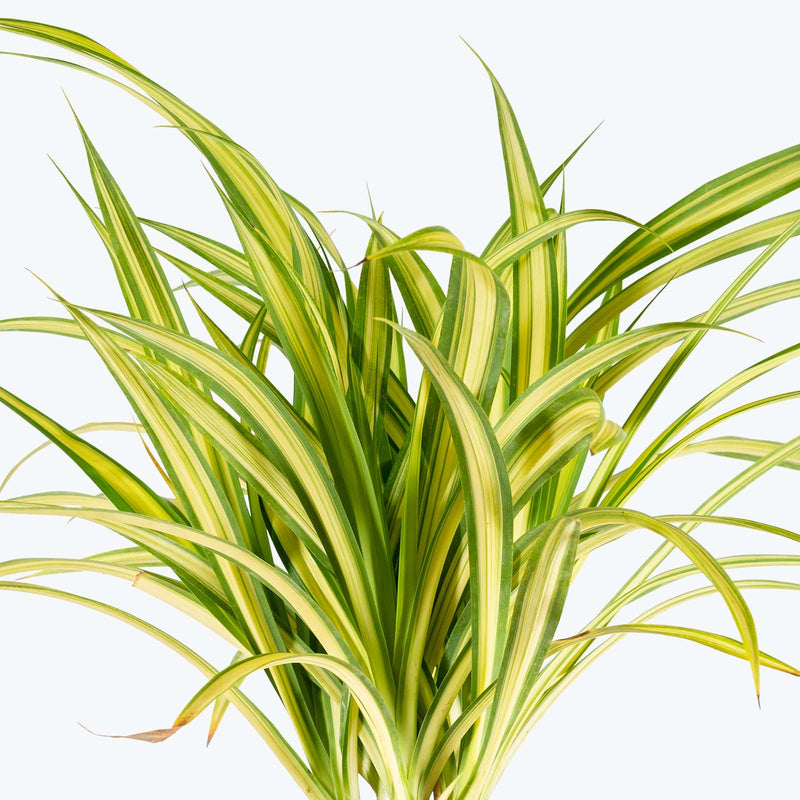
How to care for Pandanus Veitchii
They should not be in a position to see the sun directly, although early morning or late evening sun is fine. Filtered sunlight through a sheer curtain is best and most homes are comprised primarily of indirect sunlight. The best spot for them is where they do not see the sun during the majority of the day but still get bright, indirect light.
They will thrive in bright light, but also can tolerate medium light. A good medium-light place in your home would be in the middle of a room that has a regular size window. They can be placed anywhere between the middle of the room and the window. Remember that plants will grow based on how much light they receive.
They need to be watered when the top half of the soil is dry to the touch. That usually takes about 1 week in an average home environment. It will vary depending on the time of year, your environment and lighting conditions, but it's always safer to underwater or give the soil a check before you water again. Expect to water more often in brighter light and less often in lower light.
They will do well in average humidity environments but will appreciate a little bit of humidity if provided, give them a mist daily or get a humidifier.
Pandanus Veitchii can benefit from regular misting, and it prefers a well-draining soil mix. A balanced liquid fertilizer can be applied every 4-6 weeks during the growing season.
This plant is moderately toxic and can cause some adverse reactions when ingested so it is best to not let your pets eat it, which we advise for all plants in general. The severity of the reaction will depend on how much of the plant is ingested but, if you know your pet typically does not eat your plants, this plant will be suitable for your home..
View PlantPapaya Tree

How to care for Papaya Tree
Papaya Tree loves as much sun as possible. The best spot for them is where they can see the sun during the majority of the day.
Papaya Tree will do their best and flower profusely in bright light. A nice bright place outside would be on a sunny balcony, deck, or backyard; inside your home, it would do best in a sunny window sill. Remember that plants will grow and flower based on how much light they receive.
Papaya Tree needs to be watered when the top half of the soil is dry to the touch. That usually takes about 1 week in an average home environment. It will vary depending on the time of year, your environment and lighting conditions, but it's always safer to underwater or give the soil a check before you water again. Expect to water more often in brighter light and less often in lower light.
Papaya Tree can live in any average home humidity condition and are fairly hardy.
Papaya trees prefer warm temperatures, full sun, and well-draining, nutrient-rich soil. For best fruit production, fertilize every 4–6 weeks during the growing season with a balanced fertilizer. While they grow fast, they’re sensitive to cold — bring them indoors if temps dip below 13°C(55°F). Container-grown papayas may start producing fruit within the first year if well cared for. Be mindful of root space and choose a deep pot with good drainage. Prune lightly to manage size and remove damaged leaves to keep airflow healthy around the trunk.
You can feel comfortable having Papaya Tree around your home in the potential case where your pet feels like nibbling on it. However, we typically recommend keeping your pets from eating any of your houseplants..
View PlantParlor Palm
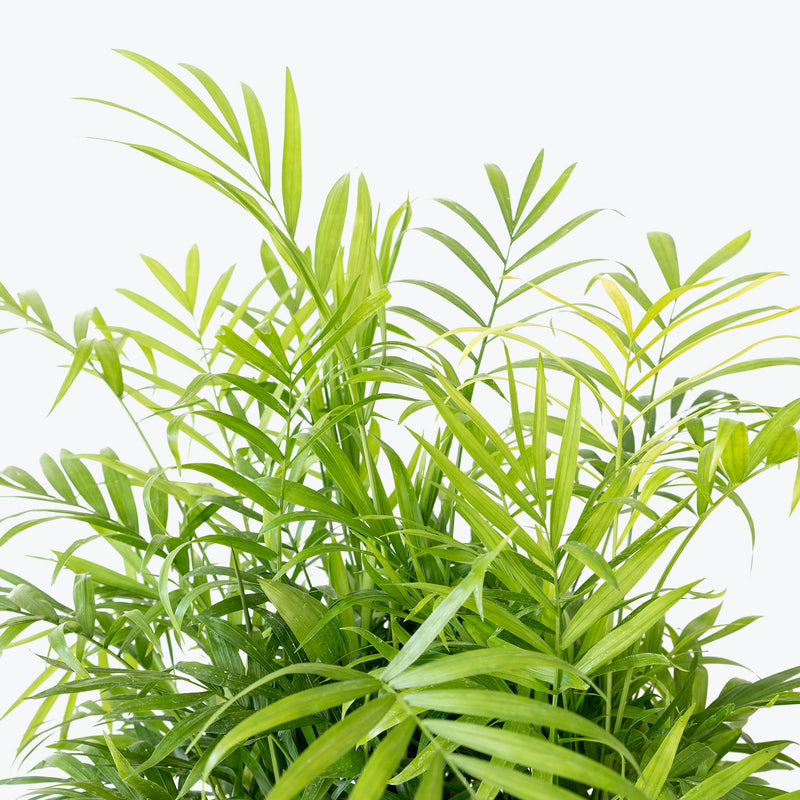
How to care for Parlor Palm
Parlor Palm should not be in a position to see the sun directly, although early morning or late evening sun is fine. Filtered sunlight through a sheer curtain is best and most homes are comprised primarily of indirect sunlight. The best spot for them is where they do not see the sun during the majority of the day but still get bright, indirect light.
Parlor Palm will thrive in medium to bright light, but also can tolerate low light. A good medium-light place in your home would be in the middle of a room that has a regular size window. They can be placed almost anywhere in the room but remember, plants will grow based on how much light they receive.
Parlor Palm needs to be watered when the top half of the soil is dry to the touch. That usually takes about 1 week in an average home environment. It will vary depending on the time of year, your environment and lighting conditions, but it's always safer to underwater or give the soil a check before you water again. Expect to water more often in brighter light and less often in lower light.
Parlor Palm will do well in average humidity environments but will appreciate a little bit of humidity if provided, give them a mist daily or get a humidifier.
Avoid keeping Parlor Palm in direct sun and don't repot more than once a year, as their roots like to relax and settle into their new homes. If the fronds start to turn yellow, this could be a sign that the plant needs more water!
You can feel comfortable having Parlor Palm around your home in the potential case where your pet feels like nibbling on it. However, we typically recommend keeping your pets from eating any of your houseplants..
Learn MoreView PlantPeace Lily
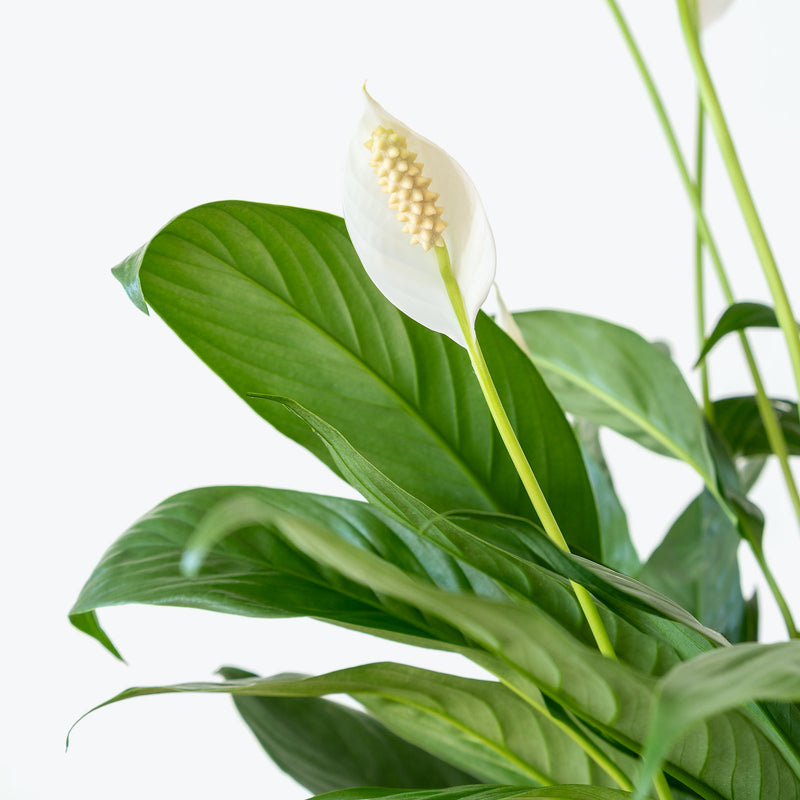
How to care for Peace Lily
Peace Lily should not be in a position to see the sun directly, although early morning or late evening sun is fine. Filtered sunlight through a sheer curtain is best and most homes are comprised primarily of indirect sunlight. The best spot for them is where they do not see the sun during the majority of the day but still get bright, indirect light.
Peace Lily will do well in low light, but will grow faster with brighter light. A low light plant can pretty much survive anyplace inside your home as long as you have a window in the room. Remember, low light does not mean no light and plants will grow based on how much light they receive.
Peace Lily needs to be watered when the top half of the soil is dry to the touch. That usually takes about 1 week in an average home environment. It will vary depending on the time of year, your environment and lighting conditions, but it's always safer to underwater or give the soil a check before you water again. Expect to water more often in brighter light and less often in lower light.
Peace Lily can live in any average home humidity condition and is fairly hardy.
If you forgot when the last time you watered them was, one tip is to wait for the leaves to droop slightly before watering. Peace Lily are known for being a little dramatic when they want water!
Peace Lily is moderately toxic and can cause some adverse reactions when ingested so it is best to not let your pets eat it, which we advise for all plants in general. The severity of the reaction will depend on how much of the plant is ingested but, if you know your pet typically does not eat your plants, this plant will be suitable for your home..
Learn MoreView PlantPeace Lily Domino
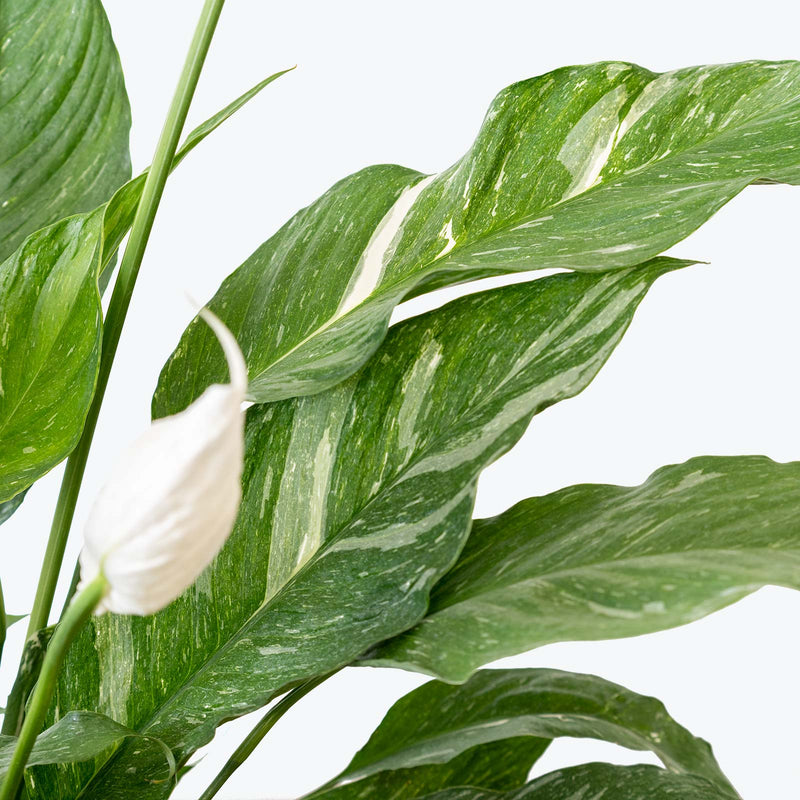
How to care for Peace Lily Domino
They should not be in a position to see the sun directly, although early morning or late evening sun is fine. Filtered sunlight through a sheer curtain is best and most homes are comprised primarily of indirect sunlight. The best spot for them is where they do not see the sun during the majority of the day but still get bright, indirect light.
They will thrive in medium to bright light, but also can tolerate low light. A good medium-light place in your home would be in the middle of a room that has a regular size window. They can be placed almost anywhere in the room but remember, plants will grow based on how much light they receive.
They need to be watered when the top half of the soil is dry to the touch. That usually takes about 1 week in an average home environment. It will vary depending on the time of year, your environment and lighting conditions, but it's always safer to underwater or give the soil a check before you water again. Expect to water more often in brighter light and less often in lower light.
They can live in any average home humidity condition and are fairly hardy.
Since this variety has some variegation in it, it will need brighter light than the original Peace Lily. If you forgot when the last time you watered them was, one tip is to wait for the plant to droop slightly before watering. They are known for being a little dramatic when they want water!
This plant is moderately toxic and can cause some adverse reactions when ingested so it is best to not let your pets eat it, which we advise for all plants in general. The severity of the reaction will depend on how much of the plant is ingested but, if you know your pet typically does not eat your plants, this plant will be suitable for your home..
Learn MoreView PlantPeace Lily Jessica
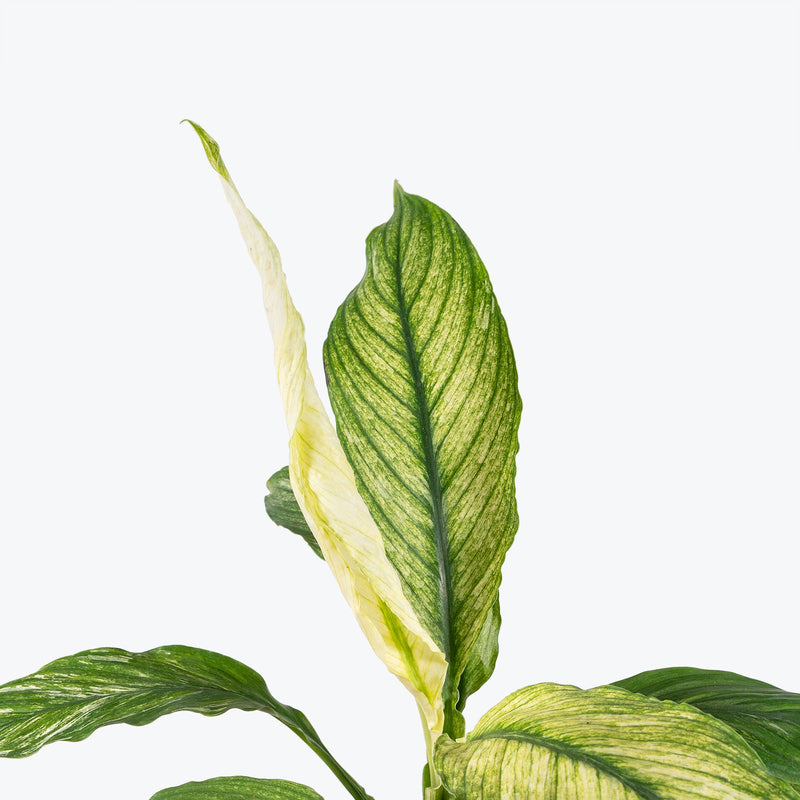
How to care for Peace Lily Jessica
Peace Lily Jessica should not be in a position to see the sun directly, although early morning or late evening sun is fine. Filtered sunlight through a sheer curtain is best and most homes are comprised primarily of indirect sunlight. The best spot for them is where they do not see the sun during the majority of the day but still get bright, indirect light.
Peace Lily Jessica will thrive in bright light, but also can tolerate medium light. A good medium-light place in your home would be in the middle of a room that has a regular size window. They can be placed anywhere between the middle of the room and the window. Remember that plants will grow based on how much light they receive.
Peace Lily Jessica needs to be watered when the top half of the soil is dry to the touch. That usually takes about 1 week in an average home environment. It will vary depending on the time of year, your environment and lighting conditions, but it's always safer to underwater or give the soil a check before you water again. Expect to water more often in brighter light and less often in lower light.
Peace Lily Jessica can live in any average home humidity condition and are fairly hardy.
Since Peace Lily Jessica has some variegation in it, it will need brighter light than the original Peace Lily. If you forgot when the last time you watered them was, one tip is to wait for the plant to droop slightly before watering - they are known for being a little dramatic when they want water!
Peace Lily Jessica is moderately toxic and can cause some adverse reactions when ingested so it is best to not let your pets eat it, which we advise for all plants in general. The severity of the reaction will depend on how much of the plant is ingested but, if you know your pet typically does not eat your plants, this plant will be suitable for your home..
Learn MoreView PlantPeace Lily Mojo Variegata
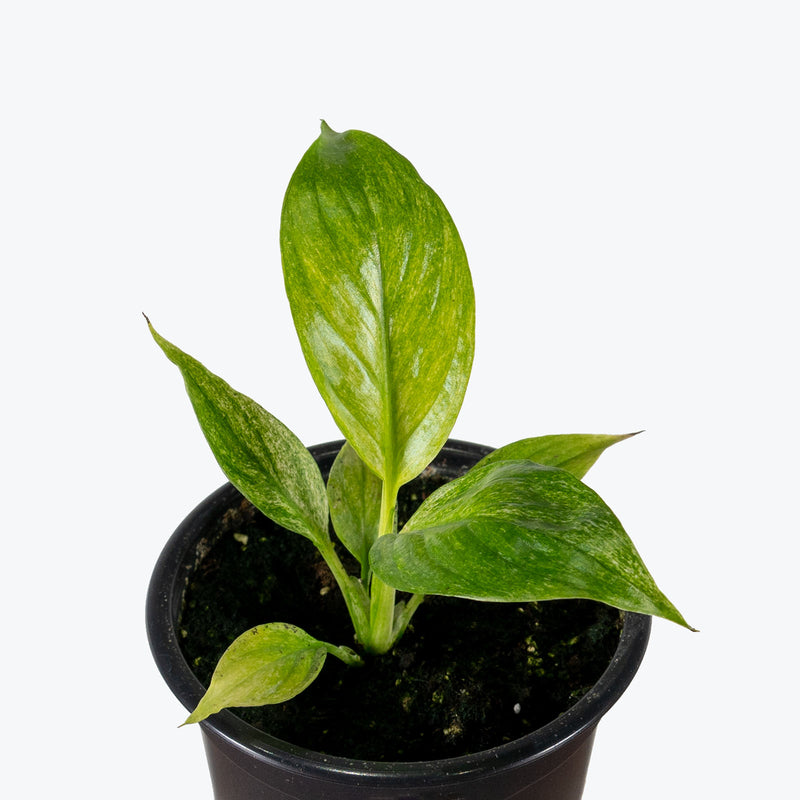
How to care for Peace Lily Mojo Variegata
Peace Lily Mojo Variegata should not be in a position to see the sun directly, although early morning or late evening sun is fine. Filtered sunlight through a sheer curtain is best and most homes are comprised primarily of indirect sunlight. The best spot for them is where they do not see the sun during the majority of the day but still get bright, indirect light.
Peace Lily Mojo Variegata will thrive in bright light, but also can tolerate medium light. A good medium-light place in your home would be in the middle of a room that has a regular size window. They can be placed anywhere between the middle of the room and the window. Remember that plants will grow based on how much light they receive.
Peace Lily Mojo Variegata needs to be watered when the top half of the soil is dry to the touch. That usually takes about 1 week in an average home environment. It will vary depending on the time of year, your environment and lighting conditions, but it's always safer to underwater or give the soil a check before you water again. Expect to water more often in brighter light and less often in lower light.
Peace Lily Mojo Variegata will do well in average humidity environments but will appreciate a little bit of humidity if provided, give them a mist daily or get a humidifier.
Since Peace Lily Mojo Variegata has variegation, it will need brighter light than the original Peace Lily. If you forgot when the last time you watered them was, one tip is to wait for the plant to droop slightly before watering - they are known for being a little dramatic when they want water! Clean the leaves periodically to remove dust and prevent pest infestations. Prune any yellow or brown leaves to keep the plant looking its best.
Peace Lily Mojo Variegata is moderately toxic and can cause some adverse reactions when ingested so it is best to not let your pets eat it, which we advise for all plants in general. The severity of the reaction will depend on how much of the plant is ingested but, if you know your pet typically does not eat your plants, this plant will be suitable for your home..
Learn MoreView PlantPeace Lily Sensation
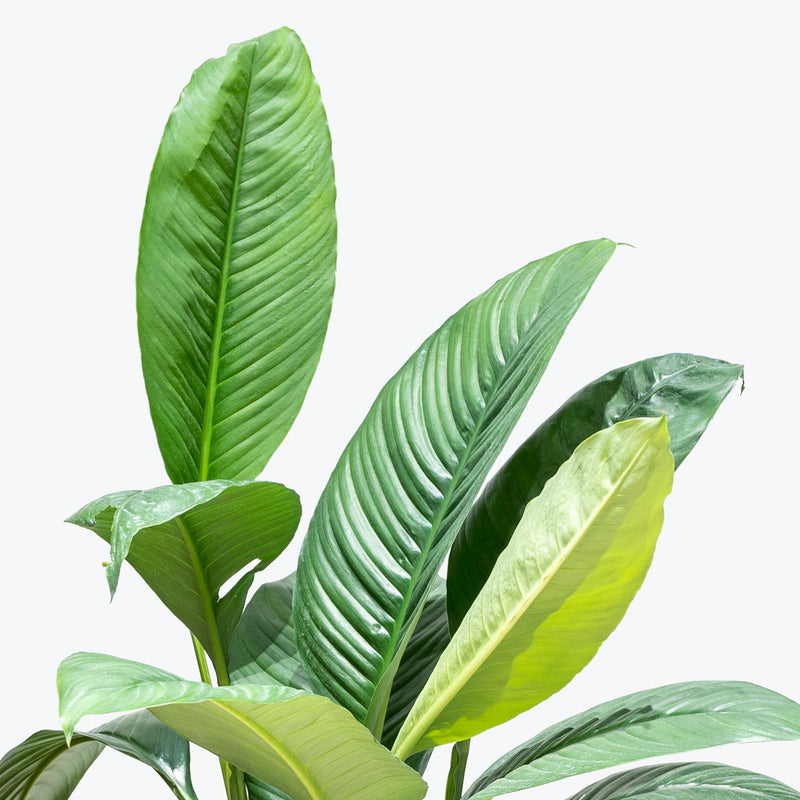
How to care for Peace Lily Sensation
Peace Lily Sensation should not be in a position to see the sun directly, although early morning or late evening sun is fine. Filtered sunlight through a sheer curtain is best and most homes are comprised primarily of indirect sunlight. The best spot for them is where they do not see the sun during the majority of the day but still get bright, indirect light.
Peace Lily Sensation will do well in low light, but will grow faster with brighter light. A low light plant can pretty much survive anyplace inside your home as long as you have a window in the room. Remember, low light does not mean no light and plants will grow based on how much light they receive.
Peace Lily Sensation needs to be watered when the top half of the soil is dry to the touch. That usually takes about 1 week in an average home environment. It will vary depending on the time of year, your environment and lighting conditions, but it's always safer to underwater or give the soil a check before you water again. Expect to water more often in brighter light and less often in lower light.
Peace Lily Sensation can live in any average home humidity condition and is fairly hardy.
If you forgot the last time you watered them, one tip is to wait for the plant to droop slightly before watering. Peace Lily Sensations are known for being a little dramatic when they want water. Clean the leaves occasionally to remove dust and support efficient photosynthesis. If Peace Lily Sensation begins to look too large or the growth slows significantly, consider repotting in the spring.
Peace Lily Sensation is moderately toxic and can cause some adverse reactions when ingested so it is best to not let your pets eat it, which we advise for all plants in general. The severity of the reaction will depend on how much of the plant is ingested but, if you know your pet typically does not eat your plants, this plant will be suitable for your home..
Learn MoreView PlantPelargonium Mosquitaway Eva
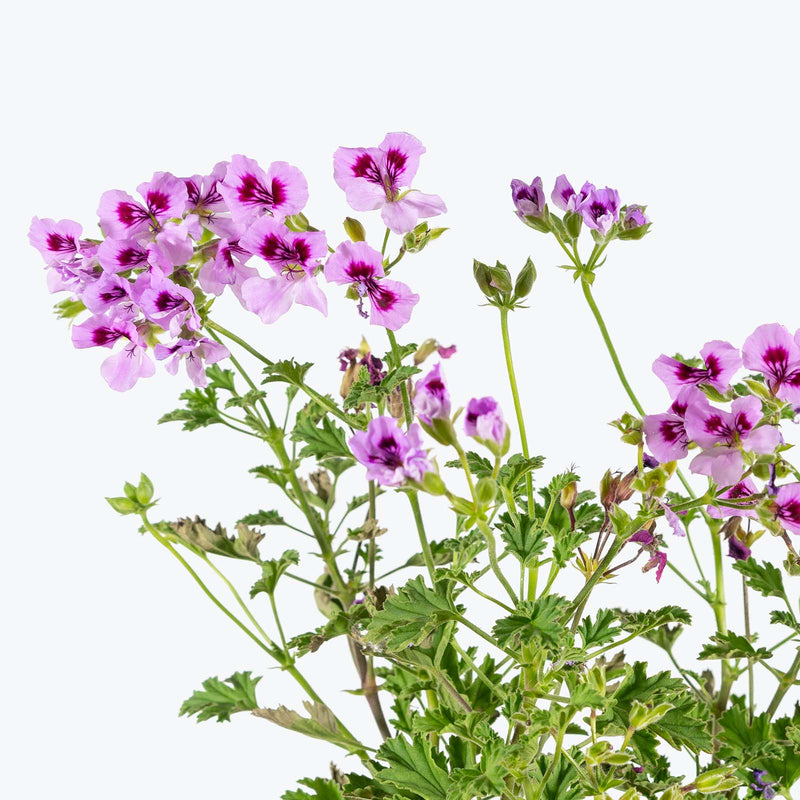
How to care for Pelargonium Mosquitaway Eva
Pelargonium Mosquitaway Eva enjoys some direct sun, but they'll also do well in bright, indirect light. It is best to place this plant somewhere where it will receive some nice morning sun, or a couple hours of afternoon sun, and then indirect light the rest of the day.
Pelargonium Mosquitaway Eva will do their best and flower profusely in bright light. A nice bright place outside would be on a sunny balcony, deck, or backyard; inside your home, it would do best in a sunny window sill. Remember that plants will grow and flower based on how much light they receive.
Allow the top quarter of the soil to dry before watering again. This usually takes about 3 - 4 days in an average home environment. It will vary depending on the time of year, your environment and lighting conditions. Expect to water Pelargonium Mosquitaway Eva more often in brighter light and less often in lower light.
Pelargonium Mosquitaway Eva can live in any average home humidity condition and are fairly hardy.
Fertilize Pelargonium Mosquitaway Eva with a balanced, water-soluble fertilizer every two weeks during the growing season to promote robust growth and continuous flowering. Deadheading spent blooms will encourage new flowers and keep the plant looking tidy. Regular pruning can help maintain its shape and prevent legginess.
Pelargonium Mosquitaway Eva is moderately toxic and can cause some adverse reactions when ingested so it is best to not let your pets eat it, which we advise for all plants in general. The severity of the reaction will depend on how much of the plant is ingested but, if you know your pet typically does not eat your plants, this plant will be suitable for your home..
View PlantPellionia Repens Watermelon
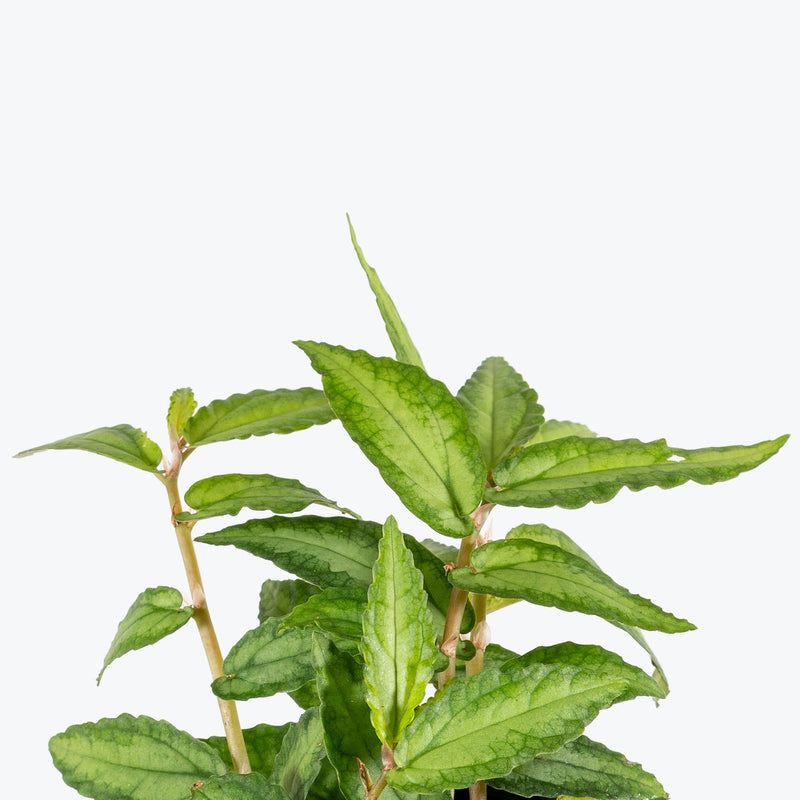
How to care for Pellionia Repens Watermelon
They should not be in a position to see the sun directly, although early morning or late evening sun is fine. Filtered sunlight through a sheer curtain is best and most homes are comprised primarily of indirect sunlight. The best spot for them is where they do not see the sun during the majority of the day but still get bright, indirect light.
They will thrive in bright light, but also can tolerate medium light. A good medium-light place in your home would be in the middle of a room that has a regular size window. They can be placed anywhere between the middle of the room and the window. Remember that plants will grow based on how much light they receive.
Allow the top quarter of the soil to dry before watering again. This usually takes about 3 - 4 days in an average home environment. It will vary depending on the time of year, your environment and lighting conditions. Expect to water more often in brighter light and less often in lower light.
They will do well in average humidity environments but will appreciate a little bit of humidity if provided, give them a mist daily or get a humidifier.
The Pellionia repens is versatile and can adapt to various environments. In terrariums, it tends to stay compact, increasing its foliage density rather than its length. However, as a houseplant with ample space, it can exhibit rapid growth. Regular trimming might be necessary to maintain its desired shape.
This plant is moderately toxic and can cause some adverse reactions when ingested so it is best to not let your pets eat it, which we advise for all plants in general. The severity of the reaction will depend on how much of the plant is ingested but, if you know your pet typically does not eat your plants, this plant will be suitable for your home..
View PlantPencil Cactus
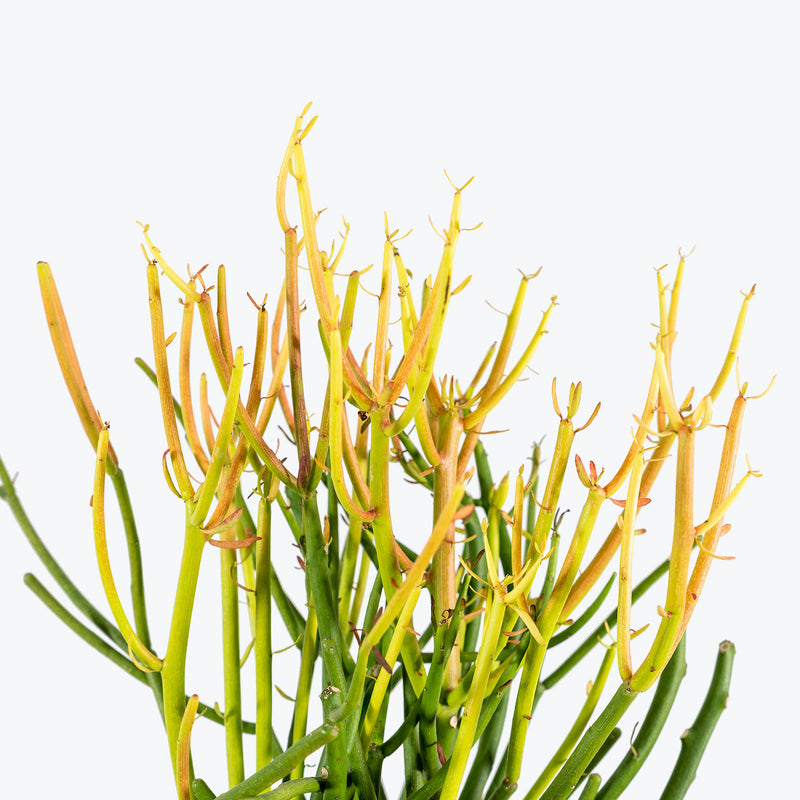
How to care for Pencil Cactus
Pencil Cactus enjoys some direct sun, but they'll also do well in bright, indirect light. It is best to place this plant somewhere where it will receive some nice morning sun, or a couple hours of afternoon sun, and then indirect light the rest of the day.
Pencil Cactus will tolerate lower light conditions, but will do best in bright light. A nice bright place inside your home would be on the window sill or a stool that is right next to a window, either with or without blinds, depending on if the plant can handle sun. Remember that plants will grow based on how much light they receive.
Pencil Cactus likes the soil to be completely dry before the next watering. That usually takes about 4 weeks in an average home environment. It will vary depending on the time of year, your environment and lighting conditions, but for them, it's always safer to under water or water when you see signs of lack of water (i.e. wrinkly or soft leaves). Water a little more often in the warmer months.
Their humidity requirement is low, so do not mist Pencil Cactus or put them in a terrarium.
If you want that strong orange and red colouring, make sure to keep Pencil Cactus in a warm, bright spot in your home. Avoid watering them too much, less water is better. Pruning is not generally necessary unless to control the shape or size of the plant.
Pencil Cactus is extremely toxic to pets and should not be kept around any animals that have a tendency to eat houseplants as it will lead to severe reactions..
Learn MoreView PlantPeperomia Abricos
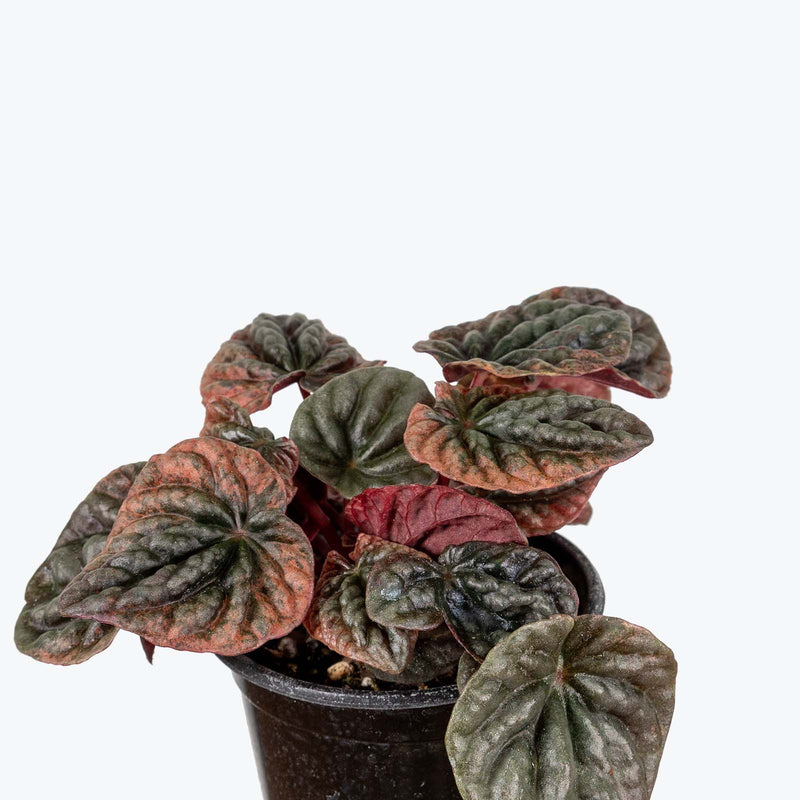
How to care for Peperomia Abricos
They should not be in a position to see the sun directly, although early morning or late evening sun is fine. Filtered sunlight through a sheer curtain is best and most homes are comprised primarily of indirect sunlight. The best spot for them is where they do not see the sun during the majority of the day but still get bright, indirect light.
They will thrive in bright light, but also can tolerate medium light. A good medium-light place in your home would be in the middle of a room that has a regular size window. They can be placed anywhere between the middle of the room and the window. Remember that plants will grow based on how much light they receive.
They like the soil to be relatively dry before the next watering. That usually takes about 2 weeks in an average home environment. It will vary depending on the time of year, your environment and lighting conditions, but for them, it's always safer to underwater or water when you see signs of lack of water (i.e. droopy, floppy, or soft leaves). Expect to water more often in brighter light and less often in lower light.
They can live in any average home humidity condition and are fairly hardy.
It doesn’t like cold weather and cannot survive under cold conditions for long so it should be kept warm and it does best under bright to medium, indirect sunlight. They are also pet friendly! So you can feel safe having them around your furry friends. Make sure to keep care fairly consistent, as they don't like too much or too little, light or water.
You can feel comfortable having this plant around your home in the potential case where your pet feels like nibbling on it. However, we typically recommend keeping your pets from eating any of your houseplants..
Learn MoreView PlantPeperomia Amigo Marcello
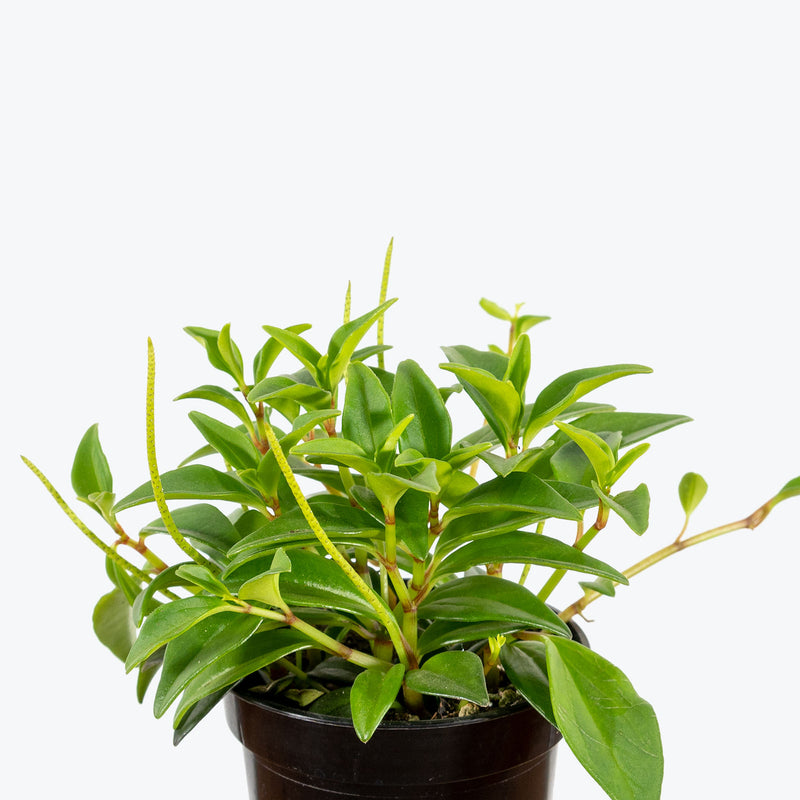
How to care for Peperomia Amigo Marcello
They should not be in a position to see the sun directly, although early morning or late evening sun is fine. Filtered sunlight through a sheer curtain is best and most homes are comprised primarily of indirect sunlight. The best spot for them is where they do not see the sun during the majority of the day but still get bright, indirect light.
They will thrive in bright light, but also can tolerate medium light. A good medium-light place in your home would be in the middle of a room that has a regular size window. They can be placed anywhere between the middle of the room and the window. Remember that plants will grow based on how much light they receive.
They like the soil to be relatively dry before the next watering. That usually takes about 2 weeks in an average home environment. It will vary depending on the time of year, your environment and lighting conditions, but for them, it's always safer to underwater or water when you see signs of lack of water (i.e. droopy, floppy, or soft leaves). Expect to water more often in brighter light and less often in lower light.
They can live in any average home humidity condition and are fairly hardy.
They are pet-friendly! So you can feel safe having them around your furry friends. Make sure to keep care fairly consistent, as they don't like too much or too little, light or water.
You can feel comfortable having this plant around your home in the potential case where your pet feels like nibbling on it. However, we typically recommend keeping your pets from eating any of your houseplants..
Learn MoreView PlantPeperomia Angulata
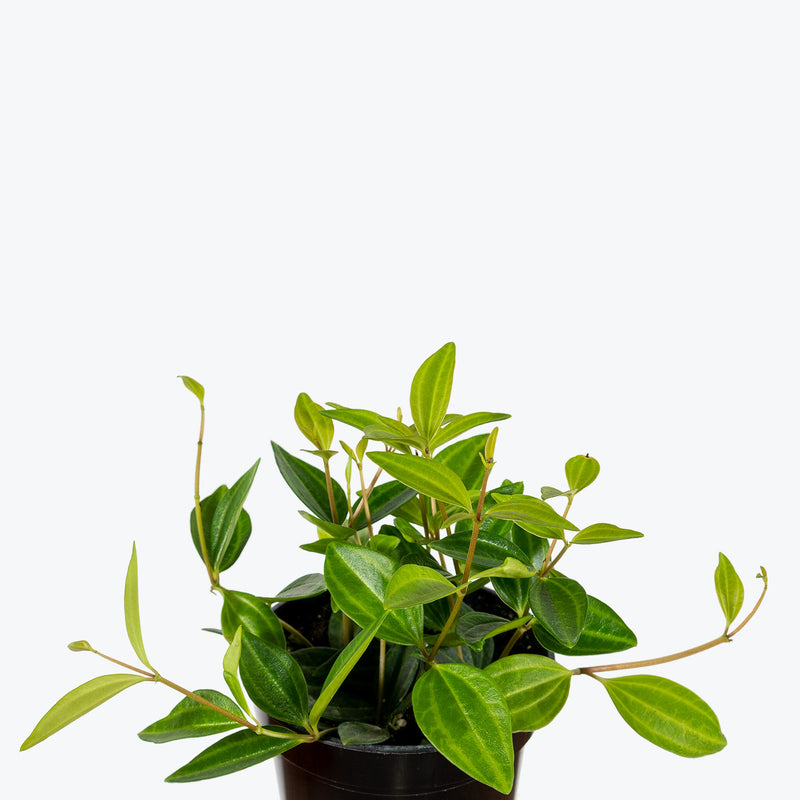
How to care for Peperomia Angulata
They should not be in a position to see the sun directly, although early morning or late evening sun is fine. Filtered sunlight through a sheer curtain is best and most homes are comprised primarily of indirect sunlight. The best spot for them is where they do not see the sun during the majority of the day but still get bright, indirect light.
They will thrive in bright light, but also can tolerate medium light. A good medium-light place in your home would be in the middle of a room that has a regular size window. They can be placed anywhere between the middle of the room and the window. Remember that plants will grow based on how much light they receive.
They like the soil to be relatively dry before the next watering. That usually takes about 2 weeks in an average home environment. It will vary depending on the time of year, your environment and lighting conditions, but for them, it's always safer to underwater or water when you see signs of lack of water (i.e. droopy, floppy, or soft leaves). Expect to water more often in brighter light and less often in lower light.
They can live in any average home humidity condition and are fairly hardy.
They are pet-friendly! So you can feel safe having them around your furry friends. Make sure to keep care fairly consistent, as they don't like too much or too little, light or water.
You can feel comfortable having this plant around your home in the potential case where your pet feels like nibbling on it. However, we typically recommend keeping your pets from eating any of your houseplants..
Learn MoreView PlantPeperomia Burbella
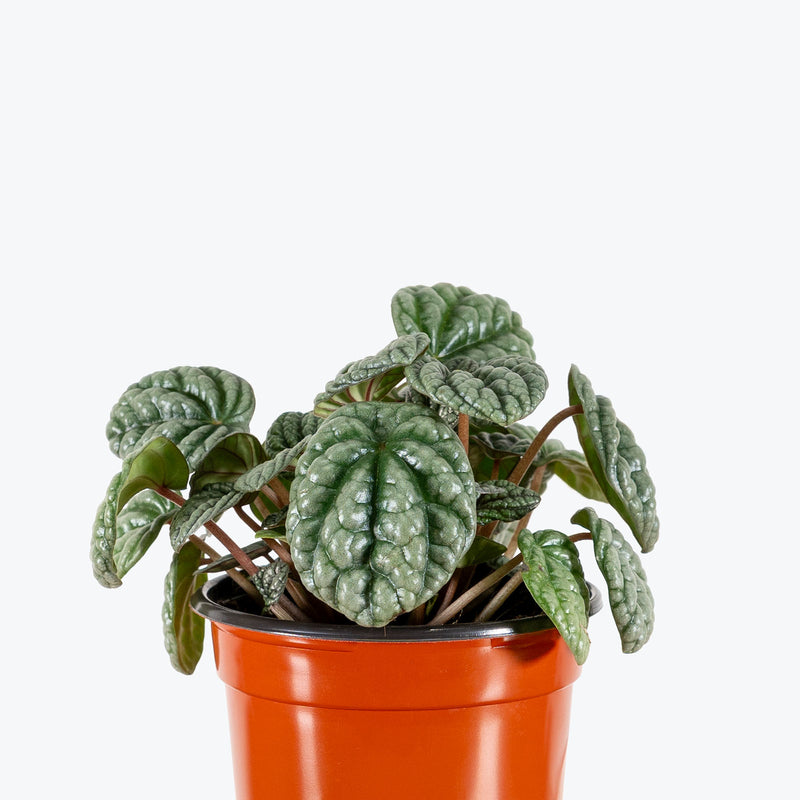
How to care for Peperomia Burbella
Peperomia Burbella should not be in a position to see the sun directly, although early morning or late evening sun is fine. Filtered sunlight through a sheer curtain is best and most homes are comprised primarily of indirect sunlight. The best spot for them is where they do not see the sun during the majority of the day but still get bright, indirect light.
Peperomia Burbella will thrive in bright light, but also can tolerate medium light. A good medium-light place in your home would be in the middle of a room that has a regular size window. They can be placed anywhere between the middle of the room and the window. Remember that plants will grow based on how much light they receive.
Peperomia Burbella needs to be watered when the top half of the soil is dry to the touch. That usually takes about 1 week in an average home environment. It will vary depending on the time of year, your environment and lighting conditions, but it's always safer to underwater or give the soil a check before you water again. Expect to water more often in brighter light and less often in lower light.
Peperomia Burbella will do well in average humidity environments but will appreciate a little bit of humidity if provided, give them a mist daily or get a humidifier.
Peperomia Burbella doesn’t like cold weather and cannot survive under cold conditions for long so it should be kept warm and it does best under bright to medium, indirect sunlight. Make sure to keep care fairly consistent, as they don't like too much or too little, light or water. Regularly clean the leaves to prevent dust accumulation, which can hinder photosynthesis and detract from the plant’s metallic sheen.
You can feel comfortable having Peperomia Burbella around your home in the potential case where your pet feels like nibbling on it. However, we typically recommend keeping your pets from eating any of your houseplants..
Learn MoreView PlantPeperomia Clusiifolia Ginny
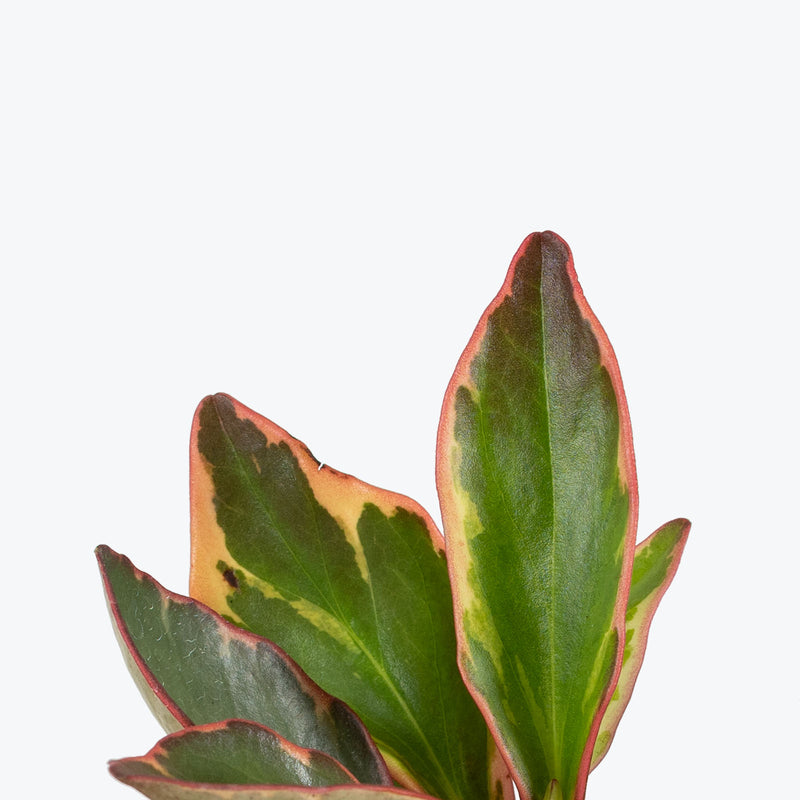
How to care for Peperomia Clusiifolia Ginny
They should not be in a position to see the sun directly, although early morning or late evening sun is fine. Filtered sunlight through a sheer curtain is best and most homes are comprised primarily of indirect sunlight. The best spot for them is where they do not see the sun during the majority of the day but still get bright, indirect light.
They will thrive in bright light, but also can tolerate medium light. A good medium-light place in your home would be in the middle of a room that has a regular size window. They can be placed anywhere between the middle of the room and the window. Remember that plants will grow based on how much light they receive.
They like the soil to be relatively dry before the next watering. That usually takes about 2 weeks in an average home environment. It will vary depending on the time of year, your environment and lighting conditions, but for them, it's always safer to underwater or water when you see signs of lack of water (i.e. droopy, floppy, or soft leaves). Expect to water more often in brighter light and less often in lower light.
They can live in any average home humidity condition and are fairly hardy.
Make sure to keep care fairly consistent, as they don't like too much or too little, light or water. Pruning your plant when it starts to become leggy would be wise, therefore encouraging new, bushy growth and you can even plant these cuttings back into the parent plant.
You can feel comfortable having this plant around your home in the potential case where your pet feels like nibbling on it. However, we typically recommend keeping your pets from eating any of your houseplants..
Learn MoreView PlantPeperomia Clusiifolia Red Edge
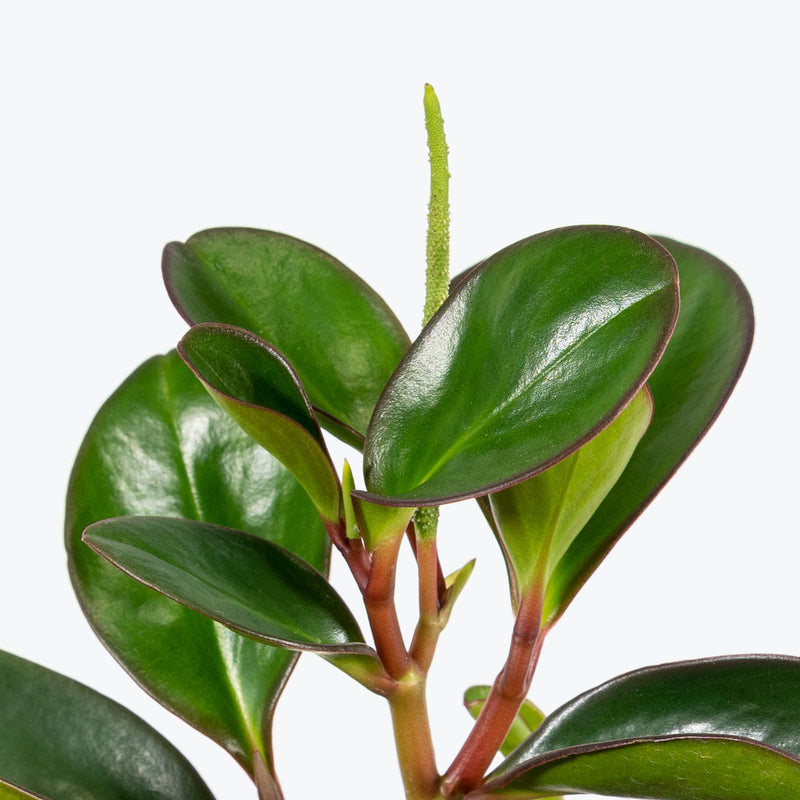
How to care for Peperomia Clusiifolia Red Edge
They should not be in a position to see the sun directly, although early morning or late evening sun is fine. Filtered sunlight through a sheer curtain is best and most homes are comprised primarily of indirect sunlight. The best spot for them is where they do not see the sun during the majority of the day but still get bright, indirect light.
They will thrive in bright light, but also can tolerate medium light. A good medium-light place in your home would be in the middle of a room that has a regular size window. They can be placed anywhere between the middle of the room and the window. Remember that plants will grow based on how much light they receive.
They like the soil to be relatively dry before the next watering. That usually takes about 2 weeks in an average home environment. It will vary depending on the time of year, your environment and lighting conditions, but for them, it's always safer to underwater or water when you see signs of lack of water (i.e. droopy, floppy, or soft leaves). Expect to water more often in brighter light and less often in lower light.
They can live in any average home humidity condition and are fairly hardy.
They are pet-friendly! So you can feel safe having them around your furry friends. Make sure to keep care fairly consistent, as they don't like too much or too little, light or water. Pruning your plant when it starts to become leggy would be wise, therefore encouraging new, bushy growth.
You can feel comfortable having this plant around your home in the potential case where your pet feels like nibbling on it. However, we typically recommend keeping your pets from eating any of your houseplants..
Learn MoreView PlantPeperomia Double Duty
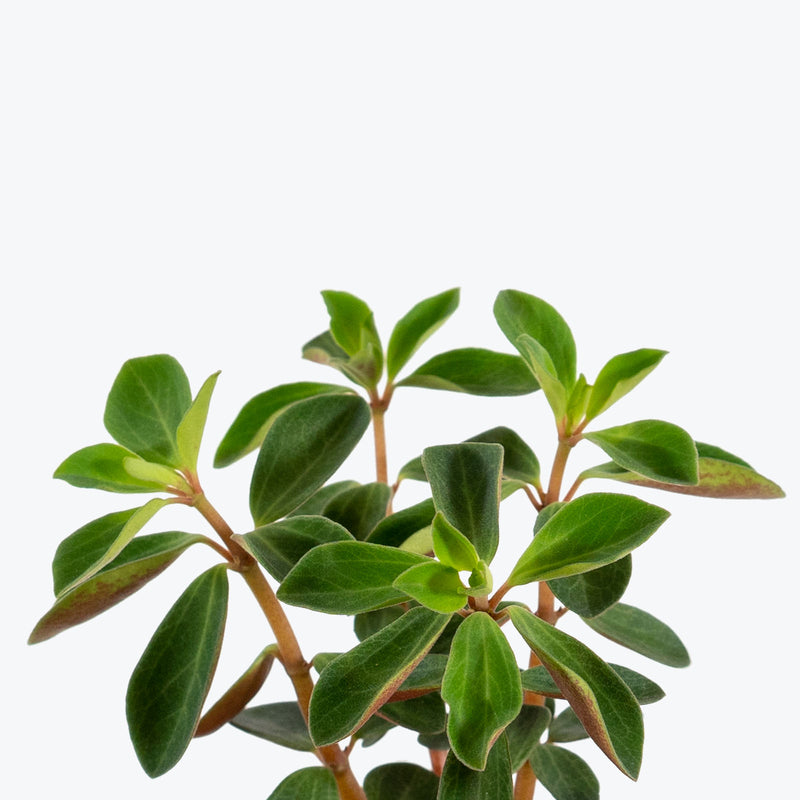
How to care for Peperomia Double Duty
They should not be in a position to see the sun directly, although early morning or late evening sun is fine. Filtered sunlight through a sheer curtain is best and most homes are comprised primarily of indirect sunlight. The best spot for them is where they do not see the sun during the majority of the day but still get bright, indirect light.
They will thrive in bright light, but also can tolerate medium light. A good medium-light place in your home would be in the middle of a room that has a regular size window. They can be placed anywhere between the middle of the room and the window. Remember that plants will grow based on how much light they receive.
They like the soil to be relatively dry before the next watering. That usually takes about 2 weeks in an average home environment. It will vary depending on the time of year, your environment and lighting conditions, but for them, it's always safer to underwater or water when you see signs of lack of water (i.e. droopy, floppy, or soft leaves). Expect to water more often in brighter light and less often in lower light.
They can live in any average home humidity condition and are fairly hardy.
If your Peperomia starts to get "leggy" as it grows, where the growth is stretched out and the leaves are not very dense, consider pruning it back to encourage more growth points, and place it in a brighter spot than it was before! Consider moving your plant to a location that receives brighter light if the colouring starts to fade.
You can feel comfortable having this plant around your home in the potential case where your pet feels like nibbling on it. However, we typically recommend keeping your pets from eating any of your houseplants..
Learn MoreView PlantPeperomia Ferreyrae
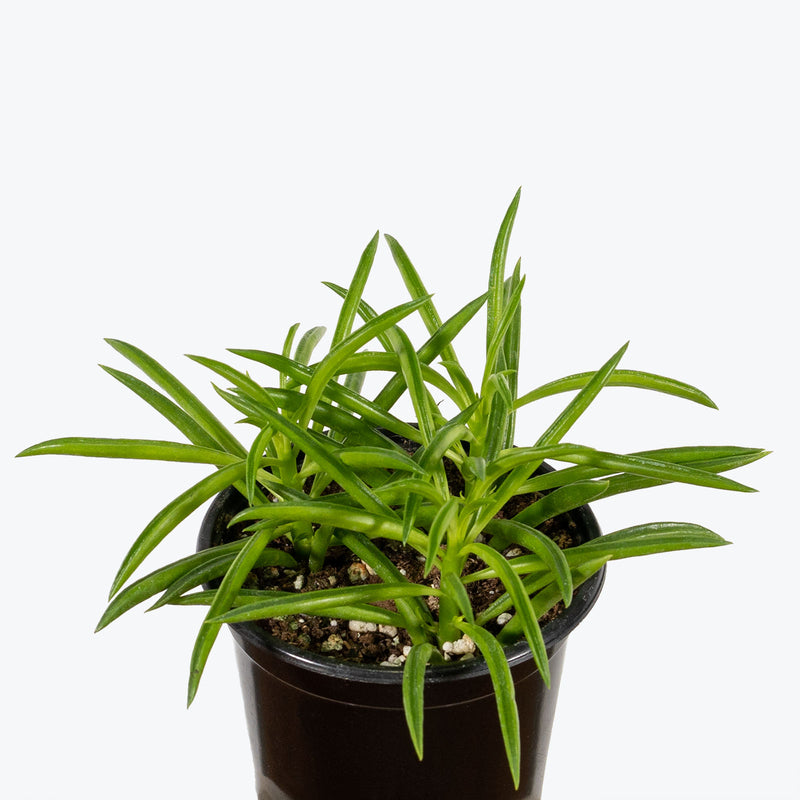
How to care for Peperomia Ferreyrae
They should not be in a position to see the sun directly, although early morning or late evening sun is fine. Filtered sunlight through a sheer curtain is best and most homes are comprised primarily of indirect sunlight. The best spot for them is where they do not see the sun during the majority of the day but still get bright, indirect light.
They will thrive in medium to bright light, but also can tolerate low light. A good medium-light place in your home would be in the middle of a room that has a regular size window. They can be placed almost anywhere in the room but remember, plants will grow based on how much light they receive.
They like the soil to be relatively dry before the next watering. That usually takes about 2 weeks in an average home environment. It will vary depending on the time of year, your environment and lighting conditions, but for them, it's always safer to underwater or water when you see signs of lack of water (i.e. droopy, floppy, or soft leaves). Expect to water more often in brighter light and less often in lower light.
They can live in any average home humidity condition and are fairly hardy.
They don’t need much attention and can survive on moderate neglect. They are also easily propagated through stem and leaf cuttings.
You can feel comfortable having this plant around your home in the potential case where your pet feels like nibbling on it. However, we typically recommend keeping your pets from eating any of your houseplants..
Learn MoreView PlantPeperomia Frost
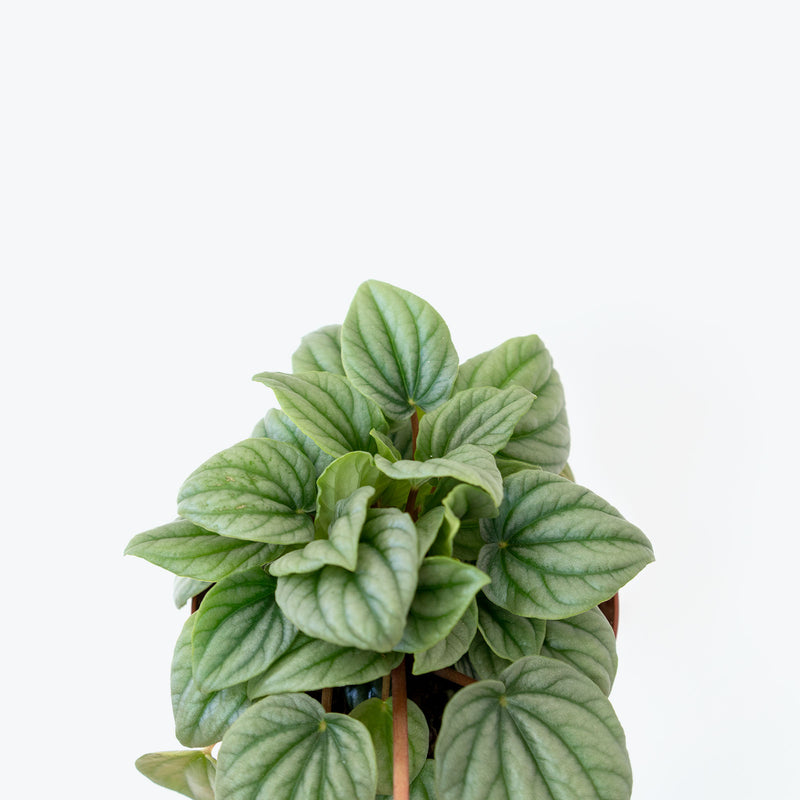
How to care for Peperomia Frost
They should not be in a position to see the sun directly, although early morning or late evening sun is fine. Filtered sunlight through a sheer curtain is best and most homes are comprised primarily of indirect sunlight. The best spot for them is where they do not see the sun during the majority of the day but still get bright, indirect light.
They will thrive in bright light, but also can tolerate medium light. A good medium-light place in your home would be in the middle of a room that has a regular size window. They can be placed anywhere between the middle of the room and the window. Remember that plants will grow based on how much light they receive.
They like the soil to be relatively dry before the next watering. That usually takes about 2 weeks in an average home environment. It will vary depending on the time of year, your environment and lighting conditions, but for them, it's always safer to underwater or water when you see signs of lack of water (i.e. droopy, floppy, or soft leaves). Expect to water more often in brighter light and less often in lower light.
They can live in any average home humidity condition and are fairly hardy.
They are pet-friendly! So you can feel safe having them around your furry friends. Make sure to keep care fairly consistent, as they don't like too much or too little, light or water.
You can feel comfortable having this plant around your home in the potential case where your pet feels like nibbling on it. However, we typically recommend keeping your pets from eating any of your houseplants..
Learn MoreView PlantPeperomia Grey Luna
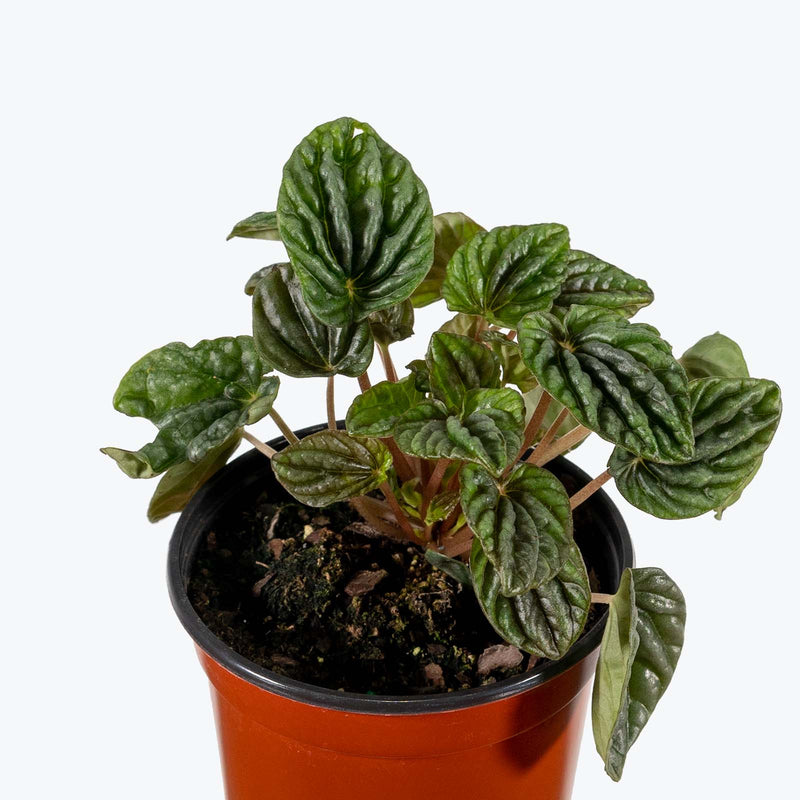
How to care for Peperomia Grey Luna
They should not be in a position to see the sun directly, although early morning or late evening sun is fine. Filtered sunlight through a sheer curtain is best and most homes are comprised primarily of indirect sunlight. The best spot for them is where they do not see the sun during the majority of the day but still get bright, indirect light.
They will thrive in medium to bright light, but also can tolerate low light. A good medium-light place in your home would be in the middle of a room that has a regular size window. They can be placed almost anywhere in the room but remember, plants will grow based on how much light they receive.
They like the soil to be relatively dry before the next watering. That usually takes about 2 weeks in an average home environment. It will vary depending on the time of year, your environment and lighting conditions, but for them, it's always safer to underwater or water when you see signs of lack of water (i.e. droopy, floppy, or soft leaves). Expect to water more often in brighter light and less often in lower light.
They will do well in average humidity environments but will appreciate a little bit of humidity if provided, give them a mist daily or get a humidifier.
It doesn’t like cold weather and cannot survive under cold conditions for long so it should be kept warm and it does best under bright to medium, indirect sunlight. They are also pet friendly! So you can feel safe having them around your furry friends. Make sure to keep care fairly consistent, as they don't like too much or too little, light or water.
You can feel comfortable having this plant around your home in the potential case where your pet feels like nibbling on it. However, we typically recommend keeping your pets from eating any of your houseplants..
Learn MoreView PlantPeperomia Hope
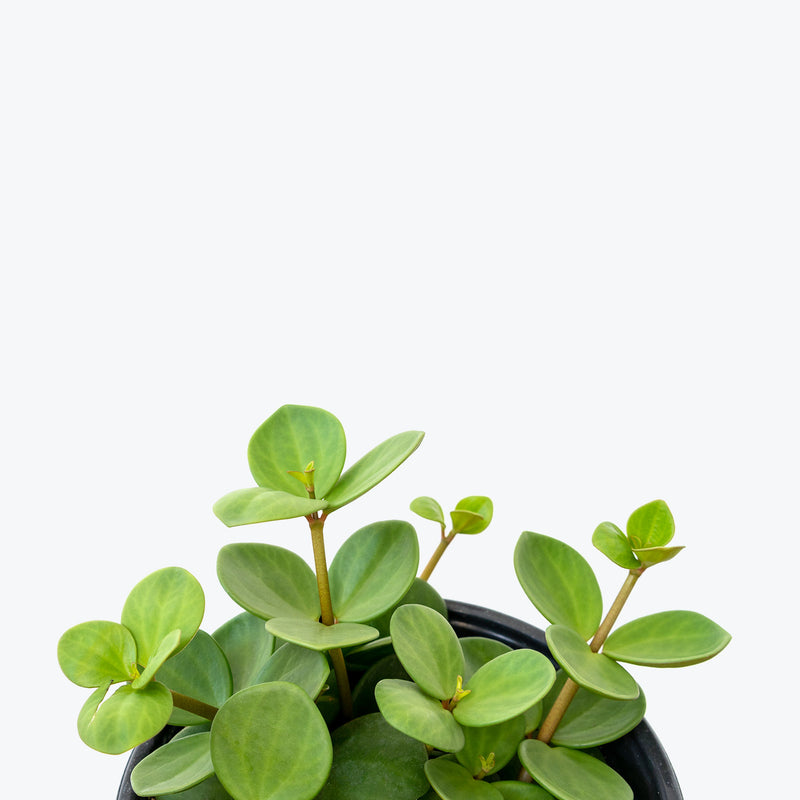
How to care for Peperomia Hope
Peperomia Hope should not be in a position to see the sun directly, although early morning or late evening sun is fine. Filtered sunlight through a sheer curtain is best and most homes are comprised primarily of indirect sunlight. The best spot for them is where they do not see the sun during the majority of the day but still get bright, indirect light.
Peperomia Hope will thrive in bright light, but also can tolerate medium light. A good medium-light place in your home would be in the middle of a room that has a regular size window. They can be placed anywhere between the middle of the room and the window. Remember that plants will grow based on how much light they receive.
Peperomia Hope likes the soil to be relatively dry before the next watering. That usually takes about 2 weeks in an average home environment. It will vary depending on the time of year, your environment and lighting conditions, but for them, it's always safer to underwater or water when you see signs of lack of water (i.e. droopy, floppy, or soft leaves). Expect to water more often in brighter light and less often in lower light.
Peperomia Hope can live in any average home humidity condition and are fairly hardy.
Make sure to keep care fairly consistent, as Peperomia Hope don't like too much or too little, light or water. Fertilize every 4-6 weeks during the growing season with a diluted liquid fertilizer designed for houseplants. In the winter, reduce fertilization as the plant's growth naturally slows. Prune back any overly long stems to encourage a fuller, bushier plant.
You can feel comfortable having Peperomia Hope around your home in the potential case where your pet feels like nibbling on it. However, we typically recommend keeping your pets from eating any of your houseplants..
Learn MoreView PlantPeperomia Little Toscani
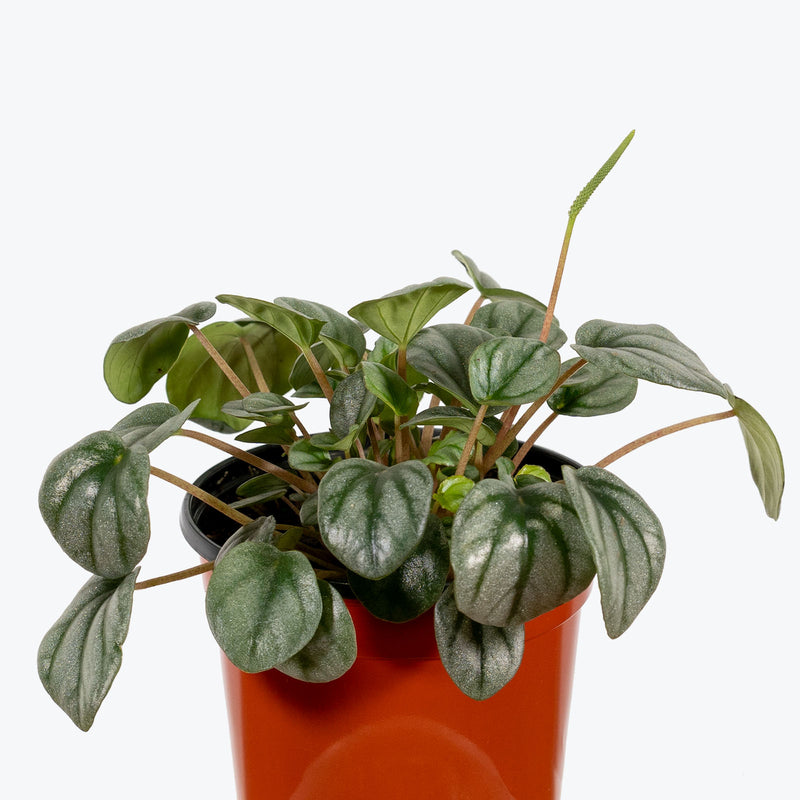
How to care for Peperomia Little Toscani
They should not be in a position to see the sun directly, although early morning or late evening sun is fine. Filtered sunlight through a sheer curtain is best and most homes are comprised primarily of indirect sunlight. The best spot for them is where they do not see the sun during the majority of the day but still get bright, indirect light.
They will thrive in bright light, but also can tolerate medium light. A good medium-light place in your home would be in the middle of a room that has a regular size window. They can be placed anywhere between the middle of the room and the window. Remember that plants will grow based on how much light they receive.
They like the soil to be relatively dry before the next watering. That usually takes about 2 weeks in an average home environment. It will vary depending on the time of year, your environment and lighting conditions, but for them, it's always safer to underwater or water when you see signs of lack of water (i.e. droopy, floppy, or soft leaves). Expect to water more often in brighter light and less often in lower light.
They can live in any average home humidity condition and are fairly hardy.
They are pet-friendly! So you can feel safe having them around your furry friends. Make sure to keep care fairly consistent, as they don't like too much or too little, light or water.
You can feel comfortable having this plant around your home in the potential case where your pet feels like nibbling on it. However, we typically recommend keeping your pets from eating any of your houseplants..
Learn MoreView PlantPeperomia Metallica
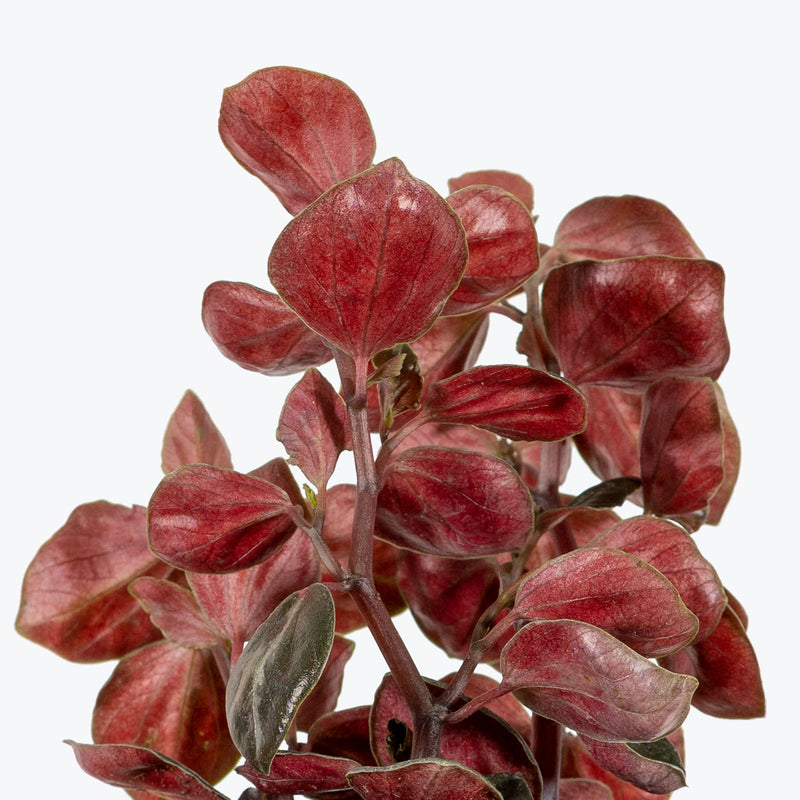
How to care for Peperomia Metallica
They should not be in a position to see the sun directly, although early morning or late evening sun is fine. Filtered sunlight through a sheer curtain is best and most homes are comprised primarily of indirect sunlight. The best spot for them is where they do not see the sun during the majority of the day but still get bright, indirect light.
They will do well in medium light but will grow faster with brighter light. A good medium-light place in your home would be in the middle of a room that has a regular size window. Remember that plants will grow based on how much light they receive.
They like the soil to be relatively dry before the next watering. That usually takes about 2 weeks in an average home environment. It will vary depending on the time of year, your environment and lighting conditions, but for them, it's always safer to underwater or water when you see signs of lack of water (i.e. droopy, floppy, or soft leaves). Expect to water more often in brighter light and less often in lower light.
They can live in any average home humidity condition and are fairly hardy.
They are pet-friendly! So you can feel safe having them around your furry friends. Make sure to keep care fairly consistent, as they don't like too much or too little, light or water.
You can feel comfortable having this plant around your home in the potential case where your pet feels like nibbling on it. However, we typically recommend keeping your pets from eating any of your houseplants..
Learn MoreView PlantPeperomia Mini Watermelon
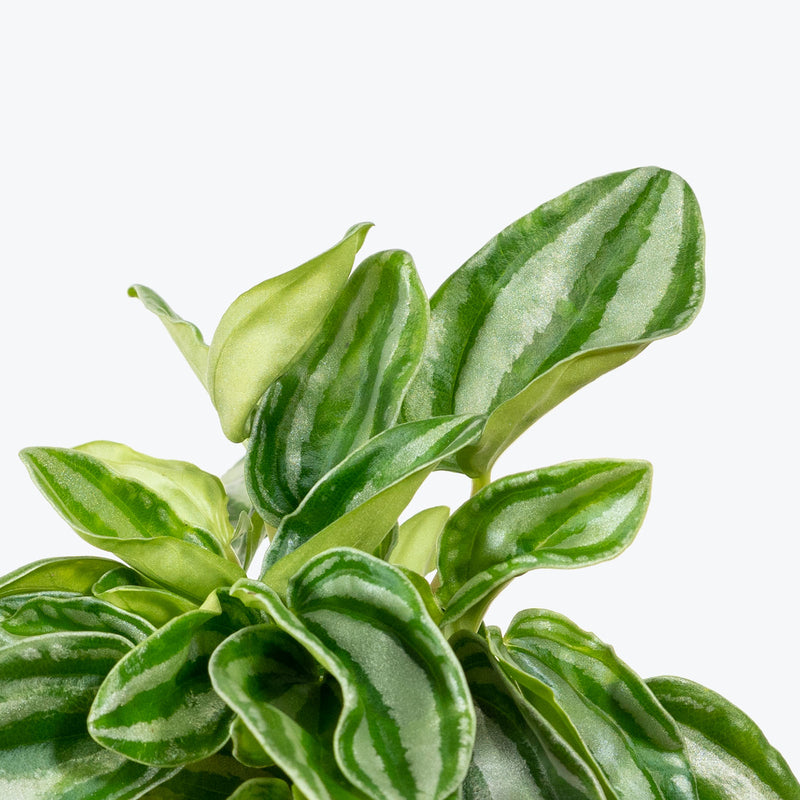
How to care for Peperomia Mini Watermelon
They should not be in a position to see the sun directly, although early morning or late evening sun is fine. Filtered sunlight through a sheer curtain is best and most homes are comprised primarily of indirect sunlight. The best spot for them is where they do not see the sun during the majority of the day but still get bright, indirect light.
They will thrive in bright light, but also can tolerate medium light. A good medium-light place in your home would be in the middle of a room that has a regular size window. They can be placed anywhere between the middle of the room and the window. Remember that plants will grow based on how much light they receive.
They like the soil to be relatively dry before the next watering. That usually takes about 2 weeks in an average home environment. It will vary depending on the time of year, your environment and lighting conditions, but for them, it's always safer to underwater or water when you see signs of lack of water (i.e. droopy, floppy, or soft leaves). Expect to water more often in brighter light and less often in lower light.
They can live in any average home humidity condition and are fairly hardy.
They are pet-friendly! So you can feel safe having them around your furry friends. Make sure to keep care fairly consistent, as they don't like too much or too little, light or water.
You can feel comfortable having this plant around your home in the potential case where your pet feels like nibbling on it. However, we typically recommend keeping your pets from eating any of your houseplants..
Learn MoreView PlantPeperomia Napoli Nights
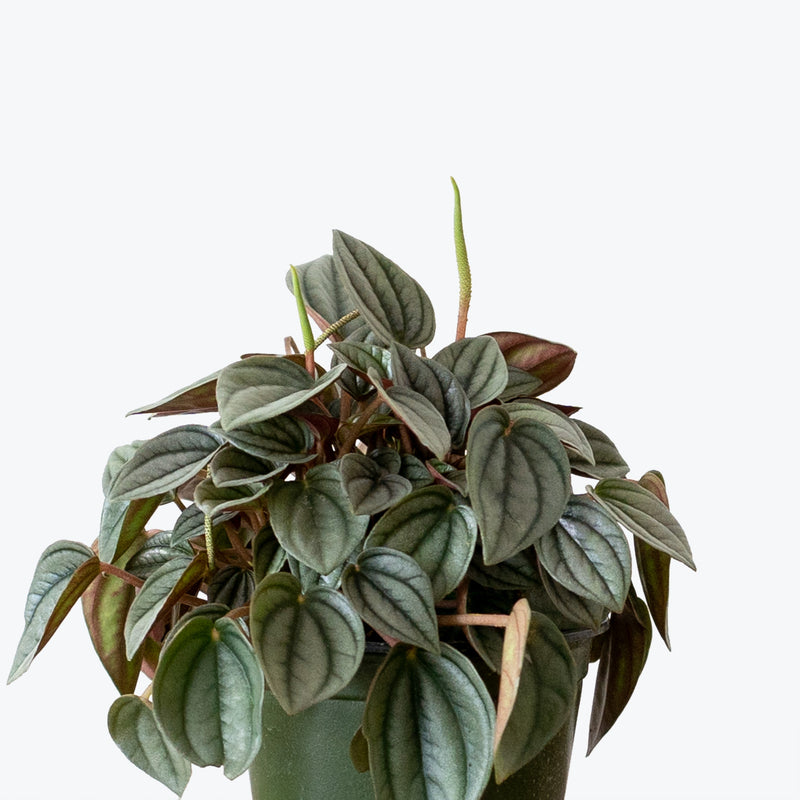
How to care for Peperomia Napoli Nights
They should not be in a position to see the sun directly, although early morning or late evening sun is fine. Filtered sunlight through a sheer curtain is best and most homes are comprised primarily of indirect sunlight. The best spot for them is where they do not see the sun during the majority of the day but still get bright, indirect light.
They will thrive in bright light, but also can tolerate medium light. A good medium-light place in your home would be in the middle of a room that has a regular size window. They can be placed anywhere between the middle of the room and the window. Remember that plants will grow based on how much light they receive.
They like the soil to be relatively dry before the next watering. That usually takes about 2 weeks in an average home environment. It will vary depending on the time of year, your environment and lighting conditions, but for them, it's always safer to underwater or water when you see signs of lack of water (i.e. droopy, floppy, or soft leaves). Expect to water more often in brighter light and less often in lower light.
They can live in any average home humidity condition and are fairly hardy.
They are pet-friendly! So you can feel safe having them around your furry friends. Make sure to keep care fairly consistent, as they don't like too much or too little, light or water.
You can feel comfortable having this plant around your home in the potential case where your pet feels like nibbling on it. However, we typically recommend keeping your pets from eating any of your houseplants..
Learn MoreView PlantPeperomia Obtusifolia
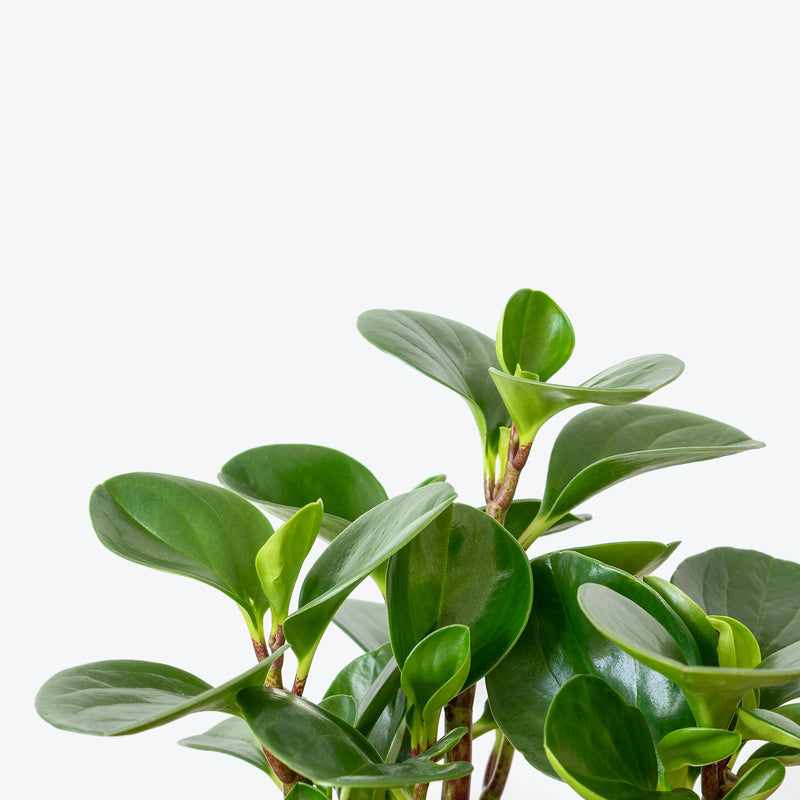
How to care for Peperomia Obtusifolia
Peperomia Obtusifolia should not be in a position to see the sun directly, although early morning or late evening sun is fine. Filtered sunlight through a sheer curtain is best and most homes are comprised primarily of indirect sunlight. The best spot for them is where they do not see the sun during the majority of the day but still get bright, indirect light.
Peperomia Obtusifolia will thrive in bright light, but also can tolerate medium light. A good medium-light place in your home would be in the middle of a room that has a regular size window. They can be placed anywhere between the middle of the room and the window. Remember that plants will grow based on how much light they receive.
Peperomia Obtusifolia likes the soil to be relatively dry before the next watering. That usually takes about 2 weeks in an average home environment. It will vary depending on the time of year, your environment and lighting conditions, but for them, it's always safer to underwater or water when you see signs of lack of water (i.e. droopy, floppy, or soft leaves). Expect to water more often in brighter light and less often in lower light.
Peperomia Obtusifolia can live in any average home humidity condition and are fairly hardy.
Peperomia Obtusifolia are pet-friendly! So you can feel safe having them around your furry friends. Make sure to keep care fairly consistent, as they don't like too much or too little, light or water.
You can feel comfortable having Peperomia Obtusifolia around your home in the potential case where your pet feels like nibbling on it. However, we typically recommend keeping your pets from eating any of your houseplants..
Learn MoreView PlantPeperomia Obtusifolia Golden Gate
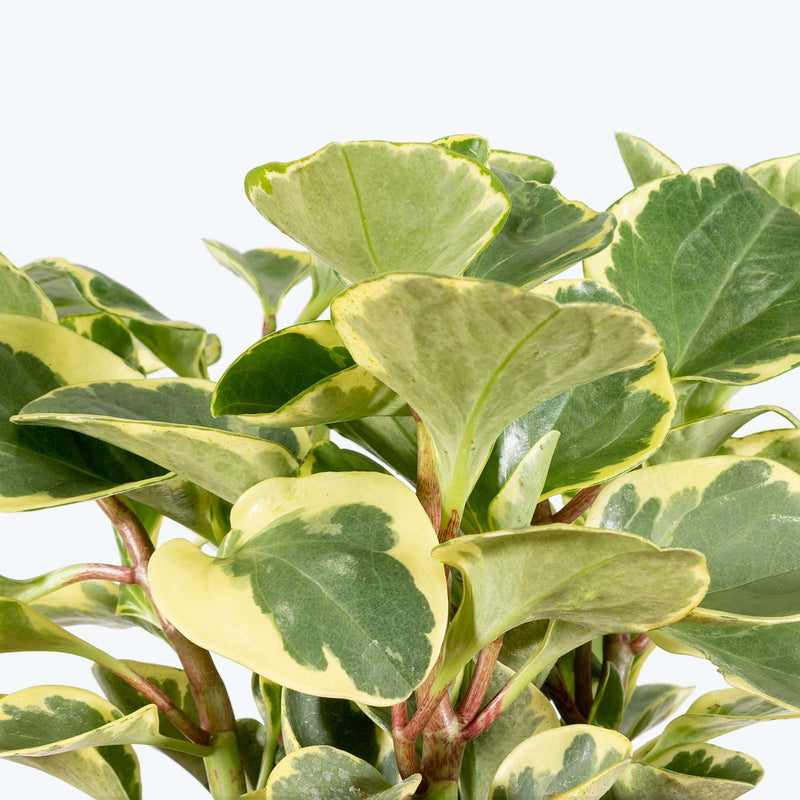
How to care for Peperomia Obtusifolia Golden Gate
They should not be in a position to see the sun directly, although early morning or late evening sun is fine. Filtered sunlight through a sheer curtain is best and most homes are comprised primarily of indirect sunlight. The best spot for them is where they do not see the sun during the majority of the day but still get bright, indirect light.
They will thrive in bright light, but also can tolerate medium light. A good medium-light place in your home would be in the middle of a room that has a regular size window. They can be placed anywhere between the middle of the room and the window. Remember that plants will grow based on how much light they receive.
They like the soil to be relatively dry before the next watering. That usually takes about 2 weeks in an average home environment. It will vary depending on the time of year, your environment and lighting conditions, but for them, it's always safer to underwater or water when you see signs of lack of water (i.e. droopy, floppy, or soft leaves). Expect to water more often in brighter light and less often in lower light.
They can live in any average home humidity condition and are fairly hardy.
They are pet-friendly! So you can feel safe having them around your furry friends. Make sure to keep care fairly consistent, as they don't like too much or too little, light or water.
You can feel comfortable having this plant around your home in the potential case where your pet feels like nibbling on it. However, we typically recommend keeping your pets from eating any of your houseplants..
Learn MoreView PlantPeperomia Obtusifolia Marble
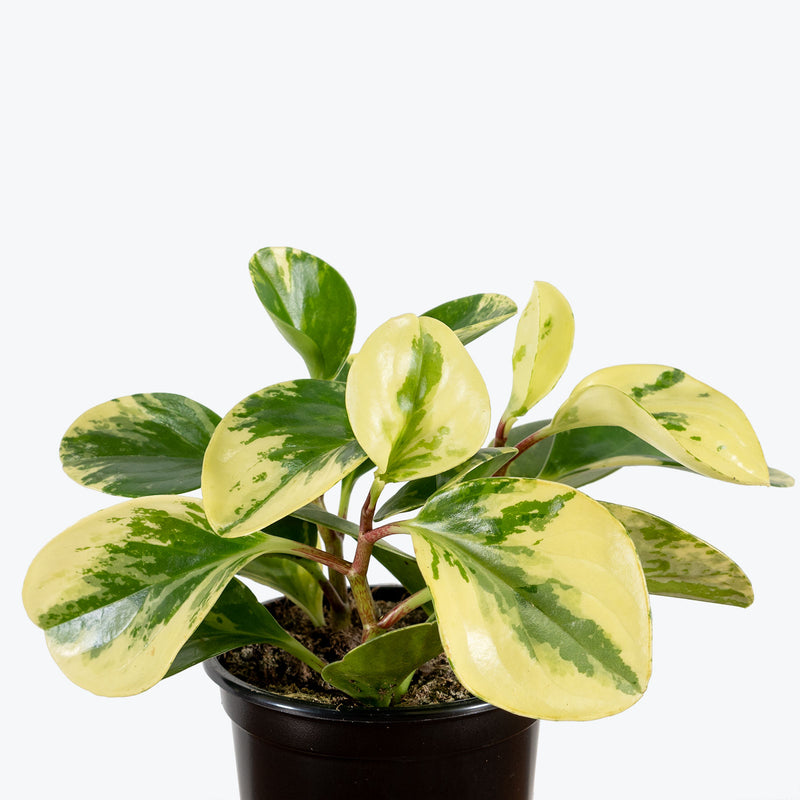
How to care for Peperomia Obtusifolia Marble
They should not be in a position to see the sun directly, although early morning or late evening sun is fine. Filtered sunlight through a sheer curtain is best and most homes are comprised primarily of indirect sunlight. The best spot for them is where they do not see the sun during the majority of the day but still get bright, indirect light.
They will thrive in bright light, but also can tolerate medium light. A good medium-light place in your home would be in the middle of a room that has a regular size window. They can be placed anywhere between the middle of the room and the window. Remember that plants will grow based on how much light they receive.
They like the soil to be relatively dry before the next watering. That usually takes about 2 weeks in an average home environment. It will vary depending on the time of year, your environment and lighting conditions, but for them, it's always safer to underwater or water when you see signs of lack of water (i.e. droopy, floppy, or soft leaves). Expect to water more often in brighter light and less often in lower light.
They can live in any average home humidity condition and are fairly hardy.
They are pet-friendly! So you can feel safe having them around your furry friends. Make sure to keep care fairly consistent, as they don't like too much or too little, light or water.
You can feel comfortable having this plant around your home in the potential case where your pet feels like nibbling on it. However, we typically recommend keeping your pets from eating any of your houseplants..
Learn MoreView PlantPeperomia Obtusifolia Splash
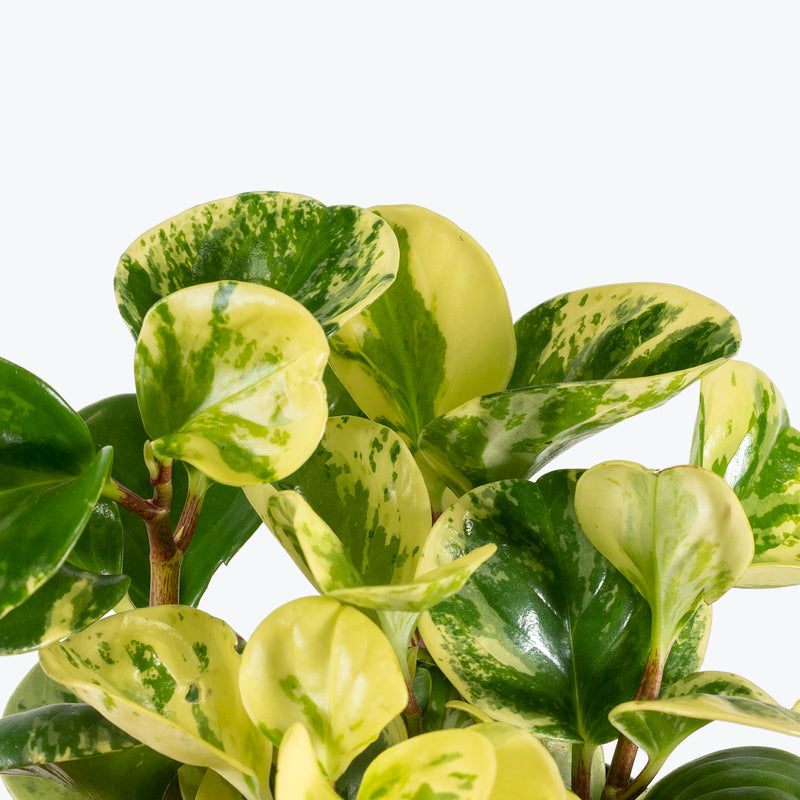
How to care for Peperomia Obtusifolia Splash
They should not be in a position to see the sun directly, although early morning or late evening sun is fine. Filtered sunlight through a sheer curtain is best and most homes are comprised primarily of indirect sunlight. The best spot for them is where they do not see the sun during the majority of the day but still get bright, indirect light.
They will thrive in bright light, but also can tolerate medium light. A good medium-light place in your home would be in the middle of a room that has a regular size window. They can be placed anywhere between the middle of the room and the window. Remember that plants will grow based on how much light they receive.
They like the soil to be relatively dry before the next watering. That usually takes about 2 weeks in an average home environment. It will vary depending on the time of year, your environment and lighting conditions, but for them, it's always safer to underwater or water when you see signs of lack of water (i.e. droopy, floppy, or soft leaves). Expect to water more often in brighter light and less often in lower light.
They can live in any average home humidity condition and are fairly hardy.
They are pet-friendly! So you can feel safe having them around your furry friends. Make sure to keep care fairly consistent, as they don't like too much or too little, light or water.
You can feel comfortable having this plant around your home in the potential case where your pet feels like nibbling on it. However, we typically recommend keeping your pets from eating any of your houseplants..
Learn MoreView PlantPeperomia Piccolo Banda
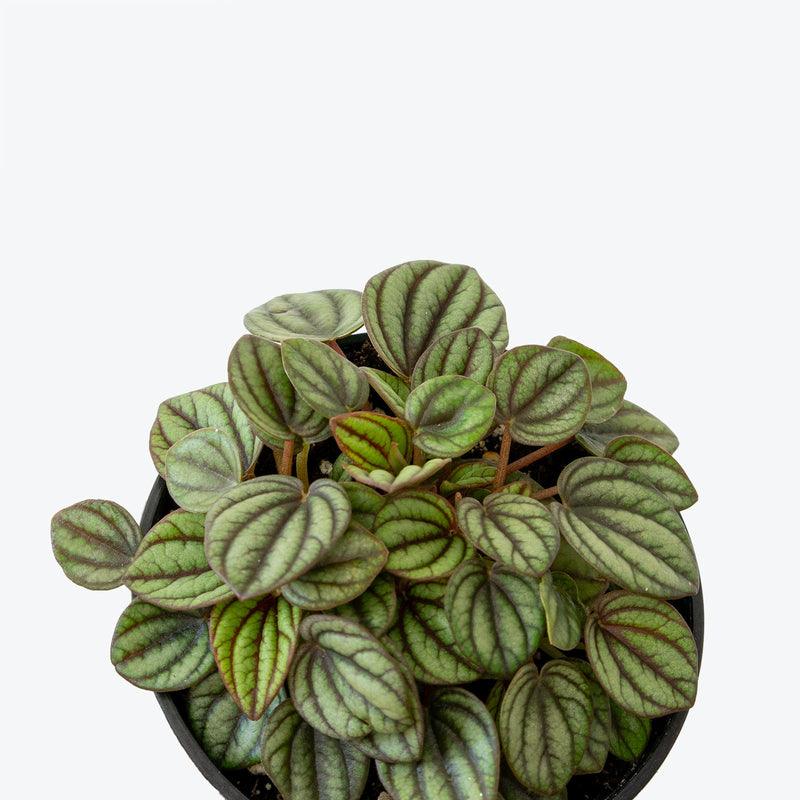
How to care for Peperomia Piccolo Banda
They should not be in a position to see the sun directly, although early morning or late evening sun is fine. Filtered sunlight through a sheer curtain is best and most homes are comprised primarily of indirect sunlight. The best spot for them is where they do not see the sun during the majority of the day but still get bright, indirect light.
They will thrive in bright light, but also can tolerate medium light. A good medium-light place in your home would be in the middle of a room that has a regular size window. They can be placed anywhere between the middle of the room and the window. Remember that plants will grow based on how much light they receive.
They like the soil to be relatively dry before the next watering. That usually takes about 2 weeks in an average home environment. It will vary depending on the time of year, your environment and lighting conditions, but for them, it's always safer to underwater or water when you see signs of lack of water (i.e. droopy, floppy, or soft leaves). Expect to water more often in brighter light and less often in lower light.
They can live in any average home humidity condition and are fairly hardy.
They are pet-friendly! So you can feel safe having them around your furry friends. Make sure to keep care fairly consistent, as they don't like too much or too little, light or water.
You can feel comfortable having this plant around your home in the potential case where your pet feels like nibbling on it. However, we typically recommend keeping your pets from eating any of your houseplants..
Learn MoreView PlantPeperomia Pink Lady
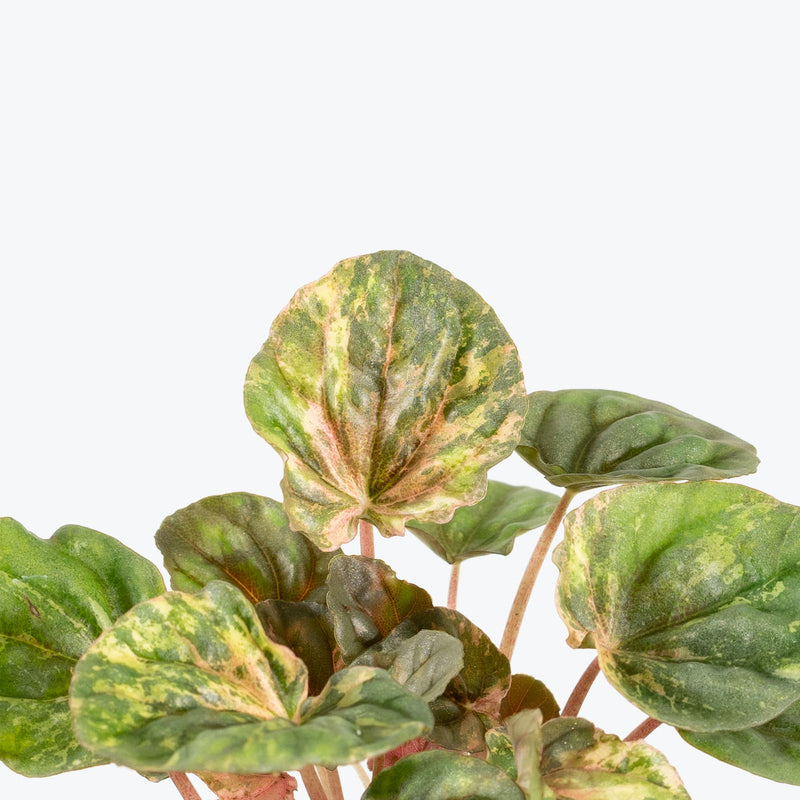
How to care for Peperomia Pink Lady
They should not be in a position to see the sun directly, although early morning or late evening sun is fine. Filtered sunlight through a sheer curtain is best and most homes are comprised primarily of indirect sunlight. The best spot for them is where they do not see the sun during the majority of the day but still get bright, indirect light.
They will thrive in bright light, but also can tolerate medium light. A good medium-light place in your home would be in the middle of a room that has a regular size window. They can be placed anywhere between the middle of the room and the window. Remember that plants will grow based on how much light they receive.
They like the soil to be relatively dry before the next watering. That usually takes about 2 weeks in an average home environment. It will vary depending on the time of year, your environment and lighting conditions, but for them, it's always safer to underwater or water when you see signs of lack of water (i.e. droopy, floppy, or soft leaves). Water more often in the warmer months!
They can live in any average home humidity condition and are fairly hardy.
They are pet friendly! So you can feel safe having them around your furry friends. Make sure to keep care fairly consistent, as they don't like too much or too little, light or water.
You can feel comfortable having this plant around your home in the potential case where your pet feels like nibbling on it. However, we typically recommend keeping your pets from eating any of your houseplants..
Learn MoreView PlantPeperomia Pixie
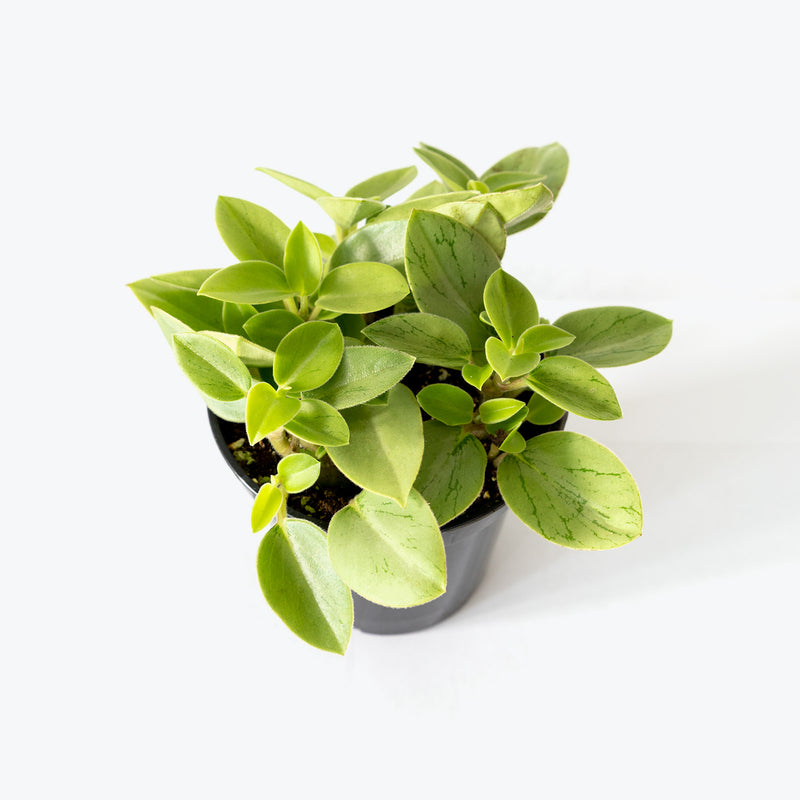
How to care for Peperomia Pixie
They should not be in a position to see the sun directly, although early morning or late evening sun is fine. Filtered sunlight through a sheer curtain is best and most homes are comprised primarily of indirect sunlight. The best spot for them is where they do not see the sun during the majority of the day but still get bright, indirect light.
They will thrive in bright light, but also can tolerate medium light. A good medium-light place in your home would be in the middle of a room that has a regular size window. They can be placed anywhere between the middle of the room and the window. Remember that plants will grow based on how much light they receive.
They like the soil to be relatively dry before the next watering. That usually takes about 2 weeks in an average home environment. It will vary depending on the time of year, your environment and lighting conditions, but for them, it's always safer to underwater or water when you see signs of lack of water (i.e. droopy, floppy, or soft leaves). Expect to water more often in brighter light and less often in lower light.
They can live in any average home humidity condition and are fairly hardy.
They are pet-friendly! So you can feel safe having them around your furry friends. Make sure to keep care fairly consistent, as they don't like too much or too little, light or water.
You can feel comfortable having this plant around your home in the potential case where your pet feels like nibbling on it. However, we typically recommend keeping your pets from eating any of your houseplants..
Learn MoreView PlantPeperomia Pixie Green
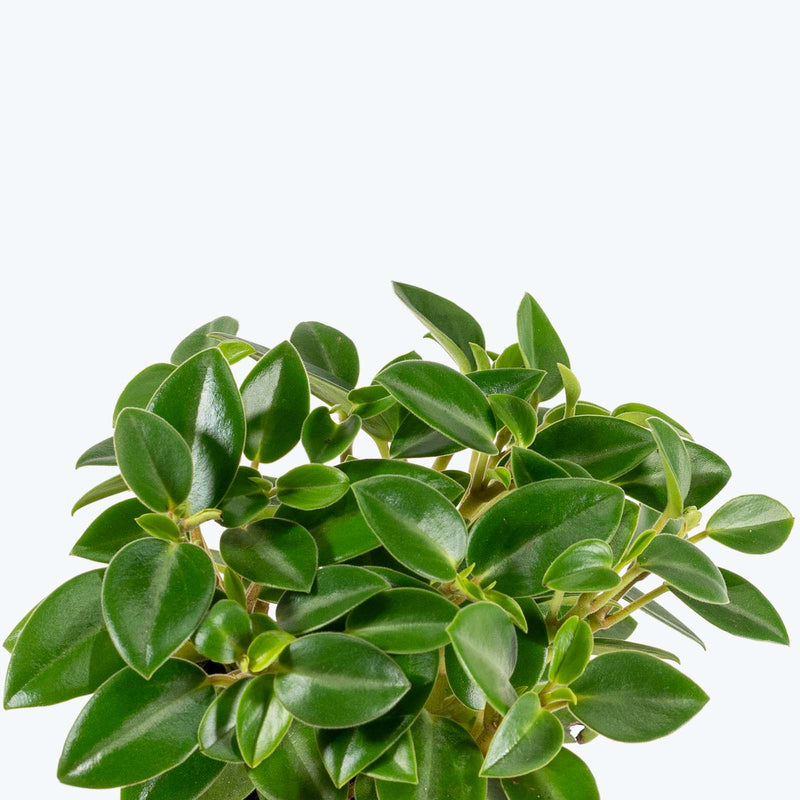
How to care for Peperomia Pixie Green
They should not be in a position to see the sun directly, although early morning or late evening sun is fine. Filtered sunlight through a sheer curtain is best and most homes are comprised primarily of indirect sunlight. The best spot for them is where they do not see the sun during the majority of the day but still get bright, indirect light.
They will thrive in medium to bright light, but also can tolerate low light. A good medium-light place in your home would be in the middle of a room that has a regular size window. They can be placed almost anywhere in the room but remember, plants will grow based on how much light they receive.
They like the soil to be relatively dry before the next watering. That usually takes about 2 weeks in an average home environment. It will vary depending on the time of year, your environment and lighting conditions, but for them, it's always safer to underwater or water when you see signs of lack of water (i.e. droopy, floppy, or soft leaves). Expect to water more often in brighter light and less often in lower light.
They can live in any average home humidity condition and are fairly hardy.
Rotate the plant every so often to ensure even growth and leaf coloration. Overwatering is the most common issue with Peperomia, so be sure to use well-draining soil and pot with drainage holes.
You can feel comfortable having this plant around your home in the potential case where your pet feels like nibbling on it. However, we typically recommend keeping your pets from eating any of your houseplants..
Learn MoreView PlantPeperomia Puteolata
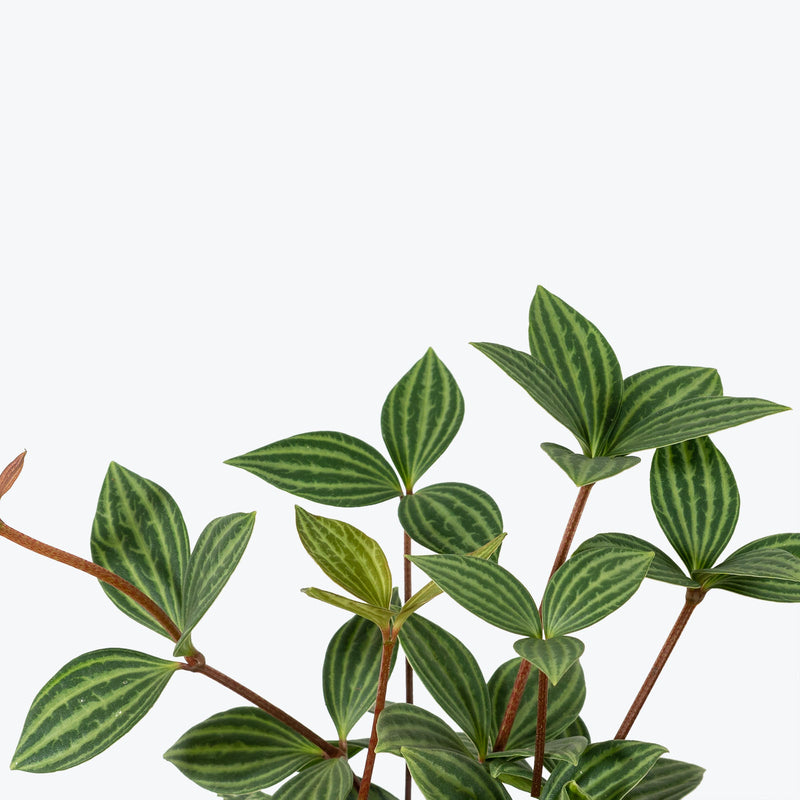
How to care for Peperomia Puteolata
They should not be in a position to see the sun directly, although early morning or late evening sun is fine. Filtered sunlight through a sheer curtain is best and most homes are comprised primarily of indirect sunlight. The best spot for them is where they do not see the sun during the majority of the day but still get bright, indirect light.
They will do well in medium light but will grow faster with brighter light. A good medium-light place in your home would be in the middle of a room that has a regular size window. Remember that plants will grow based on how much light they receive.
They like the soil to be relatively dry before the next watering. That usually takes about 2 weeks in an average home environment. It will vary depending on the time of year, your environment and lighting conditions, but for them, it's always safer to underwater or water when you see signs of lack of water (i.e. droopy, floppy, or soft leaves). Expect to water more often in brighter light and less often in lower light.
They can live in any average home humidity condition and are fairly hardy.
They are pet-friendly! So you can feel safe having them around your furry friends. Make sure to keep care fairly consistent, as they don't like too much or too little, light or water. To have the best growth habit, keep your plant in a location where its foliage can "see" a lot of the sky and minimal direct sunlight (morning or late afternoon sunlight would be just fine) and then water fully when the soil is mostly dry
You can feel comfortable having this plant around your home in the potential case where your pet feels like nibbling on it. However, we typically recommend keeping your pets from eating any of your houseplants..
Learn MoreView PlantPeperomia Quito
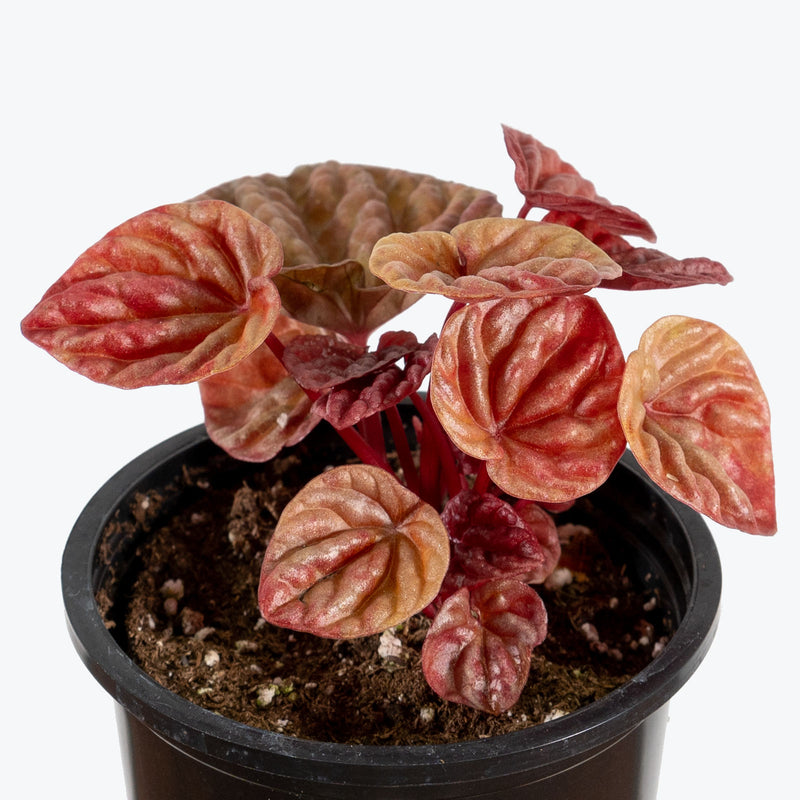
How to care for Peperomia Quito
They should not be in a position to see the sun directly, although early morning or late evening sun is fine. Filtered sunlight through a sheer curtain is best and most homes are comprised primarily of indirect sunlight. The best spot for them is where they do not see the sun during the majority of the day but still get bright, indirect light.
They will thrive in bright light, but also can tolerate medium light. A good medium-light place in your home would be in the middle of a room that has a regular size window. They can be placed anywhere between the middle of the room and the window. Remember that plants will grow based on how much light they receive.
They like the soil to be relatively dry before the next watering. That usually takes about 2 weeks in an average home environment. It will vary depending on the time of year, your environment and lighting conditions, but for them, it's always safer to underwater or water when you see signs of lack of water (i.e. droopy, floppy, or soft leaves). Water more often in the warmer months!
They can live in any average home humidity condition and are fairly hardy.
They are pet friendly! So you can feel safe having them around your furry friends. Make sure to keep care fairly consistent, as they don't like too much or too little, light or water.
You can feel comfortable having this plant around your home in the potential case where your pet feels like nibbling on it. However, we typically recommend keeping your pets from eating any of your houseplants..
Learn MoreView PlantPeperomia Raindrop
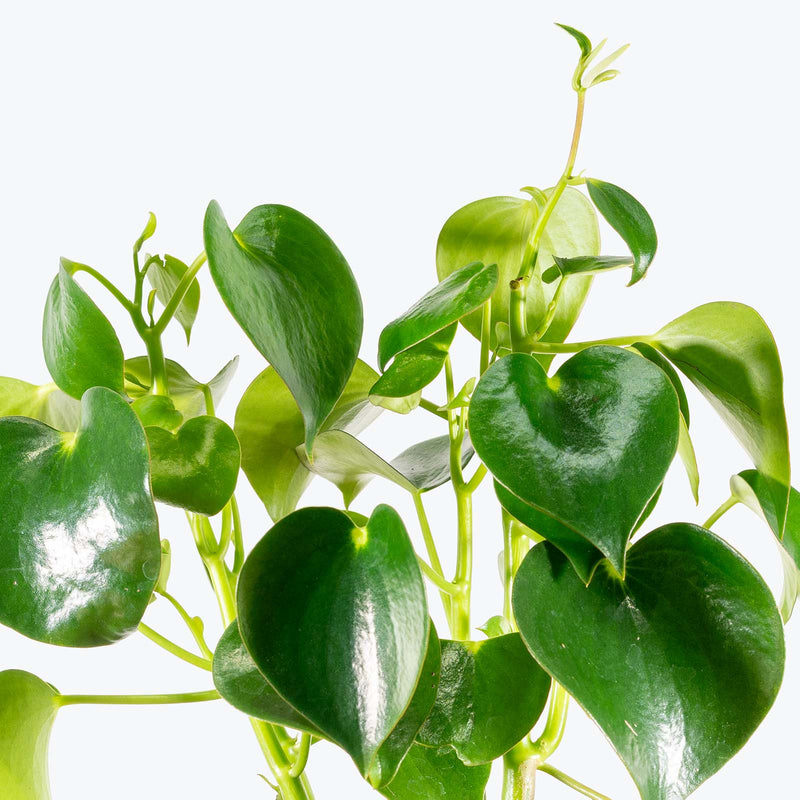
How to care for Peperomia Raindrop
Peperomia Raindrop should not be in a position to see the sun directly, although early morning or late evening sun is fine. Filtered sunlight through a sheer curtain is best and most homes are comprised primarily of indirect sunlight. The best spot for them is where they do not see the sun during the majority of the day but still get bright, indirect light.
Peperomia Raindrop will do well in medium light but will grow faster with brighter light. A good medium-light place in your home would be in the middle of a room that has a regular size window. Remember that plants will grow based on how much light they receive.
Peperomia Raindrop likes the soil to be relatively dry before the next watering. That usually takes about 2 weeks in an average home environment. It will vary depending on the time of year, your environment and lighting conditions, but for them, it's always safer to underwater or water when you see signs of lack of water (i.e. droopy, floppy, or soft leaves). Expect to water more often in brighter light and less often in lower light.
Peperomia Raindrop will do well in average humidity environments but will appreciate a little bit of humidity if provided, give them a mist daily or get a humidifier.
Rotate Peperomia Raindrop regularly to encourage even growth. Use a well-draining potting mix and a pot with drainage holes to avoid soggy roots. Wipe leaves occasionally to keep them glossy. Fertilize monthly during the growing season with a gentle houseplant fertilizer.
You can feel comfortable having Peperomia Raindrop around your home in the potential case where your pet feels like nibbling on it. However, we typically recommend keeping your pets from eating any of your houseplants..
Learn MoreView PlantPeperomia Rana Verde
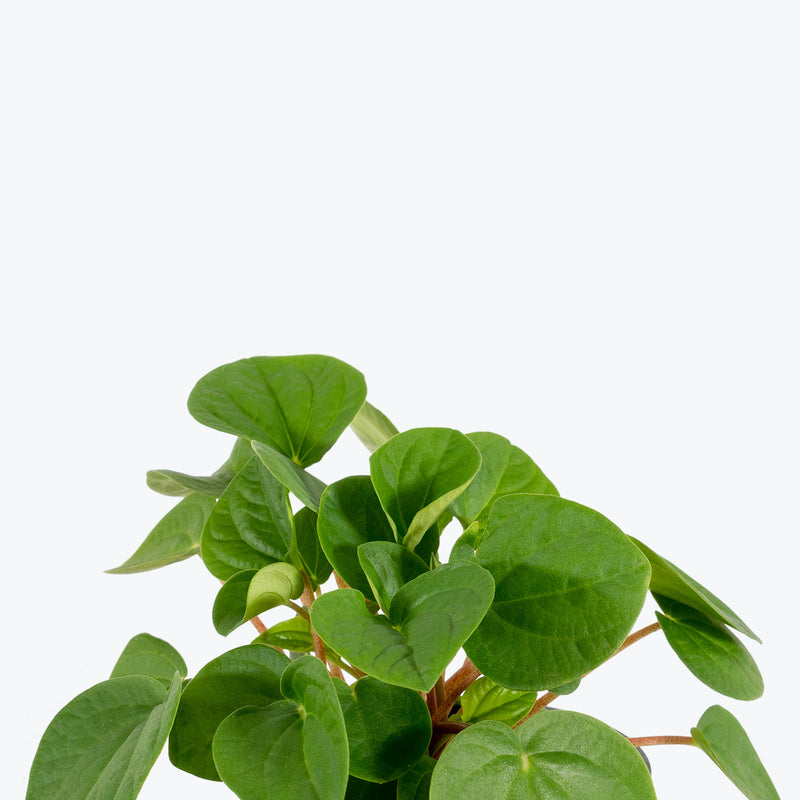
How to care for Peperomia Rana Verde
They should not be in a position to see the sun directly, although early morning or late evening sun is fine. Filtered sunlight through a sheer curtain is best and most homes are comprised primarily of indirect sunlight. The best spot for them is where they do not see the sun during the majority of the day but still get bright, indirect light.
They will thrive in bright light, but also can tolerate medium light. A good medium-light place in your home would be in the middle of a room that has a regular size window. They can be placed anywhere between the middle of the room and the window. Remember that plants will grow based on how much light they receive.
They like the soil to be relatively dry before the next watering. That usually takes about 2 weeks in an average home environment. It will vary depending on the time of year, your environment and lighting conditions, but for them, it's always safer to underwater or water when you see signs of lack of water (i.e. droopy, floppy, or soft leaves). Expect to water more often in brighter light and less often in lower light.
They can live in any average home humidity condition and are fairly hardy.
They are pet-friendly! So you can feel safe having them around your furry friends. Make sure to keep care fairly consistent, as they don't like too much or too little, light or water.
You can feel comfortable having this plant around your home in the potential case where your pet feels like nibbling on it. However, we typically recommend keeping your pets from eating any of your houseplants..
Learn MoreView PlantPeperomia Red Luna
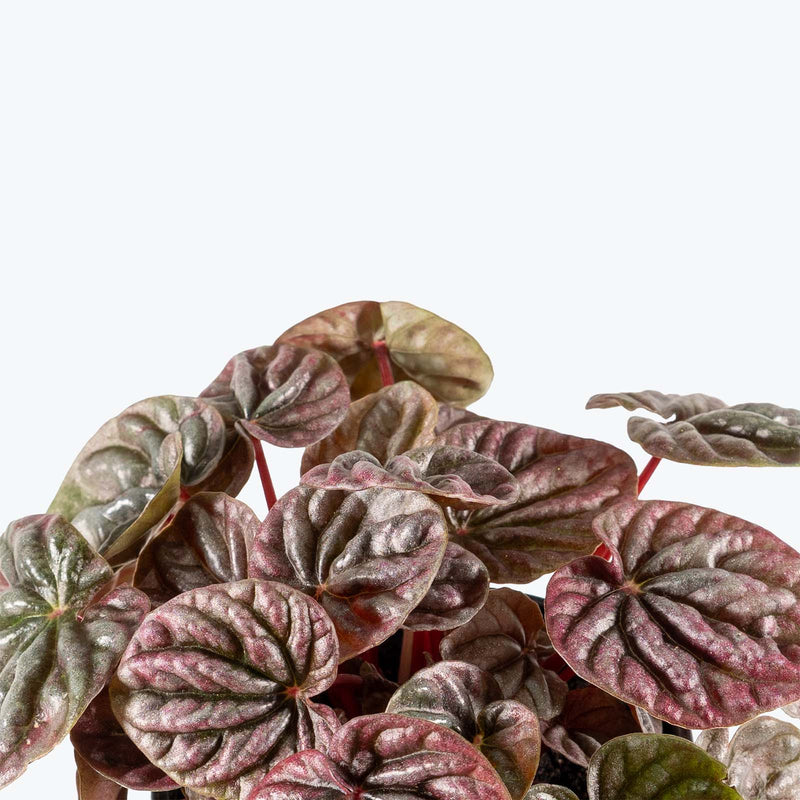
How to care for Peperomia Red Luna
Peperomia Red Luna should not be in a position to see the sun directly, although early morning or late evening sun is fine. Filtered sunlight through a sheer curtain is best and most homes are comprised primarily of indirect sunlight. The best spot for them is where they do not see the sun during the majority of the day but still get bright, indirect light.
Peperomia Red Luna will thrive in bright light, but also can tolerate medium light. A good medium-light place in your home would be in the middle of a room that has a regular size window. They can be placed anywhere between the middle of the room and the window. Remember that plants will grow based on how much light they receive.
Peperomia Red Luna needs to be watered when the top half of the soil is dry to the touch. That usually takes about 1 week in an average home environment. It will vary depending on the time of year, your environment and lighting conditions, but it's always safer to underwater or give the soil a check before you water again. Expect to water more often in brighter light and less often in lower light.
Peperomia Red Luna will do well in average humidity environments but will appreciate a little bit of humidity if provided, give them a mist daily or get a humidifier.
Use a light, well-draining soil mix (such as peat, perlite, and bark) to prevent root rot. Fertilize Peperomia Red Luna monthly during spring and summer with a diluted, balanced fertilizer. Wipe leaves occasionally to remove dust and highlight their metallic sheen. Compact and slow-growing, this plant rarely needs pruning and makes an ideal low-maintenance accent for any space.
You can feel comfortable having Peperomia Red Luna around your home in the potential case where your pet feels like nibbling on it. However, we typically recommend keeping your pets from eating any of your houseplants..
Learn MoreView PlantPeperomia Ripple
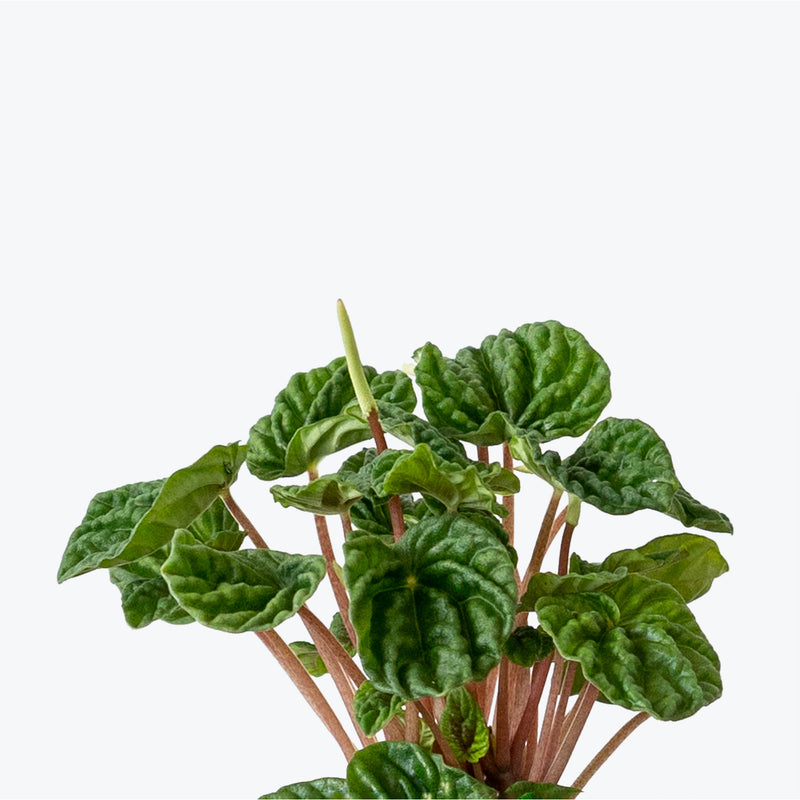
How to care for Peperomia Ripple
They should not be in a position to see the sun directly, although early morning or late evening sun is fine. Filtered sunlight through a sheer curtain is best and most homes are comprised primarily of indirect sunlight. The best spot for them is where they do not see the sun during the majority of the day but still get bright, indirect light.
They will thrive in bright light, but also can tolerate medium light. A good medium-light place in your home would be in the middle of a room that has a regular size window. They can be placed anywhere between the middle of the room and the window. Remember that plants will grow based on how much light they receive.
They like the soil to be relatively dry before the next watering. That usually takes about 2 weeks in an average home environment. It will vary depending on the time of year, your environment and lighting conditions, but for them, it's always safer to underwater or water when you see signs of lack of water (i.e. droopy, floppy, or soft leaves). Water more often in the warmer months!
They can live in any average home humidity condition and are fairly hardy.
They are pet friendly! So you can feel safe having them around your furry friends. Make sure to keep care fairly consistent, as they don't like too much or too little, light or water.
You can feel comfortable having this plant around your home in the potential case where your pet feels like nibbling on it. However, we typically recommend keeping your pets from eating any of your houseplants..
Learn MoreView PlantPeperomia Ripple Variegated
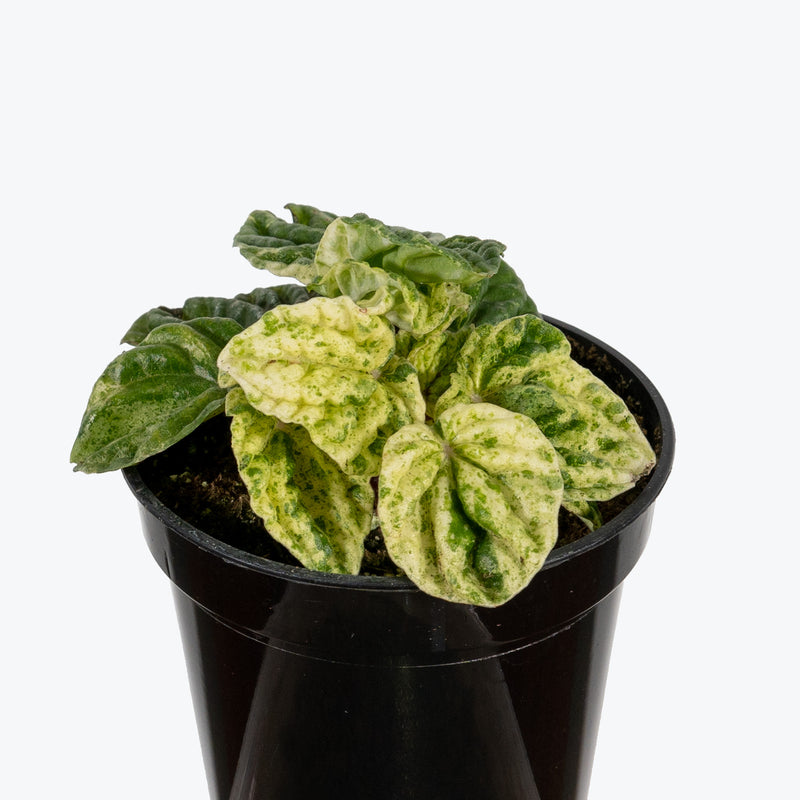
How to care for Peperomia Ripple Variegated
They should not be in a position to see the sun directly, although early morning or late evening sun is fine. Filtered sunlight through a sheer curtain is best and most homes are comprised primarily of indirect sunlight. The best spot for them is where they do not see the sun during the majority of the day but still get bright, indirect light.
They will thrive in bright light, but also can tolerate medium light. A good medium-light place in your home would be in the middle of a room that has a regular size window. They can be placed anywhere between the middle of the room and the window. Remember that plants will grow based on how much light they receive.
They like the soil to be relatively dry before the next watering. That usually takes about 2 weeks in an average home environment. It will vary depending on the time of year, your environment and lighting conditions, but for them, it's always safer to underwater or water when you see signs of lack of water (i.e. droopy, floppy, or soft leaves). Water more often in the warmer months!
They can live in any average home humidity condition and are fairly hardy.
They are pet friendly! So you can feel safe having them around your furry friends. Make sure to keep care fairly consistent, as they don't like too much or too little, light or water.
You can feel comfortable having this plant around your home in the potential case where your pet feels like nibbling on it. However, we typically recommend keeping your pets from eating any of your houseplants..
Learn MoreView PlantPeperomia Rosso
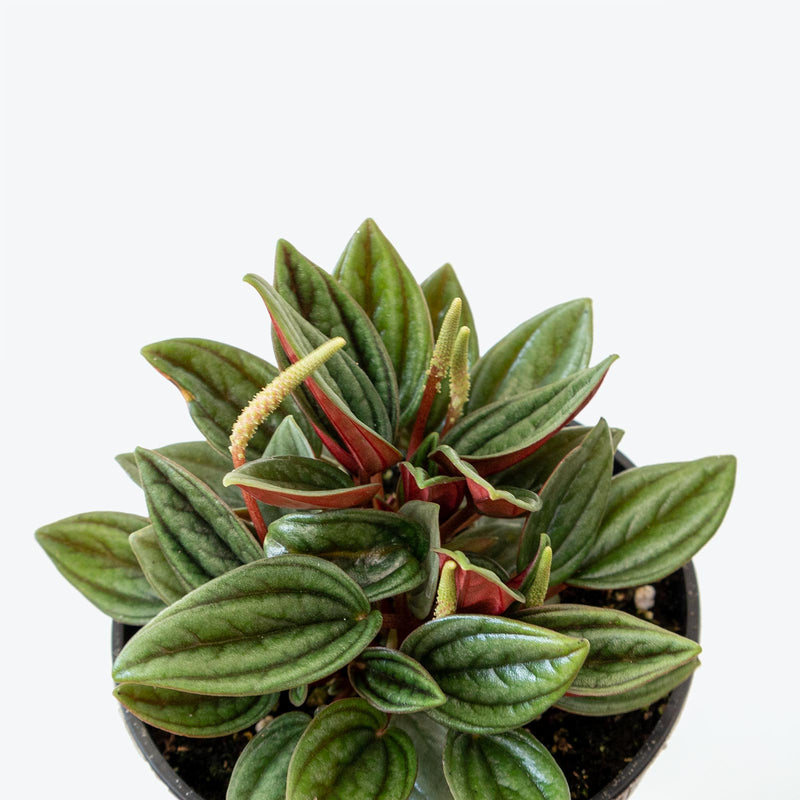
How to care for Peperomia Rosso
They should not be in a position to see the sun directly, although early morning or late evening sun is fine. Filtered sunlight through a sheer curtain is best and most homes are comprised primarily of indirect sunlight. The best spot for them is where they do not see the sun during the majority of the day but still get bright, indirect light.
They will thrive in bright light, but also can tolerate medium light. A good medium-light place in your home would be in the middle of a room that has a regular size window. They can be placed anywhere between the middle of the room and the window. Remember that plants will grow based on how much light they receive.
They like the soil to be relatively dry before the next watering. That usually takes about 2 weeks in an average home environment. It will vary depending on the time of year, your environment and lighting conditions, but for them, it's always safer to underwater or water when you see signs of lack of water (i.e. droopy, floppy, or soft leaves). Expect to water more often in brighter light and less often in lower light.
They can live in any average home humidity condition and are fairly hardy.
They are pet-friendly! So you can feel safe having them around your furry friends. Make sure to keep care fairly consistent, as they don't like too much or too little, light or water.
You can feel comfortable having this plant around your home in the potential case where your pet feels like nibbling on it. However, we typically recommend keeping your pets from eating any of your houseplants..
Learn MoreView PlantPeperomia Rotundifolia
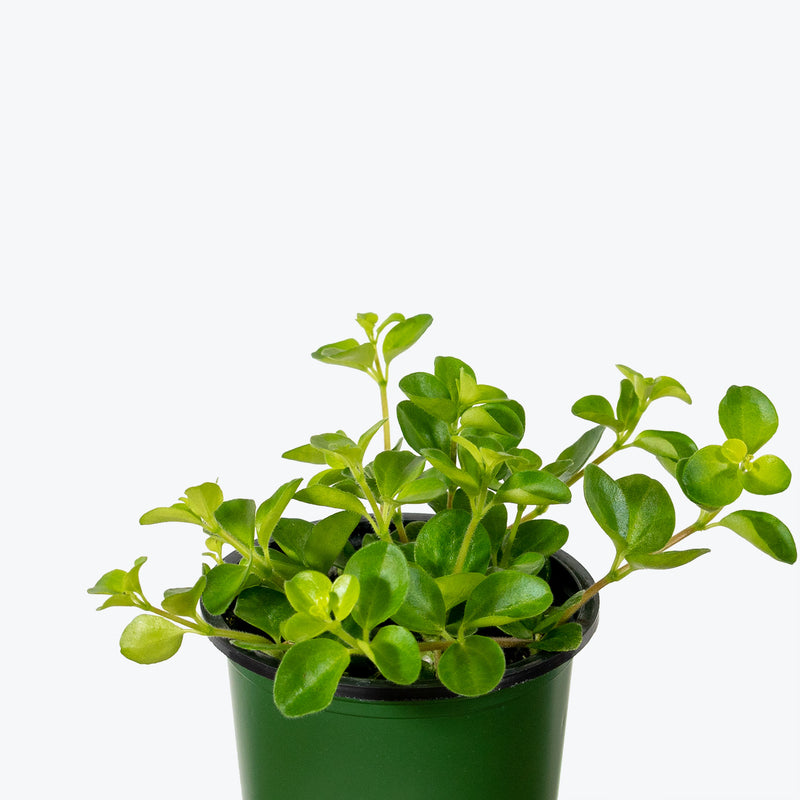
How to care for Peperomia Rotundifolia
They should not be in a position to see the sun directly, although early morning or late evening sun is fine. Filtered sunlight through a sheer curtain is best and most homes are comprised primarily of indirect sunlight. The best spot for them is where they do not see the sun during the majority of the day but still get bright, indirect light.
They will do well in medium light but will grow faster with brighter light. A good medium-light place in your home would be in the middle of a room that has a regular size window. Remember that plants will grow based on how much light they receive.
They like the soil to be relatively dry before the next watering. That usually takes about 2 weeks in an average home environment. It will vary depending on the time of year, your environment and lighting conditions, but for them, it's always safer to underwater or water when you see signs of lack of water (i.e. droopy, floppy, or soft leaves). Expect to water more often in brighter light and less often in lower light.
They can live in any average home humidity condition and are fairly hardy.
They are pet-friendly! So you can feel safe having them around your furry friends. Make sure to keep care fairly consistent, as they don't like too much or too little, light or water.
You can feel comfortable having this plant around your home in the potential case where your pet feels like nibbling on it. However, we typically recommend keeping your pets from eating any of your houseplants..
Learn MoreView PlantPeperomia Ruby Glow
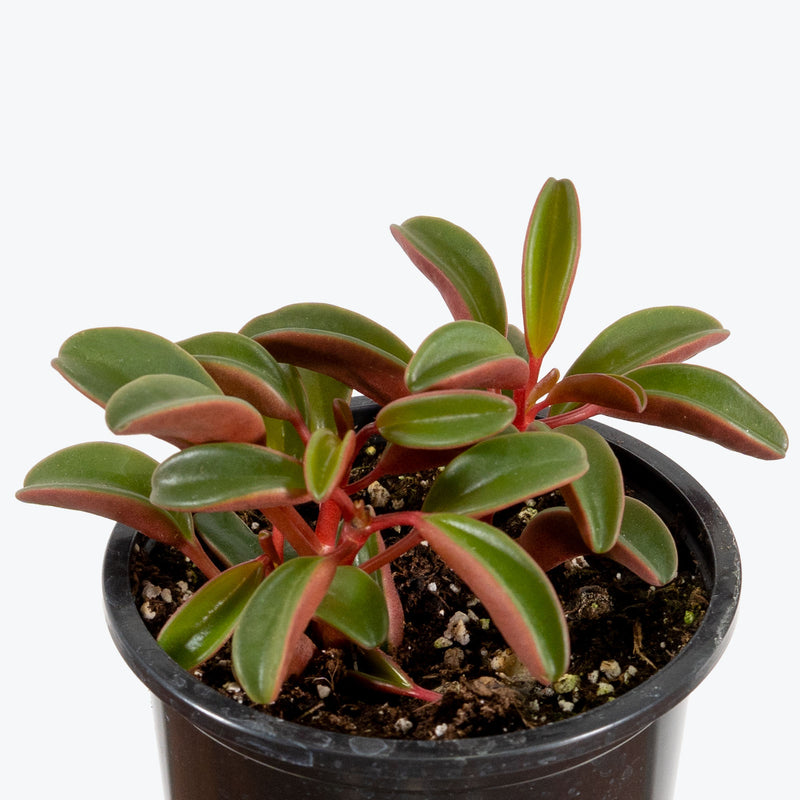
How to care for Peperomia Ruby Glow
They should not be in a position to see the sun directly, although early morning or late evening sun is fine. Filtered sunlight through a sheer curtain is best and most homes are comprised primarily of indirect sunlight. The best spot for them is where they do not see the sun during the majority of the day but still get bright, indirect light.
They will thrive in bright light, but also can tolerate medium light. A good medium-light place in your home would be in the middle of a room that has a regular size window. They can be placed anywhere between the middle of the room and the window. Remember that plants will grow based on how much light they receive.
They like the soil to be relatively dry before the next watering. That usually takes about two weeks in an average home environment. It will vary depending on the time of year, your environment and lighting conditions, but for them, it's always safer to underwater or water when you see signs of lack of water (i.e. droopy, floppy, or soft leaves). Water more often in the warmer months!
They can live in any average home humidity condition and are fairly hardy.
If your Peperomia starts to get "leggy" as it grows, where the growth is stretched out and the leaves are not very dense, consider pruning it back to encourage more growth points, and place it in brighter spot than it was before! They are also pet-friendly, so you can feel safe having them around your furry friends.
You can feel comfortable having this plant around your home in the potential case where your pet feels like nibbling on it. However, we typically recommend keeping your pets from eating any of your houseplants..
Learn MoreView PlantPeperomia Scandens Variegata
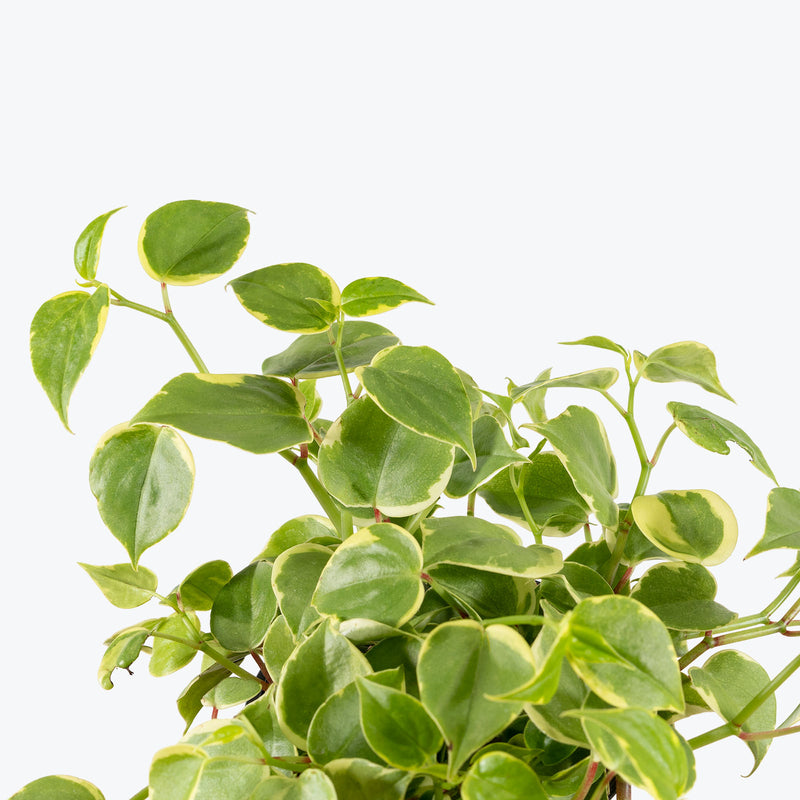
How to care for Peperomia Scandens Variegata
They should not be in a position to see the sun directly, although early morning or late evening sun is fine. Filtered sunlight through a sheer curtain is best and most homes are comprised primarily of indirect sunlight. The best spot for them is where they do not see the sun during the majority of the day but still get bright, indirect light.
They will thrive in bright light, but also can tolerate medium light. A good medium-light place in your home would be in the middle of a room that has a regular size window. They can be placed anywhere between the middle of the room and the window. Remember that plants will grow based on how much light they receive.
They like the soil to be relatively dry before the next watering. That usually takes about 2 weeks in an average home environment. It will vary depending on the time of year, your environment and lighting conditions, but for them, it's always safer to underwater or water when you see signs of lack of water (i.e. droopy, floppy, or soft leaves). Expect to water more often in brighter light and less often in lower light.
They will do well in average humidity environments but will appreciate a little bit of humidity if provided, give them a mist daily or get a humidifier.
Make sure to keep care fairly consistent, as they don't like too much or too little, light or water. Prune your plant if it gets leggy or if you would like to promote bushier growth.
You can feel comfortable having this plant around your home in the potential case where your pet feels like nibbling on it. However, we typically recommend keeping your pets from eating any of your houseplants..
Learn MoreView PlantPeperomia Schumi Red
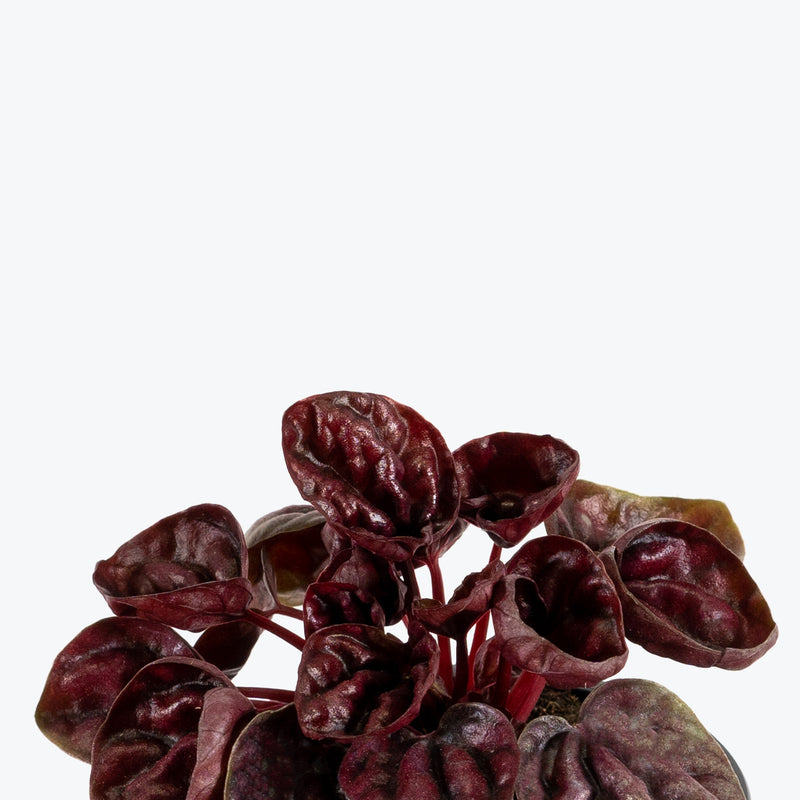
How to care for Peperomia Schumi Red
Peperomia Schumi Red should not be in a position to see the sun directly, although early morning or late evening sun is fine. Filtered sunlight through a sheer curtain is best and most homes are comprised primarily of indirect sunlight. The best spot for them is where they do not see the sun during the majority of the day but still get bright, indirect light.
Peperomia Schumi Red will thrive in bright light, but also can tolerate medium light. A good medium-light place in your home would be in the middle of a room that has a regular size window. They can be placed anywhere between the middle of the room and the window. Remember that plants will grow based on how much light they receive.
Peperomia Schumi Red likes the soil to be relatively dry before the next watering. That usually takes about 2 weeks in an average home environment. It will vary depending on the time of year, your environment and lighting conditions, but for them, it's always safer to underwater or water when you see signs of lack of water (i.e. droopy, floppy, or soft leaves). Expect to water more often in brighter light and less often in lower light.
Peperomia Schumi Red can live in any average home humidity condition and are fairly hardy.
Peperomia Schumi Red is pet-friendly! So you can feel safe having them around your furry friends. Make sure to keep care fairly consistent, as they don't like too much or too little, light or water.
You can feel comfortable having Peperomia Schumi Red around your home in the potential case where your pet feels like nibbling on it. However, we typically recommend keeping your pets from eating any of your houseplants..
Learn MoreView PlantPeperomia Silver Frost
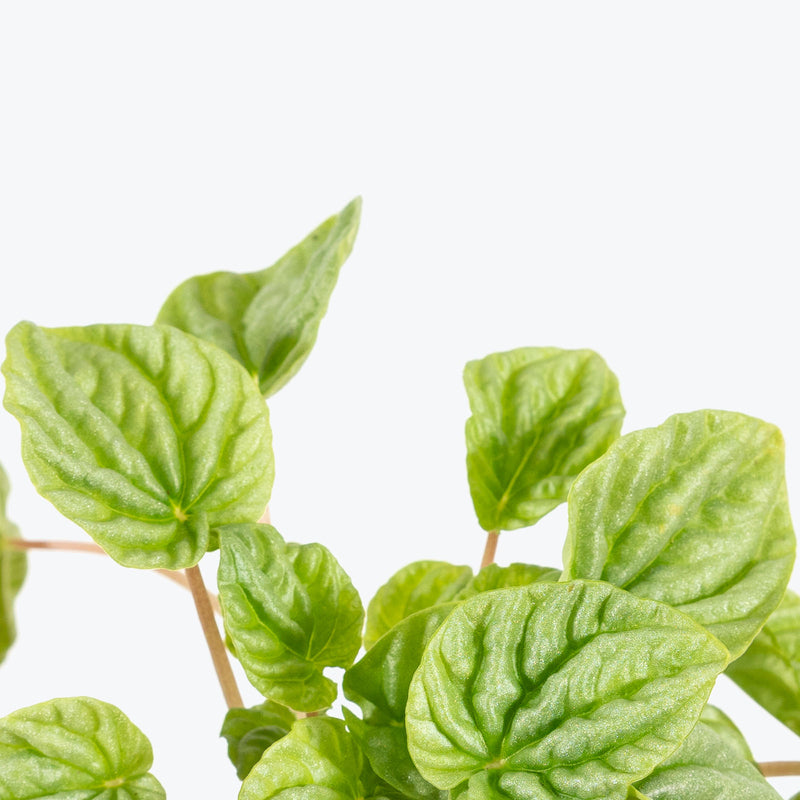
How to care for Peperomia Silver Frost
They should not be in a position to see the sun directly, although early morning or late evening sun is fine. Filtered sunlight through a sheer curtain is best and most homes are comprised primarily of indirect sunlight. The best spot for them is where they do not see the sun during the majority of the day but still get bright, indirect light.
They will thrive in bright light, but also can tolerate medium light. A good medium-light place in your home would be in the middle of a room that has a regular size window. They can be placed anywhere between the middle of the room and the window. Remember that plants will grow based on how much light they receive.
They like the soil to be relatively dry before the next watering. That usually takes about 2 weeks in an average home environment. It will vary depending on the time of year, your environment and lighting conditions, but for them, it's always safer to underwater or water when you see signs of lack of water (i.e. droopy, floppy, or soft leaves). Expect to water more often in brighter light and less often in lower light.
They can live in any average home humidity condition and are fairly hardy.
They are pet-friendly! So you can feel safe having them around your furry friends. Make sure to keep care fairly consistent, as they don't like too much or too little, light or water.
You can feel comfortable having this plant around your home in the potential case where your pet feels like nibbling on it. However, we typically recommend keeping your pets from eating any of your houseplants..
Learn MoreView PlantPeperomia Sunrise
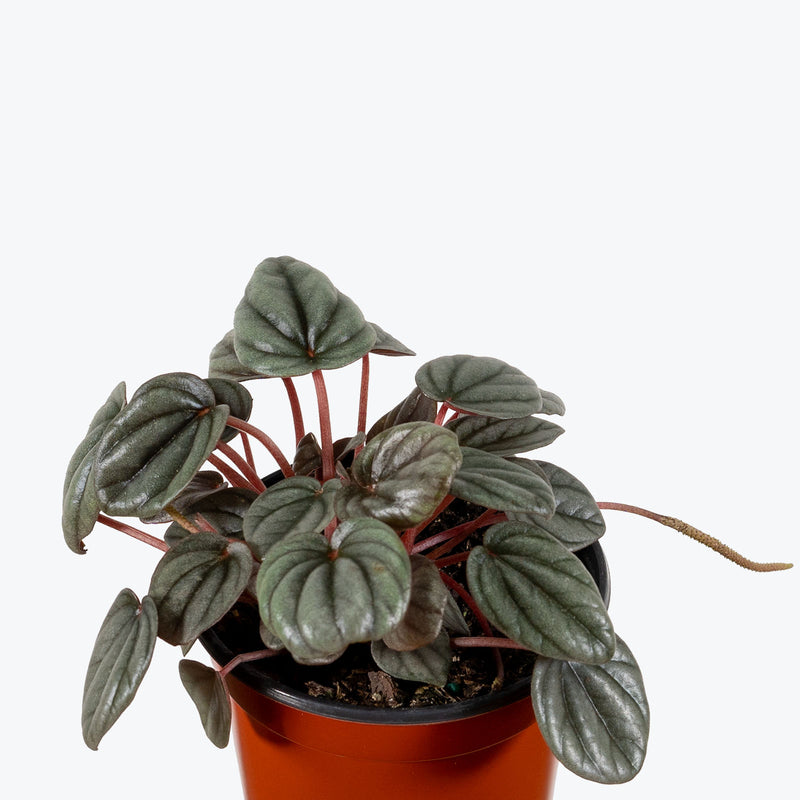
How to care for Peperomia Sunrise
They should not be in a position to see the sun directly, although early morning or late evening sun is fine. Filtered sunlight through a sheer curtain is best and most homes are comprised primarily of indirect sunlight. The best spot for them is where they do not see the sun during the majority of the day but still get bright, indirect light.
They will thrive in medium to bright light, but also can tolerate low light. A good medium-light place in your home would be in the middle of a room that has a regular size window. They can be placed almost anywhere in the room but remember, plants will grow based on how much light they receive.
They like the soil to be relatively dry before the next watering. That usually takes about 2 weeks in an average home environment. It will vary depending on the time of year, your environment and lighting conditions, but for them, it's always safer to underwater or water when you see signs of lack of water (i.e. droopy, floppy, or soft leaves). Expect to water more often in brighter light and less often in lower light.
They will do well in average humidity environments but will appreciate a little bit of humidity if provided, give them a mist daily or get a humidifier.
It doesn’t like cold weather and cannot survive under cold conditions for long so it should be kept warm and it does best under bright to medium, indirect sunlight. They are also pet friendly! So you can feel safe having them around your furry friends. Make sure to keep care fairly consistent, as they don't like too much or too little, light or water.
You can feel comfortable having this plant around your home in the potential case where your pet feels like nibbling on it. However, we typically recommend keeping your pets from eating any of your houseplants..
Learn MoreView PlantPeperomia Verticillata
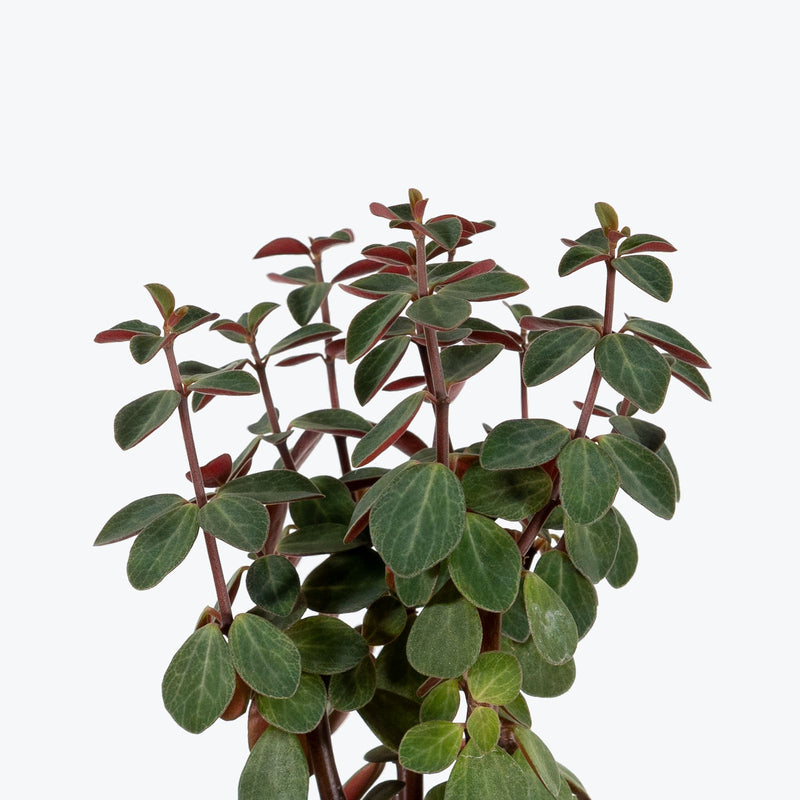
How to care for Peperomia Verticillata
They should not be in a position to see the sun directly, although early morning or late evening sun is fine. Filtered sunlight through a sheer curtain is best and most homes are comprised primarily of indirect sunlight. The best spot for them is where they do not see the sun during the majority of the day but still get bright, indirect light.
They will thrive in bright light, but also can tolerate medium light. A good medium-light place in your home would be in the middle of a room that has a regular size window. They can be placed anywhere between the middle of the room and the window. Remember that plants will grow based on how much light they receive.
They like the soil to be relatively dry before the next watering. That usually takes about 2 weeks in an average home environment. It will vary depending on the time of year, your environment and lighting conditions, but for them, it's always safer to underwater or water when you see signs of lack of water (i.e. droopy, floppy, or soft leaves). Expect to water more often in brighter light and less often in lower light.
They can live in any average home humidity condition and are fairly hardy.
To keep your plant from getting too leggy and stretched out, make sure it is kept in a location in which its foliage has a large view of the sky with minimal direct sunlight. If it starts getting too tall, feel free to trim your plant back and it will branch off easily, staying full and compact.
You can feel comfortable having this plant around your home in the potential case where your pet feels like nibbling on it. However, we typically recommend keeping your pets from eating any of your houseplants..
Learn MoreView PlantPeperomia Watermelon
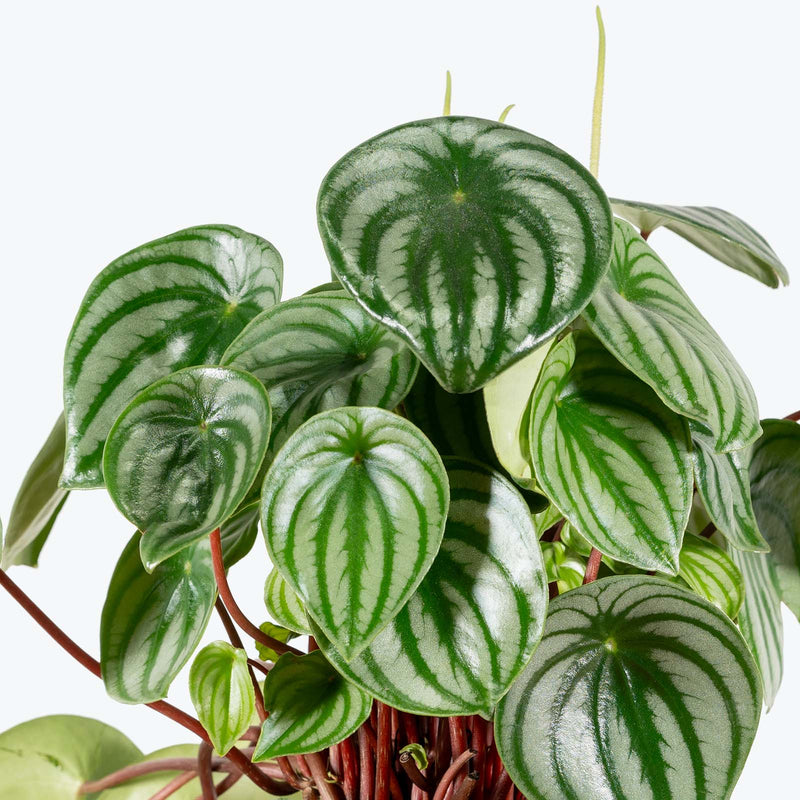
How to care for Peperomia Watermelon
Peperomia Watermelon should not be in a position to see the sun directly, although early morning or late evening sun is fine. Filtered sunlight through a sheer curtain is best and most homes are comprised primarily of indirect sunlight. The best spot for them is where they do not see the sun during the majority of the day but still get bright, indirect light.
Peperomia Watermelon will thrive in bright light, but also can tolerate medium light. A good medium-light place in your home would be in the middle of a room that has a regular size window. They can be placed anywhere between the middle of the room and the window. Remember that plants will grow based on how much light they receive.
Peperomia Watermelon likes the soil to be relatively dry before the next watering. That usually takes about 2 weeks in an average home environment. It will vary depending on the time of year, your environment and lighting conditions, but for them, it's always safer to underwater or water when you see signs of lack of water (i.e. droopy, floppy, or soft leaves). Expect to water more often in brighter light and less often in lower light.
Peperomia Watermelon can live in any average home humidity condition and are fairly hardy.
Peperomia Watermelon doesn't like too much or too little, light or water, and benefits from regular, light feeding during the growing season. It can be propagated easily through leaf cuttings, simply cut their leaves into strips and place them on top of the soil, they should start to root in a few weeks.
You can feel comfortable having Peperomia Watermelon around your home in the potential case where your pet feels like nibbling on it. However, we typically recommend keeping your pets from eating any of your houseplants..
Learn MoreView PlantPeperomia Watermelon 'Harmony's Gold Dust'
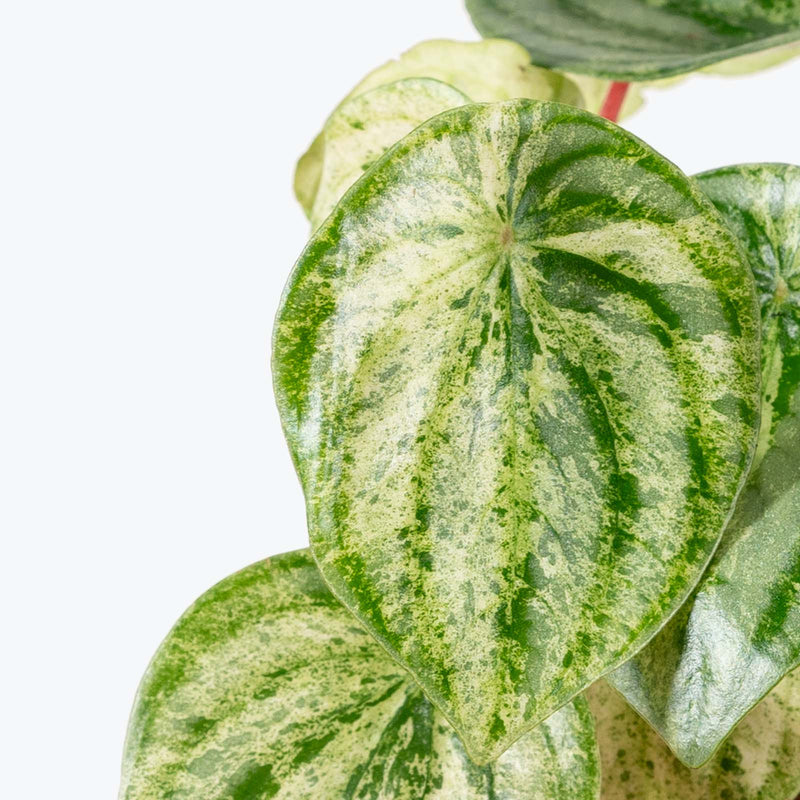
How to care for Peperomia Watermelon 'Harmony's Gold Dust'
Peperomia Watermelon 'Harmony's Gold Dust' should not be in a position to see the sun directly, although early morning or late evening sun is fine. Filtered sunlight through a sheer curtain is best and most homes are comprised primarily of indirect sunlight. The best spot for them is where they do not see the sun during the majority of the day but still get bright, indirect light.
Peperomia Watermelon 'Harmony's Gold Dust’ will do best in bright light. A nice bright place inside your home would be on the window sill or a stool that is right next to a window, either with or without blinds, depending on if the plant can handle sun. Remember that plants will grow based on how much light they receive.
Peperomia Watermelon 'Harmony's Gold Dust' likes the soil to be relatively dry before the next watering. That usually takes about 2 weeks in an average home environment. It will vary depending on the time of year, your environment and lighting conditions, but for them, it's always safer to underwater or water when you see signs of lack of water (i.e. droopy, floppy, or soft leaves). Expect to water more often in brighter light and less often in lower light.
Peperomia Watermelon 'Harmony's Gold Dust' can live in any average home humidity condition and are fairly hardy.
Peperomia Watermelon 'Harmony's Gold Dust' doesn't like too much or too little, light or water, and benefits from regular, light feeding during the growing season. It can be propagated easily through leaf cuttings, simply cut their leaves into strips and place them on top of the soil, they should start to root in a few weeks.
You can feel comfortable having Peperomia Watermelon 'Harmony's Gold Dust' around your home in the potential case where your pet feels like nibbling on it. However, we typically recommend keeping your pets from eating any of your houseplants..
Learn MoreView PlantPeperomia Wolfgang Krahnii

How to care for Peperomia Wolfgang Krahnii
They should not be in a position to see the sun directly, although early morning or late evening sun is fine. Filtered sunlight through a sheer curtain is best and most homes are comprised primarily of indirect sunlight. The best spot for them is where they do not see the sun during the majority of the day but still get bright, indirect light.
They will thrive in bright light, but also can tolerate medium light. A good medium-light place in your home would be in the middle of a room that has a regular size window. They can be placed anywhere between the middle of the room and the window. Remember that plants will grow based on how much light they receive.
They like the soil to be relatively dry before the next watering. That usually takes about 2 weeks in an average home environment. It will vary depending on the time of year, your environment and lighting conditions, but for them, it's always safer to underwater or water when you see signs of lack of water (i.e. droopy, floppy, or soft leaves). Expect to water more often in brighter light and less often in lower light.
They can live in any average home humidity condition and are fairly hardy.
They are pet-friendly! So you can feel safe having them around your furry friends. Make sure to keep care fairly consistent, as they don't like too much or too little, light or water.
You can feel comfortable having this plant around your home in the potential case where your pet feels like nibbling on it. However, we typically recommend keeping your pets from eating any of your houseplants..
Learn MoreView PlantPersian Shield
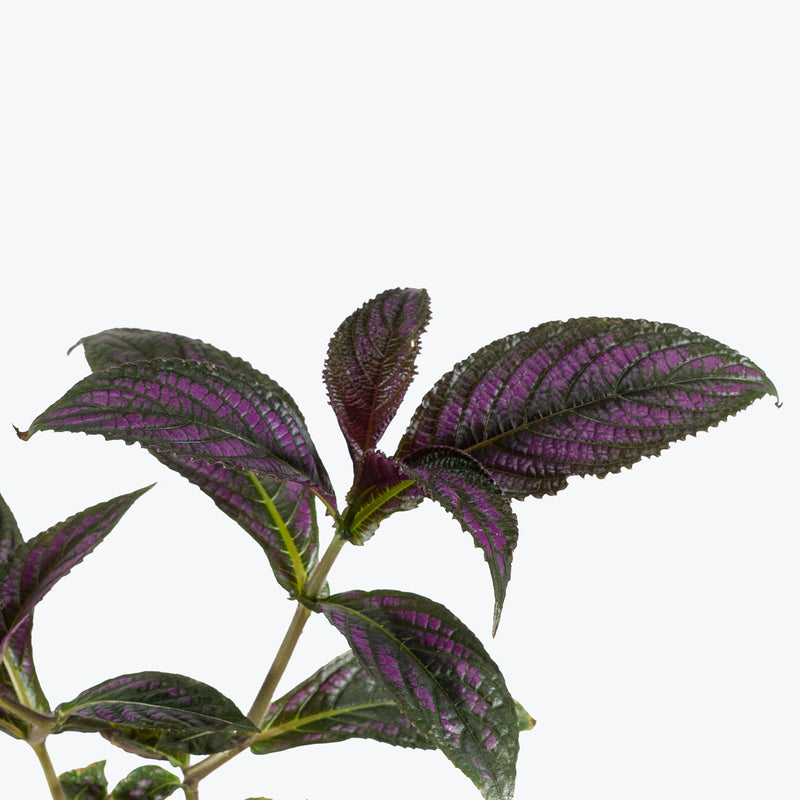
How to care for Persian Shield
They should not be in a position to see the sun directly, although early morning or late evening sun is fine. Filtered sunlight through a sheer curtain is best and most homes are comprised primarily of indirect sunlight. The best spot for them is where they do not see the sun during the majority of the day but still get bright, indirect light.
They will thrive in bright light, but also can tolerate medium light. A good medium-light place in your home would be in the middle of a room that has a regular size window. They can be placed anywhere between the middle of the room and the window. Remember that plants will grow based on how much light they receive.
They like the soil to stay consistently moist, but not soaking wet. Give them water whenever just the surface of the soil is starting to get dry. Expect to water more often in brighter light and less often in lower light.
They will do well in average humidity environments but will appreciate a little bit of humidity if provided, give them a mist daily or get a humidifier.
The Persian Shield may occasionally flower, producing small, violet blossoms, though it's primarily grown for its foliage. Regular pruning can help maintain a bushier appearance and encourage more vibrant leaf growth.
You can feel comfortable having this plant around your home in the potential case where your pet feels like nibbling on it. However, we typically recommend keeping your pets from eating any of your houseplants..
View PlantPeruvian Torch Cactus
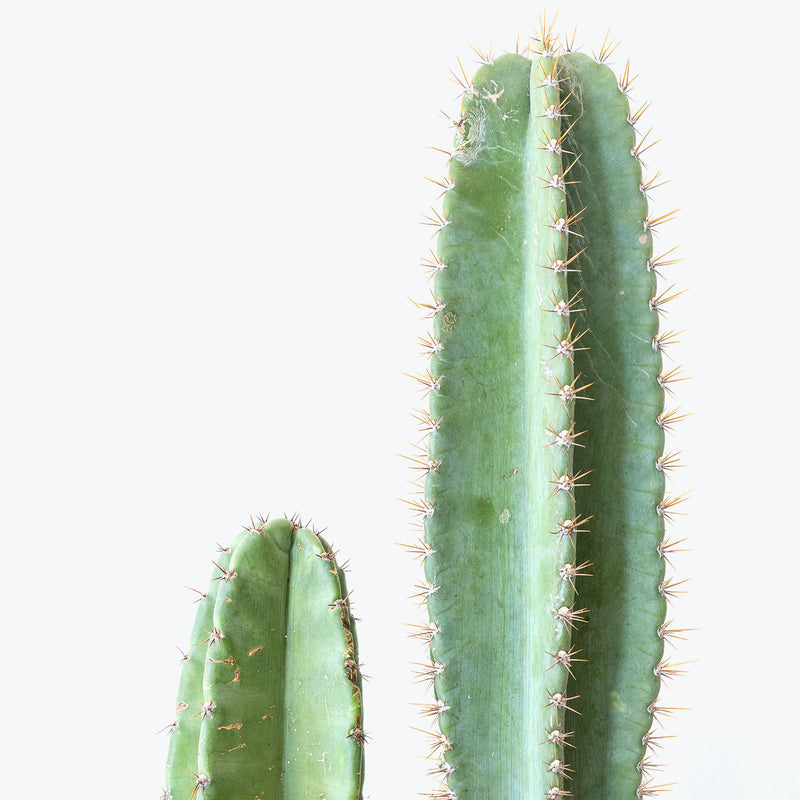
How to care for Peruvian Torch Cactus
They enjoy some direct sun, but they'll also do well in bright, indirect light. It is best to place this plant somewhere where it will receive some nice morning sun, or a couple hours of afternoon sun, and then indirect light the rest of the day.
They will do best in bright light. A nice bright place inside your home would be on the window sill or a stool that is right next to a window, either with or without blinds, depending on if the plant can handle sun. Remember that plants will grow based on how much light they receive.
They like the soil to be completely dry before the next watering. That usually takes about 4 weeks in an average home environment. It will vary depending on the time of year, your environment and lighting conditions, but for them, it's always safer to underwater or water when you see signs of lack of water (i.e. wrinkly or soft leaves). Water a little more often in the warmer months.
Their humidity requirement is low, so do not mist them or put them in a terrarium.
They will like a very warm and bright location in your home. Avoid giving them too much water.
This plant is moderately toxic and can cause some adverse reactions when ingested so it is best to not let your pets eat it, which we advise for all plants in general. The severity of the reaction will depend on how much of the plant is ingested but, if you know your pet typically does not eat your plants, this plant will be suitable for your home..
Learn MoreView PlantPet Friendly Mystery Box
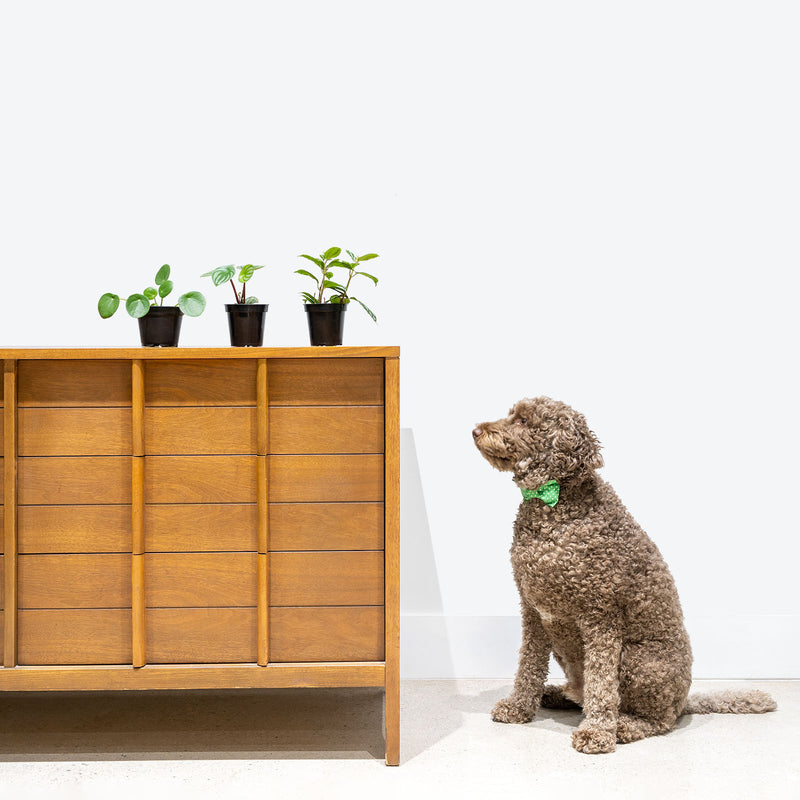
How to care for Pet Friendly Mystery Box
They should not be in a position to see the sun directly, although early morning or late evening sun is fine. Filtered sunlight through a sheer curtain is best and most homes are comprised primarily of indirect sunlight. The best spot for them is where they do not see the sun during the majority of the day but still get bright, indirect light.
They will thrive in bright light, but also can tolerate medium light. A good medium-light place in your home would be in the middle of a room that has a regular size window. They can be placed anywhere between the middle of the room and the window. Remember that plants will grow based on how much light they receive.
They like the soil to be relatively dry before the next watering. That usually takes about 2 weeks in an average home environment. It will vary depending on the time of year, your environment and lighting conditions, but for them, it's always safer to underwater or water when you see signs of lack of water (i.e. droopy, floppy, or soft leaves). Expect to water more often in brighter light and less often in lower light.
They can live in any average home humidity condition and are fairly hardy.
They are all pet friendly, but if your fur friends are into plants as well, it is still recommended to keep them somewhere your pets can't reach for the safe of the plant. The care for each plant varies, remember to check the care instructions for each of them by scanning the QR code on the planter or searching our website.
You can feel comfortable having this plant around your home in the potential case where your pet feels like nibbling on it. However, we typically recommend keeping your pets from eating any of your houseplants..
View PlantPhalaenopsis Orchid

How to care for Phalaenopsis Orchid
Phalaenopsis Orchid should not be in a position to see the sun directly. Filtered sunlight through a sheer curtain is best and most homes are comprised primarily of indirect sunlight. The best spot for them is where they do not see the sun during the majority of the day but still get bright, indirect light.
Phalaenopsis Orchid will thrive in bright light, but also can tolerate medium light. A good medium-light place in your home would be in the middle of a room that has a regular size window. They can be placed anywhere between the middle of the room and the window. Remember that plants will grow based on how much light they receive.
Phalaenopsis Orchid likes the soil to be relatively dry before the next watering. That usually takes about 1 week in an average home environment, as they are typically potted in a bark mix that allows for quick drainage and good air circulation. It will vary depending on the time of year, your environment and lighting conditions, but for them, it's always safer to underwater or water when you see signs of lack of water (i.e. droopy, floppy, or soft leaves). Expect to water more often in brighter light and less often in lower light.
Phalaenopsis Orchid likes a high humidity environment, give them a mist daily or as often as possible. Alternatively, you can put them around a humidifier or they are perfect for a terrarium. Although they won't die if they don't receive enough humidity, their leaves may have some dry, crunchy, or yellow edges.
To water, soak the pot in a sink filled with water for about 5 to 10 minutes, then allow it to drain completely before placing it back. Fertilize your Phalaenopsis orchid every other week during the growing season with a balanced, orchid-specific fertilizer diluted to half strength. During the dormant period (usually after flowering), reduce feeding to once a month. After the flowers fall, you can encourage reblooming by cutting the flower spike above the second or third node from the base.
You can feel comfortable having Phalaenopsis Orchid around your home in the potential case where your pet feels like nibbling on it. However, we typically recommend keeping your pets from eating any of your houseplants..
View PlantPhilodendron 69686 Bette Waterbury
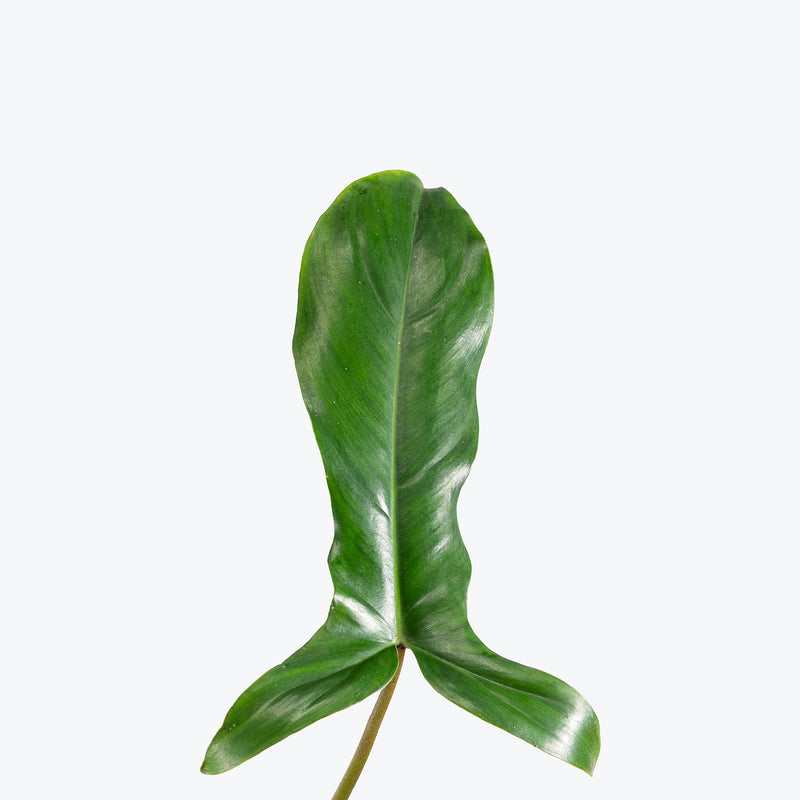
How to care for Philodendron 69686 Bette Waterbury
Philodendron 69686 Bette Waterbury should not be in a position to see the sun directly, although early morning or late evening sun is fine. Filtered sunlight through a sheer curtain is best and most homes are comprised primarily of indirect sunlight. The best spot for them is where they do not see the sun during the majority of the day but still get bright, indirect light.
Philodendron 69686 Bette Waterbury will thrive in bright light, but also can tolerate medium light. A good medium-light place in your home would be in the middle of a room that has a regular size window. They can be placed anywhere between the middle of the room and the window. Remember that plants will grow based on how much light they receive.
Philodendron 69686 Bette Waterbury needs to be watered when the top half of the soil is dry to the touch. That usually takes about 1 week in an average home environment. It will vary depending on the time of year, your environment and lighting conditions, but it's always safer to underwater or give the soil a check before you water again. Expect to water more often in brighter light and less often in lower light.
Philodendron 69686 Bette Waterbury will do well in average humidity environments but will appreciate a little bit of humidity if provided, give them a mist daily or get a humidifier.
Fertilize Philodendron 69686 Bette Waterbury every 4-6 weeks during the growing season with a balanced, liquid fertilizer diluted to half strength. During the winter months, reduce fertilization as the plant's growth naturally slows. Regularly wipe the leaves with a damp cloth to remove dust and maintain the plant’s health and appearance. Provide a moss pole to encourage vertical growth.
Philodendron 69686 Bette Waterbury is moderately toxic and can cause some adverse reactions when ingested so it is best to not let your pets eat it, which we advise for all plants in general. The severity of the reaction will depend on how much of the plant is ingested but, if you know your pet typically does not eat your plants, this plant will be suitable for your home..
Learn MoreView PlantPhilodendron Billietiae
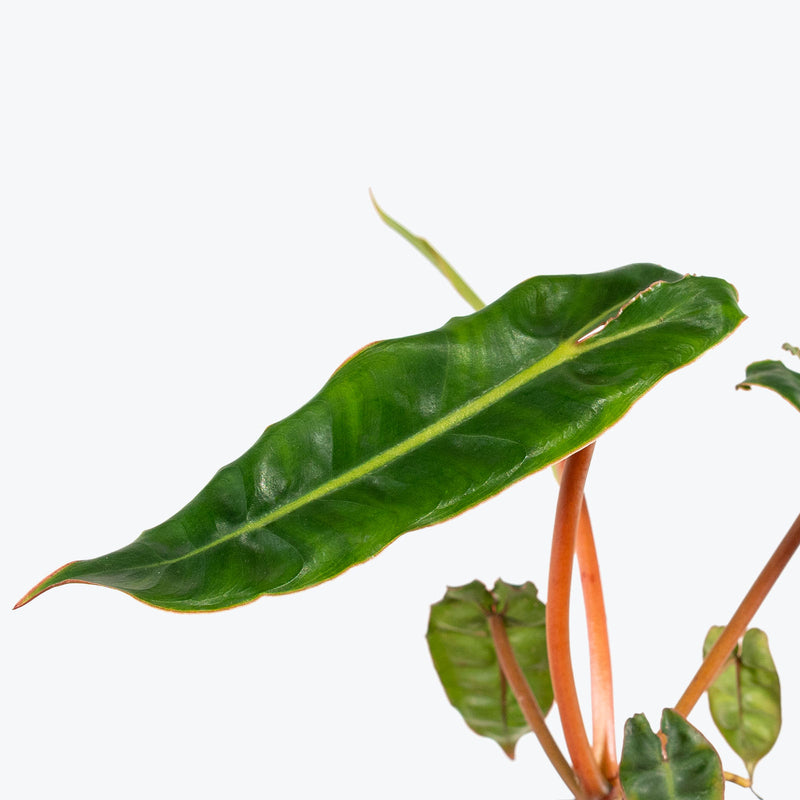
How to care for Philodendron Billietiae
Philodendron Billietiae should not be in a position to see the sun directly, although early morning or late evening sun is fine. Filtered sunlight through a sheer curtain is best and most homes are comprised primarily of indirect sunlight. The best spot for them is where they do not see the sun during the majority of the day but still get bright, indirect light.
Philodendron Billietiae will do best in bright light. A nice bright place inside your home would be on the window sill or a stool that is right next to a window, either with or without blinds, depending on if the plant can handle sun. Remember that plants will grow based on how much light they receive.
Philodendron Billietiae needs to be watered when the top half of the soil is dry to the touch. That usually takes about 1 week in an average home environment. It will vary depending on the time of year, your environment and lighting conditions, but it's always safer to underwater or give the soil a check before you water again. Expect to water more often in brighter light and less often in lower light.
Philodendron Billietiae will do well in average humidity environments but will appreciate a little bit of humidity if provided, give them a mist daily or get a humidifier.
The essential aspects are the amount of light and the extent to which the soil is well-draining. Placing Philodendron Billietiae in bright but indirect light is most ideal. Provide a moss pole or trellis for support as it grows to encourage vertical growth and mimic its natural climbing habit.
Philodendron Billietiae is moderately toxic and can cause some adverse reactions when ingested so it is best to not let your pets eat it, which we advise for all plants in general. The severity of the reaction will depend on how much of the plant is ingested but, if you know your pet typically does not eat your plants, this plant will be suitable for your home..
Learn MoreView PlantPhilodendron Billietiae Black Form
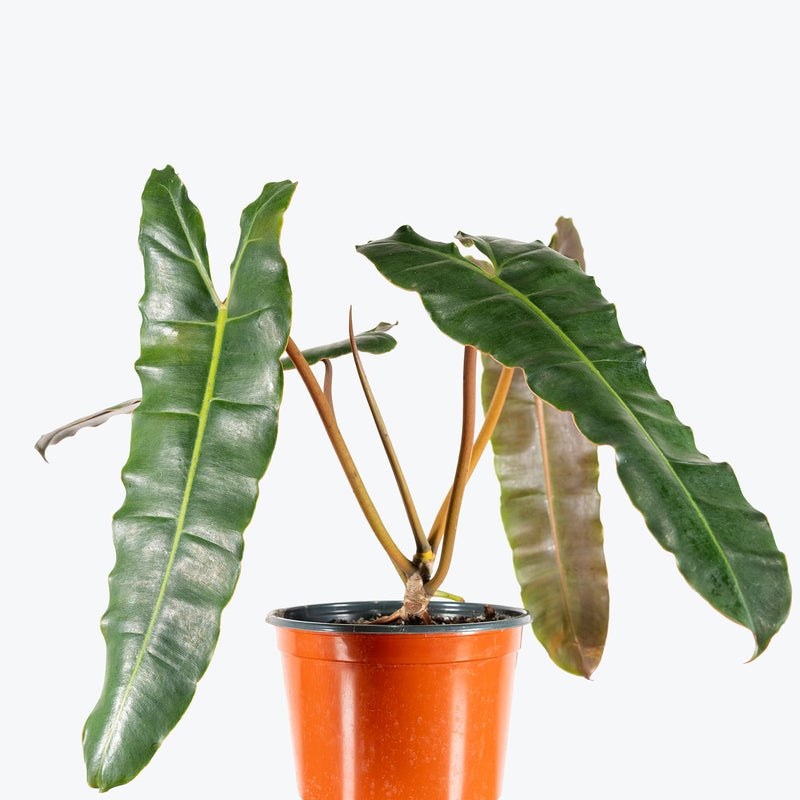
How to care for Philodendron Billietiae Black Form
Philodendron Billietiae Black Form should not be in a position to see the sun directly, although early morning or late evening sun is fine. Filtered sunlight through a sheer curtain is best and most homes are comprised primarily of indirect sunlight. The best spot for them is where they do not see the sun during the majority of the day but still get bright, indirect light.
Philodendron Billietiae Black Form will do best in bright light. A nice bright place inside your home would be on the window sill or a stool that is right next to a window, either with or without blinds, depending on if the plant can handle sun. Remember that plants will grow based on how much light they receive.
Philodendron Billietiae Black Form needs to be watered when the top half of the soil is dry to the touch. That usually takes about 1 week in an average home environment. It will vary depending on the time of year, your environment and lighting conditions, but it's always safer to underwater or give the soil a check before you water again. Expect to water more often in brighter light and less often in lower light.
Philodendron Billietiae Black Form will do well in average humidity environments but will appreciate a little bit of humidity if provided, give them a mist daily or get a humidifier.
The essential aspects are the amount of light and the extent to which the soil is well-draining. Placing Philodendron Billietiae Black Form in bright but indirect light is most ideal. Fertilize every 4-6 weeks during the growing season with a balanced, water-soluble fertilizer diluted to half the recommended strength. Reduce feeding during the dormant winter months. Provide a moss pole or other climbing support to mimic its natural growing environment, encouraging vertical growth and a healthier plant. Regularly wipe the leaves with a damp cloth to remove dust and inspect for pests.
Philodendron Billietiae Black Form is moderately toxic and can cause some adverse reactions when ingested so it is best to not let your pets eat it, which we advise for all plants in general. The severity of the reaction will depend on how much of the plant is ingested but, if you know your pet typically does not eat your plants, this plant will be suitable for your home..
Learn MoreView PlantPhilodendron Bipennifolium
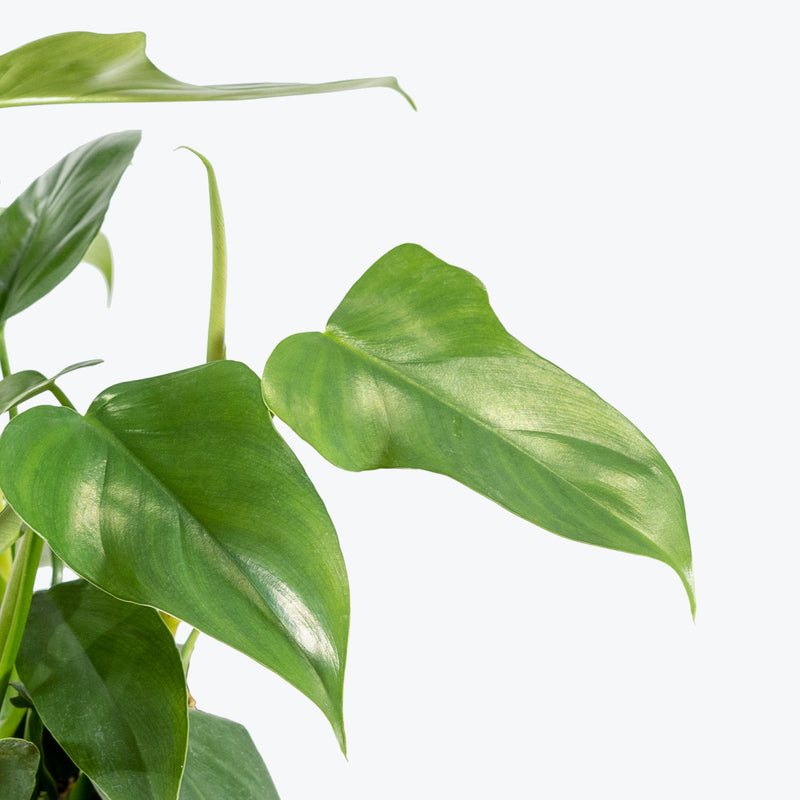
How to care for Philodendron Bipennifolium
They should not be in a position to see the sun directly, although early morning or late evening sun is fine. Filtered sunlight through a sheer curtain is best and most homes are comprised primarily of indirect sunlight. The best spot for them is where they do not see the sun during the majority of the day but still get bright, indirect light.
They will do well in medium light but will grow faster with brighter light. A good medium-light place in your home would be in the middle of a room that has a regular size window. Remember that plants will grow based on how much light they receive.
They need to be watered when the top half of the soil is dry to the touch. That usually takes about 1 week in an average home environment. It will vary depending on the time of year, your environment and lighting conditions, but it's always safer to underwater or give the soil a check before you water again. Expect to water more often in brighter light and less often in lower light.
They will do well in average humidity environments but will appreciate a little bit of humidity if provided, give them a mist daily or get a humidifier.
Allow the soil to mostly dry out between watering during the winter seasons. This tropical houseplant loves warm temperatures and has no cold hardiness. As the plant grows, it will most likely need a bamboo stake or moss pole to grow up, as it loves to grow up a stable structure.
This plant is moderately toxic and can cause some adverse reactions when ingested so it is best to not let your pets eat it, which we advise for all plants in general. The severity of the reaction will depend on how much of the plant is ingested but, if you know your pet typically does not eat your plants, this plant will be suitable for your home..
Learn MoreView PlantPhilodendron Birkin
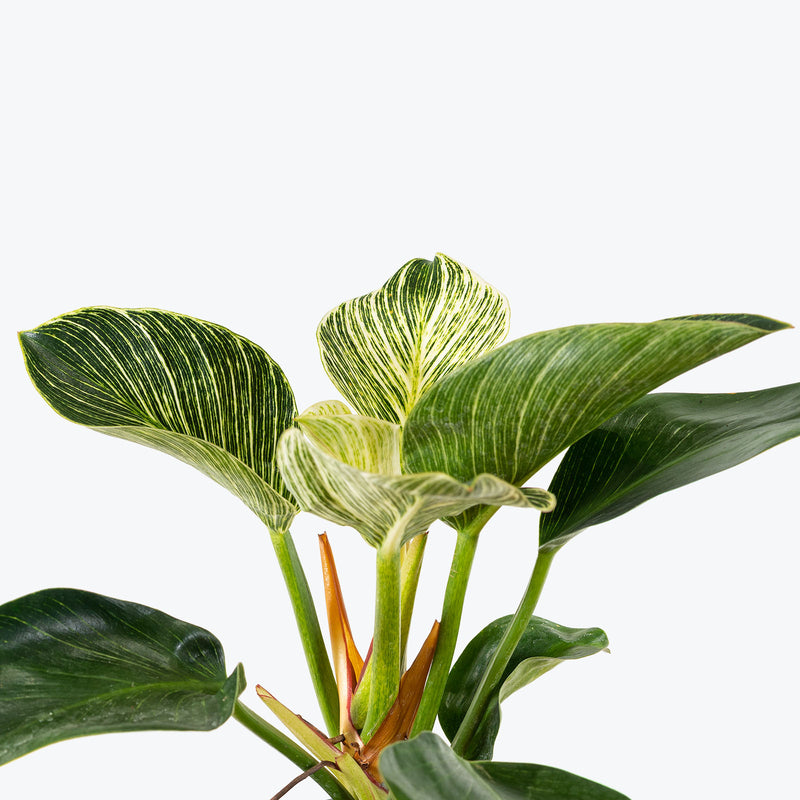
How to care for Philodendron Birkin
They should not be in a position to see the sun directly, although early morning or late evening sun is fine. Filtered sunlight through a sheer curtain is best and most homes are comprised primarily of indirect sunlight. The best spot for them is where they do not see the sun during the majority of the day but still get bright, indirect light.
They will do well in medium light but will grow faster with brighter light. A good medium-light place in your home would be in the middle of a room that has a regular size window. Remember that plants will grow based on how much light they receive.
They like the soil to be relatively dry before the next watering. That usually takes about 2 weeks in an average home environment. It will vary depending on the time of year, your environment and lighting conditions, but for them, it's always safer to underwater or water when you see signs of lack of water (i.e. droopy, floppy, or soft leaves). Expect to water more often in brighter light and less often in lower light.
They will do well in average humidity environments but will appreciate a little bit of humidity if provided, give them a mist daily or get a humidifier.
They need clean leaves to photosynthesize in order to feed themselves, so regularly wipe your plants leaves with a damp soft cloth or give it a full shower every now and again to remove any dust. They enjoy a warmer environment and brighter light will increase their variegation!
This plant is moderately toxic and can cause some adverse reactions when ingested so it is best to not let your pets eat it, which we advise for all plants in general. The severity of the reaction will depend on how much of the plant is ingested but, if you know your pet typically does not eat your plants, this plant will be suitable for your home..
Learn MoreView PlantPhilodendron Black Cardinal
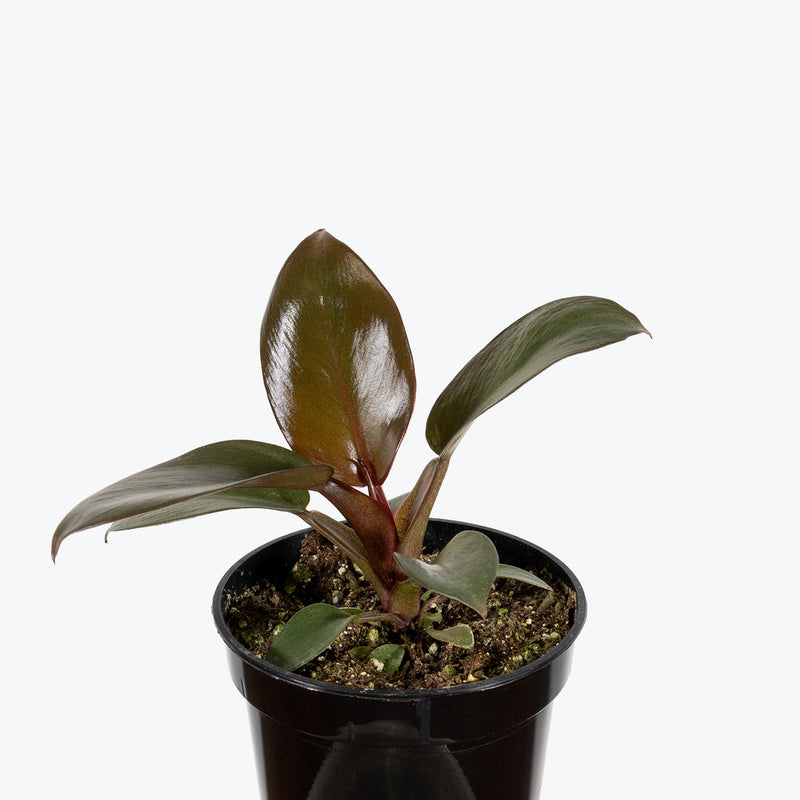
How to care for Philodendron Black Cardinal
They should not be in a position to see the sun directly, although early morning or late evening sun is fine. Filtered sunlight through a sheer curtain is best and most homes are comprised primarily of indirect sunlight. The best spot for them is where they do not see the sun during the majority of the day but still get bright, indirect light.
They will do well in medium light but will grow faster with brighter light. A good medium-light place in your home would be in the middle of a room that has a regular size window. Remember that plants will grow based on how much light they receive.
They need to be watered when the top half of the soil is dry to the touch. That usually takes about 1 week in an average home environment. It will vary depending on the time of year, your environment and lighting conditions, but it's always safer to underwater or give the soil a check before you water again. Expect to water more often in brighter light and less often in lower light.
They can live in any average home humidity condition and are fairly hardy.
Since it is a self-heading Philodendron, it will not need to be trimmed back to maintain its size (unless you want to propagate it of course) and shouldn’t grow larger than 3 ft. tall. If you want the colours of this plant to really come through, exposing it to morning and late afternoon sun will bring forth the deep burgundy colour.
This plant is moderately toxic and can cause some adverse reactions when ingested so it is best to not let your pets eat it, which we advise for all plants in general. The severity of the reaction will depend on how much of the plant is ingested but, if you know your pet typically does not eat your plants, this plant will be suitable for your home..
Learn MoreView PlantPhilodendron Bob Cee
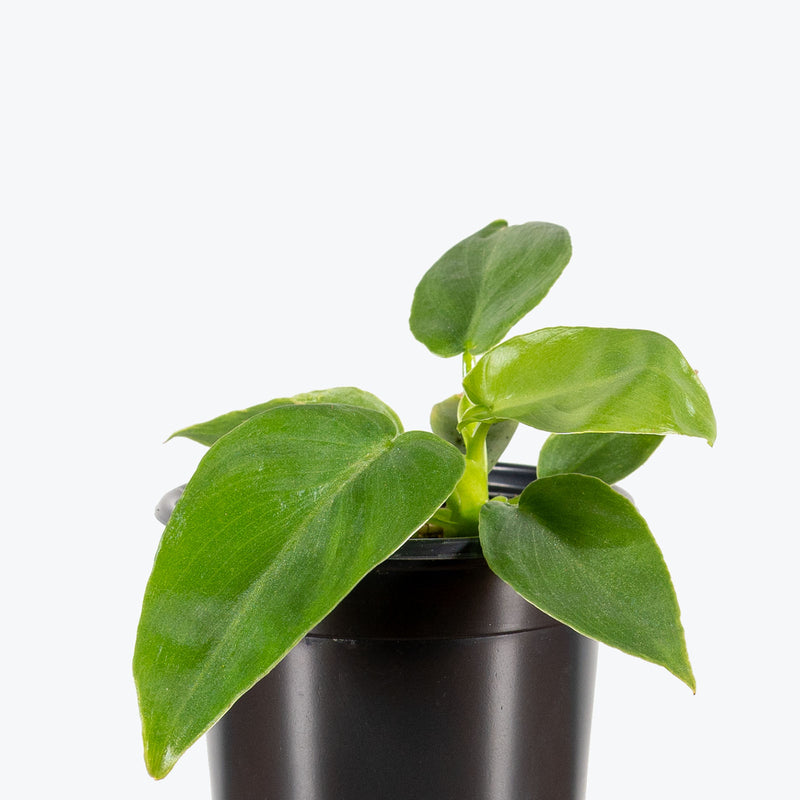
How to care for Philodendron Bob Cee
Philodendron Bob Cee should not be in a position to see the sun directly, although early morning or late evening sun is fine. Filtered sunlight through a sheer curtain is best and most homes are comprised primarily of indirect sunlight. The best spot for them is where they do not see the sun during the majority of the day but still get bright, indirect light.
Philodendron Bob Cee will do best in bright light. A nice bright place inside your home would be on the window sill or a stool that is right next to a window, either with or without blinds, depending on if the plant can handle sun. Remember that plants will grow based on how much light they receive.
Philodendron Bob Cee needs to be watered when the top half of the soil is dry to the touch. That usually takes about 1 week in an average home environment. It will vary depending on the time of year, your environment and lighting conditions, but it's always safer to underwater or give the soil a check before you water again. Expect to water more often in brighter light and less often in lower light.
Philodendron Bob Cee will do well in average humidity environments but will appreciate a little bit of humidity if provided, give them a mist daily or get a humidifier.
Don't be alarmed if you notice variations in Philodendron Bob Cee leaf size. Smaller leaves are typically new growth, while older, more established leaves are larger. Regular misting is beneficial but avoid allowing water to sit on the leaves for extended periods to prevent fungal or bacterial issues.
Philodendron Bob Cee plant is moderately toxic and can cause some adverse reactions when ingested so it is best to not let your pets eat it, which we advise for all plants in general. The severity of the reaction will depend on how much of the plant is ingested but, if you know your pet typically does not eat your plants, this plant will be suitable for your home..
Learn MoreView PlantPhilodendron Bob Cee Variegata
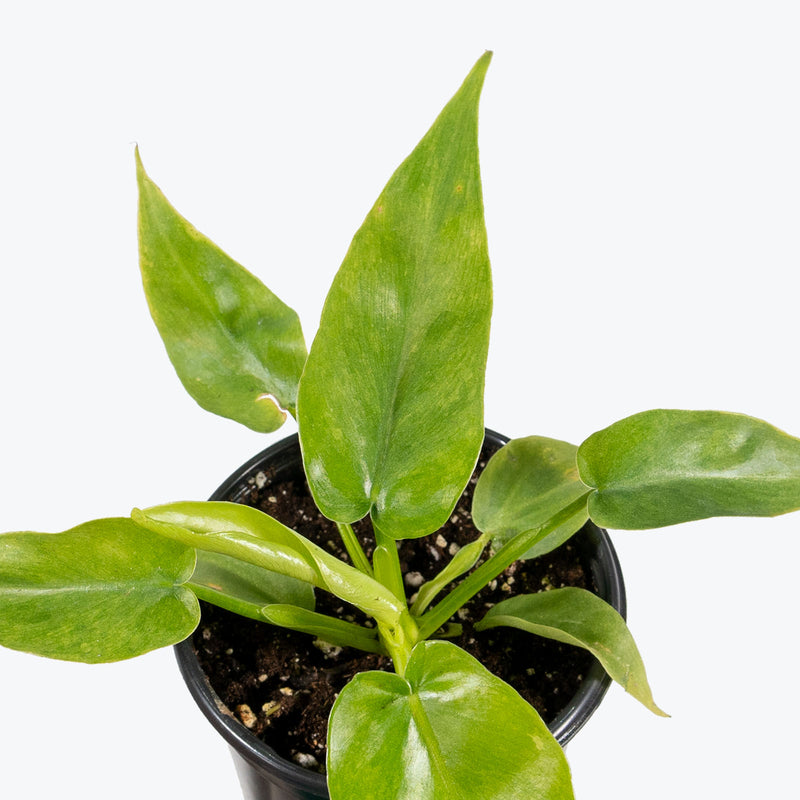
How to care for Philodendron Bob Cee Variegata
Philodendron Bob Cee Variegata should not be in a position to see the sun directly, although early morning or late evening sun is fine. Filtered sunlight through a sheer curtain is best and most homes are comprised primarily of indirect sunlight. The best spot for them is where they do not see the sun during the majority of the day but still get bright, indirect light.
Philodendron Bob Cee Variegata will do best in bright light. A nice bright place inside your home would be on the window sill or a stool that is right next to a window, either with or without blinds, depending on if the plant can handle sun. Remember that plants will grow based on how much light they receive.
Philodendron Bob Cee Variegata needs to be watered when the top half of the soil is dry to the touch. That usually takes about 1 week in an average home environment. It will vary depending on the time of year, your environment and lighting conditions, but it's always safer to underwater or give the soil a check before you water again. Expect to water more often in brighter light and less often in lower light.
Philodendron Bob Cee Variegata will do well in average humidity environments but will appreciate a little bit of humidity if provided, give them a mist daily or get a humidifier.
Don't be alarmed if you notice variations in Philodendron Bob Cee Variegata leaf size. Smaller leaves are typically new growth, while older, more established leaves are larger. Regular misting is beneficial but avoid allowing water to sit on the leaves for extended periods to prevent fungal or bacterial issues. Support the plant with a moss pole or trellis to encourage vertical growth and larger leaves. Regularly clean the leaves with a soft, damp cloth to remove dust and check for pests such as spider mites and mealybugs.
Philodendron Bob Cee Variegata plant is moderately toxic and can cause some adverse reactions when ingested so it is best to not let your pets eat it, which we advise for all plants in general. The severity of the reaction will depend on how much of the plant is ingested but, if you know your pet typically does not eat your plants, this plant will be suitable for your home..
Learn MoreView PlantPhilodendron Brandtianum
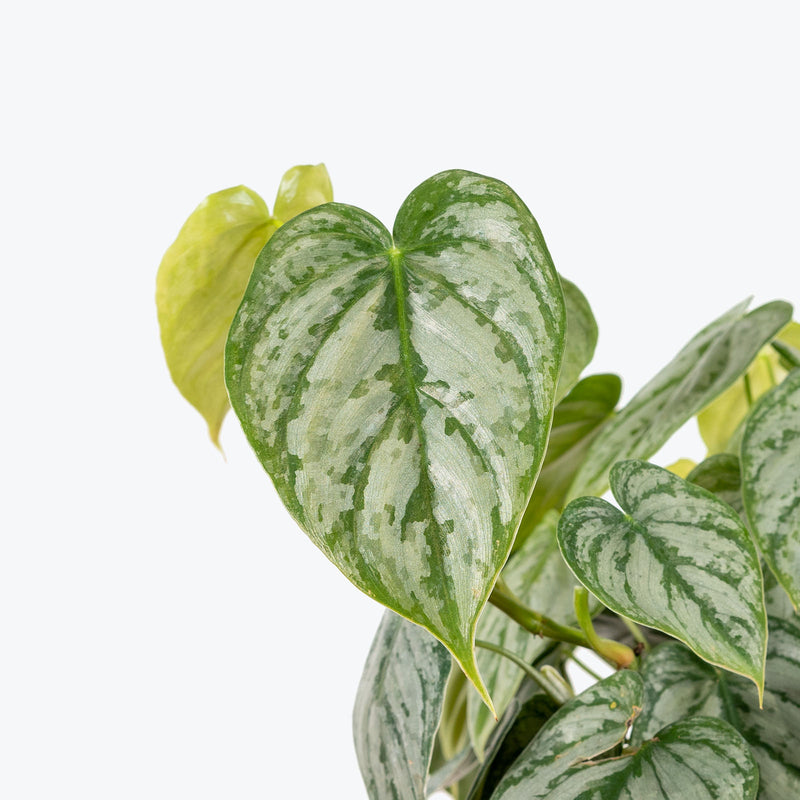
How to care for Philodendron Brandtianum
They should not be in a position to see the sun directly, although early morning or late evening sun is fine. Filtered sunlight through a sheer curtain is best and most homes are comprised primarily of indirect sunlight. The best spot for them is where they do not see the sun during the majority of the day but still get bright, indirect light.
They will do well in medium light but will grow faster with brighter light. A good medium-light place in your home would be in the middle of a room that has a regular size window. Remember that plants will grow based on how much light they receive.
Allow the top quarter of the soil to dry before watering again. This usually takes about 3 - 4 days in an average home environment. It will vary depending on the time of year, your environment and lighting conditions. Expect to water more often in brighter light and less often in lower light.
They will do well in average humidity environments but will appreciate a little bit of humidity if provided, give them a mist daily or get a humidifier.
Philodendron Brandtianum plant has a compact growth habit and will develop leaves close to each other while trailing or climbing. You can prune the plant once or twice in the year, and remove dead and damaged leaves from the lower part as needed.
This plant is moderately toxic and can cause some adverse reactions when ingested so it is best to not let your pets eat it, which we advise for all plants in general. The severity of the reaction will depend on how much of the plant is ingested but, if you know your pet typically does not eat your plants, this plant will be suitable for your home..
Learn MoreView PlantPhilodendron Burgundy Princess
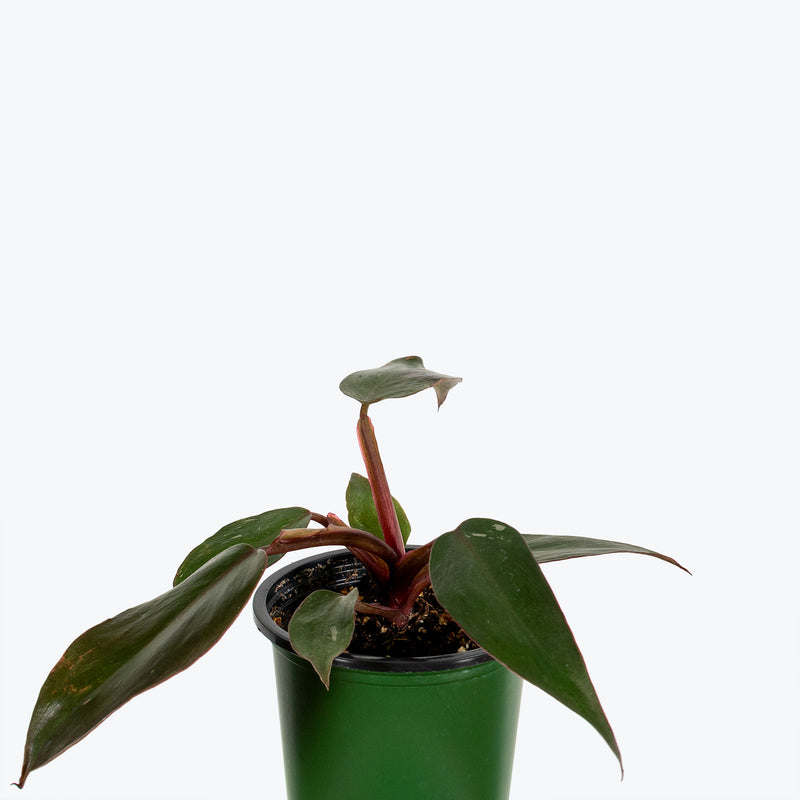
How to care for Philodendron Burgundy Princess
They should not be in a position to see the sun directly, although early morning or late evening sun is fine. Filtered sunlight through a sheer curtain is best and most homes are comprised primarily of indirect sunlight. The best spot for them is where they do not see the sun during the majority of the day but still get bright, indirect light.
They will thrive in bright light, but also can tolerate medium light. A good medium-light place in your home would be in the middle of a room that has a regular size window. They can be placed anywhere between the middle of the room and the window. Remember that plants will grow based on how much light they receive.
They like the soil to be relatively dry before the next watering. That usually takes about 2 weeks in an average home environment. It will vary depending on the time of year, your environment and lighting conditions, but for them, it's always safer to underwater or water when you see signs of lack of water (i.e. droopy, floppy, or soft leaves). Expect to water more often in brighter light and less often in lower light.
They like a high humidity environment, give them a mist daily or as often as possible. Alternatively, you can put them around a humidifier. Although they won't die if they don't receive enough humidity, their leaves may have some dry, crunchy, or yellow edges.
The Philodendron Pink Princess can survive in low light conditions, but grows faster and produces more variegation in its leaves in medium or bright indirect light. If the leaves are pale in colour, the plant may be getting too much light. Do not put it in direct sunlight as the sun will burn the foliage.
This plant is moderately toxic and can cause some adverse reactions when ingested so it is best to not let your pets eat it, which we advise for all plants in general. The severity of the reaction will depend on how much of the plant is ingested but, if you know your pet typically does not eat your plants, this plant will be suitable for your home..
Learn MoreView PlantPhilodendron Burle Marx
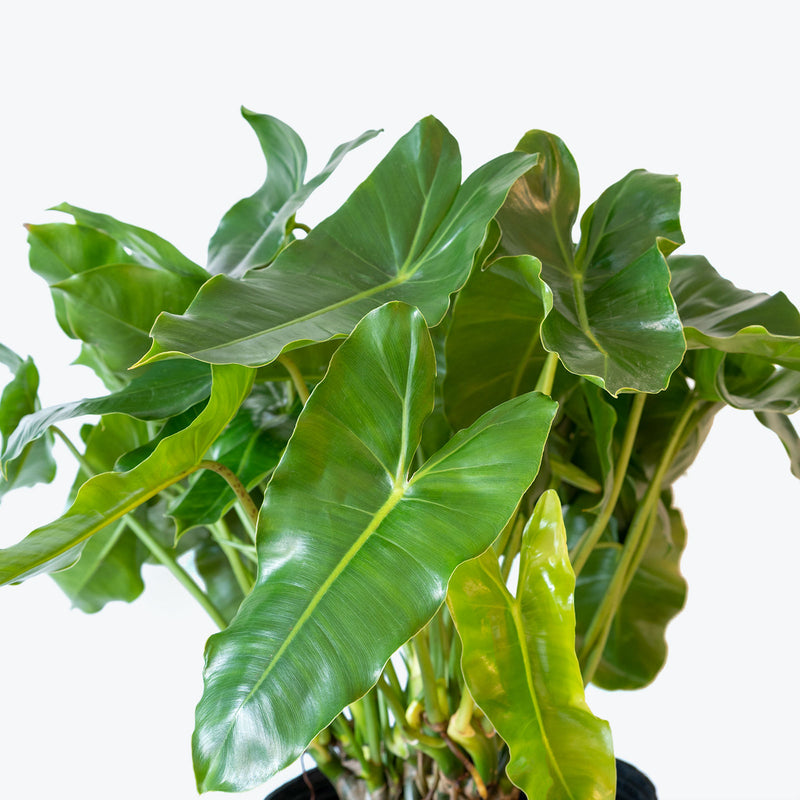
How to care for Philodendron Burle Marx
They should not be in a position to see the sun directly, although early morning or late evening sun is fine. Filtered sunlight through a sheer curtain is best and most homes are comprised primarily of indirect sunlight. The best spot for them is where they do not see the sun during the majority of the day but still get bright, indirect light.
They will do well in medium light but will grow faster with brighter light. A good medium-light place in your home would be in the middle of a room that has a regular size window. Remember that plants will grow based on how much light they receive.
They need to be watered when the top half of the soil is dry to the touch. That usually takes about 1 week in an average home environment. It will vary depending on the time of year, your environment and lighting conditions, but it's always safer to underwater or give the soil a check before you water again. Expect to water more often in brighter light and less often in lower light.
They will do well in average humidity environments but will appreciate a little bit of humidity if provided, give them a mist daily or get a humidifier.
Allow the soil to mostly dry out between watering during the winter seasons.
This plant is moderately toxic and can cause some adverse reactions when ingested so it is best to not let your pets eat it, which we advise for all plants in general. The severity of the reaction will depend on how much of the plant is ingested but, if you know your pet typically does not eat your plants, this plant will be suitable for your home..
Learn MoreView PlantPhilodendron Burle Marx Variegata
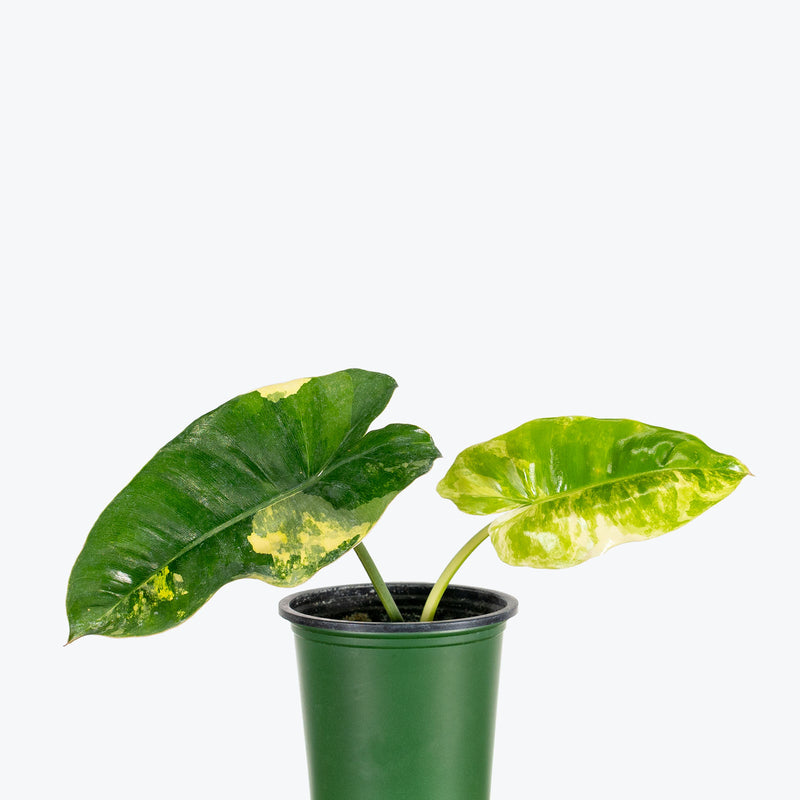
How to care for Philodendron Burle Marx Variegata
They should not be in a position to see the sun directly, although early morning or late evening sun is fine. Filtered sunlight through a sheer curtain is best and most homes are comprised primarily of indirect sunlight. The best spot for them is where they do not see the sun during the majority of the day but still get bright, indirect light.
They will do well in medium light but will grow faster with brighter light. A good medium-light place in your home would be in the middle of a room that has a regular size window. Remember that plants will grow based on how much light they receive.
They need to be watered when the top half of the soil is dry to the touch. That usually takes about 1 week in an average home environment. It will vary depending on the time of year, your environment and lighting conditions, but it's always safer to underwater or give the soil a check before you water again. Expect to water more often in brighter light and less often in lower light.
They will do well in average humidity environments but will appreciate a little bit of humidity if provided, give them a mist daily or get a humidifier.
Allow the soil to mostly dry out between watering during the winter seasons. Since this variety is variegated, it will need brighter light to support this variegation, just make sure to keep it our of excessive amounts of direct sunlight (some morning sun would be just fine).
This plant is moderately toxic and can cause some adverse reactions when ingested so it is best to not let your pets eat it, which we advise for all plants in general. The severity of the reaction will depend on how much of the plant is ingested but, if you know your pet typically does not eat your plants, this plant will be suitable for your home..
Learn MoreView PlantPhilodendron Calkins Gold

How to care for Philodendron Calkins Gold
They should not be in a position to see the sun directly, although early morning or late evening sun is fine. Filtered sunlight through a sheer curtain is best and most homes are comprised primarily of indirect sunlight. The best spot for them is where they do not see the sun during the majority of the day but still get bright, indirect light.
They will thrive in bright light, but also can tolerate medium light. A good medium-light place in your home would be in the middle of a room that has a regular size window. They can be placed anywhere between the middle of the room and the window. Remember that plants will grow based on how much light they receive.
They like the soil to be relatively dry before the next watering. That usually takes about 2 weeks in an average home environment. It will vary depending on the time of year, your environment and lighting conditions, but for them, it's always safer to underwater or water when you see signs of lack of water (i.e. droopy, floppy, or soft leaves). Expect to water more often in brighter light and less often in lower light.
They will do well in average humidity environments but will appreciate a little bit of humidity if provided, give them a mist daily or get a humidifier.
It truly enjoys indirect light as direct light will most likely burn the leaves on the plant. The leaves are large and flat so it would be best to dust them once in a while to aid in photosynthesis.
This plant is moderately toxic and can cause some adverse reactions when ingested so it is best to not let your pets eat it, which we advise for all plants in general. The severity of the reaction will depend on how much of the plant is ingested but, if you know your pet typically does not eat your plants, this plant will be suitable for your home..
Learn MoreView PlantPhilodendron Caramel Cardinal
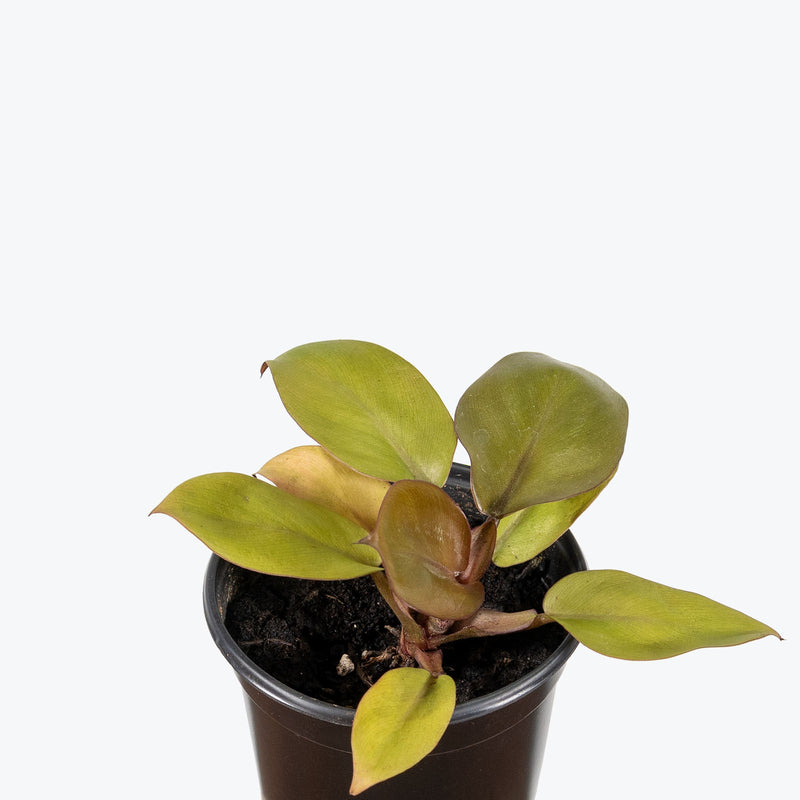
How to care for Philodendron Caramel Cardinal
They should not be in a position to see the sun directly, although early morning or late evening sun is fine. Filtered sunlight through a sheer curtain is best and most homes are comprised primarily of indirect sunlight. The best spot for them is where they do not see the sun during the majority of the day but still get bright, indirect light.
They will do best in bright light. A nice bright place inside your home would be on the window sill or a stool that is right next to a window, either with or without blinds, depending on if the plant can handle sun. Remember that plants will grow based on how much light they receive.
They need to be watered when the top half of the soil is dry to the touch. That usually takes about 1 week in an average home environment. It will vary depending on the time of year, your environment and lighting conditions, but it's always safer to underwater or give the soil a check before you water again. Expect to water more often in brighter light and less often in lower light.
They will do well in average humidity environments but will appreciate a little bit of humidity if provided, give them a mist daily or get a humidifier.
Since it is a self-heading Philodendron, it will not need to be trimmed back to maintain its size (unless you want to propagate it of course) and shouldn’t grow larger than 3 ft. tall. If you want the colours of this plant to really come through, exposing it to morning and late afternoon sun will bring forth the caramel colour.
This plant is moderately toxic and can cause some adverse reactions when ingested so it is best to not let your pets eat it, which we advise for all plants in general. The severity of the reaction will depend on how much of the plant is ingested but, if you know your pet typically does not eat your plants, this plant will be suitable for your home..
Learn MoreView PlantPhilodendron Caramel Marble
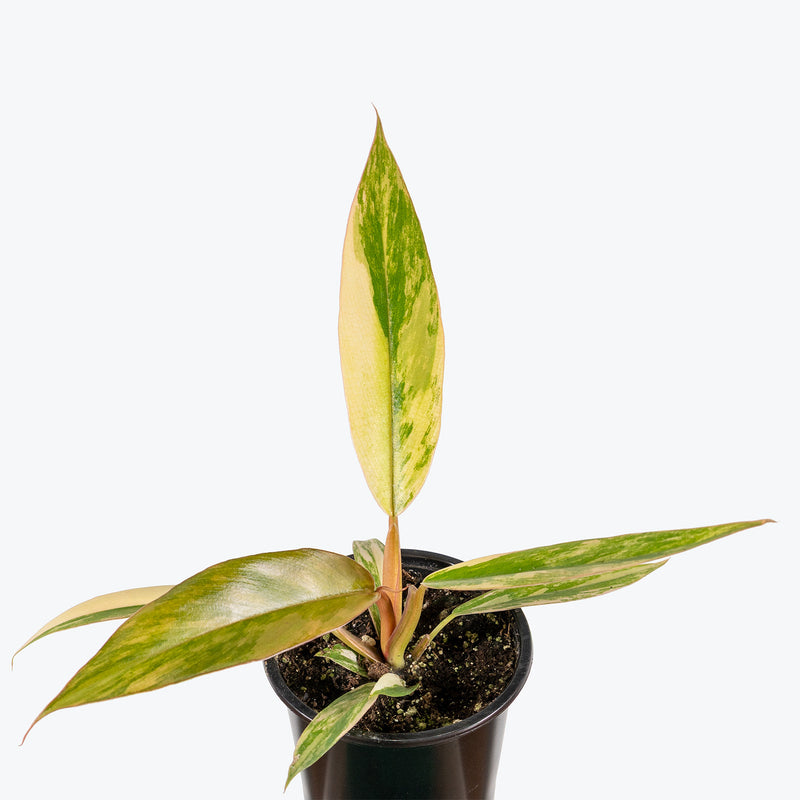
How to care for Philodendron Caramel Marble
Philodendron Caramel Marble should not be in a position to see the sun directly, although early morning or late evening sun is fine. Filtered sunlight through a sheer curtain is best and most homes are comprised primarily of indirect sunlight. The best spot for them is where they do not see the sun during the majority of the day but still get bright, indirect light.
Philodendron Caramel Marble will thrive in bright light, but also can tolerate medium light. A good medium-light place in your home would be in the middle of a room that has a regular size window. They can be placed anywhere between the middle of the room and the window. Remember that plants will grow based on how much light they receive.
Philodendron Caramel Marble needs to be watered when the top half of the soil is dry to the touch. That usually takes about 1 week in an average home environment. It will vary depending on the time of year, your environment and lighting conditions, but it's always safer to underwater or give the soil a check before you water again. Expect to water more often in brighter light and less often in lower light.
Philodendron Caramel Marble will do well in average humidity environments but will appreciate a little bit of humidity if provided, give them a mist daily or get a humidifier.
Grow in a well-draining aroid mix with orchid bark, perlite, and sphagnum for strong roots. Fertilize monthly during the growing season with a balanced, diluted fertilizer to encourage lush growth and colour intensity. Since variegation can be unstable, rotate Philodendron Caramel Marble regularly to ensure even light distribution and more balanced leaf coloration.
Philodendron Caramel Marble is moderately toxic and can cause some adverse reactions when ingested so it is best to not let your pets eat it, which we advise for all plants in general. The severity of the reaction will depend on how much of the plant is ingested but, if you know your pet typically does not eat your plants, this plant will be suitable for your home..
Learn MoreView PlantPhilodendron Caramel Pluto
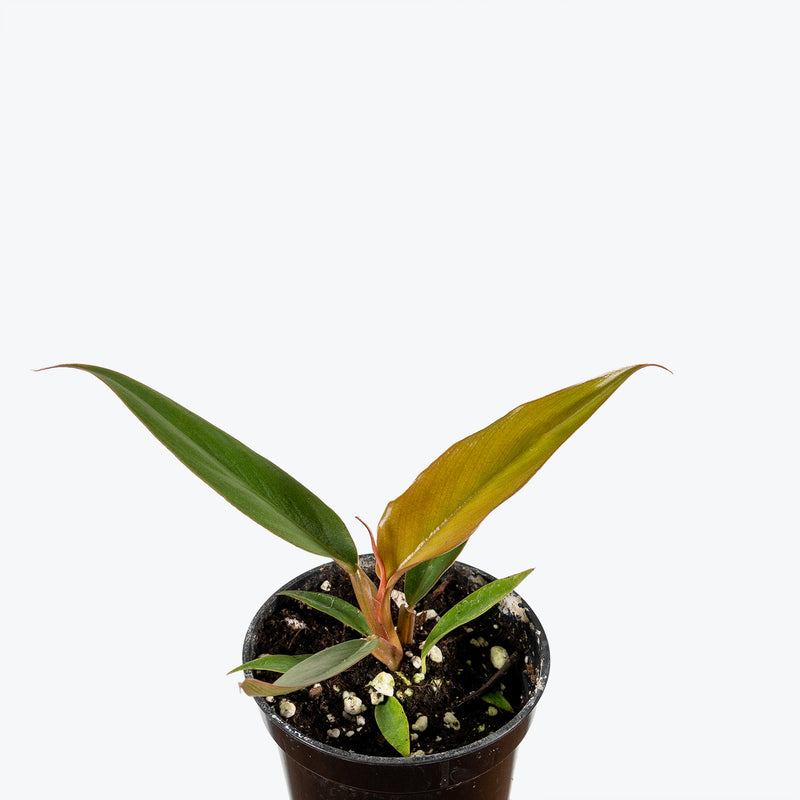
How to care for Philodendron Caramel Pluto
They should not be in a position to see the sun directly, although early morning or late evening sun is fine. Filtered sunlight through a sheer curtain is best and most homes are comprised primarily of indirect sunlight. The best spot for them is where they do not see the sun during the majority of the day but still get bright, indirect light.
They will do best in bright light. A nice bright place inside your home would be on the window sill or a stool that is right next to a window, either with or without blinds, depending on if the plant can handle sun. Remember that plants will grow based on how much light they receive.
Allow the top quarter of the soil to dry before watering again. This usually takes about 3 - 4 days in an average home environment. It will vary depending on the time of year, your environment and lighting conditions. Expect to water more often in brighter light and less often in lower light.
They will do well in average humidity environments but will appreciate a little bit of humidity if provided, give them a mist daily or get a humidifier.
Philodendron Caramel Pluto benefits from well-draining soil to avoid waterlogged conditions. Feed it with a balanced, water-soluble fertilizer every 4-6 weeks during the growing season (spring and summer) to promote healthy growth.
This plant is moderately toxic and can cause some adverse reactions when ingested so it is best to not let your pets eat it, which we advise for all plants in general. The severity of the reaction will depend on how much of the plant is ingested but, if you know your pet typically does not eat your plants, this plant will be suitable for your home..
Learn MoreView PlantPhilodendron Choco Empress

How to care for Philodendron Choco Empress
Philodendron Choco Empress should not be in a position to see the sun directly, although early morning or late evening sun is fine. Filtered sunlight through a sheer curtain is best and most homes are comprised primarily of indirect sunlight. The best spot for them is where they do not see the sun during the majority of the day but still get bright, indirect light.
Philodendron Choco Empress will thrive in bright light, but also can tolerate medium light. A good medium-light place in your home would be in the middle of a room that has a regular size window. They can be placed anywhere between the middle of the room and the window. Remember that plants will grow based on how much light they receive.
Philodendron Choco Empress likes the soil to be relatively dry before the next watering. That usually takes about 2 weeks in an average home environment. It will vary depending on the time of year, your environment and lighting conditions, but for them, it's always safer to underwater or water when you see signs of lack of water (i.e. droopy, floppy, or soft leaves). Expect to water more often in brighter light and less often in lower light.
Philodendron Choco Empress will do well in average humidity environments but will appreciate a little bit of humidity if provided, give them a mist daily or get a humidifier.
To preserve the chocolate hues in new growth, keep Philodendron Choco Empress in bright, indirect light. Use a well-draining, airy mix — orchid bark, perlite, and peat are a great combo. Feed monthly in the growing season with a balanced fertilizer to support leaf size and colour. Gently wipe dust off mature leaves to keep them glossy. Provide support if needed, as the upright habit may lean slightly as it matures.
Philodendron Choco Empress is moderately toxic and can cause some adverse reactions when ingested so it is best to not let your pets eat it, which we advise for all plants in general. The severity of the reaction will depend on how much of the plant is ingested but, if you know your pet typically does not eat your plants, this plant will be suitable for your home..
Learn MoreView PlantPhilodendron Congo Green
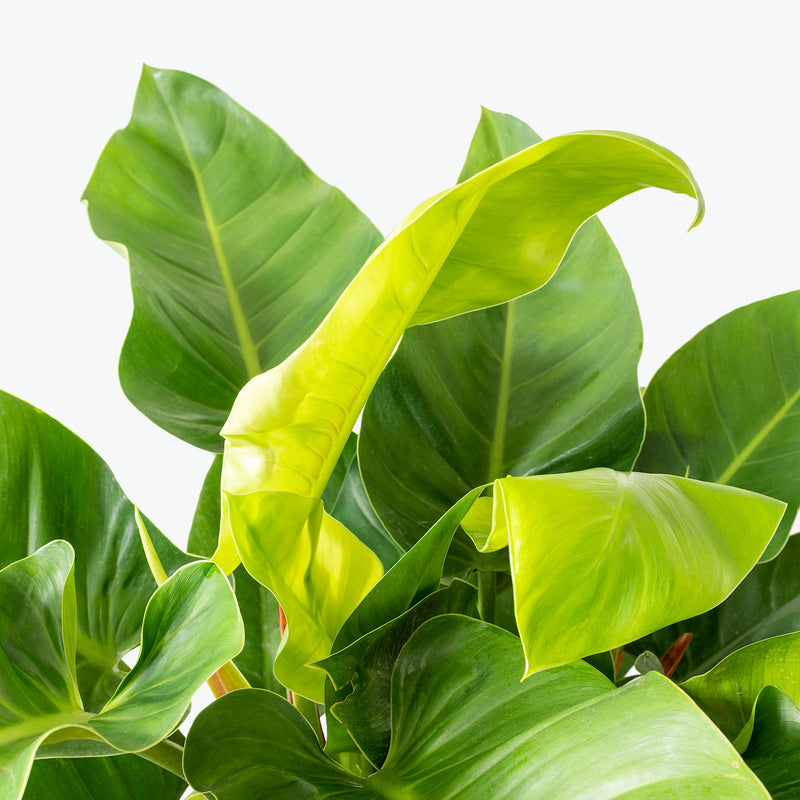
How to care for Philodendron Congo Green
They should not be in a position to see the sun directly, although early morning or late evening sun is fine. Filtered sunlight through a sheer curtain is best and most homes are comprised primarily of indirect sunlight. The best spot for them is where they do not see the sun during the majority of the day but still get bright, indirect light.
They will do well in medium light but will grow faster with brighter light. A good medium-light place in your home would be in the middle of a room that has a regular size window. Remember that plants will grow based on how much light they receive.
They need to be watered when the top half of the soil is dry to the touch. That usually takes about 1 week in an average home environment. It will vary depending on the time of year, your environment and lighting conditions, but it's always safer to underwater or give the soil a check before you water again. Expect to water more often in brighter light and less often in lower light.
They will do well in average humidity environments but will appreciate a little bit of humidity if provided, give them a mist daily or get a humidifier.
This Philodendron is very easy, perfect for beginners! Rotate your plant every week or so to encourage even, consistent, and healthy growth. Allow the soil to dry out more between waterings during the winter seasons.
This plant is moderately toxic and can cause some adverse reactions when ingested so it is best to not let your pets eat it, which we advise for all plants in general. The severity of the reaction will depend on how much of the plant is ingested but, if you know your pet typically does not eat your plants, this plant will be suitable for your home..
Learn MoreView PlantPhilodendron Cream Splash

How to care for Philodendron Cream Splash
Philodendron Cream Splash should not be in a position to see the sun directly, although early morning or late evening sun is fine. Filtered sunlight through a sheer curtain is best and most homes are comprised primarily of indirect sunlight. The best spot for them is where they do not see the sun during the majority of the day but still get bright, indirect light.
Philodendron Cream Splash will thrive in bright light, but also can tolerate medium light. A good medium-light place in your home would be in the middle of a room that has a regular size window. They can be placed anywhere between the middle of the room and the window. Remember that plants will grow based on how much light they receive.
Philodendron Cream Splash needs to be watered when the top half of the soil is dry to the touch. That usually takes about 1 week in an average home environment. It will vary depending on the time of year, your environment and lighting conditions, but it's always safer to underwater or give the soil a check before you water again. Expect to water more often in brighter light and less often in lower light.
Philodendron Cream Splash can live in any average home humidity condition and are fairly hardy.
To keep the cream variegation crisp and vivid, place your Philodendron Cream Splash in bright, indirect light — lower light may cause the variegation to fade. Avoid sudden temperature shifts, as this can affect leaf development. Use a well-draining soil mix and consider a hanging pot or elevated shelf to let its vines trail freely. Trim leggy growth to encourage a bushier shape, and propagate cuttings in water or soil to share this unique plant with friends. Each new leaf is a surprise, making this one a favourite among collectors.
Philodendron Cream Splash is moderately toxic and can cause some adverse reactions when ingested so it is best to not let your pets eat it, which we advise for all plants in general. The severity of the reaction will depend on how much of the plant is ingested but, if you know your pet typically does not eat your plants, this plant will be suitable for your home..
Learn MoreView PlantPhilodendron Domesticum
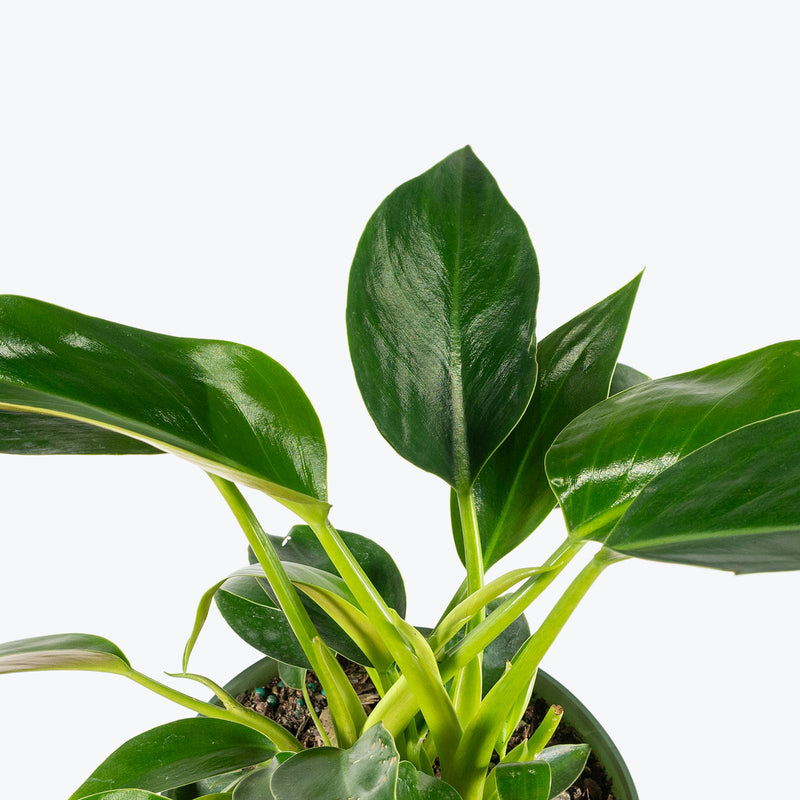
How to care for Philodendron Domesticum
Philodendron Domesticum should not be in a position to see the sun directly, although early morning or late evening sun is fine. Filtered sunlight through a sheer curtain is best and most homes are comprised primarily of indirect sunlight. The best spot for them is where they do not see the sun during the majority of the day but still get bright, indirect light.
Philodendron Domesticum will thrive in bright light, but also can tolerate medium light. A good medium-light place in your home would be in the middle of a room that has a regular size window. They can be placed anywhere between the middle of the room and the window. Remember that plants will grow based on how much light they receive.
Philodendron Domesticum needs to be watered when the top half of the soil is dry to the touch. That usually takes about 1 week in an average home environment. It will vary depending on the time of year, your environment and lighting conditions, but it's always safer to underwater or give the soil a check before you water again. Expect to water more often in brighter light and less often in lower light.
Philodendron Domesticum will do well in average humidity environments but will appreciate a little bit of humidity if provided, give them a mist daily or get a humidifier.
Fertilize your Philodendron domesticum every 4-6 weeks during the growing season with a balanced, water-soluble fertilizer. During the winter months, reduce fertilization. Dust the leaves regularly to allow the plant to photosynthesize efficiently and wipe them with a damp cloth to keep pests at bay.
Philodendron Domesticum is moderately toxic and can cause some adverse reactions when ingested so it is best to not let your pets eat it, which we advise for all plants in general. The severity of the reaction will depend on how much of the plant is ingested but, if you know your pet typically does not eat your plants, this plant will be suitable for your home..
Learn MoreView PlantPhilodendron El Choco Red

How to care for Philodendron El Choco Red
Philodendron El Choco Red should not be in a position to see the sun directly, although early morning or late evening sun is fine. Filtered sunlight through a sheer curtain is best and most homes are comprised primarily of indirect sunlight. The best spot for them is where they do not see the sun during the majority of the day but still get bright, indirect light.
Philodendron El Choco Red will thrive in bright light, but also can tolerate medium light. A good medium-light place in your home would be in the middle of a room that has a regular size window. They can be placed anywhere between the middle of the room and the window. Remember that plants will grow based on how much light they receive.
Allow the top quarter of the soil to dry before watering again. This usually takes about 3 - 4 days in an average home environment. It will vary depending on the time of year, your environment and lighting conditions. Expect to water more often in brighter light and less often in lower light.
Philodendron El Choco Red likes a high humidity environment, give them a mist daily or as often as possible. Alternatively, you can put them around a humidifier. Although they won't die if they don't receive enough humidity, their leaves may have some dry, crunchy, or yellow edges.
Feed your Philodendron El Choco Red with a balanced, water-soluble fertilizer every 4-6 weeks during the growing season (spring and summer). Reduce fertilization in the fall and winter months. Support the plant with a moss pole or similar structure to mimic its natural epiphytic growth habit and encourage vertical growth. Pruning can be done to manage its size and remove any yellow or damaged leaves.
Philodendron El Choco Red is moderately toxic and can cause some adverse reactions when ingested so it is best to not let your pets eat it, which we advise for all plants in general. The severity of the reaction will depend on how much of the plant is ingested but, if you know your pet typically does not eat your plants, this plant will be suitable for your home..
Learn MoreView PlantPhilodendron Elegans

How to care for Philodendron Elegans
Philodendron Elegans should not be in a position to see the sun directly, although early morning or late evening sun is fine. Filtered sunlight through a sheer curtain is best and most homes are comprised primarily of indirect sunlight. The best spot for them is where they do not see the sun during the majority of the day but still get bright, indirect light.
Philodendron Elegans will do best in bright light. A nice bright place inside your home would be on the window sill or a stool that is right next to a window, either with or without blinds, depending on if the plant can handle sun. Remember that plants will grow based on how much light they receive.
Philodendron Elegans needs to be watered when the top half of the soil is dry to the touch. That usually takes about 1 week in an average home environment. It will vary depending on the time of year, your environment and lighting conditions, but it's always safer to underwater or give the soil a check before you water again. Expect to water more often in brighter light and less often in lower light.
Philodendron Elegans will do well in average humidity environments but will appreciate a little bit of humidity if provided, give them a mist daily or get a humidifier.
Support its climbing habit with a moss pole or trellis to encourage vertical growth and healthy leaf development. Regular pruning can help manage its size and promote a fuller appearance. Fertilize Philodendron Elegans every 4-6 weeks during the growing season with a diluted liquid fertilizer. During the winter months, reduce watering and cease fertilization.
Philodendron Elegans is moderately toxic and can cause some adverse reactions when ingested so it is best to not let your pets eat it, which we advise for all plants in general. The severity of the reaction will depend on how much of the plant is ingested but, if you know your pet typically does not eat your plants, this plant will be suitable for your home..
Learn MoreView PlantPhilodendron Esmeraldense

How to care for Philodendron Esmeraldense
Philodendron Esmeraldense should not be in a position to see the sun directly, although early morning or late evening sun is fine. Filtered sunlight through a sheer curtain is best and most homes are comprised primarily of indirect sunlight. The best spot for them is where they do not see the sun during the majority of the day but still get bright, indirect light.
Philodendron Esmeraldense will do best in bright light. A nice bright place inside your home would be on the window sill or a stool that is right next to a window, either with or without blinds, depending on if the plant can handle sun. Remember that plants will grow based on how much light they receive.
Philodendron Esmeraldense needs to be watered when the top half of the soil is dry to the touch. That usually takes about 1 week in an average home environment. It will vary depending on the time of year, your environment and lighting conditions, but it's always safer to underwater or give the soil a check before you water again. Expect to water more often in brighter light and less often in lower light.
Philodendron Esmeraldense likes a high humidity environment, give them a mist daily or as often as possible. Alternatively, you can put them around a humidifier. Although they won't die if they don't receive enough humidity, their leaves may have some dry, crunchy, or yellow edges.
Fertilize Philodendron Esmeraldense with a balanced liquid fertilizer every month during the growing season (spring and summer), reducing to every other month in fall and winter. Provide a moss pole or trellis for support, as this plant is a natural climber and will benefit from something to attach to as it grows. Regularly clean the leaves with a damp cloth to remove dust and help the plant breathe and photosynthesize more efficiently.
Philodendron Esmeraldense is moderately toxic and can cause some adverse reactions when ingested so it is best to not let your pets eat it, which we advise for all plants in general. The severity of the reaction will depend on how much of the plant is ingested but, if you know your pet typically does not eat your plants, this plant will be suitable for your home..
Learn MoreView PlantPhilodendron Fibraecataphyllum
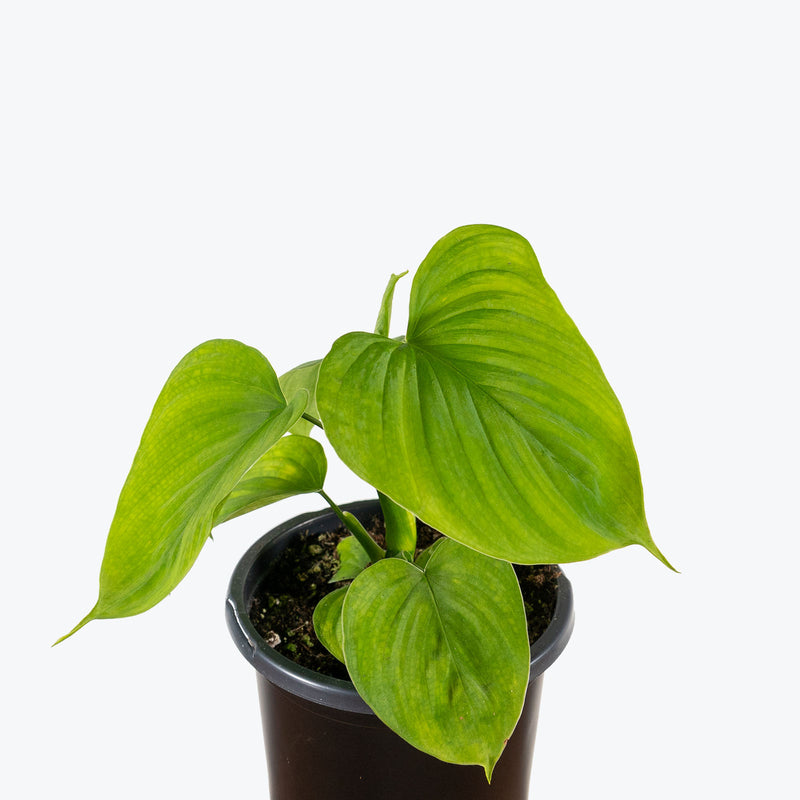
How to care for Philodendron Fibraecataphyllum
Philodendron Fibraecataphyllum should not be in a position to see the sun directly, although early morning or late evening sun is fine. Filtered sunlight through a sheer curtain is best and most homes are comprised primarily of indirect sunlight. The best spot for them is where they do not see the sun during the majority of the day but still get bright, indirect light.
Philodendron Fibraecataphyllum will thrive in bright light, but also can tolerate medium light. A good medium-light place in your home would be in the middle of a room that has a regular size window. They can be placed anywhere between the middle of the room and the window. Remember that plants will grow based on how much light they receive.
Allow the top quarter of the soil to dry before watering Philodendron Fibraecataphyllum again. This usually takes about 3 - 4 days in an average home environment. It will vary depending on the time of year, your environment and lighting conditions. Expect to water more often in brighter light and less often in lower light.
Philodendron Fibraecataphyllum will do well in average humidity environments but will appreciate a little bit of humidity if provided, give them a mist daily or get a humidifier.
Philodendron Fibraecataphyllum prefers a stable environment with consistent temperatures. Avoid placing the plant near radiators, air conditioners, or drafts. Repotting is usually required every couple of years as the plant grows.
Philodendron Fibraecataphyllum is moderately toxic and can cause some adverse reactions when ingested so it is best to not let your pets eat it, which we advise for all plants in general. The severity of the reaction will depend on how much of the plant is ingested but, if you know your pet typically does not eat your plants, this plant will be suitable for your home..
Learn MoreView PlantPhilodendron Florida Beauty
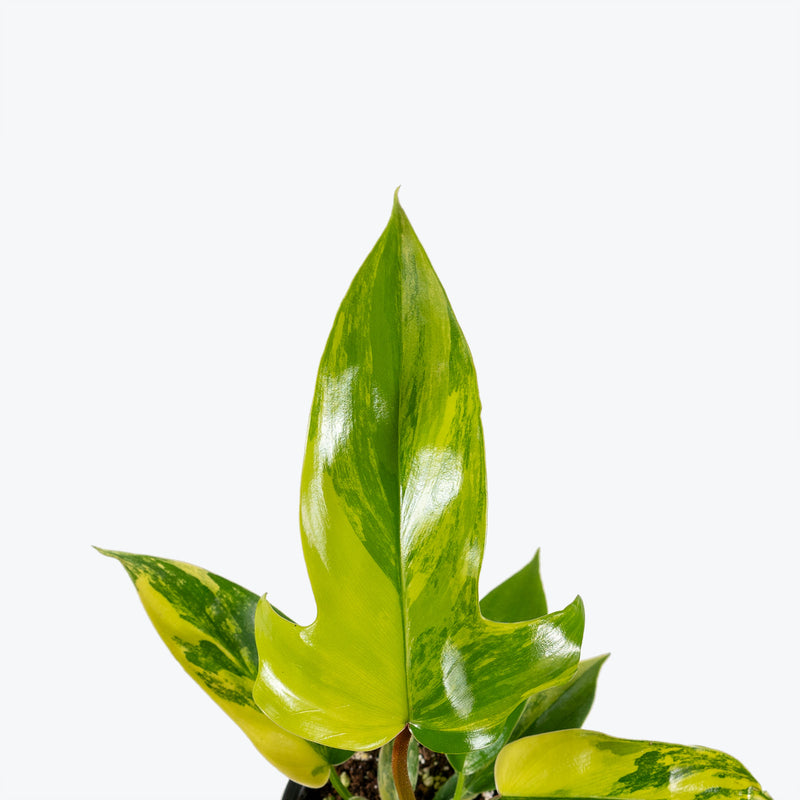
How to care for Philodendron Florida Beauty
Philodendron Florida Beauty should not be in a position to see the sun directly, although early morning or late evening sun is fine. Filtered sunlight through a sheer curtain is best and most homes are comprised primarily of indirect sunlight. The best spot for them is where they do not see the sun during the majority of the day but still get bright, indirect light.
Philodendron Florida Beauty will do best in bright light. A nice bright place inside your home would be on the window sill or a stool that is right next to a window, either with or without blinds, depending on if the plant can handle sun. Remember that plants will grow based on how much light they receive.
Philodendron Florida Beauty needs to be watered when the top half of the soil is dry to the touch. That usually takes about 1 week in an average home environment. It will vary depending on the time of year, your environment and lighting conditions, but it's always safer to underwater or give the soil a check before you water again. Expect to water more often in brighter light and less often in lower light.
Philodendron Florida Beauty will do well in average humidity environments but will appreciate a little bit of humidity if provided, give them a mist daily or get a humidifier.
Philodendron Florida Beauty can be susceptible to pests like spider mites or aphids, especially when the humidity is too low. Regularly check the undersides of leaves and keep the foliage clean by wiping with a damp cloth. Repot the plant every 2-3 years or when it outgrows its current container.
Philodendron Florida Beauty is moderately toxic and can cause some adverse reactions when ingested so it is best to not let your pets eat it, which we advise for all plants in general. The severity of the reaction will depend on how much of the plant is ingested but, if you know your pet typically does not eat your plants, this plant will be suitable for your home..
Learn MoreView PlantPhilodendron Florida Bronze
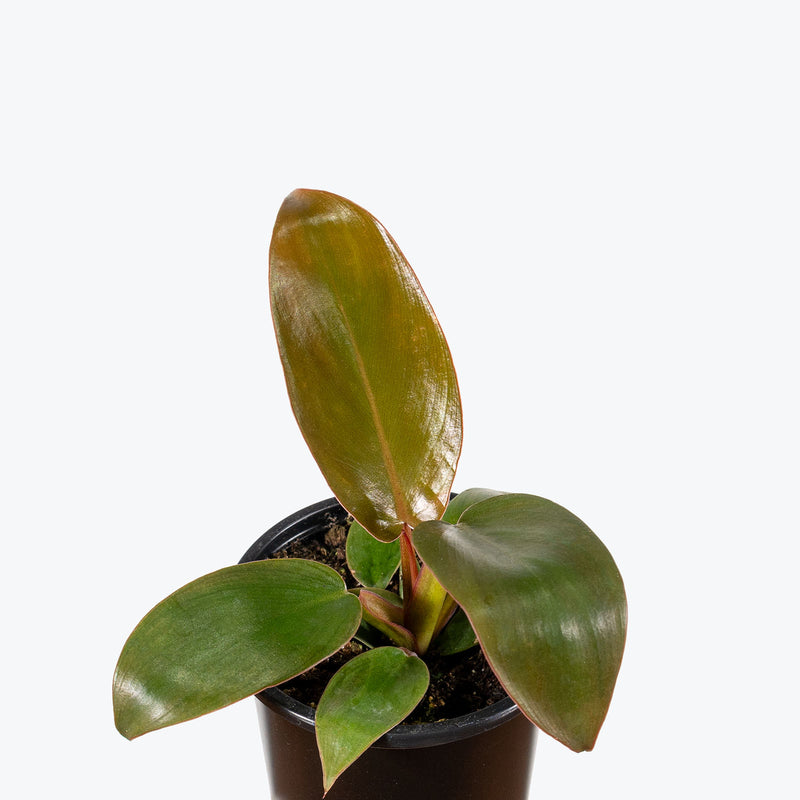
How to care for Philodendron Florida Bronze
Philodendron Florida Bronze should not be in a position to see the sun directly, although early morning or late evening sun is fine. Filtered sunlight through a sheer curtain is best and most homes are comprised primarily of indirect sunlight. The best spot for them is where they do not see the sun during the majority of the day but still get bright, indirect light.
Philodendron Florida Bronze will thrive in bright light, but also can tolerate medium light. A good medium-light place in your home would be in the middle of a room that has a regular size window. They can be placed anywhere between the middle of the room and the window. Remember that plants will grow based on how much light they receive.
Philodendron Florida Bronze needs to be watered when the top half of the soil is dry to the touch. That usually takes about 1 week in an average home environment. It will vary depending on the time of year, your environment and lighting conditions, but it's always safer to underwater or give the soil a check before you water again. Expect to water more often in brighter light and less often in lower light.
Philodendron Florida Bronze will do well in average humidity environments but will appreciate a little bit of humidity if provided, give them a mist daily or get a humidifier.
Philodendron Florida Bronze can be susceptible to pests like spider mites or aphids, especially when the humidity is too low. Repot the plant every 2-3 years or when it outgrows its current container. Provide support for climbing to encourage natural growth habits and healthier foliage. Regularly clean the leaves to remove dust and enhance the plant's ability to photosynthesize effectively.
Philodendron Florida Bronze is moderately toxic and can cause some adverse reactions when ingested so it is best to not let your pets eat it, which we advise for all plants in general. The severity of the reaction will depend on how much of the plant is ingested but, if you know your pet typically does not eat your plants, this plant will be suitable for your home..
Learn MoreView PlantPhilodendron Florida Ghost
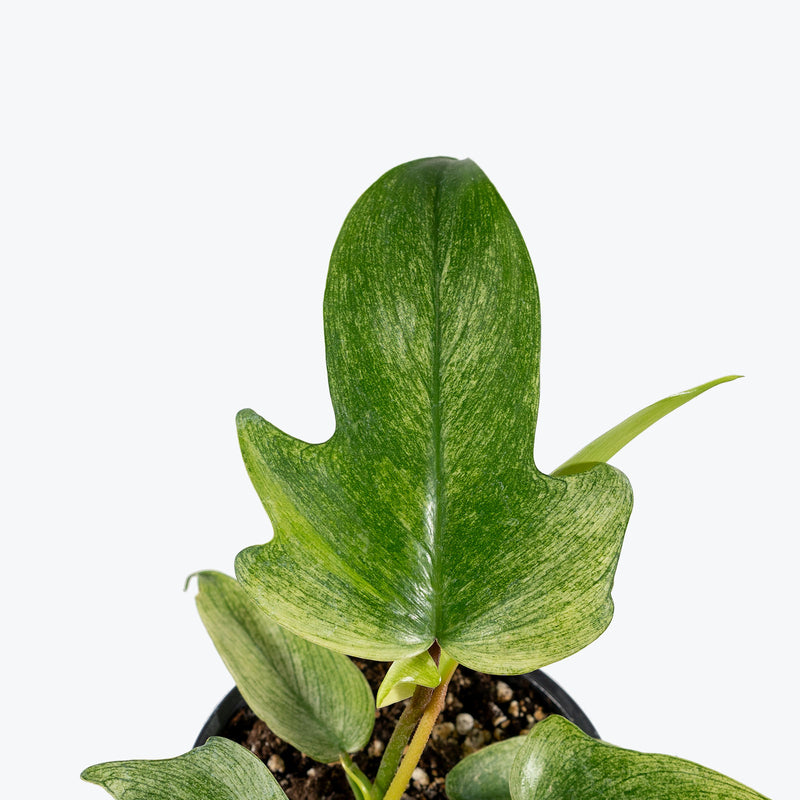
How to care for Philodendron Florida Ghost
Philodendron Florida Ghost should not be in a position to see the sun directly, although early morning or late evening sun is fine. Filtered sunlight through a sheer curtain is best and most homes are comprised primarily of indirect sunlight. The best spot for them is where they do not see the sun during the majority of the day but still get bright, indirect light.
Philodendron Florida Ghost will thrive in bright light, but also can tolerate medium light. A good medium-light place in your home would be in the middle of a room that has a regular size window. They can be placed anywhere between the middle of the room and the window. Remember that plants will grow based on how much light they receive.
Philodendron Florida Ghost needs to be watered when the top half of the soil is dry to the touch. That usually takes about 1 week in an average home environment. It will vary depending on the time of year, your environment and lighting conditions, but it's always safer to underwater or give the soil a check before you water again. Expect to water more often in brighter light and less often in lower light.
Philodendron Florida Ghost will do well in average humidity environments but will appreciate a little bit of humidity if provided, give them a mist daily or get a humidifier.
Allow the soil to mostly dry out between watering during the winter seasons. Since Philodendron Florida Ghost plants are climbing vines, they will eventually need some support as they age, such as a bamboo stake or moss pole.
Philodendron Florida Ghost is moderately toxic and can cause some adverse reactions when ingested so it is best to not let your pets eat it, which we advise for all plants in general. The severity of the reaction will depend on how much of the plant is ingested but, if you know your pet typically does not eat your plants, this plant will be suitable for your home..
Learn MoreView PlantPhilodendron Florida Green
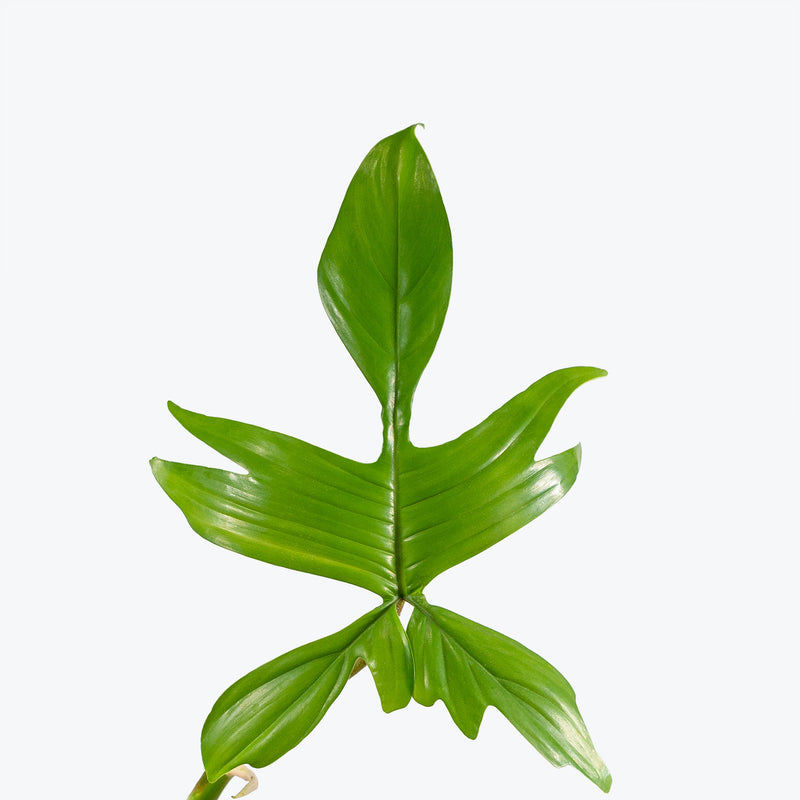
How to care for Philodendron Florida Green
Philodendron Florida Green should not be in a position to see the sun directly, although early morning or late evening sun is fine. Filtered sunlight through a sheer curtain is best and most homes are comprised primarily of indirect sunlight. The best spot for them is where they do not see the sun during the majority of the day but still get bright, indirect light.
Philodendron Florida Green will thrive in bright light, but also can tolerate medium light. A good medium-light place in your home would be in the middle of a room that has a regular size window. They can be placed anywhere between the middle of the room and the window. Remember that plants will grow based on how much light they receive.
Philodendron Florida Green needs to be watered when the top half of the soil is dry to the touch. That usually takes about 1 week in an average home environment. It will vary depending on the time of year, your environment and lighting conditions, but it's always safer to underwater or give the soil a check before you water again. Expect to water more often in brighter light and less often in lower light.
Philodendron Florida Green will do well in average humidity environments but will appreciate a little bit of humidity if provided, give them a mist daily or get a humidifier.
Allow the soil to mostly dry out between watering during the winter seasons. Browning leaf tips can indicate a dry environment, so consider increasing humidity if this occurs. Since Philodendron Florida Green plants are climbing vines, they will eventually need some support as they age, such as a bamboo stake or moss pole.
Philodendron Florida Green is moderately toxic and can cause some adverse reactions when ingested so it is best to not let your pets eat it, which we advise for all plants in general. The severity of the reaction will depend on how much of the plant is ingested but, if you know your pet typically does not eat your plants, this plant will be suitable for your home..
Learn MoreView PlantPhilodendron Fuzzy Petiole
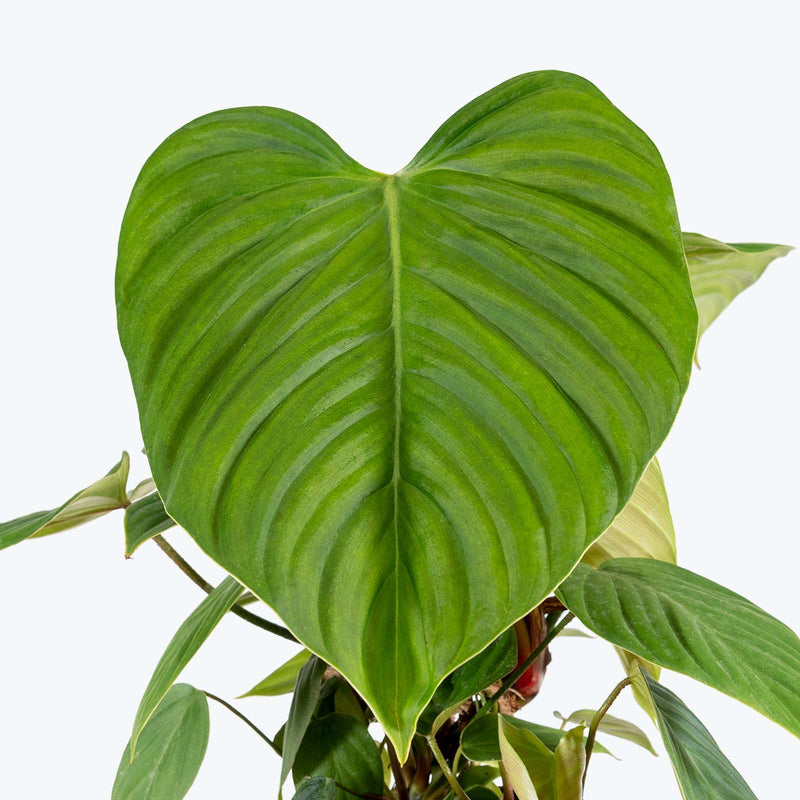
How to care for Philodendron Fuzzy Petiole
Philodendron Fuzzy Petiole should not be in a position to see the sun directly, although early morning or late evening sun is fine. Filtered sunlight through a sheer curtain is best and most homes are comprised primarily of indirect sunlight. The best spot for them is where they do not see the sun during the majority of the day but still get bright, indirect light.
Philodendron Fuzzy Petiole will thrive in bright light, but also can tolerate medium light. A good medium-light place in your home would be in the middle of a room that has a regular size window. They can be placed anywhere between the middle of the room and the window. Remember that plants will grow based on how much light they receive.
Philodendron Fuzzy Petiole needs to be watered when the top half of the soil is dry to the touch. That usually takes about 1 week in an average home environment. It will vary depending on the time of year, your environment and lighting conditions, but it's always safer to underwater or give the soil a check before you water again. Expect to water more often in brighter light and less often in lower light.
Philodendron Fuzzy Petiole will do well in average humidity environments but will appreciate a little bit of humidity if provided, give them a mist daily or get a humidifier.
Fertilize Philodendron Fuzzy Petiole with a balanced liquid fertilizer every month during the growing season (spring through summer), diluting it to half the recommended strength. In the winter, reduce fertilization as the plant's growth naturally slows. Regularly clean the leaves with a soft, damp cloth to remove dust and enhance their appearance. Support the climbing habit with a moss pole.
Philodendron Fuzzy Petiole is moderately toxic and can cause some adverse reactions when ingested so it is best to not let your pets eat it, which we advise for all plants in general. The severity of the reaction will depend on how much of the plant is ingested but, if you know your pet typically does not eat your plants, this plant will be suitable for your home..
Learn MoreView PlantPhilodendron Giganteum Blizzard

How to care for Philodendron Giganteum Blizzard
Philodendron Giganteum Blizzard should not be in a position to see the sun directly, although early morning or late evening sun is fine. Filtered sunlight through a sheer curtain is best and most homes are comprised primarily of indirect sunlight. The best spot for them is where they do not see the sun during the majority of the day but still get bright, indirect light.
Philodendron Giganteum Blizzard will thrive in bright light, but also can tolerate medium light. A good medium-light place in your home would be in the middle of a room that has a regular size window. They can be placed anywhere between the middle of the room and the window. Remember that plants will grow based on how much light they receive.
Philodendron Giganteum Blizzard needs to be watered when the top half of the soil is dry to the touch. That usually takes about 1 week in an average home environment. It will vary depending on the time of year, your environment and lighting conditions, but it's always safer to underwater or give the soil a check before you water again. Expect to water more often in brighter light and less often in lower light.
Philodendron Giganteum Blizzard will do well in average humidity environments but will appreciate a little bit of humidity if provided, give them a mist daily or get a humidifier.
Plant in a well-draining aroid mix rich in orchid bark, perlite, and peat. Fertilize Philodendron Giganteum Blizzard monthly during spring and summer with a diluted, balanced fertilizer. Wipe the broad leaves regularly to maintain their sheen and allow efficient photosynthesis. Given space and warmth, Philodendron Giganteum Blizzard becomes a true showpiece with enormous, patterned foliage.
Philodendron Giganteum Blizzard is moderately toxic and can cause some adverse reactions when ingested so it is best to not let your pets eat it, which we advise for all plants in general. The severity of the reaction will depend on how much of the plant is ingested but, if you know your pet typically does not eat your plants, this plant will be suitable for your home..
Learn MoreView PlantPhilodendron Gigas

How to care for Philodendron Gigas
Philodendron Gigas should not be in a position to see the sun directly, although early morning or late evening sun is fine. Filtered sunlight through a sheer curtain is best and most homes are comprised primarily of indirect sunlight. The best spot for them is where they do not see the sun during the majority of the day but still get bright, indirect light.
Philodendron Gigas will thrive in bright light, but also can tolerate medium light. A good medium-light place in your home would be in the middle of a room that has a regular size window. They can be placed anywhere between the middle of the room and the window. Remember that plants will grow based on how much light they receive.
Philodendron Gigas needs to be watered when the top half of the soil is dry to the touch. That usually takes about 1 week in an average home environment. It will vary depending on the time of year, your environment and lighting conditions, but it's always safer to underwater or give the soil a check before you water again. Expect to water more often in brighter light and less often in lower light.
Philodendron Gigas likes a high humidity environment, give them a mist daily or as often as possible. Alternatively, you can put them around a humidifier. Although they won't die if they don't receive enough humidity, their leaves may have some dry, crunchy, or yellow edges.
Fertilize Philodendron Gigas every 4-6 weeks during the growing season with a balanced liquid fertilizer diluted to half the recommended strength. Reduce fertilizing in the winter when growth slows down. Provide structural support such as a moss pole to encourage natural climbing behavior and vertical growth. Regularly wipe down the leaves with a soft, damp cloth to remove dust and maintain the healthy appearance of the velvety foliage.
Philodendron Gigas is moderately toxic and can cause some adverse reactions when ingested so it is best to not let your pets eat it, which we advise for all plants in general. The severity of the reaction will depend on how much of the plant is ingested but, if you know your pet typically does not eat your plants, this plant will be suitable for your home..
Learn MoreView PlantPhilodendron Glad Hands

How to care for Philodendron Glad Hands
Philodendron Glad Hands should not be in a position to see the sun directly, although early morning or late evening sun is fine. Filtered sunlight through a sheer curtain is best and most homes are comprised primarily of indirect sunlight. The best spot for them is where they do not see the sun during the majority of the day but still get bright, indirect light.
Philodendron Glad Hands will thrive in bright light, but also can tolerate medium light. A good medium-light place in your home would be in the middle of a room that has a regular size window. They can be placed anywhere between the middle of the room and the window. Remember that plants will grow based on how much light they receive.
Philodendron Glad Hands needs to be watered when the top half of the soil is dry to the touch. That usually takes about 1 week in an average home environment. It will vary depending on the time of year, your environment and lighting conditions, but it's always safer to underwater or give the soil a check before you water again. Expect to water more often in brighter light and less often in lower light.
Philodendron Glad Hands will do well in average humidity environments but will appreciate a little bit of humidity if provided, give them a mist daily or get a humidifier.
Provide a moss pole or trellis to support its natural climbing habit—this encourages more mature, deeply lobed foliage. Use a chunky, well-draining mix with perlite, bark, and peat. Fertilize every 4–6 weeks during spring and summer for vigorous growth. Rotate Philodendron Glad Hands occasionally for even leaf development. Maintain warmth and avoid cold drafts to keep the plant thriving.
Philodendron Glad Hands is moderately toxic and can cause some adverse reactions when ingested so it is best to not let your pets eat it, which we advise for all plants in general. The severity of the reaction will depend on how much of the plant is ingested but, if you know your pet typically does not eat your plants, this plant will be suitable for your home..
Learn MoreView PlantPhilodendron Gloriosum
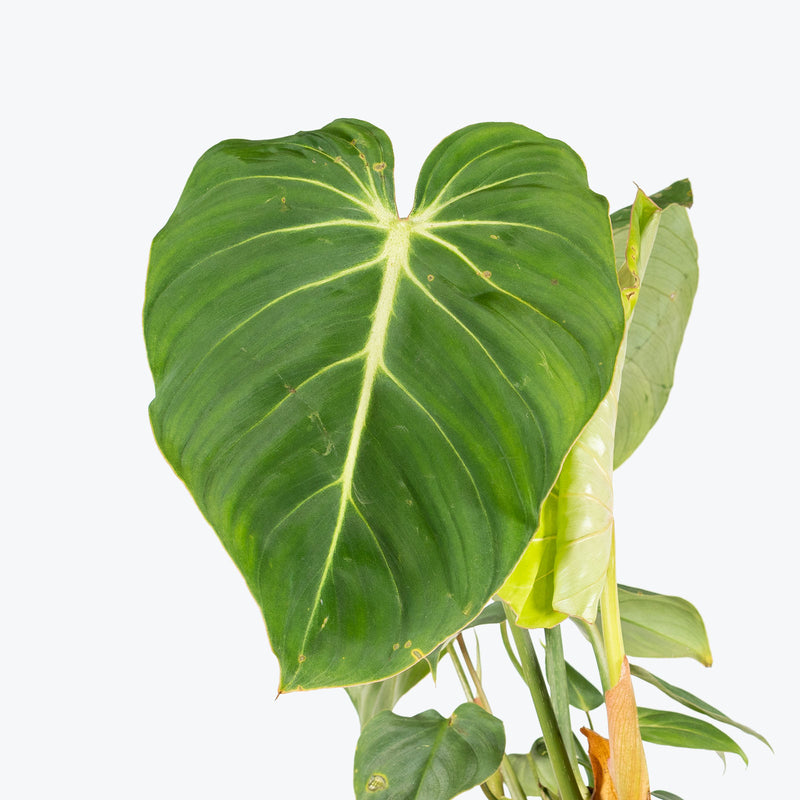
How to care for Philodendron Gloriosum
They should not be in a position to see the sun directly, although early morning or late evening sun is fine. Filtered sunlight through a sheer curtain is best and most homes are comprised primarily of indirect sunlight. The best spot for them is where they do not see the sun during the majority of the day but still get bright, indirect light.
They will do well in medium light but will grow faster with brighter light. A good medium-light place in your home would be in the middle of a room that has a regular size window. Remember that plants will grow based on how much light they receive.
Allow the top quarter of the soil to dry before watering again. This usually takes about 3 - 4 days in an average home environment. It will vary depending on the time of year, your environment and lighting conditions. Expect to water more often in brighter light and less often in lower light.
They will do well in average humidity environments but will appreciate a little bit of humidity if provided, give them a mist daily or get a humidifier.
Gloriosums are easy to propagate via stem cutting or air layering. When potting up, make sure the rhizome is not completely under the soil, as this can lead to root rot. And be patient, it can take up to a month for leaves to unfurl sometimes.
This plant is moderately toxic and can cause some adverse reactions when ingested so it is best to not let your pets eat it, which we advise for all plants in general. The severity of the reaction will depend on how much of the plant is ingested but, if you know your pet typically does not eat your plants, this plant will be suitable for your home..
Learn MoreView PlantPhilodendron Goeldii
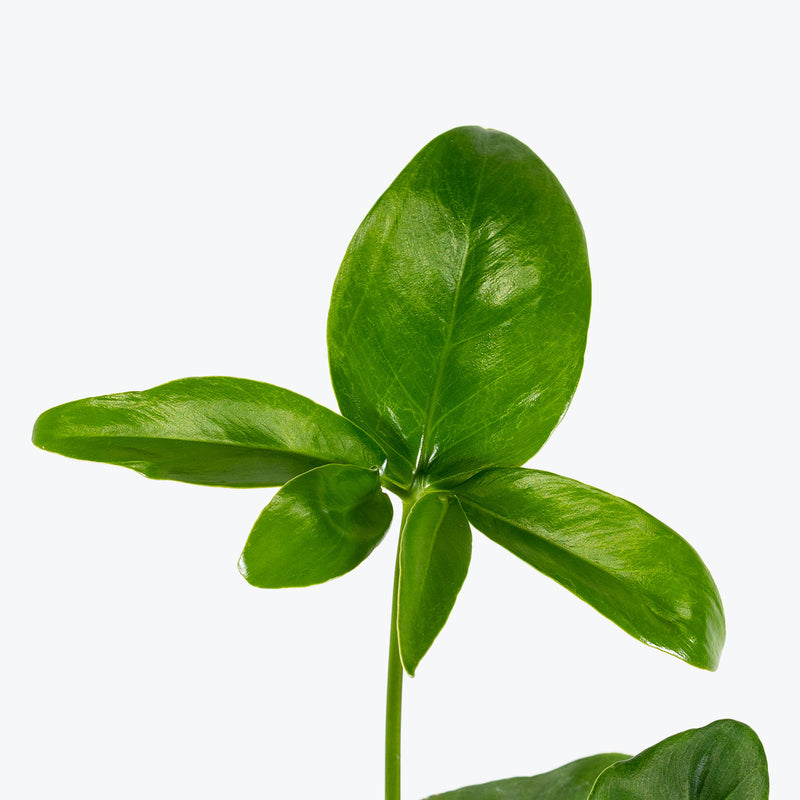
How to care for Philodendron Goeldii
They should not be in a position to see the sun directly, although early morning or late evening sun is fine. Filtered sunlight through a sheer curtain is best and most homes are comprised primarily of indirect sunlight. The best spot for them is where they do not see the sun during the majority of the day but still get bright, indirect light.
They will do well in medium light but will grow faster with brighter light. A good medium-light place in your home would be in the middle of a room that has a regular size window. Remember that plants will grow based on how much light they receive.
They need to be watered when the top half of the soil is dry to the touch. That usually takes about 1 week in an average home environment. It will vary depending on the time of year, your environment and lighting conditions, but it's always safer to underwater or give the soil a check before you water again. Expect to water more often in brighter light and less often in lower light.
They like a high humidity environment, give them a mist daily or as often as possible. Alternatively, you can put them around a humidifier. Although they won't die if they don't receive enough humidity, their leaves may have some dry, crunchy, or yellow edges.
Since they prefer to be root bound, only repot your plant when its roots have outgrown their current home. Rotate your plant every week or so to encourage even, consistent, and healthy growth. Allow the soil to dry out more between waterings during the winter seasons but make sure there is still plenty of humidity.
This plant is moderately toxic and can cause some adverse reactions when ingested so it is best to not let your pets eat it, which we advise for all plants in general. The severity of the reaction will depend on how much of the plant is ingested but, if you know your pet typically does not eat your plants, this plant will be suitable for your home..
Learn MoreView PlantPhilodendron Golden Dragon
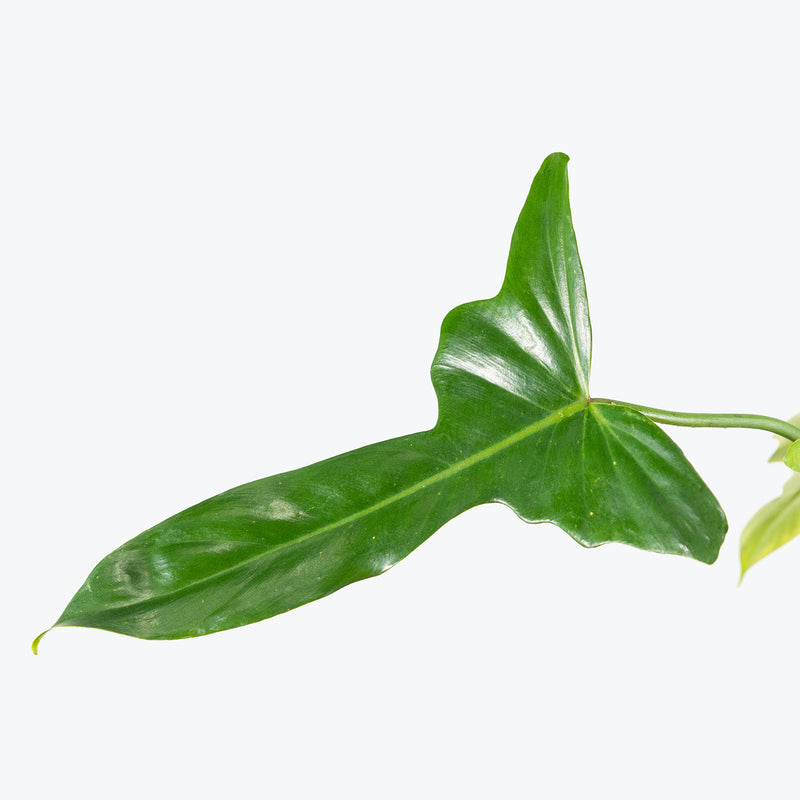
How to care for Philodendron Golden Dragon
Philodendron Golden Dragon should not be in a position to see the sun directly, although early morning or late evening sun is fine. Filtered sunlight through a sheer curtain is best and most homes are comprised primarily of indirect sunlight. The best spot for them is where they do not see the sun during the majority of the day but still get bright, indirect light.
Philodendron Golden Dragon will thrive in bright light, but also can tolerate medium light. A good medium-light place in your home would be in the middle of a room that has a regular size window. They can be placed anywhere between the middle of the room and the window. Remember that plants will grow based on how much light they receive.
Philodendron Golden Dragon needs to be watered when the top half of the soil is dry to the touch. That usually takes about 1 week in an average home environment. It will vary depending on the time of year, your environment and lighting conditions, but it's always safer to underwater or give the soil a check before you water again. Expect to water more often in brighter light and less often in lower light.
Philodendron Golden Dragon will do well in average humidity environments but will appreciate a little bit of humidity if provided, give them a mist daily or get a humidifier.
Philodendron Golden Dragon benefits from a well-draining soil mix and should be repotted only when necessary. Provide support for its climbing growth habit with a moss pole or trellis. Keep an eye out for any signs of pests, and maintain a regular feeding schedule with a balanced, water-soluble fertilizer every 4-6 weeks during the growing season (spring and summer).
Philodendron Golden Dragon is moderately toxic and can cause some adverse reactions when ingested so it is best to not let your pets eat it, which we advise for all plants in general. The severity of the reaction will depend on how much of the plant is ingested but, if you know your pet typically does not eat your plants, this plant will be suitable for your home..
Learn MoreView PlantPhilodendron Golden Goddess
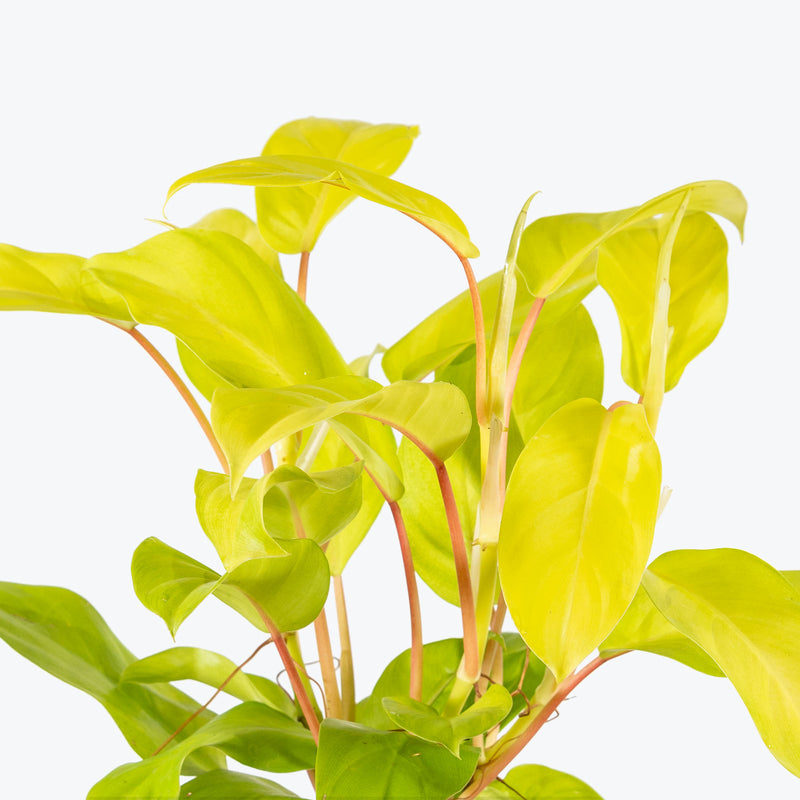
How to care for Philodendron Golden Goddess
They should not be in a position to see the sun directly, although early morning or late evening sun is fine. Filtered sunlight through a sheer curtain is best and most homes are comprised primarily of indirect sunlight. The best spot for them is where they do not see the sun during the majority of the day but still get bright, indirect light.
They will do well in medium light but will grow faster with brighter light. A good medium-light place in your home would be in the middle of a room that has a regular size window. Remember that plants will grow based on how much light they receive.
They need to be watered when the top half of the soil is dry to the touch. That usually takes about 1 week in an average home environment. It will vary depending on the time of year, your environment and lighting conditions, but it's always safer to underwater or give the soil a check before you water again. Expect to water more often in brighter light and less often in lower light.
They will do well in average humidity environments but will appreciate a little bit of humidity if provided, give them a mist daily or get a humidifier.
Allow the soil to mostly dry out between watering during the winter seasons. This tropical houseplant loves warm temperatures and has no cold hardiness. As the plant grows, it will most likely need a bamboo stake or moss pole to grow up, as it loves to grow up a stable structure.
This plant is moderately toxic and can cause some adverse reactions when ingested so it is best to not let your pets eat it, which we advise for all plants in general. The severity of the reaction will depend on how much of the plant is ingested but, if you know your pet typically does not eat your plants, this plant will be suitable for your home..
Learn MoreView PlantPhilodendron Golden Violin
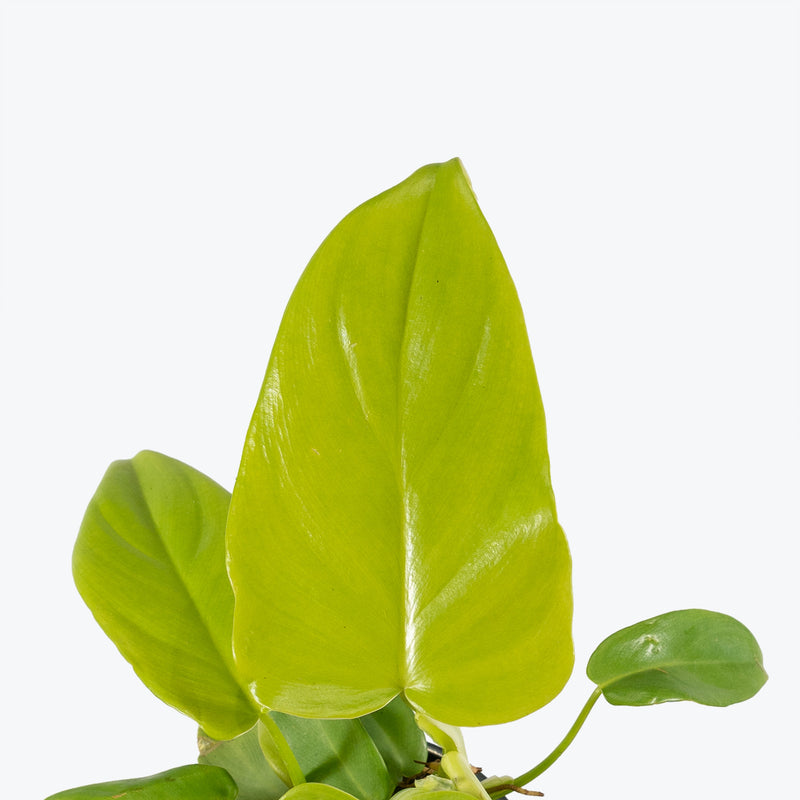
How to care for Philodendron Golden Violin
They should not be in a position to see the sun directly, although early morning or late evening sun is fine. Filtered sunlight through a sheer curtain is best and most homes are comprised primarily of indirect sunlight. The best spot for them is where they do not see the sun during the majority of the day but still get bright, indirect light.
They will do well in medium light but will grow faster with brighter light. A good medium-light place in your home would be in the middle of a room that has a regular size window. Remember that plants will grow based on how much light they receive.
They need to be watered when the top half of the soil is dry to the touch. That usually takes about 1 week in an average home environment. It will vary depending on the time of year, your environment and lighting conditions, but it's always safer to underwater or give the soil a check before you water again. Expect to water more often in brighter light and less often in lower light.
They will do well in average humidity environments but will appreciate a little bit of humidity if provided, give them a mist daily or get a humidifier.
Allow the soil to mostly dry out between watering during the winter seasons. This tropical houseplant loves warm temperatures and has no cold hardiness. As the plant grows, it will most likely need a bamboo stake or moss pole to grow up, as it loves to grow up a stable structure.
This plant is moderately toxic and can cause some adverse reactions when ingested so it is best to not let your pets eat it, which we advise for all plants in general. The severity of the reaction will depend on how much of the plant is ingested but, if you know your pet typically does not eat your plants, this plant will be suitable for your home..
Learn MoreView PlantPhilodendron Grazielae
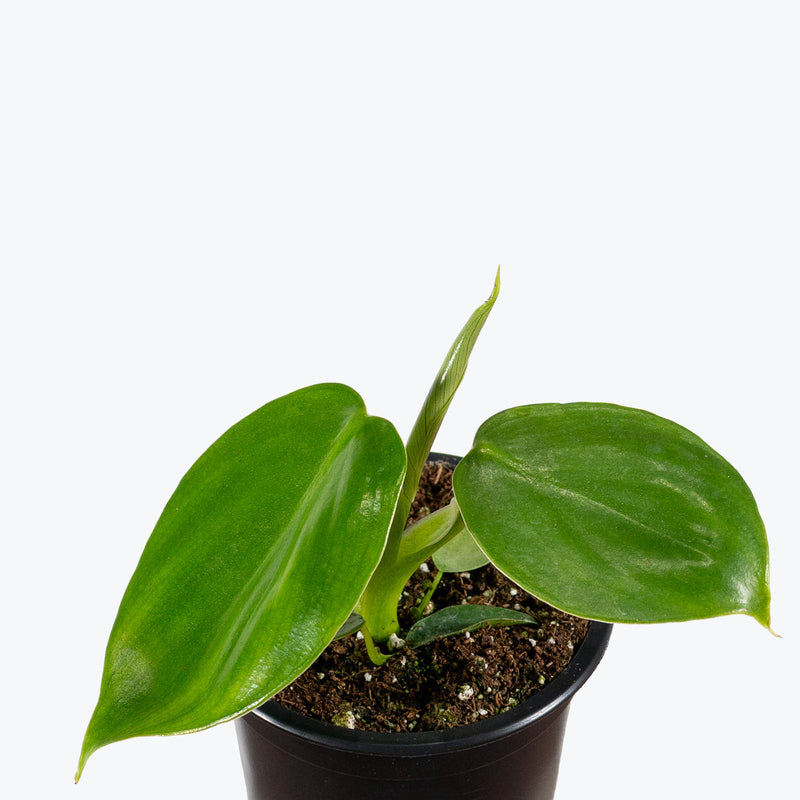
How to care for Philodendron Grazielae
Philodendron Grazielae should not be in a position to see the sun directly, although early morning or late evening sun is fine. Filtered sunlight through a sheer curtain is best and most homes are comprised primarily of indirect sunlight. The best spot for them is where they do not see the sun during the majority of the day but still get bright, indirect light.
Philodendron Grazielae will thrive in bright light, but also can tolerate medium light. A good medium-light place in your home would be in the middle of a room that has a regular size window. They can be placed anywhere between the middle of the room and the window. Remember that plants will grow based on how much light they receive.
Philodendron Grazielae needs to be watered when the top half of the soil is dry to the touch. That usually takes about 1 week in an average home environment. It will vary depending on the time of year, your environment and lighting conditions, but it's always safer to underwater or give the soil a check before you water again. Expect to water more often in brighter light and less often in lower light.
Philodendron Grazielae likes a high humidity environment, give them a mist daily or as often as possible. Alternatively, you can put them around a humidifier. Although they won't die if they don't receive enough humidity, their leaves may have some dry, crunchy, or yellow edges.
Use a moss pole or other support structure to encourage its climbing habit. This will also help Philodendron Grazielae stay upright and support the development of its adventitious roots. Fertilize every month during the growing season with a diluted, balanced fertilizer to support its slow growth. Prune back any unruly or dead foliage to keep the plant looking tidy and to promote new growth.
Philodendron Grazielae is moderately toxic and can cause some adverse reactions when ingested so it is best to not let your pets eat it, which we advise for all plants in general. The severity of the reaction will depend on how much of the plant is ingested but, if you know your pet typically does not eat your plants, this plant will be suitable for your home..
Learn MoreView PlantPhilodendron Green Congo Nuclear
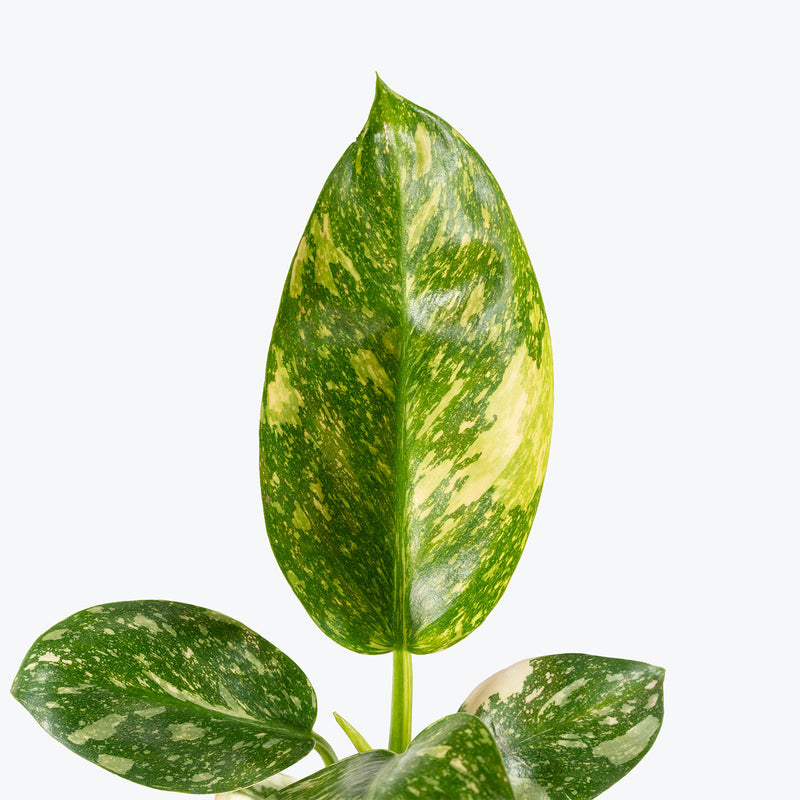
How to care for Philodendron Green Congo Nuclear
Philodendron Green Congo Nuclear should not be in a position to see the sun directly, although early morning or late evening sun is fine. Filtered sunlight through a sheer curtain is best and most homes are comprised primarily of indirect sunlight. The best spot for them is where they do not see the sun during the majority of the day but still get bright, indirect light.
Philodendron Green Congo Nuclear will thrive in bright light, but also can tolerate medium light. A good medium-light place in your home would be in the middle of a room that has a regular size window. They can be placed anywhere between the middle of the room and the window. Remember that plants will grow based on how much light they receive.
Philodendron Green Congo Nuclear needs to be watered when the top half of the soil is dry to the touch. That usually takes about 1 week in an average home environment. It will vary depending on the time of year, your environment and lighting conditions, but it's always safer to underwater or give the soil a check before you water again. Expect to water more often in brighter light and less often in lower light.
Philodendron Green Congo Nuclear will do well in average humidity environments but will appreciate a little bit of humidity if provided, give them a mist daily or get a humidifier.
Rotate Philodendron Green Congo Nuclear regularly to keep growth even and upright. Use a well-draining aroid mix with perlite or orchid bark to prevent soggy roots. Fertilize monthly during spring and summer with a balanced houseplant fertilizer to encourage strong growth and variegation.
Philodendron Green Congo Nuclear is moderately toxic and can cause some adverse reactions when ingested so it is best to not let your pets eat it, which we advise for all plants in general. The severity of the reaction will depend on how much of the plant is ingested but, if you know your pet typically does not eat your plants, this plant will be suitable for your home..
Learn MoreView PlantPhilodendron Green Dragon
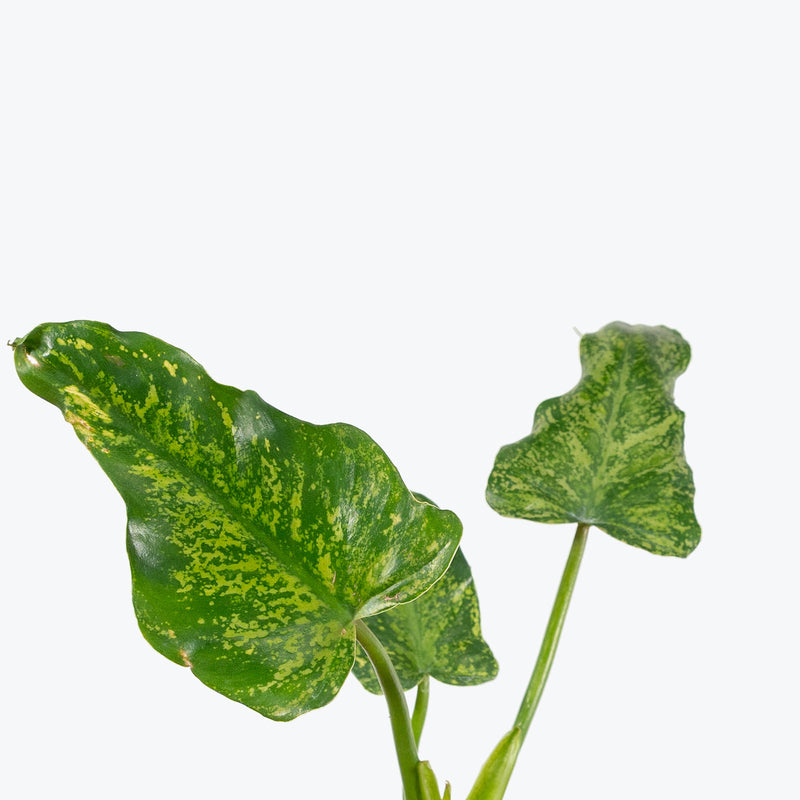
How to care for Philodendron Green Dragon
Philodendron Green Dragon should not be in a position to see the sun directly, although early morning or late evening sun is fine. Filtered sunlight through a sheer curtain is best and most homes are comprised primarily of indirect sunlight. The best spot for them is where they do not see the sun during the majority of the day but still get bright, indirect light.
Philodendron Green Dragon will thrive in bright light, but also can tolerate medium light. A good medium-light place in your home would be in the middle of a room that has a regular size window. They can be placed anywhere between the middle of the room and the window. Remember that plants will grow based on how much light they receive.
Philodendron Green Dragon needs to be watered when the top half of the soil is dry to the touch. That usually takes about 1 week in an average home environment. It will vary depending on the time of year, your environment and lighting conditions, but it's always safer to underwater or give the soil a check before you water again. Expect to water more often in brighter light and less often in lower light.
Philodendron Green Dragon will do well in average humidity environments but will appreciate a little bit of humidity if provided, give them a mist daily or get a humidifier.
Regularly wipe the leaves with a damp cloth to remove dust and maintain their shine. If the Philodendron Green Dragon becomes too leggy, prune it to encourage bushier growth. It's a fast grower and can be easily propagated from stem cuttings.
Philodendron Green Dragon is moderately toxic and can cause some adverse reactions when ingested so it is best to not let your pets eat it, which we advise for all plants in general. The severity of the reaction will depend on how much of the plant is ingested but, if you know your pet typically does not eat your plants, this plant will be suitable for your home..
Learn MoreView PlantPhilodendron Hederaceum Brasil
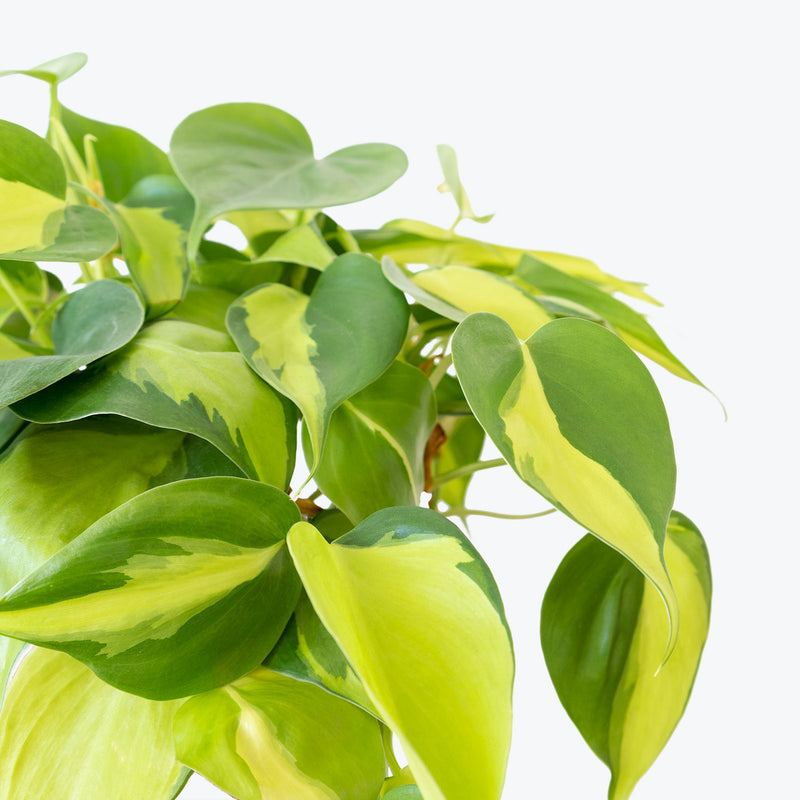
How to care for Philodendron Hederaceum Brasil
Philodendron Hederaceum Brasil should not be in a position to see the sun directly, although early morning or late evening sun is fine. Filtered sunlight through a sheer curtain is best and most homes are comprised primarily of indirect sunlight. The best spot for them is where they do not see the sun during the majority of the day but still get bright, indirect light.
Philodendron Hederaceum Brasil will thrive in medium to bright light, but also can tolerate low light. A good medium-light place in your home would be in the middle of a room that has a regular size window. They can be placed almost anywhere in the room but remember, plants will grow based on how much light they receive.
Philodendron Hederaceum Brasil likes the soil to be relatively dry before the next watering. That usually takes about 2 weeks in an average home environment. It will vary depending on the time of year, your environment and lighting conditions, but for them, it's always safer to underwater or water when you see signs of lack of water (i.e. droopy, floppy, or soft leaves). Expect to water more often in brighter light and less often in lower light.
Philodendron Hederaceum Brasil can live in any average home humidity condition and are fairly hardy.
Soft, yellow leaves on Philodendron Hederaceum Brasil may indicate overwatering, while crispy, brown leaves usually mean the plant needs more water. If you wish to propagate, take stem cuttings during the warmer months and place the stem in water or moist soil, making sure to keep at least one node - point of attachment of a leaf - submerged, from which the roots will grow, and they should root quite easily.
Philodendron Hederaceum Brasil is moderately toxic and can cause some adverse reactions when ingested so it is best to not let your pets eat it, which we advise for all plants in general. The severity of the reaction will depend on how much of the plant is ingested but, if you know your pet typically does not eat your plants, this plant will be suitable for your home..
Learn MoreView PlantPhilodendron Hederaceum Heartleaf
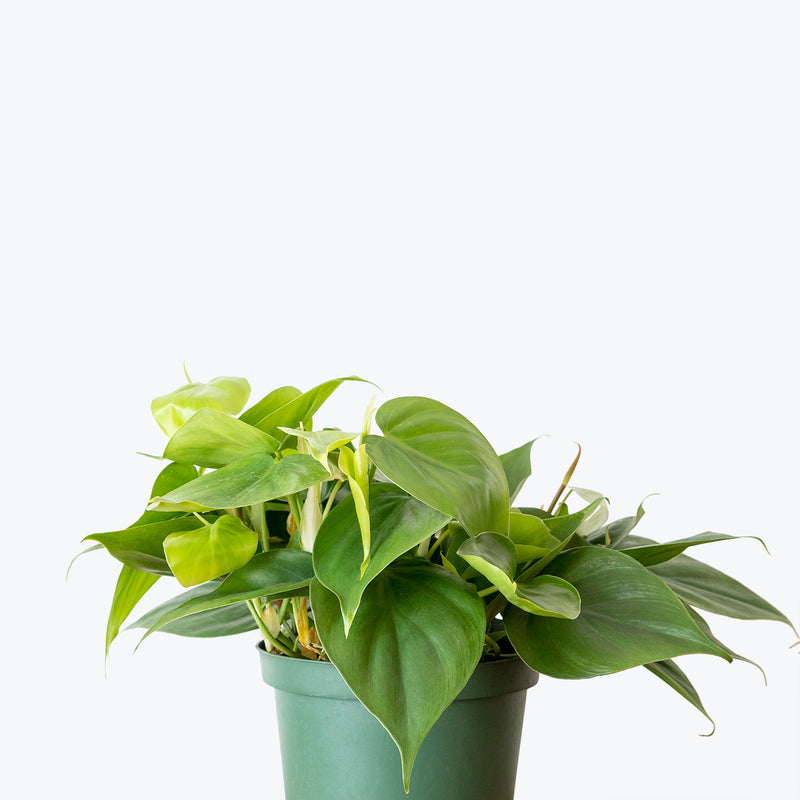
How to care for Philodendron Hederaceum Heartleaf
Philodendron Hederaceum Heartleaf should not be in a position to see the sun directly, although early morning or late evening sun is fine. Filtered sunlight through a sheer curtain is best and most homes are comprised primarily of indirect sunlight. The best spot for them is where they do not see the sun during the majority of the day but still get bright, indirect light.
Philodendron Hederaceum Heartleaf will do well in low light, but will grow faster with brighter light. A low light plant can pretty much survive anyplace inside your home as long as you have a window in the room. Remember, low light does not mean no light and plants will grow based on how much light they receive.
Philodendron Hederaceum Heartleaf likes the soil to be relatively dry before the next watering. That usually takes about 2 weeks in an average home environment. It will vary depending on the time of year, your environment and lighting conditions, but for them, it's always safer to underwater or water when you see signs of lack of water (i.e. droopy, floppy, or soft leaves). Expect to water more often in brighter light and less often in lower light.
Philodendron Hederaceum Heartleaf can live in any average home humidity condition and are fairly hardy.
Soft, yellow leaves on Philodendron Hederaceum Heartleaf may indicate overwatering, while crispy, brown leaves usually mean the plant needs more water. If you wish to propagate, take stem cuttings during the warmer months and place the stem in water or moist soil, making sure to keep at least one node - point of attachment of a leaf - submerged, from which the roots will grow, and they should root quite easily.
Philodendron Hederaceum Heartleaf is moderately toxic and can cause some adverse reactions when ingested so it is best to not let your pets eat it, which we advise for all plants in general. The severity of the reaction will depend on how much of the plant is ingested but, if you know your pet typically does not eat your plants, this plant will be suitable for your home..
Learn MoreView PlantPhilodendron Hederaceum Lemon Lime
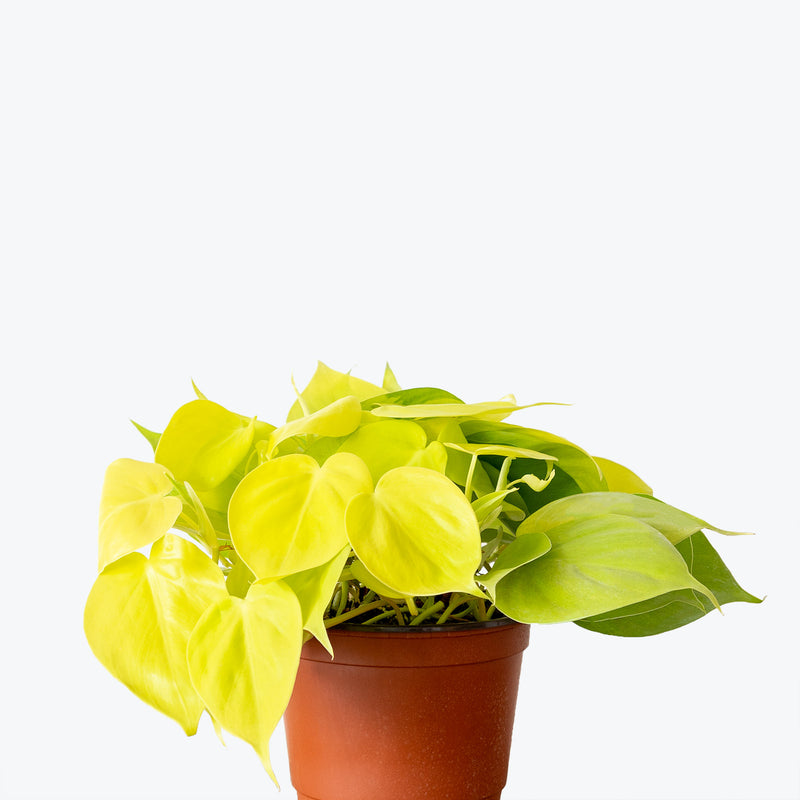
How to care for Philodendron Hederaceum Lemon Lime
They should not be in a position to see the sun directly, although early morning or late evening sun is fine. Filtered sunlight through a sheer curtain is best and most homes are comprised primarily of indirect sunlight. The best spot for them is where they do not see the sun during the majority of the day but still get bright, indirect light.
They will thrive in medium to bright light, but also can tolerate low light. A good medium-light place in your home would be in the middle of a room that has a regular size window. They can be placed almost anywhere in the room but remember, plants will grow based on how much light they receive.
They like the soil to be relatively dry before the next watering. That usually takes about 2 weeks in an average home environment. It will vary depending on the time of year, your environment and lighting conditions, but for them, it's always safer to underwater or water when you see signs of lack of water (i.e. droopy, floppy, or soft leaves). Expect to water more often in brighter light and less often in lower light.
They can live in any average home humidity condition and are fairly hardy.
Soft, yellow leaves may indicate overwatering, while crispy, brown leaves usually mean the plant needs more water. If you wish to propagate, take stem cuttings during the warmer months and place the stem in water or moist soil, making sure to keep at least one node - point of attachment of a leaf - submerged, from which the roots will grow, and they should root quite easily.
This plant is moderately toxic and can cause some adverse reactions when ingested so it is best to not let your pets eat it, which we advise for all plants in general. The severity of the reaction will depend on how much of the plant is ingested but, if you know your pet typically does not eat your plants, this plant will be suitable for your home..
Learn MoreView PlantPhilodendron Hope Selloum
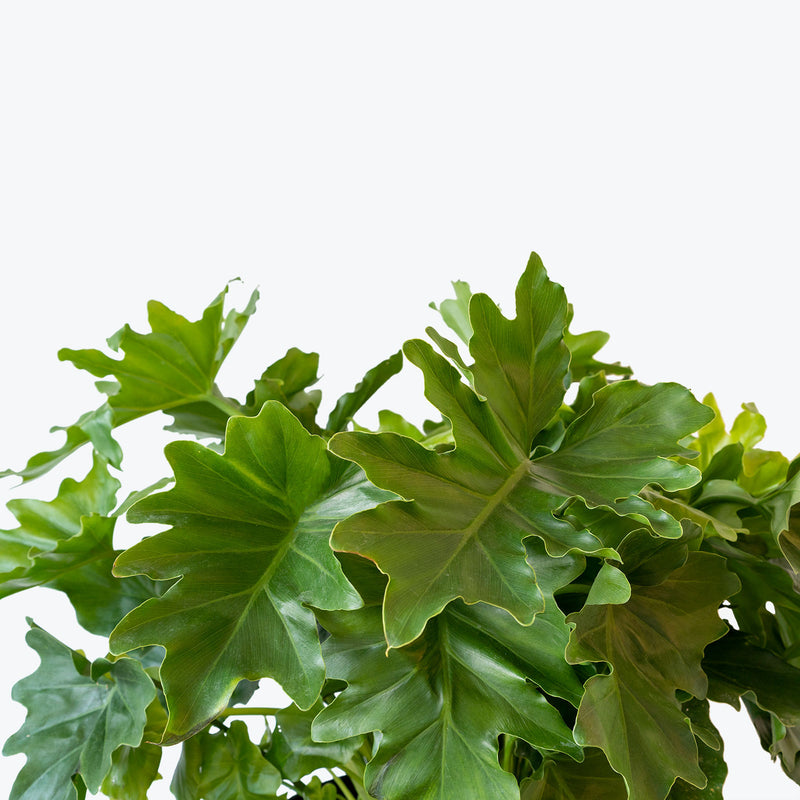
How to care for Philodendron Hope Selloum
They should not be in a position to see the sun directly, although early morning or late evening sun is fine. Filtered sunlight through a sheer curtain is best and most homes are comprised primarily of indirect sunlight. The best spot for them is where they do not see the sun during the majority of the day but still get bright, indirect light.
They will thrive in bright light, but also can tolerate medium light. A good medium-light place in your home would be in the middle of a room that has a regular size window. They can be placed anywhere between the middle of the room and the window. Remember that plants will grow based on how much light they receive.
They need to be watered when the top half of the soil is dry to the touch. That usually takes about 1 week in an average home environment. It will vary depending on the time of year, your environment and lighting conditions, but it's always safer to underwater or give the soil a check before you water again. Expect to water more often in brighter light and less often in lower light.
They will do well in average humidity environments but will appreciate a little bit of humidity if provided, give them a mist daily or get a humidifier. They also prefer warmer locations.
This Philodendron is very easy, perfect for beginners! Rotate your plant every week or so to encourage even, consistent, and healthy growth. Allow the soil to dry out more between waterings during the winter seasons.
This plant is moderately toxic and can cause some adverse reactions when ingested so it is best to not let your pets eat it, which we advise for all plants in general. The severity of the reaction will depend on how much of the plant is ingested but, if you know your pet typically does not eat your plants, this plant will be suitable for your home..
Learn MoreView PlantPhilodendron Joepii

How to care for Philodendron Joepii
Philodendron Joepii should not be in a position to see the sun directly, although early morning or late evening sun is fine. Filtered sunlight through a sheer curtain is best and most homes are comprised primarily of indirect sunlight. The best spot for them is where they do not see the sun during the majority of the day but still get bright, indirect light.
Philodendron Joepii will do well in medium light but will grow faster with brighter light. A good medium-light place in your home would be in the middle of a room that has a regular size window. Remember that plants will grow based on how much light they receive.
Allow the top quarter of the soil to dry before watering again. This usually takes about 3 - 4 days in an average home environment. It will vary depending on the time of year, your environment and lighting conditions. Expect to water Philodendron Joepii more often in brighter light and less often in lower light.
Philodendron Joepii will do well in average humidity environments but will appreciate a little bit of humidity if provided, give them a mist daily or get a humidifier.
Fertilize Philodendron Joepii every 4-6 weeks during the growing season with a diluted, balanced liquid fertilizer. Reduce feeding in the winter when growth slows. Due to its climbing nature, providing a moss pole or another type of support will encourage vertical growth and healthier foliage.
Philodendron Joepii is moderately toxic and can cause some adverse reactions when ingested so it is best to not let your pets eat it, which we advise for all plants in general. The severity of the reaction will depend on how much of the plant is ingested but, if you know your pet typically does not eat your plants, this plant will be suitable for your home..
Learn MoreView PlantPhilodendron Jose Buono
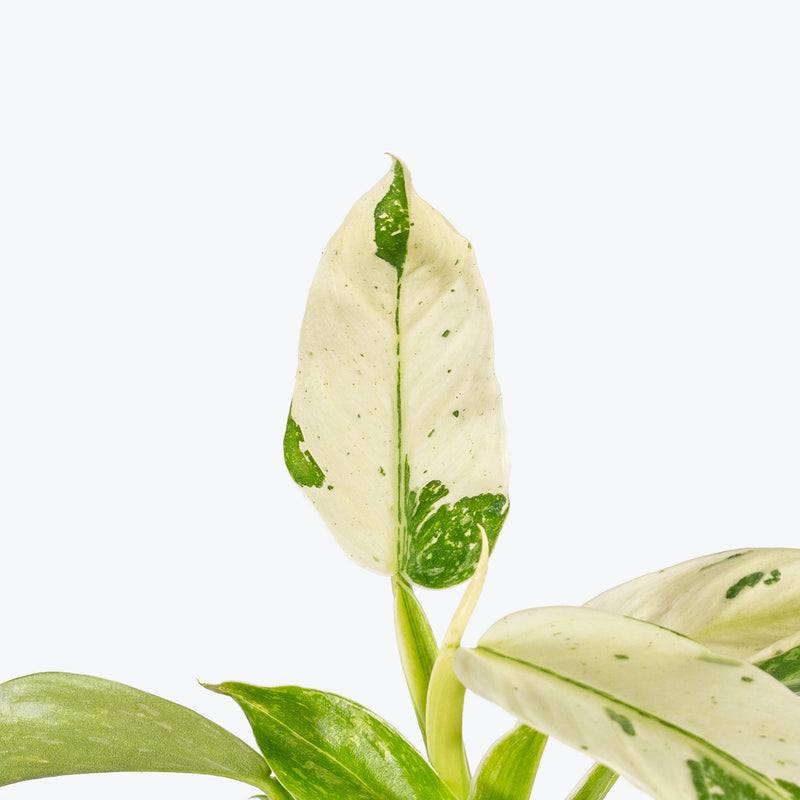
How to care for Philodendron Jose Buono
They should not be in a position to see the sun directly, although early morning or late evening sun is fine. Filtered sunlight through a sheer curtain is best and most homes are comprised primarily of indirect sunlight. The best spot for them is where they do not see the sun during the majority of the day but still get bright, indirect light.
They will do best in bright light. A nice bright place inside your home would be on the window sill or a stool that is right next to a window, either with or without blinds, depending on if the plant can handle sun. Remember that plants will grow based on how much light they receive.
They need to be watered when the top half of the soil is dry to the touch. That usually takes about 1 week in an average home environment. It will vary depending on the time of year, your environment and lighting conditions, but it's always safer to underwater or give the soil a check before you water again. Expect to water more often in brighter light and less often in lower light.
They will do well in average humidity environments but will appreciate a little bit of humidity if provided, give them a mist daily or get a humidifier.
Fertilize every 4-6 weeks during the growing season with a balanced liquid fertilizer. Always check for signs of pests such as spider mites or aphids and treat as necessary.
This plant is moderately toxic and can cause some adverse reactions when ingested so it is best to not let your pets eat it, which we advise for all plants in general. The severity of the reaction will depend on how much of the plant is ingested but, if you know your pet typically does not eat your plants, this plant will be suitable for your home..
Learn MoreView PlantPhilodendron Little Hope
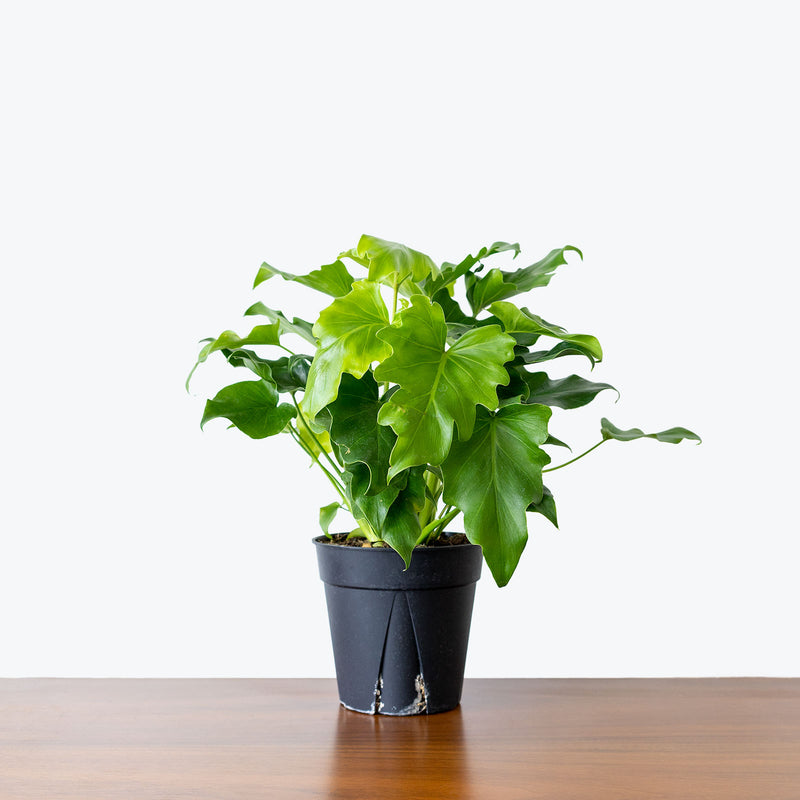
How to care for Philodendron Little Hope
They should not be in a position to see the sun directly, although early morning or late evening sun is fine. Filtered sunlight through a sheer curtain is best and most homes are comprised primarily of indirect sunlight. The best spot for them is where they do not see the sun during the majority of the day but still get bright, indirect light.
They will thrive in bright light, but also can tolerate medium light. A good medium-light place in your home would be in the middle of a room that has a regular size window. They can be placed anywhere between the middle of the room and the window. Remember that plants will grow based on how much light they receive.
They need to be watered when the top half of the soil is dry to the touch. That usually takes about 1 week in an average home environment. It will vary depending on the time of year, your environment and lighting conditions, but it's always safer to underwater or give the soil a check before you water again. Expect to water more often in brighter light and less often in lower light.
They will do well in average humidity environments but will appreciate a little bit of humidity if provided, give them a mist daily or get a humidifier. They also prefer warmer locations.
This Philodendron is very easy, perfect for beginners! Rotate your plant every week or so to encourage even, consistent, and healthy growth. Allow the soil to dry out more between waterings during the winter seasons.
This plant is moderately toxic and can cause some adverse reactions when ingested so it is best to not let your pets eat it, which we advise for all plants in general. The severity of the reaction will depend on how much of the plant is ingested but, if you know your pet typically does not eat your plants, this plant will be suitable for your home..
Learn MoreView PlantPhilodendron Lynette

How to care for Philodendron Lynette
They should not be in a position to see the sun directly, although early morning or late evening sun is fine. Filtered sunlight through a sheer curtain is best and most homes are comprised primarily of indirect sunlight. The best spot for them is where they do not see the sun during the majority of the day but still get bright, indirect light.
They will thrive in bright light, but also can tolerate medium light. A good medium-light place in your home would be in the middle of a room that has a regular size window. They can be placed anywhere between the middle of the room and the window. Remember that plants will grow based on how much light they receive.
They like the soil to be relatively dry before the next watering. That usually takes about 2 weeks in an average home environment. It will vary depending on the time of year, your environment and lighting conditions, but for them, it's always safer to underwater or water when you see signs of lack of water (i.e. droopy, floppy, or soft leaves). Expect to water more often in brighter light and less often in lower light.
They will do well in average humidity environments but will appreciate a little bit of humidity if provided, give them a mist daily or get a humidifier.
Although this is a climbing Philodendron, it is also known to be self-heading, which means the leaves are spaced so close together that the stem is not visible until some of the lower (older) leaves fall off. So, similar to the Philodendron Hope or Congo, they are mainly grown as a bush.
This plant is moderately toxic and can cause some adverse reactions when ingested so it is best to not let your pets eat it, which we advise for all plants in general. The severity of the reaction will depend on how much of the plant is ingested but, if you know your pet typically does not eat your plants, this plant will be suitable for your home..
Learn MoreView PlantPhilodendron Mamei Silver Cloud
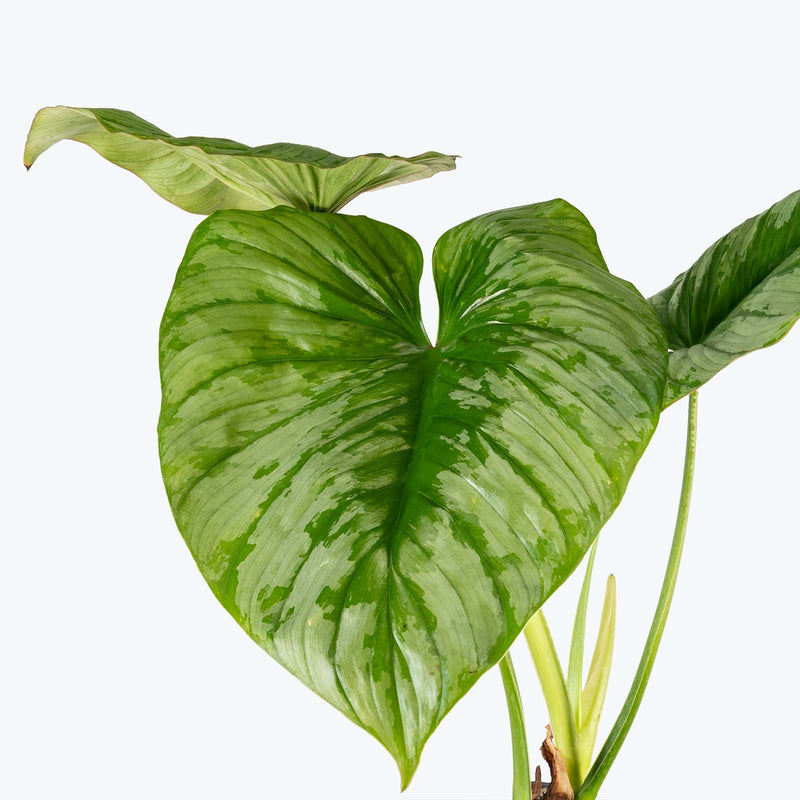
How to care for Philodendron Mamei Silver Cloud
They should not be in a position to see the sun directly, although early morning or late evening sun is fine. Filtered sunlight through a sheer curtain is best and most homes are comprised primarily of indirect sunlight. The best spot for them is where they do not see the sun during the majority of the day but still get bright, indirect light.
They will thrive in bright light, but also can tolerate medium light. A good medium-light place in your home would be in the middle of a room that has a regular size window. They can be placed anywhere between the middle of the room and the window. Remember that plants will grow based on how much light they receive.
They need to be watered when the top half of the soil is dry to the touch. That usually takes about 1 week in an average home environment. It will vary depending on the time of year, your environment and lighting conditions, but it's always safer to underwater or give the soil a check before you water again. Expect to water more often in brighter light and less often in lower light.
They will do well in average humidity environments but will appreciate a little bit of humidity if provided, give them a mist daily or get a humidifier.
Maintain a consistent watering schedule to prevent root rot. It's important to provide the plant with a well-draining soil mix to avoid waterlogged soil.
This plant is moderately toxic and can cause some adverse reactions when ingested so it is best to not let your pets eat it, which we advise for all plants in general. The severity of the reaction will depend on how much of the plant is ingested but, if you know your pet typically does not eat your plants, this plant will be suitable for your home..
Learn MoreView PlantPhilodendron Mars
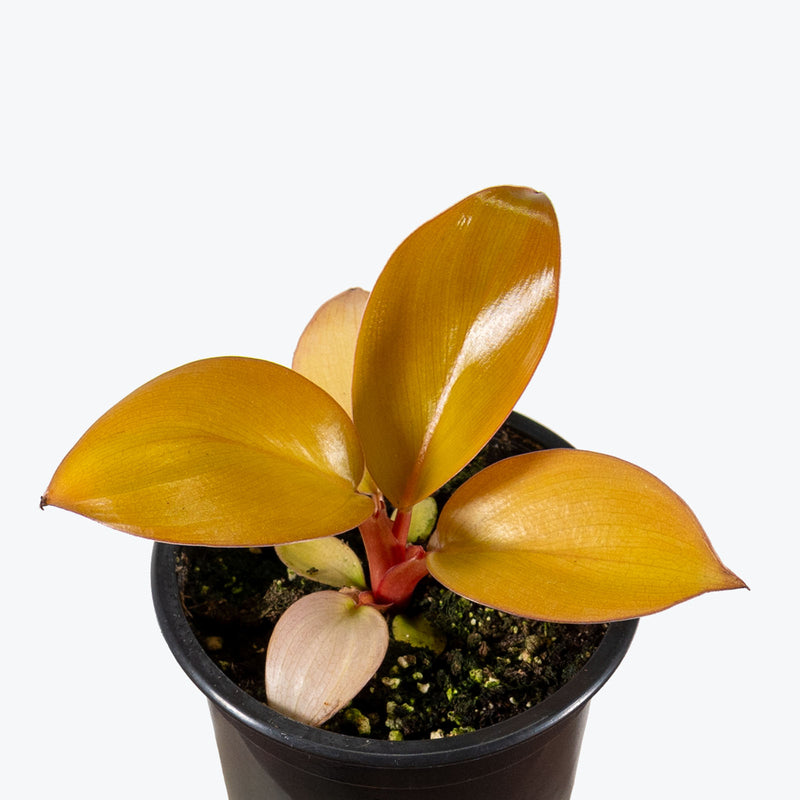
How to care for Philodendron Mars
Philodendron Mars should not be in a position to see the sun directly, although early morning or late evening sun is fine. Filtered sunlight through a sheer curtain is best and most homes are comprised primarily of indirect sunlight. The best spot for them is where they do not see the sun during the majority of the day but still get bright, indirect light.
Philodendron Mars will thrive in bright light, but also can tolerate medium light. A good medium-light place in your home would be in the middle of a room that has a regular size window. They can be placed anywhere between the middle of the room and the window. Remember that plants will grow based on how much light they receive.
Philodendron Mars needs to be watered when the top half of the soil is dry to the touch. That usually takes about 1 week in an average home environment. It will vary depending on the time of year, your environment and lighting conditions, but it's always safer to underwater or give the soil a check before you water again. Expect to water more often in brighter light and less often in lower light.
Philodendron Mars will do well in average humidity environments but will appreciate a little bit of humidity if provided, give them a mist daily or get a humidifier.
Feed Philodendron Mars with a balanced liquid fertilizer every 4–6 weeks during the growing season (spring through early fall). Wipe the leaves regularly to remove dust and help them photosynthesize efficiently. Rotate the plant occasionally to ensure even growth on all sides.
Philodendron Mars is moderately toxic and can cause some adverse reactions when ingested so it is best to not let your pets eat it, which we advise for all plants in general. The severity of the reaction will depend on how much of the plant is ingested but, if you know your pet typically does not eat your plants, this plant will be suitable for your home..
Learn MoreView PlantPhilodendron Mayoi
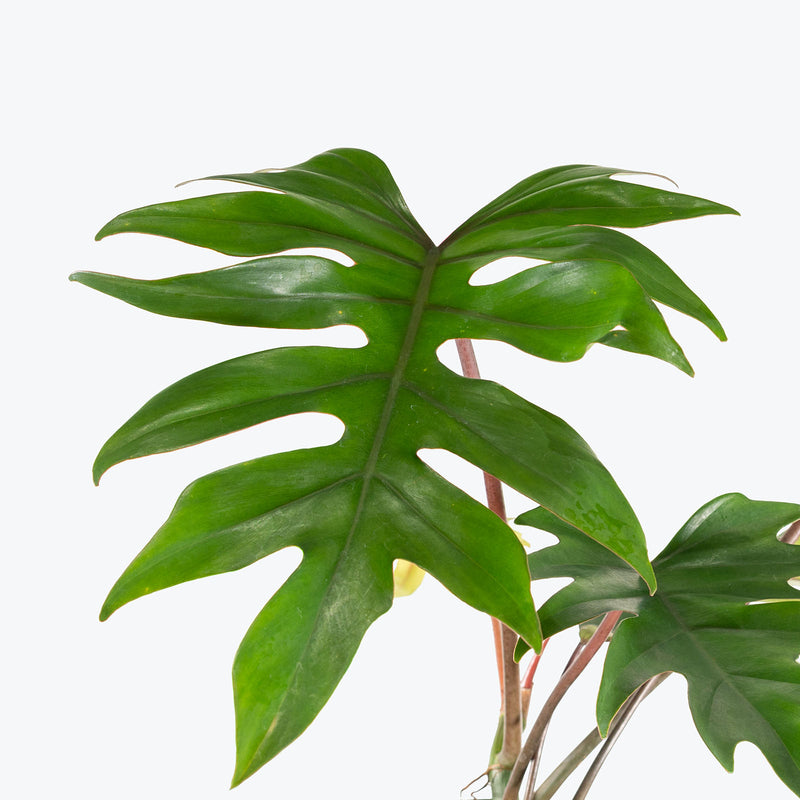
How to care for Philodendron Mayoi
Philodendron Mayoi should not be in a position to see the sun directly, although early morning or late evening sun is fine. Filtered sunlight through a sheer curtain is best and most homes are comprised primarily of indirect sunlight. The best spot for them is where they do not see the sun during the majority of the day but still get bright, indirect light.
Philodendron Mayoi will do well in medium light but will grow faster with brighter light. A good medium-light place in your home would be in the middle of a room that has a regular size window. Remember that plants will grow based on how much light they receive.
Allow the top quarter of the soil to dry before watering again. This usually takes about 3 - 4 days in an average home environment. It will vary depending on the time of year, your environment and lighting conditions. Expect to water Philodendron Mayoi more often in brighter light and less often in lower light.
Philodendron Mayoi will do well in average humidity environments but will appreciate a little bit of humidity if provided, give them a mist daily or get a humidifier.
Ensure that your Philodendron Mayoi is planted in well-draining soil to prevent water-logging. This plant enjoys warmth and will appreciate being kept away from cold drafts. It will also benefit from regular feeding during the growing season.
Philodendron Mayoi is moderately toxic and can cause some adverse reactions when ingested so it is best to not let your pets eat it, which we advise for all plants in general. The severity of the reaction will depend on how much of the plant is ingested but, if you know your pet typically does not eat your plants, this plant will be suitable for your home..
Learn MoreView PlantPhilodendron McDowell
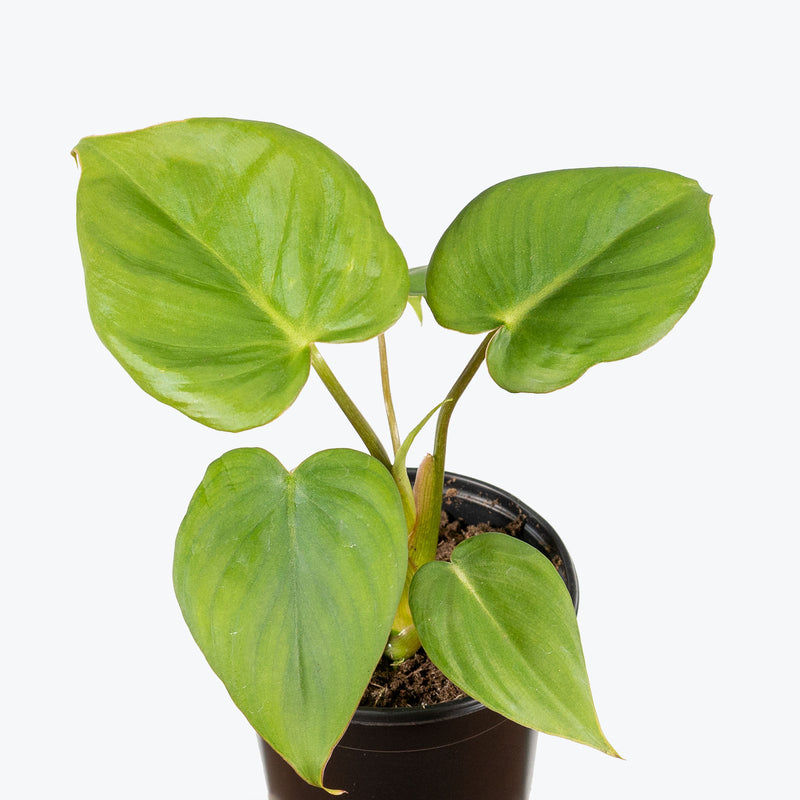
How to care for Philodendron McDowell
They should not be in a position to see the sun directly, although early morning or late evening sun is fine. Filtered sunlight through a sheer curtain is best and most homes are comprised primarily of indirect sunlight. The best spot for them is where they do not see the sun during the majority of the day but still get bright, indirect light.
They will do best in bright light. A nice bright place inside your home would be on the window sill or a stool that is right next to a window, either with or without blinds, depending on if the plant can handle sun. Remember that plants will grow based on how much light they receive.
They need to be watered when the top half of the soil is dry to the touch. That usually takes about 1 week in an average home environment. It will vary depending on the time of year, your environment and lighting conditions, but it's always safer to underwater or give the soil a check before you water again. Expect to water more often in brighter light and less often in lower light.
They will do well in average humidity environments but will appreciate a little bit of humidity if provided, give them a mist daily or get a humidifier.
The plant’s colour intensity, as well as its shape, is highly dependent on the amount of light it is given. In the case of the Philodendron McDowell, providing bright, filtered or dappled sunlight allows it to carry out all its essential functions without burning its leaves or dehydrating the plant. Another growth determinant for the Philodendron McDowell plant is humidity. Moderate humidity allows the plant to stay hydrated with the help of a humidifier. To avoid fungal issues on the foliage, water slowly, near the base of the plant, close to the soil level so as to not wet the foliage. Using room-temperature distilled water, natural rainwater, or tap water, you’ve let sit out for at least 24 hours to allow any chlorine to evaporate, is best.
This plant is moderately toxic and can cause some adverse reactions when ingested so it is best to not let your pets eat it, which we advise for all plants in general. The severity of the reaction will depend on how much of the plant is ingested but, if you know your pet typically does not eat your plants, this plant will be suitable for your home..
Learn MoreView PlantPhilodendron Melanochrysum

How to care for Philodendron Melanochrysum
They should not be in a position to see the sun directly, although early morning or late evening sun is fine. Filtered sunlight through a sheer curtain is best and most homes are comprised primarily of indirect sunlight. The best spot for them is where they do not see the sun during the majority of the day but still get bright, indirect light.
They will do well in medium light but will grow faster with brighter light. A good medium-light place in your home would be in the middle of a room that has a regular size window. Remember that plants will grow based on how much light they receive.
Allow the top quarter of the soil to dry before watering again. This usually takes about 3 - 4 days in an average home environment. It will vary depending on the time of year, your environment and lighting conditions. Expect to water more often in brighter light and less often in lower light.
They will do well in average humidity environments but will appreciate a little bit of humidity if provided, give them a mist daily or get a humidifier.
Allow the soil to mostly dry out between watering during the winter seasons. This tropical houseplant loves warm temperatures and has no cold hardiness. As the plant grows, it will most likely need a bamboo stake or moss pole to grow up, as it loves to grow up a stable structure.
This plant is moderately toxic and can cause some adverse reactions when ingested so it is best to not let your pets eat it, which we advise for all plants in general. The severity of the reaction will depend on how much of the plant is ingested but, if you know your pet typically does not eat your plants, this plant will be suitable for your home..
Learn MoreView PlantPhilodendron Melinonii Ghost

How to care for Philodendron Melinonii Ghost
Philodendron Melinonii Ghost should not be in a position to see the sun directly, although early morning or late evening sun is fine. Filtered sunlight through a sheer curtain is best and most homes are comprised primarily of indirect sunlight. The best spot for them is where they do not see the sun during the majority of the day but still get bright, indirect light.
Philodendron Melinonii Ghost will do well in medium light but will grow faster with brighter light. A good medium-light place in your home would be in the middle of a room that has a regular size window. Remember that plants will grow based on how much light they receive.
Philodendron Melinonii Ghost likes the soil to be relatively dry before the next watering. That usually takes about 2 weeks in an average home environment. It will vary depending on the time of year, your environment and lighting conditions, but for them, it's always safer to underwater or water when you see signs of lack of water (i.e. droopy, floppy, or soft leaves). Expect to water more often in brighter light and less often in lower light.
Philodendron Melinonii Ghost can live in any average home humidity condition and are fairly hardy.
Philodendron Melinonii Ghost prefers stable, warm conditions and consistent care. Use a chunky, well-draining potting mix (such as aroid mix) and avoid soggy roots. Its thick leaves don’t need high humidity but will benefit from occasional misting or a nearby humidifier. Clean the foliage regularly to maintain its shine and prevent dust buildup. This variety doesn’t require a moss pole or support, making it great for open floor spaces or pedestal planters. Feed monthly during the growing season to support healthy growth and maintain vibrant contrast between old and new leaves.
Philodendron Melinonii Ghost is moderately toxic and can cause some adverse reactions when ingested so it is best to not let your pets eat it, which we advise for all plants in general. The severity of the reaction will depend on how much of the plant is ingested but, if you know your pet typically does not eat your plants, this plant will be suitable for your home..
Learn MoreView PlantPhilodendron Melinonii Gold
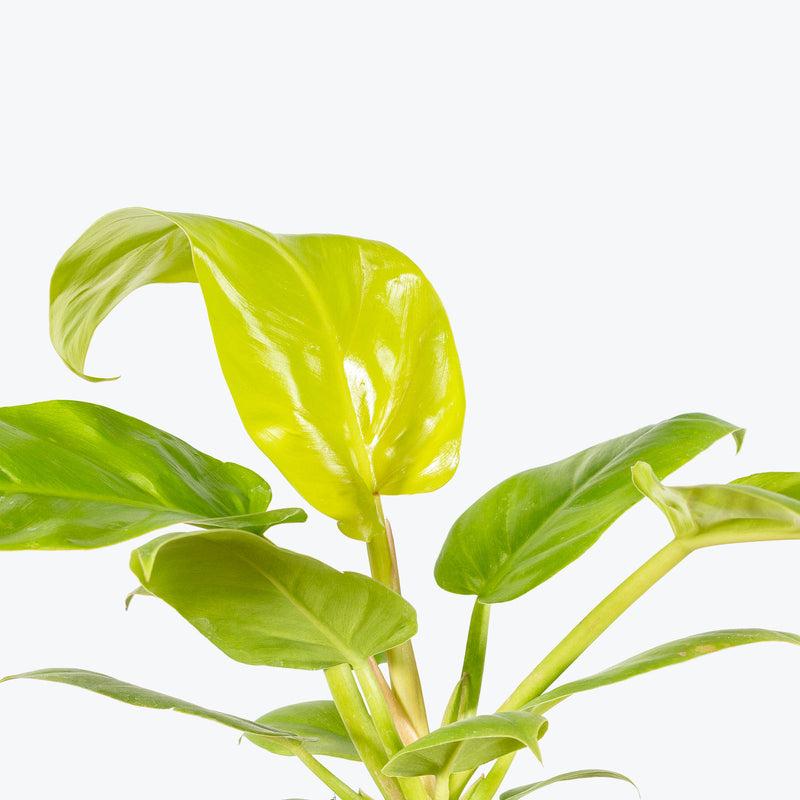
How to care for Philodendron Melinonii Gold
Philodendron Melinonii Gold should not be in a position to see the sun directly, although early morning or late evening sun is fine. Filtered sunlight through a sheer curtain is best and most homes are comprised primarily of indirect sunlight. The best spot for them is where they do not see the sun during the majority of the day but still get bright, indirect light.
Philodendron Melinonii Gold will do well in medium light but will grow faster with brighter light. A good medium-light place in your home would be in the middle of a room that has a regular size window. Remember that plants will grow based on how much light they receive.
Philodendron Melinonii Gold likes the soil to be relatively dry before the next watering. That usually takes about 2 weeks in an average home environment. It will vary depending on the time of year, your environment and lighting conditions, but for them, it's always safer to underwater or water when you see signs of lack of water (i.e. droopy, floppy, or soft leaves). Expect to water more often in brighter light and less often in lower light.
Philodendron Melinonii Gold can live in any average home humidity condition and are fairly hardy.
Philodendron Melinonii Gold thrives in bright, filtered light, which helps maintain its bold colouring. Use a chunky, well-draining soil mix and avoid letting the roots sit in soggy soil. Though it doesn’t require support, rotating the plant occasionally will help it grow evenly. Wipe down the broad, waxy leaves to keep them dust-free and shiny. Feed monthly during spring and summer with a balanced fertilizer to encourage full, vibrant growth. This plant is particularly resilient and adaptable, making it an excellent choice for low-maintenance plant lovers.
Philodendron Melinonii Gold is moderately toxic and can cause some adverse reactions when ingested so it is best to not let your pets eat it, which we advise for all plants in general. The severity of the reaction will depend on how much of the plant is ingested but, if you know your pet typically does not eat your plants, this plant will be suitable for your home..
Learn MoreView PlantPhilodendron Micans
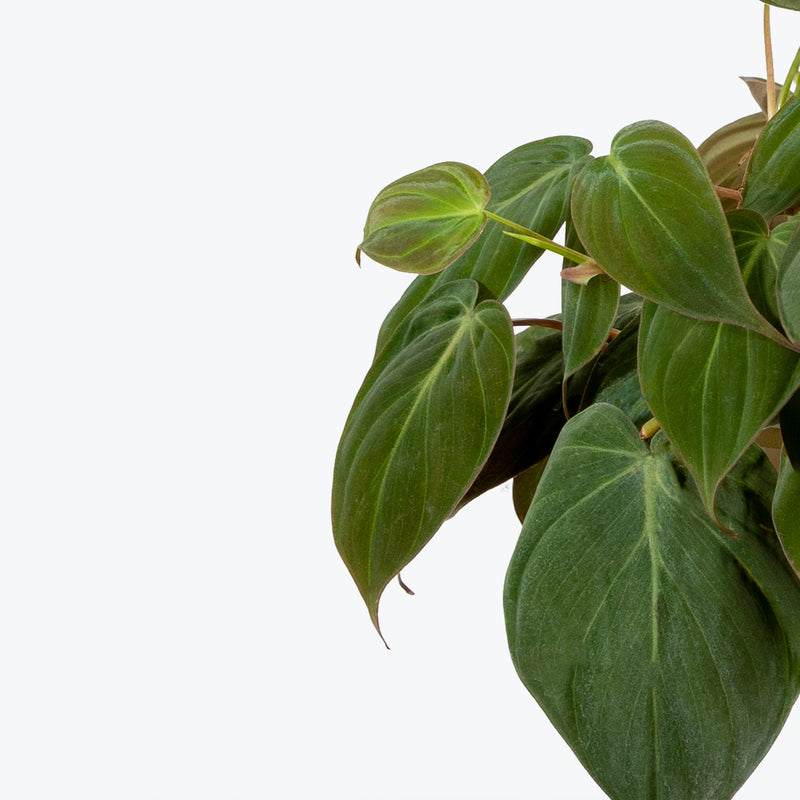
How to care for Philodendron Micans
Philodendron Micans should not be in a position to see the sun directly, although early morning or late evening sun is fine. Filtered sunlight through a sheer curtain is best and most homes are comprised primarily of indirect sunlight. The best spot for them is where they do not see the sun during the majority of the day but still get bright, indirect light.
Philodendron Micans will thrive in medium to bright light, but also can tolerate low light. A good medium-light place in your home would be in the middle of a room that has a regular size window. They can be placed almost anywhere in the room but remember, plants will grow based on how much light they receive.
Philodendron Micans likes the soil to be relatively dry before the next watering. That usually takes about 2 weeks in an average home environment. It will vary depending on the time of year, your environment and lighting conditions, but for them, it's always safer to underwater or water when you see signs of lack of water (i.e. droopy, floppy, or soft leaves). Expect to water more often in brighter light and less often in lower light.
Philodendron Micans will do well in average humidity environments but will appreciate a little bit of humidity if provided, give them a mist daily or get a humidifier.
Soft, yellow leaves may indicate overwatering, while crispy, brown leaves usually mean the Philodendron Micans need more water. If you wish to propagate, take stem cuttings during the warmer months and place the stem in water or moist soil, making sure to keep at least one node - point of attachment of a leaf - submerged, from which the roots will grow, and they should root quite easily.
Philodendron Micans is moderately toxic and can cause some adverse reactions when ingested so it is best to not let your pets eat it, which we advise for all plants in general. The severity of the reaction will depend on how much of the plant is ingested but, if you know your pet typically does not eat your plants, this plant will be suitable for your home..
Learn MoreView PlantPhilodendron Moonlight
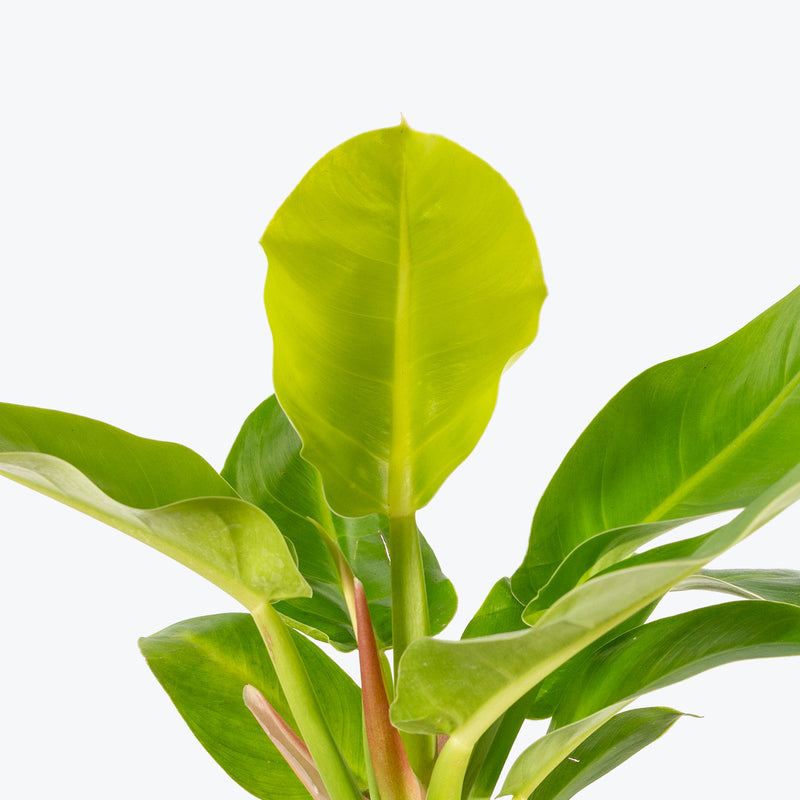
How to care for Philodendron Moonlight
They should not be in a position to the see the sun directly, as it is too intense for them. Filtered sunlight through a sheer curtain is fine and most homes are comprised primarily of indirect sunlight. The best spot for them is where they do not see the sun during the majority of the day but still get bright, indirect light.
They will do well in medium light but will grow faster with brighter light. A good medium-light place in your home would be in the middle of a room that has a regular size window. Remember that plants will grow based on how much light they receive.
They need to be watered when the top half of soil is dry to the touch. That usually takes about 1 week in an average home environment. It may vary depending on the time of year, your environment and lighting conditions, but it's always safer to underwater or give the soil a check before you water again.
They will do well in average humidity environments but will appreciate a little bit of humidity if provided, give them a mist every few days or get a humidifier.
If your plant begins to get too leggy, prune the stretched out growth and root those cuttings in water, ensuring there is a node (section of stem where a removed leaf or branch meets the stem) in the water, from which the roots will form. Make sure to move your plant somewhere where it will receive brighter light to avoid the same thing happening again. In the future, once the cutting has rooted, pot that cutting back into the original plant to make it more full.
This plant is moderately toxic and can cause some adverse reactions when ingested so it is best to not let your pets eat it, which we advise for all plants in general. The severity of the reaction will depend on how much of the plant is ingested but, if you know your pet typically does not eat your plants, this plant will be suitable for your home..
Learn MoreView PlantPhilodendron Narrow
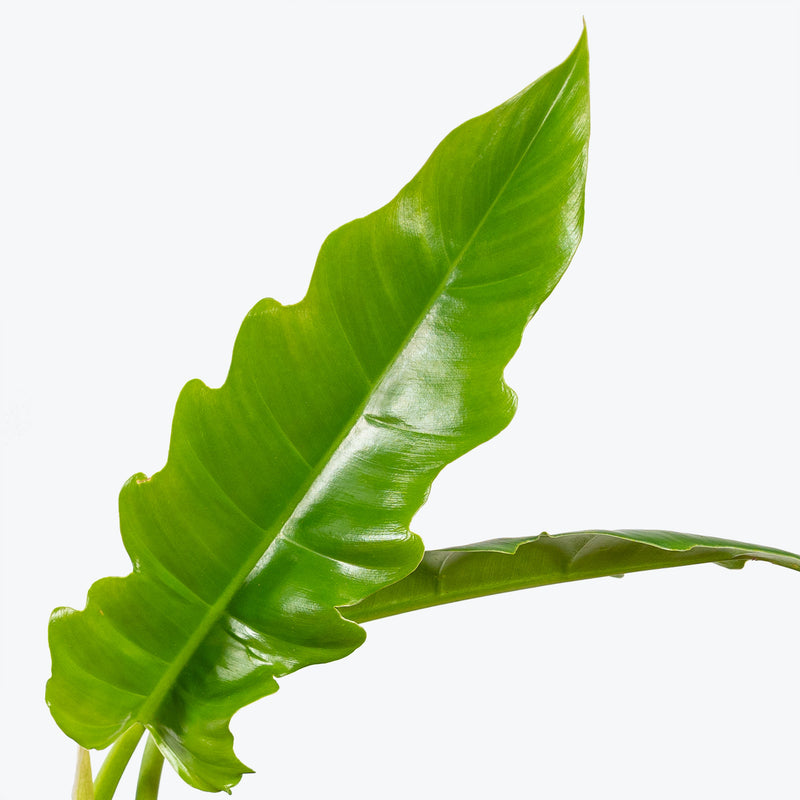
How to care for Philodendron Narrow
Philodendron Narrow should not be in a position to see the sun directly, although early morning or late evening sun is fine. Filtered sunlight through a sheer curtain is best and most homes are comprised primarily of indirect sunlight. The best spot for them is where they do not see the sun during the majority of the day but still get bright, indirect light.
Philodendron Narrow will do well in medium light but will grow faster with brighter light. A good medium-light place in your home would be in the middle of a room that has a regular size window. Remember that plants will grow based on how much light they receive.
Philodendron Narrow needs to be watered when the top half of the soil is dry to the touch. That usually takes about 1 week in an average home environment. It will vary depending on the time of year, your environment and lighting conditions, but it's always safer to underwater or give the soil a check before you water again. Expect to water more often in brighter light and less often in lower light.
Philodendron Narrow can live in any average home humidity condition and are fairly hardy.
The big, waxy leaves are excellent dust traps so make sure to wipe off Philodendron Narrow's leaves every so often to increase photosynthesis! Remember to ease up on watering a little more during the cooler, darker days of the winter months. Regular pruning of old or yellowed leaves can encourage new growth and maintain the plant's aesthetic appeal.
Philodendron Narrow is moderately toxic and can cause some adverse reactions when ingested so it is best to not let your pets eat it, which we advise for all plants in general. The severity of the reaction will depend on how much of the plant is ingested but, if you know your pet typically does not eat your plants, this plant will be suitable for your home..
Learn MoreView PlantPhilodendron Neon Selloum
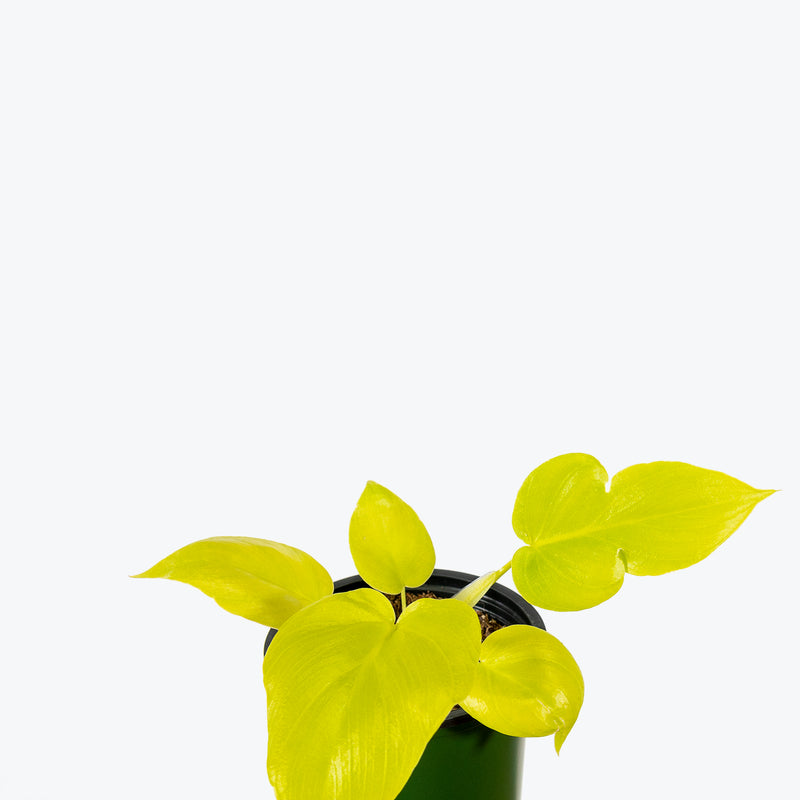
How to care for Philodendron Neon Selloum
They should not be in a position to see the sun directly, although early morning or late evening sun is fine. Filtered sunlight through a sheer curtain is best and most homes are comprised primarily of indirect sunlight. The best spot for them is where they do not see the sun during the majority of the day but still get bright, indirect light.
They will thrive in bright light, but also can tolerate medium light. A good medium-light place in your home would be in the middle of a room that has a regular size window. They can be placed anywhere between the middle of the room and the window. Remember that plants will grow based on how much light they receive.
They need to be watered when the top half of the soil is dry to the touch. That usually takes about 1 week in an average home environment. It will vary depending on the time of year, your environment and lighting conditions, but it's always safer to underwater or give the soil a check before you water again. Expect to water more often in brighter light and less often in lower light.
They will do well in average humidity environments but will appreciate a little bit of humidity if provided, give them a mist daily or get a humidifier.
This Philodendron is very easy, perfect for beginners! Rotate your plant every week or so to encourage even, consistent, and healthy growth. Allow the soil to dry out more between waterings during the winter seasons.
This plant is moderately toxic and can cause some adverse reactions when ingested so it is best to not let your pets eat it, which we advise for all plants in general. The severity of the reaction will depend on how much of the plant is ingested but, if you know your pet typically does not eat your plants, this plant will be suitable for your home..
Learn MoreView PlantPhilodendron Orange Princess
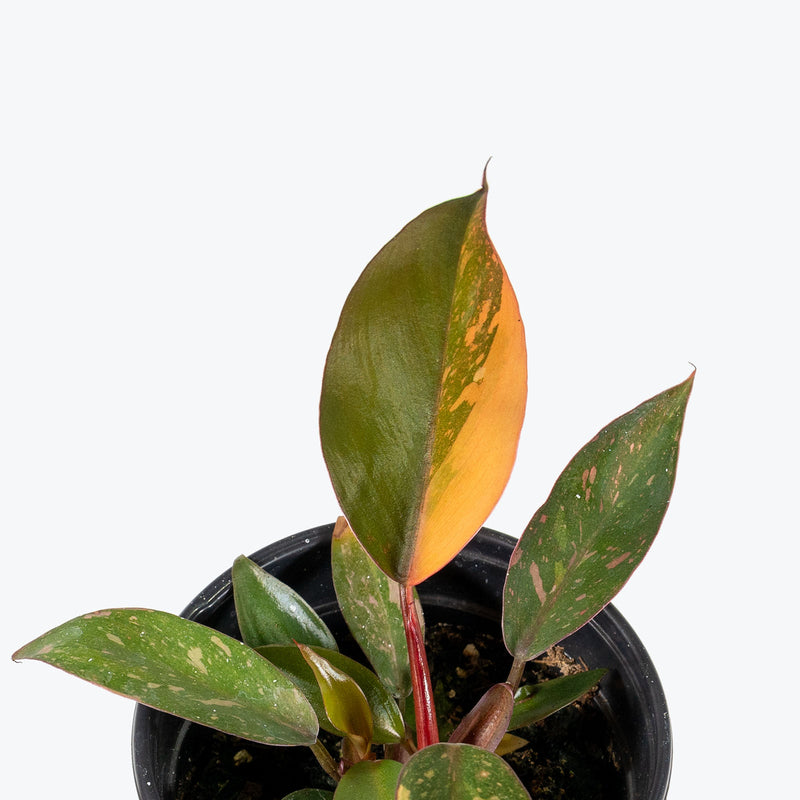
How to care for Philodendron Orange Princess
Philodendron Orange Princess should not be in a position to see the sun directly, although early morning or late evening sun is fine. Filtered sunlight through a sheer curtain is best and most homes are comprised primarily of indirect sunlight. The best spot for them is where they do not see the sun during the majority of the day but still get bright, indirect light.
Philodendron Orange Princess will thrive in bright light, but also can tolerate medium light. A good medium-light place in your home would be in the middle of a room that has a regular size window. They can be placed anywhere between the middle of the room and the window. Remember that plants will grow based on how much light they receive.
Philodendron Orange Princess needs to be watered when the top half of the soil is dry to the touch. That usually takes about 1 week in an average home environment. It will vary depending on the time of year, your environment and lighting conditions, but it's always safer to underwater or give the soil a check before you water again. Expect to water more often in brighter light and less often in lower light.
Philodendron Orange Princess likes a high humidity environment, give them a mist daily or as often as possible. Alternatively, you can put them around a humidifier. Although they won't die if they don't receive enough humidity, their leaves may have some dry, crunchy, or yellow edges.
Philodendron Orange Princess can tolerate a few hours of direct sunlight occasionally, but be careful not to scorch the leaves. The yellow and orange variegation will develop brown spots if gets too much sun. Fertilize monthly during the growing season (spring through summer) with a balanced liquid fertilizer diluted to half strength. Support the plant with a stake or trellis if desired to encourage vertical growth. Regular pruning helps maintain the plant's shape and promotes fuller growth.
Philodendron Orange Princess is moderately toxic and can cause some adverse reactions when ingested so it is best to not let your pets eat it, which we advise for all plants in general. The severity of the reaction will depend on how much of the plant is ingested but, if you know your pet typically does not eat your plants, this plant will be suitable for your home..
Learn MoreView PlantPhilodendron Painted Lady
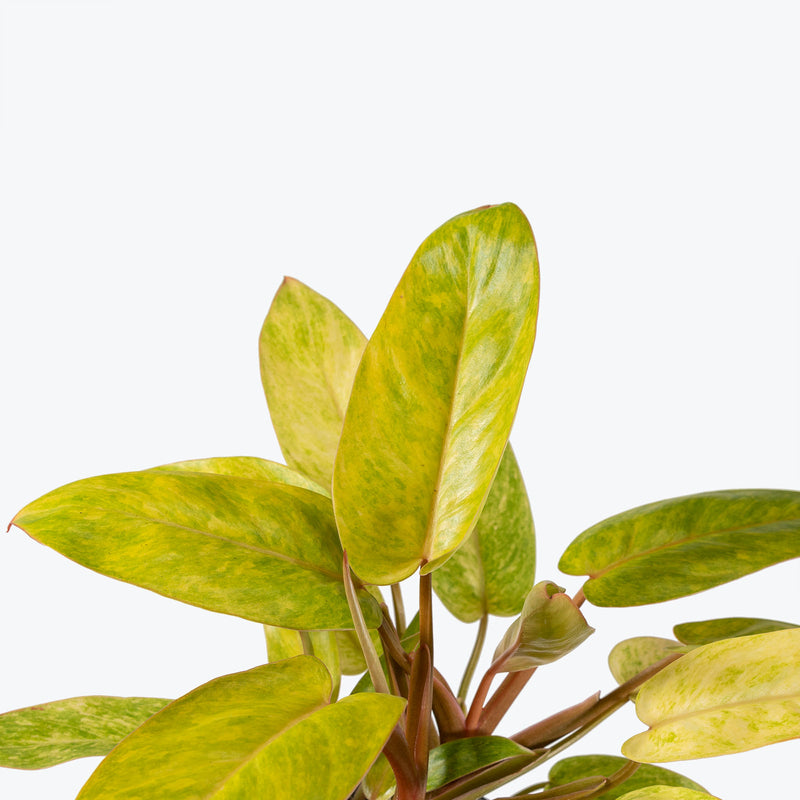
How to care for Philodendron Painted Lady
They should not be in a position to see the sun directly, although early morning or late evening sun is fine. Filtered sunlight through a sheer curtain is best and most homes are comprised primarily of indirect sunlight. The best spot for them is where they do not see the sun during the majority of the day but still get bright, indirect light.
They will thrive in bright light, but also can tolerate medium light. A good medium-light place in your home would be in the middle of a room that has a regular size window. They can be placed anywhere between the middle of the room and the window. Remember that plants will grow based on how much light they receive.
They like the soil to be relatively dry before the next watering. That usually takes about 2 weeks in an average home environment. It will vary depending on the time of year, your environment and lighting conditions, but for them, it's always safer to underwater or water when you see signs of lack of water (i.e. droopy, floppy, or soft leaves). Expect to water more often in brighter light and less often in lower light.
They will do well in average humidity environments but will appreciate a little bit of humidity if provided, give them a mist daily or get a humidifier.
Try to avoid letting standing water pool on the leaves for very long periods of time after misting. If the plant is indeed grown on a support pole, it can produce leaves up to 6 inches or longer! As for watering, try to keep the soil a little more moist during the warmer months and then a little on the drier side during the cooler months.
This plant is moderately toxic and can cause some adverse reactions when ingested so it is best to not let your pets eat it, which we advise for all plants in general. The severity of the reaction will depend on how much of the plant is ingested but, if you know your pet typically does not eat your plants, this plant will be suitable for your home..
Learn MoreView PlantPhilodendron Panduriforme
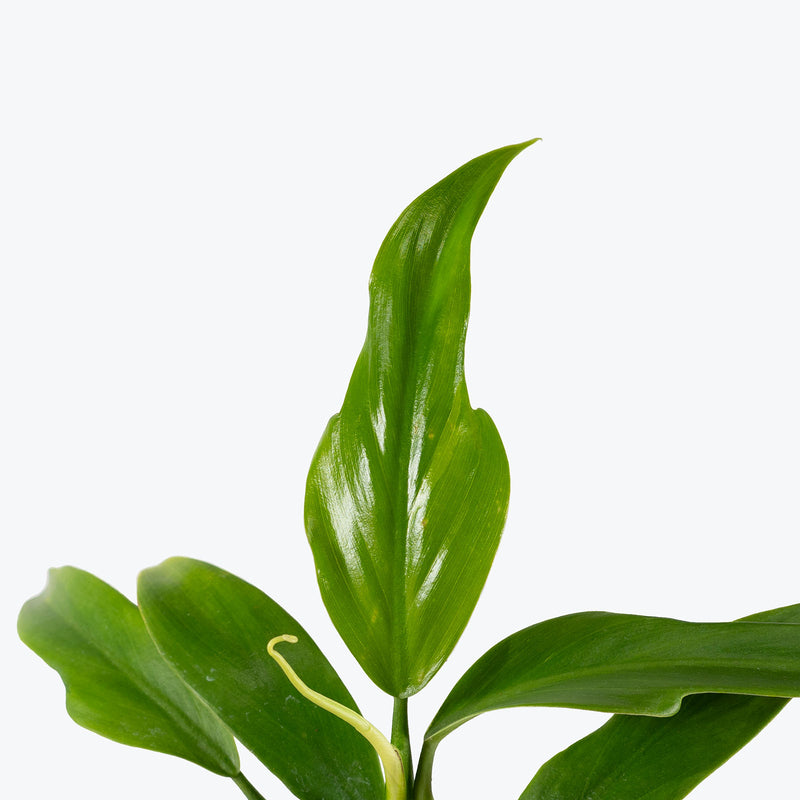
How to care for Philodendron Panduriforme
Philodendron Panduriforme should not be in a position to see the sun directly, although early morning or late evening sun is fine. Filtered sunlight through a sheer curtain is best and most homes are comprised primarily of indirect sunlight. The best spot for them is where they do not see the sun during the majority of the day but still get bright, indirect light.
Philodendron Panduriforme will thrive in bright light, but also can tolerate medium light. A good medium-light place in your home would be in the middle of a room that has a regular size window. They can be placed anywhere between the middle of the room and the window. Remember that plants will grow based on how much light they receive.
Allow the top quarter of the soil to dry before watering Philodendron Panduriforme again. This usually takes about 3 - 4 days in an average home environment. It will vary depending on the time of year, your environment and lighting conditions. Expect to water more often in brighter light and less often in lower light.
Philodendron Panduriforme will do well in average humidity environments but will appreciate a little bit of humidity if provided, give them a mist daily or get a humidifier.
Philodendron Panduriforme prefers a stable environment with consistent temperatures. Avoid placing the plant near radiators, air conditioners, or drafts. Repotting is usually required every couple of years as the plant grows.
Philodendron Panduriforme is moderately toxic and can cause some adverse reactions when ingested so it is best to not let your pets eat it, which we advise for all plants in general. The severity of the reaction will depend on how much of the plant is ingested but, if you know your pet typically does not eat your plants, this plant will be suitable for your home..
Learn MoreView PlantPhilodendron Paraiso Verde
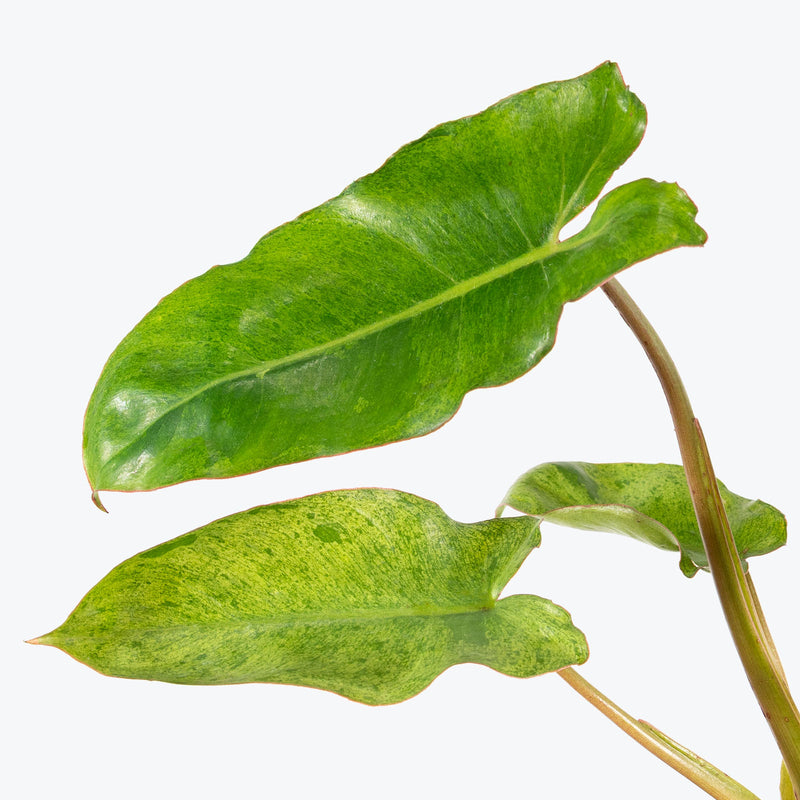
How to care for Philodendron Paraiso Verde
Philodendron Paraiso Verde should not be in a position to see the sun directly, although early morning or late evening sun is fine. Filtered sunlight through a sheer curtain is best and most homes are comprised primarily of indirect sunlight. The best spot for them is where they do not see the sun during the majority of the day but still get bright, indirect light.
Philodendron Paraiso Verde will thrive in bright light, but also can tolerate medium light. A good medium-light place in your home would be in the middle of a room that has a regular size window. They can be placed anywhere between the middle of the room and the window. Remember that plants will grow based on how much light they receive.
Allow the top quarter of the soil to dry before watering again. This usually takes about 3 - 4 days in an average home environment. It will vary depending on the time of year, your environment and lighting conditions. Expect to water Philodendron Paraiso Verde more often in brighter light and less often in lower light.
Philodendron Paraiso Verde will do well in average humidity environments but will appreciate a little bit of humidity if provided, give them a mist daily or get a humidifier.
Ensure your Philodendron Paraiso Verde is planted in well-draining soil to avoid waterlogged conditions. Providing support, like a moss pole, can encourage its natural climbing habit and promote larger leaf growth.
Philodendron Paraiso Verde is moderately toxic and can cause some adverse reactions when ingested so it is best to not let your pets eat it, which we advise for all plants in general. The severity of the reaction will depend on how much of the plant is ingested but, if you know your pet typically does not eat your plants, this plant will be suitable for your home..
Learn MoreView PlantPhilodendron Peltatum

How to care for Philodendron Peltatum
Philodendron Peltatum should not be in a position to see the sun directly, although early morning or late evening sun is fine. Filtered sunlight through a sheer curtain is best and most homes are comprised primarily of indirect sunlight. The best spot for them is where they do not see the sun during the majority of the day but still get bright, indirect light.
Philodendron Peltatum will thrive in bright light, but also can tolerate medium light. A good medium-light place in your home would be in the middle of a room that has a regular size window. They can be placed anywhere between the middle of the room and the window. Remember that plants will grow based on how much light they receive.
Philodendron Peltatum needs to be watered when the top half of the soil is dry to the touch. That usually takes about 1 week in an average home environment. It will vary depending on the time of year, your environment and lighting conditions, but it's always safer to underwater or give the soil a check before you water again. Expect to water more often in brighter light and less often in lower light.
Philodendron Peltatum will do well in average humidity environments but will appreciate a little bit of humidity if provided, give them a mist daily or get a humidifier.
Support mature Philodendron Peltatum with a moss pole or board to encourage leaf size and structure. Use a chunky, well-draining mix to promote strong root growth—peat, orchid bark, and perlite work well. Fertilize monthly during the growing season with a balanced liquid fertilizer. The subtle sheen and textured surface really shine in good lighting, so don’t skimp on brightness. Wipe leaves occasionally to maintain that velvety glow.
Philodendron Peltatum is moderately toxic and can cause some adverse reactions when ingested so it is best to not let your pets eat it, which we advise for all plants in general. The severity of the reaction will depend on how much of the plant is ingested but, if you know your pet typically does not eat your plants, this plant will be suitable for your home..
Learn MoreView PlantPhilodendron Pink Princess
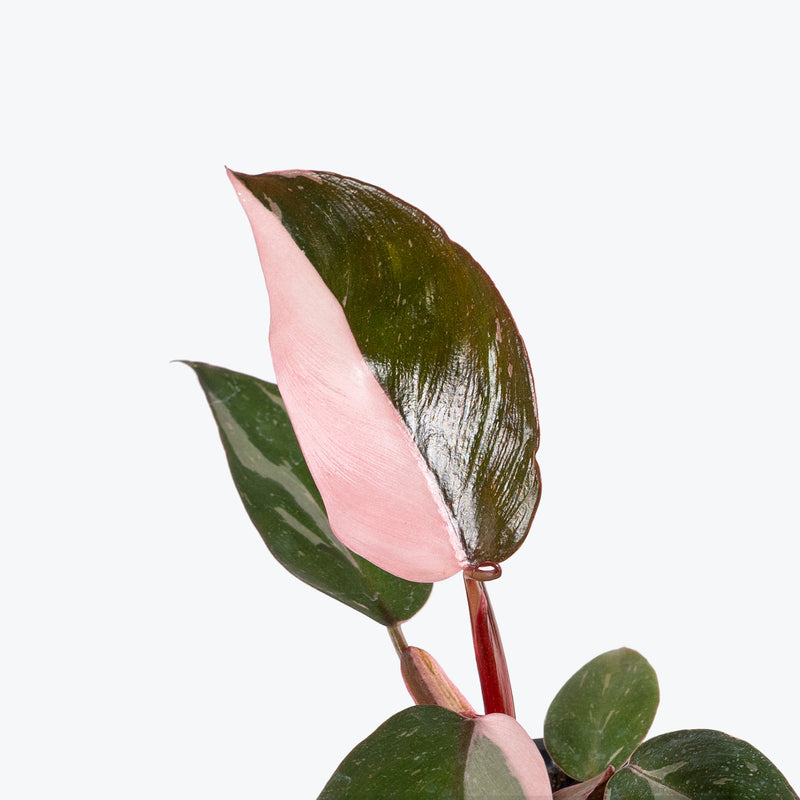
How to care for Philodendron Pink Princess
Philodendron Pink Princess should not be in a position to see the sun directly, although early morning or late evening sun is fine. Filtered sunlight through a sheer curtain is best and most homes are comprised primarily of indirect sunlight. The best spot for them is where they do not see the sun during the majority of the day but still get bright, indirect light.
Philodendron Pink Princess will thrive in bright light, but also can tolerate medium light. A good medium-light place in your home would be in the middle of a room that has a regular size window. They can be placed anywhere between the middle of the room and the window. Remember that plants will grow based on how much light they receive.
Philodendron Pink Princess needs to be watered when the top half of the soil is dry to the touch. That usually takes about 1 week in an average home environment. It will vary depending on the time of year, your environment and lighting conditions, but it's always safer to underwater or give the soil a check before you water again. Expect to water more often in brighter light and less often in lower light.
Philodendron Pink Princess likes a high humidity environment, give them a mist daily or as often as possible. Alternatively, you can put them around a humidifier. Although they won't die if they don't receive enough humidity, their leaves may have some dry, crunchy, or yellow edges.
Philodendron Pink Princess can survive in low light conditions, but grows faster and produces more variegation in its leaves in medium or bright indirect light. If the leaves are pale in colour, the plant may be getting too much light. Do not put it in direct sunlight as the sun will burn the foliage.
Philodendron Pink Princess is moderately toxic and can cause some adverse reactions when ingested so it is best to not let your pets eat it, which we advise for all plants in general. The severity of the reaction will depend on how much of the plant is ingested but, if you know your pet typically does not eat your plants, this plant will be suitable for your home..
Learn MoreView PlantPhilodendron Pink Princess Marble Galaxy

How to care for Philodendron Pink Princess Marble Galaxy
Philodendron Pink Princess Marble Galaxy should not be in a position to see the sun directly, although early morning or late evening sun is fine. Filtered sunlight through a sheer curtain is best and most homes are comprised primarily of indirect sunlight. The best spot for them is where they do not see the sun during the majority of the day but still get bright, indirect light.
Philodendron Pink Princess Marble Galaxy will thrive in bright light, but also can tolerate medium light. A good medium-light place in your home would be in the middle of a room that has a regular size window. They can be placed anywhere between the middle of the room and the window. Remember that plants will grow based on how much light they receive.
Philodendron Pink Princess Marble Galaxy needs to be watered when the top half of the soil is dry to the touch. That usually takes about 1 week in an average home environment. It will vary depending on the time of year, your environment and lighting conditions, but it's always safer to underwater or give the soil a check before you water again. Expect to water more often in brighter light and less often in lower light.
Philodendron Pink Princess Marble Galaxy likes a high humidity environment, give them a mist daily or as often as possible. Alternatively, you can put them around a humidifier. Although they won't die if they don't receive enough humidity, their leaves may have some dry, crunchy, or yellow edges.
Philodendron Pink Princess Marble Galaxy can survive in low light conditions, but grows faster and produces more variegation in its leaves in medium or bright indirect light. If the leaves are pale in colour, the plant may be getting too much light. Do not put it in direct sunlight as the sun will burn the foliage.
Philodendron Pink Princess Marble Galaxy is moderately toxic and can cause some adverse reactions when ingested so it is best to not let your pets eat it, which we advise for all plants in general. The severity of the reaction will depend on how much of the plant is ingested but, if you know your pet typically does not eat your plants, this plant will be suitable for your home..
Learn MoreView PlantPhilodendron Prince of Orange
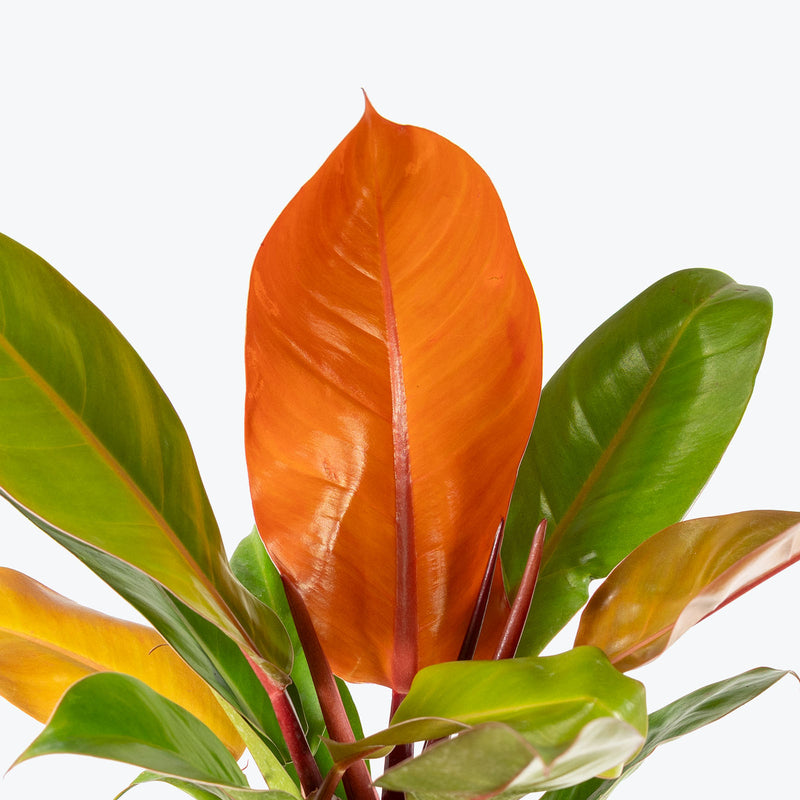
How to care for Philodendron Prince of Orange
Philodendron Prince of Orange should not be in a position to see the sun directly, although early morning or late evening sun is fine. Filtered sunlight through a sheer curtain is best and most homes are comprised primarily of indirect sunlight. The best spot for them is where they do not see the sun during the majority of the day but still get bright, indirect light.
Philodendron Prince of Orange will thrive in bright light, but also can tolerate medium light. A good medium-light place in your home would be in the middle of a room that has a regular size window. They can be placed anywhere between the middle of the room and the window. Remember that plants will grow based on how much light they receive.
Philodendron Prince of Orange likes the soil to be relatively dry before the next watering. That usually takes about 2 weeks in an average home environment. It will vary depending on the time of year, your environment and lighting conditions, but for them, it's always safer to underwater or water when you see signs of lack of water (i.e. droopy, floppy, or soft leaves). Expect to water more often in brighter light and less often in lower light.
Philodendron Prince of Orange can live in any average home humidity condition and are fairly hardy.
To get the most out of your Philodendron Prince of Orange’s colour-changing magic, provide consistent bright, indirect light — the more light it gets (without direct sunburn), the more dramatic the leaf transitions. New growth will always emerge in bright orange, so avoid overwatering, which can delay or soften the emergence of new leaves. As a self-heading philodendron, it doesn’t trail, but rotating the plant regularly helps keep its form symmetrical. Wipe the leaves occasionally to remove dust — clean leaves not only look great but also help the plant absorb more light for healthy growth and colour intensity.
Philodendron Prince of Orange is moderately toxic and can cause some adverse reactions when ingested so it is best to not let your pets eat it, which we advise for all plants in general. The severity of the reaction will depend on how much of the plant is ingested but, if you know your pet typically does not eat your plants, this plant will be suitable for your home..
Learn MoreView PlantPhilodendron Quad Colour
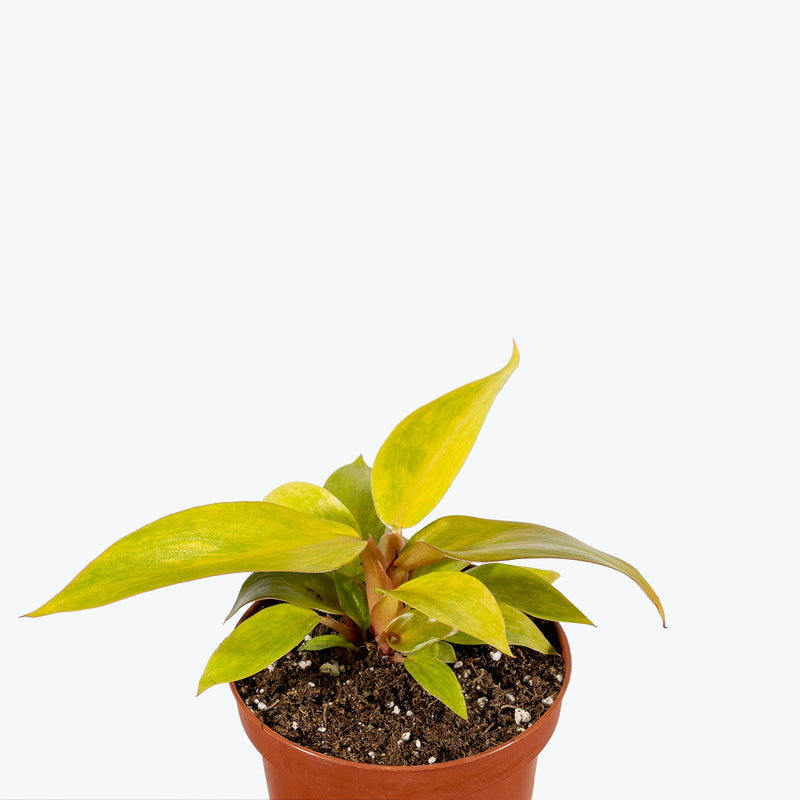
How to care for Philodendron Quad Colour
They should not be in a position to see the sun directly, although early morning or late evening sun is fine. Filtered sunlight through a sheer curtain is best and most homes are comprised primarily of indirect sunlight. The best spot for them is where they do not see the sun during the majority of the day but still get bright, indirect light.
They will thrive in bright light, but also can tolerate medium light. A good medium-light place in your home would be in the middle of a room that has a regular size window. They can be placed anywhere between the middle of the room and the window. Remember that plants will grow based on how much light they receive.
They like the soil to be relatively dry before the next watering. That usually takes about 2 weeks in an average home environment. It will vary depending on the time of year, your environment and lighting conditions, but for them, it's always safer to underwater or water when you see signs of lack of water (i.e. droopy, floppy, or soft leaves). Expect to water more often in brighter light and less often in lower light.
They will do well in average humidity environments but will appreciate a little bit of humidity if provided, give them a mist daily or get a humidifier.
Try to avoid letting standing water pool on the leaves for very long periods of time after misting. If the plant is indeed grown on a support pole, it can produce leaves up to 6 inches or longer! As for watering, try to keep the soil a little more moist during the warmer months and then a little on the drier side during the cooler months.
This plant is moderately toxic and can cause some adverse reactions when ingested so it is best to not let your pets eat it, which we advise for all plants in general. The severity of the reaction will depend on how much of the plant is ingested but, if you know your pet typically does not eat your plants, this plant will be suitable for your home..
Learn MoreView PlantPhilodendron Red Cherry
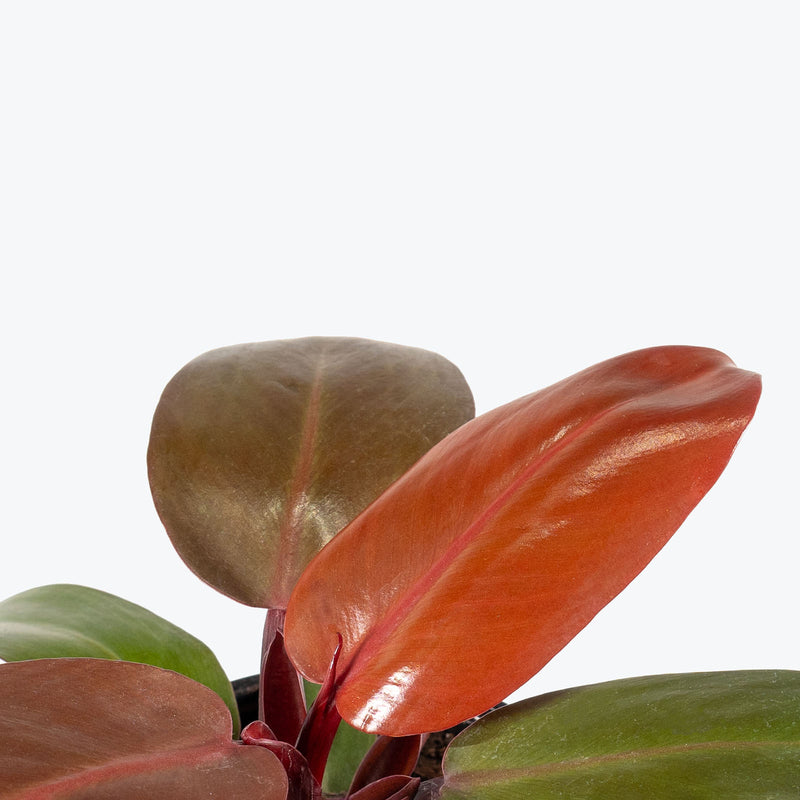
How to care for Philodendron Red Cherry
Philodendron Red Cherry should not be in a position to see the sun directly, although early morning or late evening sun is fine. Filtered sunlight through a sheer curtain is best and most homes are comprised primarily of indirect sunlight. The best spot for them is where they do not see the sun during the majority of the day but still get bright, indirect light.
Philodendron Red Cherry will thrive in bright light, but also can tolerate medium light. A good medium-light place in your home would be in the middle of a room that has a regular size window. They can be placed anywhere between the middle of the room and the window. Remember that plants will grow based on how much light they receive.
Philodendron Red Cherry needs to be watered when the top half of the soil is dry to the touch. That usually takes about 1 week in an average home environment. It will vary depending on the time of year, your environment and lighting conditions, but it's always safer to underwater or give the soil a check before you water again. Expect to water more often in brighter light and less often in lower light.
Philodendron Red Cherry will do well in average humidity environments but will appreciate a little bit of humidity if provided, give them a mist daily or get a humidifier.
Fertilize Philodendron Red Cherry with a balanced, water-soluble fertilizer every 4-6 weeks during the growing season. Reduce fertilization in the winter when the plant's growth naturally slows. Clean the leaves occasionally to remove dust and boost photosynthesis. Pruning is not typically necessary but can be done to maintain shape or size as desired.
Philodendron Red Cherry is moderately toxic and can cause some adverse reactions when ingested so it is best to not let your pets eat it, which we advise for all plants in general. The severity of the reaction will depend on how much of the plant is ingested but, if you know your pet typically does not eat your plants, this plant will be suitable for your home..
Learn MoreView PlantPhilodendron Red Congo Variegated
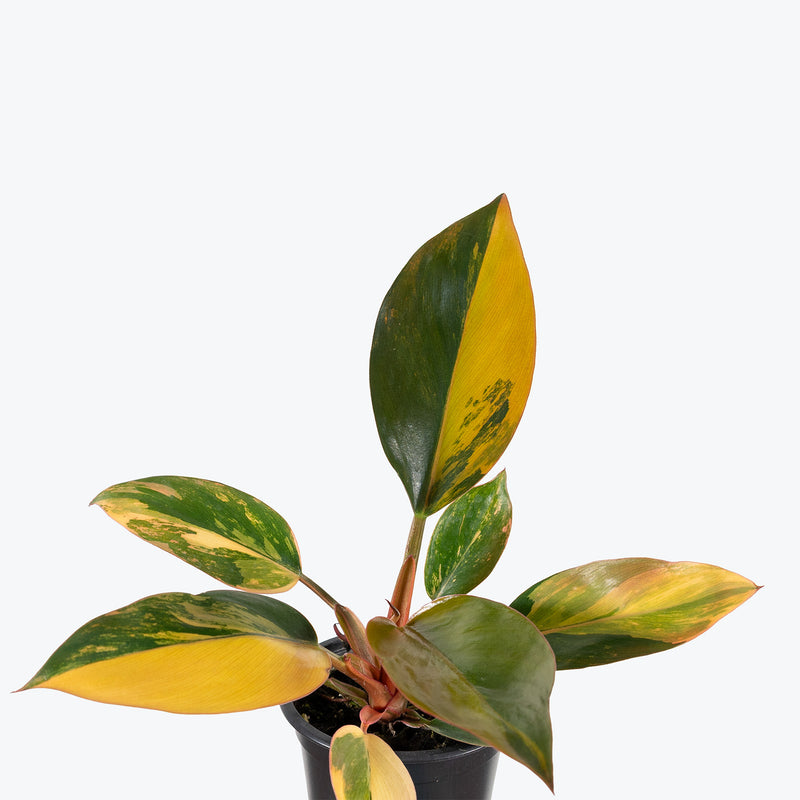
How to care for Philodendron Red Congo Variegated
Philodendron Red Congo Variegated should not be in a position to see the sun directly, although early morning or late evening sun is fine. Filtered sunlight through a sheer curtain is best and most homes are comprised primarily of indirect sunlight. The best spot for them is where they do not see the sun during the majority of the day but still get bright, indirect light.
Philodendron Red Congo Variegated will thrive in bright light, but also can tolerate medium light. A good medium-light place in your home would be in the middle of a room that has a regular size window. They can be placed anywhere between the middle of the room and the window. Remember that plants will grow based on how much light they receive.
Philodendron Red Congo Variegated needs to be watered when the top half of the soil is dry to the touch. That usually takes about 1 week in an average home environment. It will vary depending on the time of year, your environment and lighting conditions, but it's always safer to underwater or give the soil a check before you water again. Expect to water more often in brighter light and less often in lower light.
Philodendron Red Congo Variegated will do well in average humidity environments but will appreciate a little bit of humidity if provided, give them a mist daily or get a humidifier.
Plant in a chunky, well-draining aroid mix for best results. Fertilize monthly in spring and summer with a balanced, diluted fertilizer to enhance leaf size and coloration. Since it’s self-heading, prune older leaves to maintain a tidy, upright form. Rotate Philodendron Red Congo Variegated regularly to encourage even growth.
Philodendron Red Congo Variegated is moderately toxic and can cause some adverse reactions when ingested so it is best to not let your pets eat it, which we advise for all plants in general. The severity of the reaction will depend on how much of the plant is ingested but, if you know your pet typically does not eat your plants, this plant will be suitable for your home..
Learn MoreView PlantPhilodendron Ring of Fire
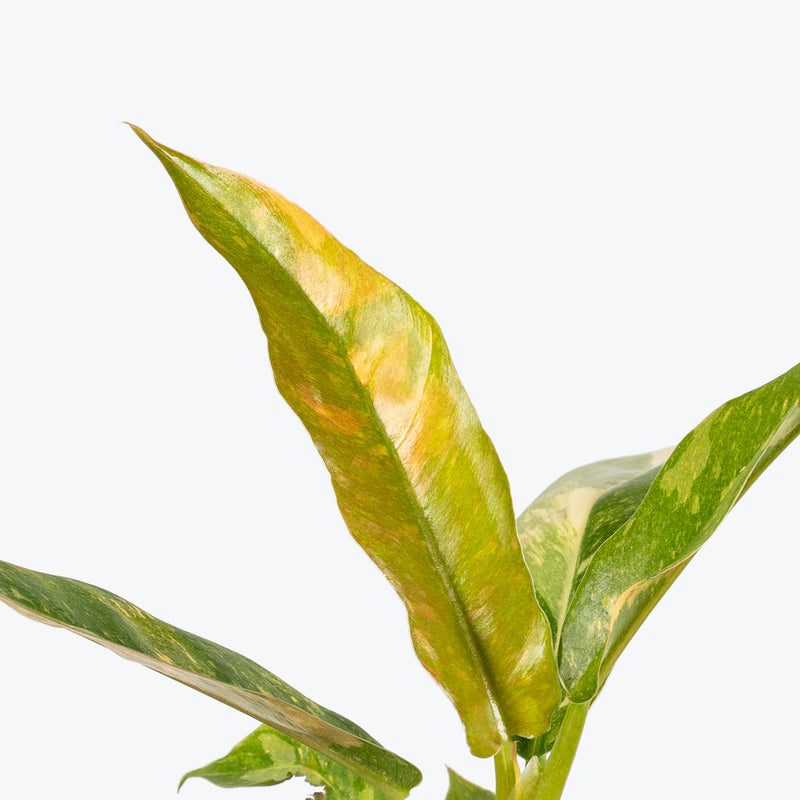
How to care for Philodendron Ring of Fire
Philodendron Ring of Fire should not be in a position to see the sun directly, although early morning or late evening sun is fine. Filtered sunlight through a sheer curtain is best and most homes are comprised primarily of indirect sunlight. The best spot for them is where they do not see the sun during the majority of the day but still get bright, indirect light.
Philodendron Ring of Fire will do well in medium light but will grow faster with brighter light. A good medium-light place in your home would be in the middle of a room that has a regular size window. Remember that plants will grow based on how much light they receive.
Philodendron Ring of Fire needs to be watered when the top half of the soil is dry to the touch. That usually takes about 1 week in an average home environment. It will vary depending on the time of year, your environment and lighting conditions, but it's always safer to underwater or give the soil a check before you water again. Expect to water more often in brighter light and less often in lower light.
Philodendron Ring of Fire will do well in average humidity environments but will appreciate a little bit of humidity if provided, give them a mist daily or get a humidifier.
If you want stronger variegation, consider moving Philodendron Ring of Fire to a location that receives brighter light (but not direct sunlight). Rotate your plant every week or so to encourage even, consistent, and healthy growth. Allow the soil to dry out more between waterings during the winter seasons.
Philodendron Ring of Fire is moderately toxic and can cause some adverse reactions when ingested so it is best to not let your pets eat it, which we advise for all plants in general. The severity of the reaction will depend on how much of the plant is ingested but, if you know your pet typically does not eat your plants, this plant will be suitable for your home..
Learn MoreView PlantPhilodendron Rio

How to care for Philodendron Rio
Philodendron Rio should not be in a position to see the sun directly, although early morning or late evening sun is fine. Filtered sunlight through a sheer curtain is best and most homes are comprised primarily of indirect sunlight. The best spot for them is where they do not see the sun during the majority of the day but still get bright, indirect light.
Philodendron Rio will thrive in bright light, but also can tolerate medium light. A good medium-light place in your home would be in the middle of a room that has a regular size window. They can be placed anywhere between the middle of the room and the window. Remember that plants will grow based on how much light they receive.
Philodendron Rio needs to be watered when the top half of the soil is dry to the touch. That usually takes about 1 week in an average home environment. It will vary depending on the time of year, your environment and lighting conditions, but it's always safer to underwater or give the soil a check before you water again. Expect to water more often in brighter light and less often in lower light.
Philodendron Rio can live in any average home humidity condition and are fairly hardy.
Fertilize Philodendron Rio every 4-6 weeks during the growing season with a balanced liquid fertilizer diluted to half strength. During the winter months, reduce the frequency of fertilization as the plant's growth slows. Regularly clean the leaves to prevent dust accumulation and to allow better light absorption. Pruning can be done to maintain shape and encourage bushier growth.
Philodendron Rio is moderately toxic and can cause some adverse reactions when ingested so it is best to not let your pets eat it, which we advise for all plants in general. The severity of the reaction will depend on how much of the plant is ingested but, if you know your pet typically does not eat your plants, this plant will be suitable for your home..
Learn MoreView PlantPhilodendron Rojo Congo
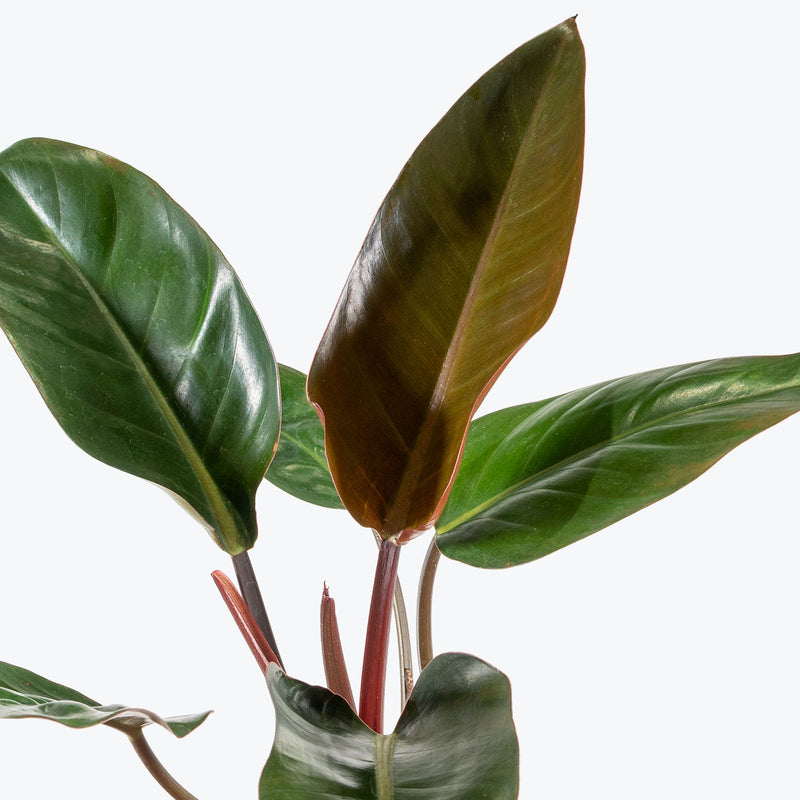
How to care for Philodendron Rojo Congo
They should not be in a position to see the sun directly, although early morning or late evening sun is fine. Filtered sunlight through a sheer curtain is best and most homes are comprised primarily of indirect sunlight. The best spot for them is where they do not see the sun during the majority of the day but still get bright, indirect light.
They will do well in medium light but will grow faster with brighter light. A good medium-light place in your home would be in the middle of a room that has a regular size window. Remember that plants will grow based on how much light they receive.
They need to be watered when the top half of the soil is dry to the touch. That usually takes about 1 week in an average home environment. It will vary depending on the time of year, your environment and lighting conditions, but it's always safer to underwater or give the soil a check before you water again. Expect to water more often in brighter light and less often in lower light.
They will do well in average humidity environments but will appreciate a little bit of humidity if provided, give them a mist daily or get a humidifier.
This Philodendron is very easy, perfect for beginners! Rotate your plant every week or so to encourage even, consistent, and healthy growth. Allow the soil to dry out more between waterings during the winter seasons.
This plant is moderately toxic and can cause some adverse reactions when ingested so it is best to not let your pets eat it, which we advise for all plants in general. The severity of the reaction will depend on how much of the plant is ingested but, if you know your pet typically does not eat your plants, this plant will be suitable for your home..
Learn MoreView PlantPhilodendron Royal Queen

How to care for Philodendron Royal Queen
Philodendron Royal Queen should not be in a position to see the sun directly, although early morning or late evening sun is fine. Filtered sunlight through a sheer curtain is best and most homes are comprised primarily of indirect sunlight. The best spot for them is where they do not see the sun during the majority of the day but still get bright, indirect light.
Philodendron Royal Queen will thrive in bright light, but also can tolerate medium light. A good medium-light place in your home would be in the middle of a room that has a regular size window. They can be placed anywhere between the middle of the room and the window. Remember that plants will grow based on how much light they receive.
Philodendron Royal Queen likes the soil to be relatively dry before the next watering. That usually takes about 2 weeks in an average home environment. It will vary depending on the time of year, your environment and lighting conditions, but for them, it's always safer to underwater or water when you see signs of lack of water (i.e. droopy, floppy, or soft leaves). Expect to water more often in brighter light and less often in lower light.
Philodendron Royal Queen likes a high humidity environment, give them a mist daily or as often as possible. Alternatively, you can put them around a humidifier. Although they won't die if they don't receive enough humidity, their leaves may have some dry, crunchy, or yellow edges.
Fertilize Philodendron Royal Queen every 4-6 weeks during the growing season with a balanced liquid fertilizer diluted to half strength. During the winter months, reduce fertilization as the plant's growth slows down. Regularly clean the leaves with a soft damp cloth to remove dust and enhance their glossy appearance.
Philodendron Royal Queen is moderately toxic and can cause some adverse reactions when ingested so it is best to not let your pets eat it, which we advise for all plants in general. The severity of the reaction will depend on how much of the plant is ingested but, if you know your pet typically does not eat your plants, this plant will be suitable for your home..
Learn MoreView PlantPhilodendron Rudolph
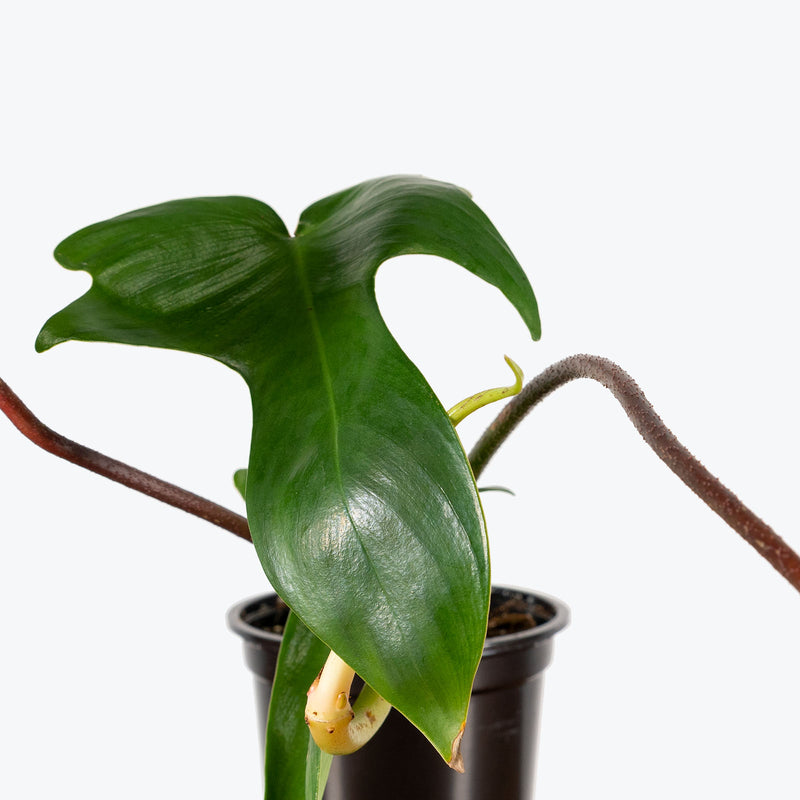
How to care for Philodendron Rudolph
They should not be in a position to see the sun directly, although early morning or late evening sun is fine. Filtered sunlight through a sheer curtain is best and most homes are comprised primarily of indirect sunlight. The best spot for them is where they do not see the sun during the majority of the day but still get bright, indirect light.
They will do well in medium light but will grow faster with brighter light. A good medium-light place in your home would be in the middle of a room that has a regular size window. Remember that plants will grow based on how much light they receive.
They need to be watered when the top half of the soil is dry to the touch. That usually takes about 1 week in an average home environment. It will vary depending on the time of year, your environment and lighting conditions, but it's always safer to underwater or give the soil a check before you water again. Expect to water more often in brighter light and less often in lower light.
They will do well in average humidity environments but will appreciate a little bit of humidity if provided, give them a mist daily or get a humidifier.
Allow the soil to dry out a little bit more in between waterings during the winter season. This tropical houseplant loves warm temperatures and has no cold hardiness. As the plant grows, it will most likely need a bamboo stake or moss pole to grow up, as it loves to grow up a stable structure.
This plant is moderately toxic and can cause some adverse reactions when ingested so it is best to not let your pets eat it, which we advise for all plants in general. The severity of the reaction will depend on how much of the plant is ingested but, if you know your pet typically does not eat your plants, this plant will be suitable for your home..
Learn MoreView PlantPhilodendron Rugosum
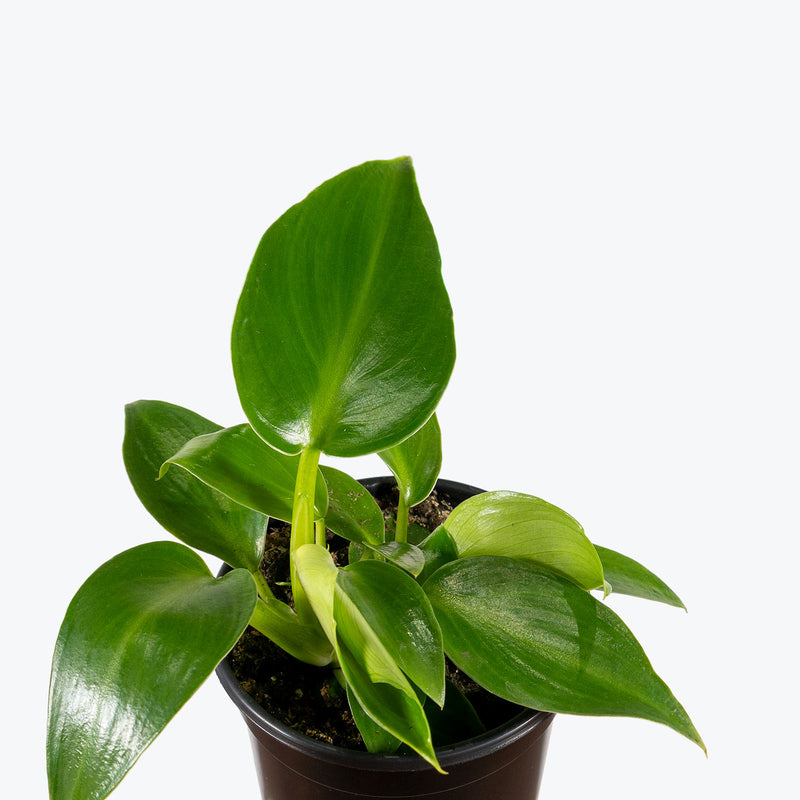
How to care for Philodendron Rugosum
Philodendron Rugosum should not be in a position to see the sun directly, although early morning or late evening sun is fine. Filtered sunlight through a sheer curtain is best and most homes are comprised primarily of indirect sunlight. The best spot for them is where they do not see the sun during the majority of the day but still get bright, indirect light.
Philodendron Rugosum will do well in medium light but will grow faster with brighter light. A good medium-light place in your home would be in the middle of a room that has a regular size window. Remember that plants will grow based on how much light they receive.
Philodendron Rugosum needs to be watered when the top half of the soil is dry to the touch. That usually takes about 1 week in an average home environment. It will vary depending on the time of year, your environment and lighting conditions, but it's always safer to underwater or give the soil a check before you water again. Expect to water more often in brighter light and less often in lower light.
Philodendron Rugosum will do well in average humidity environments but will appreciate a little bit of humidity if provided, give them a mist daily or get a humidifier.
Fertilize Philodendron Rugosum with a balanced liquid fertilizer every month during the growing season (spring through summer), reducing to every other month in winter. Clean the leaves regularly to remove dust and enhance their unique texture. As a rare species, ensure that any propagation or collection is done responsibly to avoid contributing to its threatened status in the wild.
Philodendron Rugosum is moderately toxic and can cause some adverse reactions when ingested so it is best to not let your pets eat it, which we advise for all plants in general. The severity of the reaction will depend on how much of the plant is ingested but, if you know your pet typically does not eat your plants, this plant will be suitable for your home..
Learn MoreView PlantPhilodendron Serpens

How to care for Philodendron Serpens
Philodendron Serpens should not be in a position to see the sun directly, although early morning or late evening sun is fine. Filtered sunlight through a sheer curtain is best and most homes are comprised primarily of indirect sunlight. The best spot for them is where they do not see the sun during the majority of the day but still get bright, indirect light.
Philodendron Serpens will thrive in bright light, but also can tolerate medium light. A good medium-light place in your home would be in the middle of a room that has a regular size window. They can be placed anywhere between the middle of the room and the window. Remember that plants will grow based on how much light they receive.
Philodendron Serpens needs to be watered when the top half of the soil is dry to the touch. That usually takes about 1 week in an average home environment. It will vary depending on the time of year, your environment and lighting conditions, but it's always safer to underwater or give the soil a check before you water again. Expect to water more often in brighter light and less often in lower light.
Philodendron Serpens will do well in average humidity environments but will appreciate a little bit of humidity if provided, give them a mist daily or get a humidifier.
Provide a moss pole or sturdy support to encourage climbing and larger leaf development. Use a well-aerated aroid mix with bark, perlite, and peat. Fertilize Philodendron Serpens every 4–6 weeks during the growing season. Avoid excessive handling of the petioles, as the fine hairs are delicate. Maintain warm temperatures and protect from drafts.
Philodendron Serpens is moderately toxic and can cause some adverse reactions when ingested so it is best to not let your pets eat it, which we advise for all plants in general. The severity of the reaction will depend on how much of the plant is ingested but, if you know your pet typically does not eat your plants, this plant will be suitable for your home..
Learn MoreView PlantPhilodendron Silver Stripe
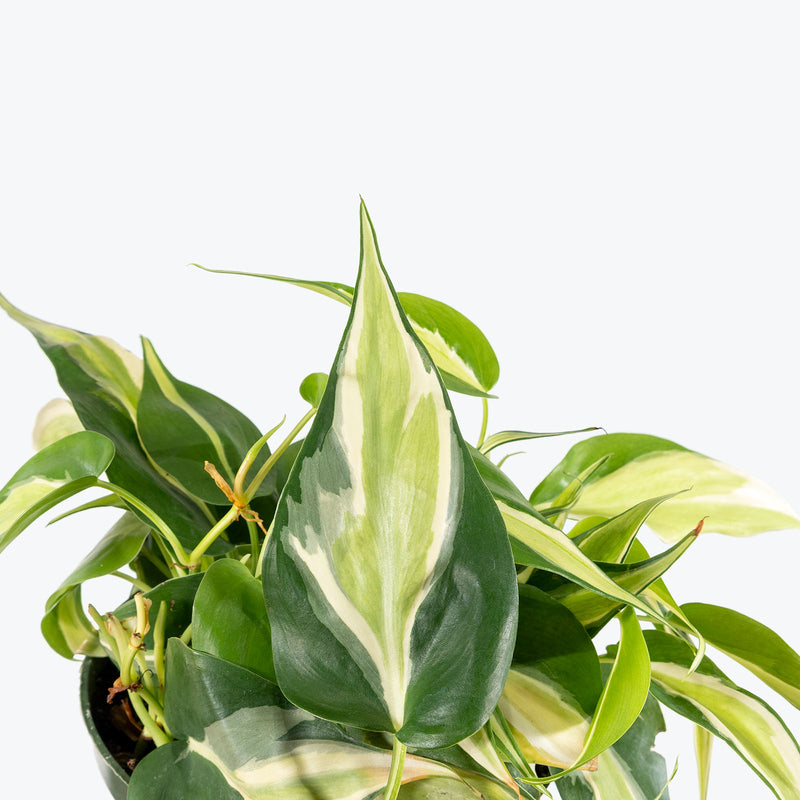
How to care for Philodendron Silver Stripe
Philodendron Silver Stripe should not be in a position to see the sun directly, although early morning or late evening sun is fine. Filtered sunlight through a sheer curtain is best and most homes are comprised primarily of indirect sunlight. The best spot for them is where they do not see the sun during the majority of the day but still get bright, indirect light.
Philodendron Silver Stripe will thrive in bright light, but also can tolerate medium light. A good medium-light place in your home would be in the middle of a room that has a regular size window. They can be placed anywhere between the middle of the room and the window. Remember that plants will grow based on how much light they receive.
Philodendron Silver Stripe needs to be watered when the top half of the soil is dry to the touch. That usually takes about 1 week in an average home environment. It will vary depending on the time of year, your environment and lighting conditions, but it's always safer to underwater or give the soil a check before you water again. Expect to water more often in brighter light and less often in lower light.
Philodendron Silver Stripe can live in any average home humidity condition and are fairly hardy.
Soft, yellow leaves may indicate overwatering, while crispy, brown leaves usually mean the plant needs more water. If you wish to propagate Philodendron Silver Stripe, take stem cuttings during the warmer months and place the stem in water or moist soil, making sure to keep at least one node - point of attachment of a leaf - submerged, from which the roots will grow, and they should root quite easily.
Philodendron Silver Stripe is moderately toxic and can cause some adverse reactions when ingested so it is best to not let your pets eat it, which we advise for all plants in general. The severity of the reaction will depend on how much of the plant is ingested but, if you know your pet typically does not eat your plants, this plant will be suitable for your home..
Learn MoreView PlantPhilodendron Silver Sword
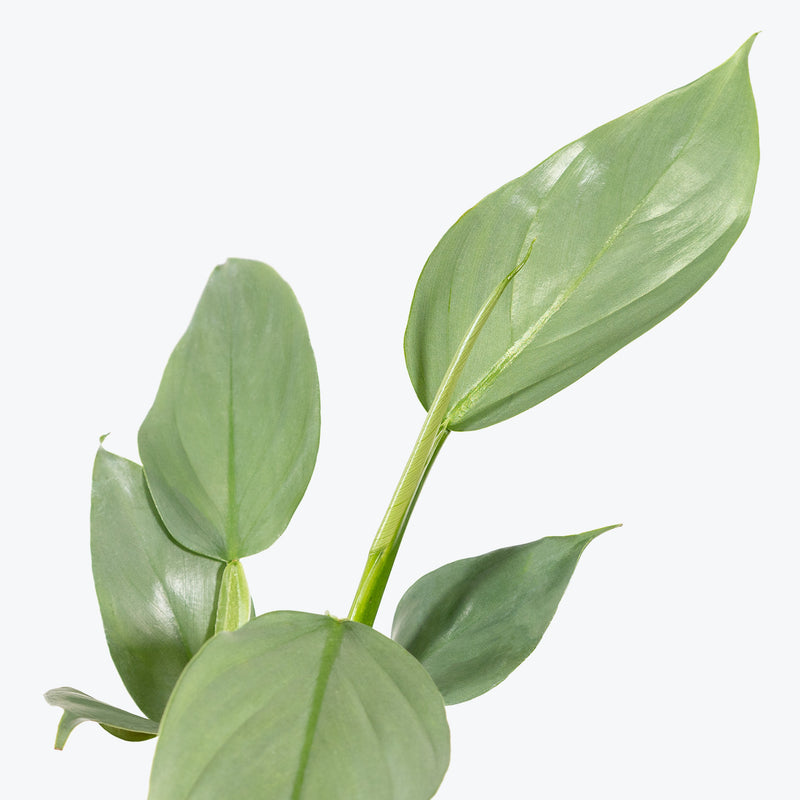
How to care for Philodendron Silver Sword
They should not be in a position to see the sun directly, although early morning or late evening sun is fine. Filtered sunlight through a sheer curtain is best and most homes are comprised primarily of indirect sunlight. The best spot for them is where they do not see the sun during the majority of the day but still get bright, indirect light.
They will do well in medium light but will grow faster with brighter light. A good medium-light place in your home would be in the middle of a room that has a regular size window. Remember that plants will grow based on how much light they receive.
They need to be watered when the top half of the soil is dry to the touch. That usually takes about 1 week in an average home environment. It will vary depending on the time of year, your environment and lighting conditions, but it's always safer to underwater or give the soil a check before you water again. Expect to water more often in brighter light and less often in lower light.
They can live in any average home humidity condition and are fairly hardy.
If your plant isn't producing larger leaves, and it is not still in its juvenile stages, provide more light for your plant, as well as support for it to grow on. When they are in their ideal light levels, the leaves will have that beautiful, glossy sheen. They are very easily propagated via stem cuttings, so feel free to make your parent plant even fuller as it grows!
This plant is moderately toxic and can cause some adverse reactions when ingested so it is best to not let your pets eat it, which we advise for all plants in general. The severity of the reaction will depend on how much of the plant is ingested but, if you know your pet typically does not eat your plants, this plant will be suitable for your home..
Learn MoreView PlantPhilodendron sp Colombia
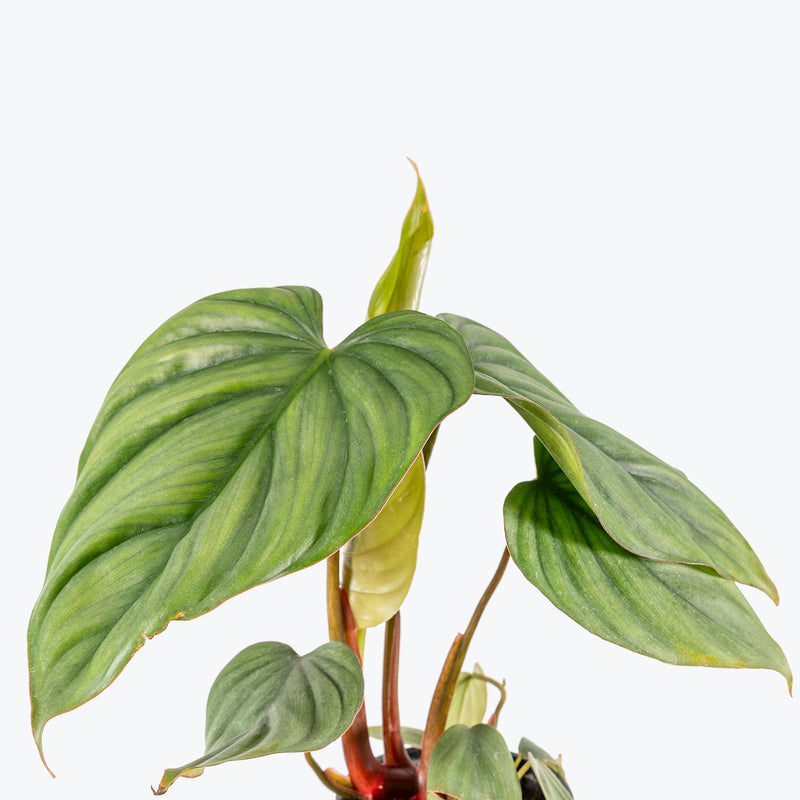
How to care for Philodendron sp Colombia
They should not be in a position to see the sun directly, although early morning or late evening sun is fine. Filtered sunlight through a sheer curtain is best and most homes are comprised primarily of indirect sunlight. The best spot for them is where they do not see the sun during the majority of the day but still get bright, indirect light.
They will thrive in bright light, but also can tolerate medium light. A good medium-light place in your home would be in the middle of a room that has a regular size window. They can be placed anywhere between the middle of the room and the window. Remember that plants will grow based on how much light they receive.
Allow the top quarter of the soil to dry before watering again. This usually takes about 3 - 4 days in an average home environment. It will vary depending on the time of year, your environment and lighting conditions. Expect to water more often in brighter light and less often in lower light.
They will do well in average humidity environments but will appreciate a little bit of humidity if provided, give them a mist daily or get a humidifier.
Wipe the leaves with a damp cloth periodically to keep them dust-free and vibrant. This plant prefers a warmer indoor environment, away from drafts or sudden temperature changes.
This plant is moderately toxic and can cause some adverse reactions when ingested so it is best to not let your pets eat it, which we advise for all plants in general. The severity of the reaction will depend on how much of the plant is ingested but, if you know your pet typically does not eat your plants, this plant will be suitable for your home..
Learn MoreView PlantPhilodendron Spiritus-Sancti
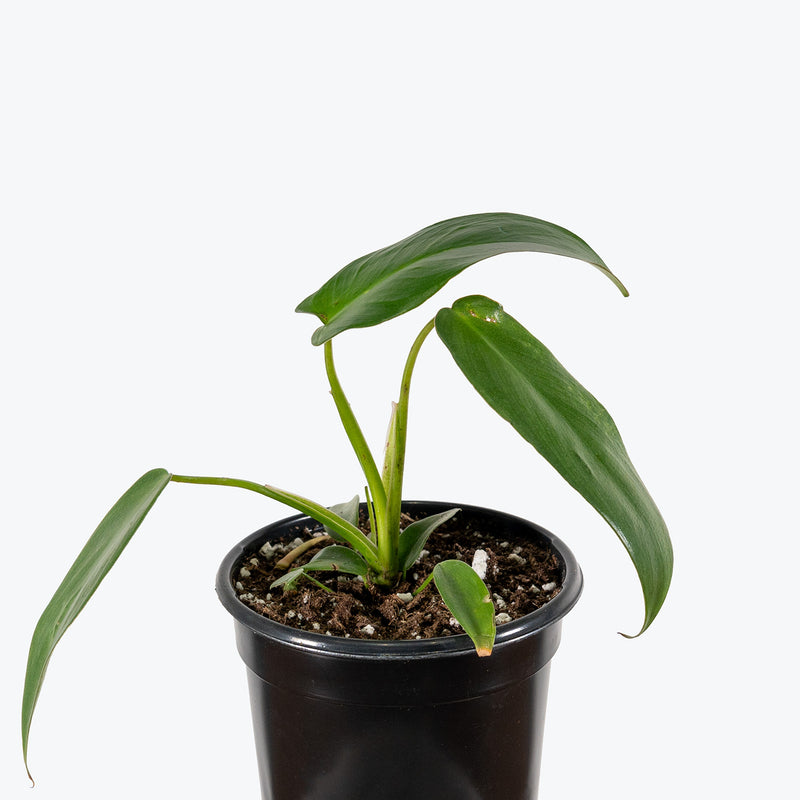
How to care for Philodendron Spiritus-Sancti
Philodendron Spiritus-Sancti should not be in a position to see the sun directly, although early morning or late evening sun is fine. Filtered sunlight through a sheer curtain is best and most homes are comprised primarily of indirect sunlight. The best spot for them is where they do not see the sun during the majority of the day but still get bright, indirect light.
Philodendron Spiritus-Sancti will thrive in bright light, but also can tolerate medium light. A good medium-light place in your home would be in the middle of a room that has a regular size window. They can be placed anywhere between the middle of the room and the window. Remember that plants will grow based on how much light they receive.
Philodendron Spiritus-Sancti needs to be watered when the top half of the soil is dry to the touch. That usually takes about 1 week in an average home environment. It will vary depending on the time of year, your environment and lighting conditions, but it's always safer to underwater or give the soil a check before you water again. Expect to water more often in brighter light and less often in lower light.
Philodendron Spiritus-Sancti will do well in average humidity environments but will appreciate a little bit of humidity if provided, give them a mist daily or get a humidifier.
Fertilize Philodendron Spiritus-Sancti every 4-6 weeks during the growing season with a balanced liquid fertilizer diluted to half strength. Reduce feeding in the winter months. Clean the leaves regularly to prevent dust accumulation, which can inhibit photosynthesis. Provide a moss pole or similar support for the plant to climb, as this mimics its natural growing conditions and promotes larger leaf development.
Philodendron Spiritus-Sancti is moderately toxic and can cause some adverse reactions when ingested so it is best to not let your pets eat it, which we advise for all plants in general. The severity of the reaction will depend on how much of the plant is ingested but, if you know your pet typically does not eat your plants, this plant will be suitable for your home..
Learn MoreView PlantPhilodendron Splendid
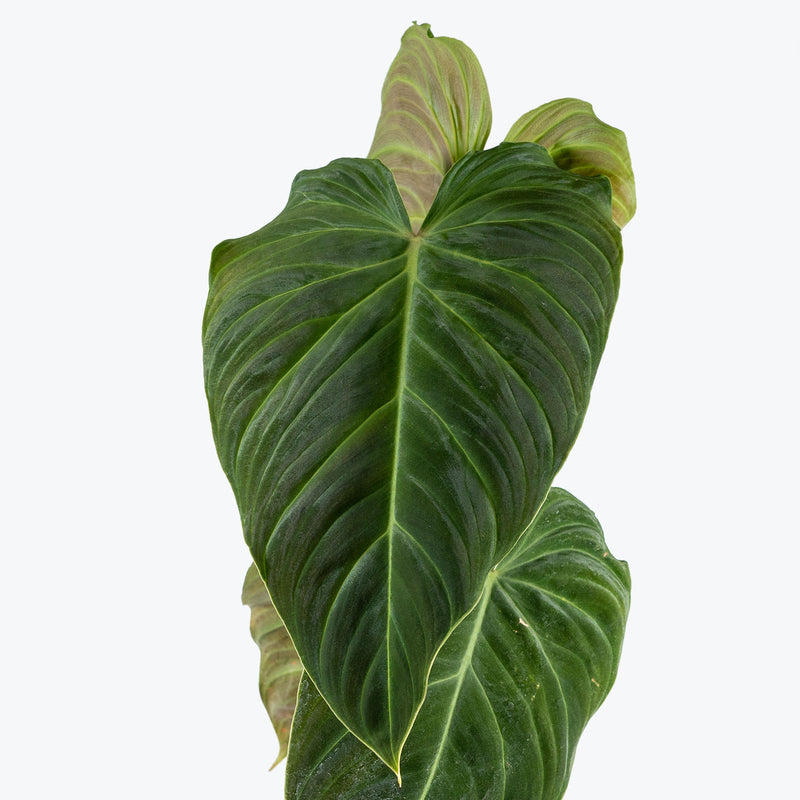
How to care for Philodendron Splendid
They should not be in a position to see the sun directly, although early morning or late evening sun is fine. Filtered sunlight through a sheer curtain is best and most homes are comprised primarily of indirect sunlight. The best spot for them is where they do not see the sun during the majority of the day but still get bright, indirect light.
They will do well in medium light but will grow faster with brighter light. A good medium-light place in your home would be in the middle of a room that has a regular size window. Remember that plants will grow based on how much light they receive.
They need to be watered when the top half of the soil is dry to the touch. That usually takes about 1 week in an average home environment. It will vary depending on the time of year, your environment and lighting conditions, but it's always safer to underwater or give the soil a check before you water again. Expect to water more often in brighter light and less often in lower light.
They will do well in average humidity environments but will appreciate a little bit of humidity if provided, give them a mist daily or get a humidifier.
Philodendron Splendid will benefit from a well-draining soil mix and should be repotted only when necessary. Keep an eye out for any signs of pests, and provide support for the climbing growth habit with a moss pole or trellis.
This plant is moderately toxic and can cause some adverse reactions when ingested so it is best to not let your pets eat it, which we advise for all plants in general. The severity of the reaction will depend on how much of the plant is ingested but, if you know your pet typically does not eat your plants, this plant will be suitable for your home..
Learn MoreView PlantPhilodendron Squamiferum
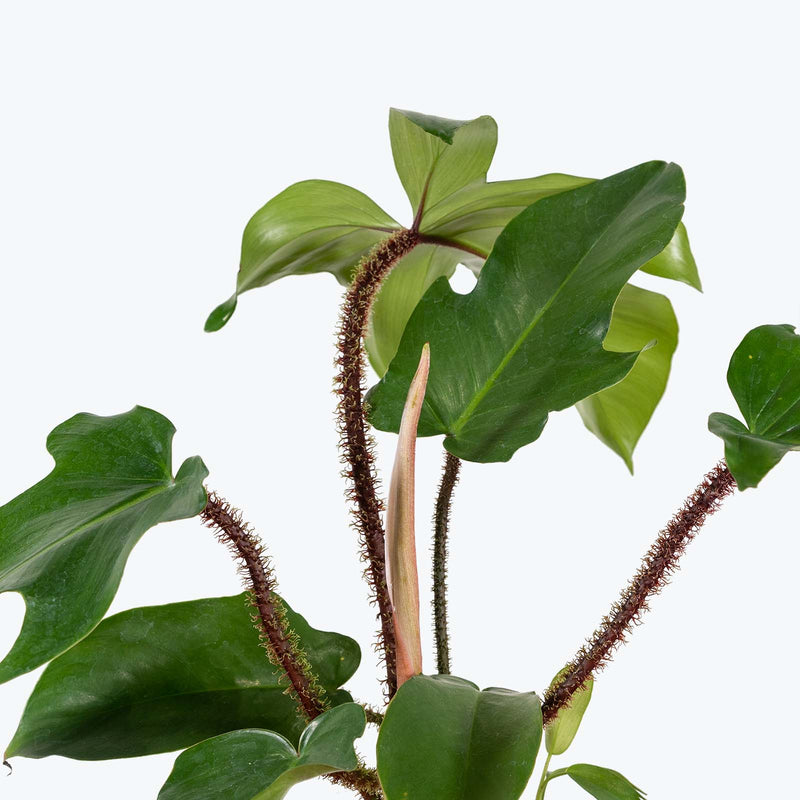
How to care for Philodendron Squamiferum
Philodendron Squamiferum should not be in a position to see the sun directly, although early morning or late evening sun is fine. Filtered sunlight through a sheer curtain is best and most homes are comprised primarily of indirect sunlight. The best spot for them is where they do not see the sun during the majority of the day but still get bright, indirect light.
Philodendron Squamiferum will do well in medium light but will grow faster with brighter light. A good medium-light place in your home would be in the middle of a room that has a regular size window. Remember that plants will grow based on how much light they receive.
Allow the top quarter of the soil to dry before watering again. This usually takes about 3 - 4 days in an average home environment. It will vary depending on the time of year, your environment and lighting conditions. Expect to water Philodendron Squamiferum more often in brighter light and less often in lower light.
Philodendron Squamiferum will do well in average humidity environments but will appreciate a little bit of humidity if provided, give them a mist daily or get a humidifier.
Philodendron Squamiferum goes dormant in winter, but as spring approaches, it starts growing. As an epiphyte, meaning that it does not like a tight soil mix. Its roots need some aeration to develop. So use light and porous potting mix. Provide a moss pole or another type of support for the plant to climb, which encourages natural behavior and healthier growth.
Philodendron Squamiferum is moderately toxic and can cause some adverse reactions when ingested so it is best to not let your pets eat it, which we advise for all plants in general. The severity of the reaction will depend on how much of the plant is ingested but, if you know your pet typically does not eat your plants, this plant will be suitable for your home..
Learn MoreView PlantPhilodendron Subhastatum
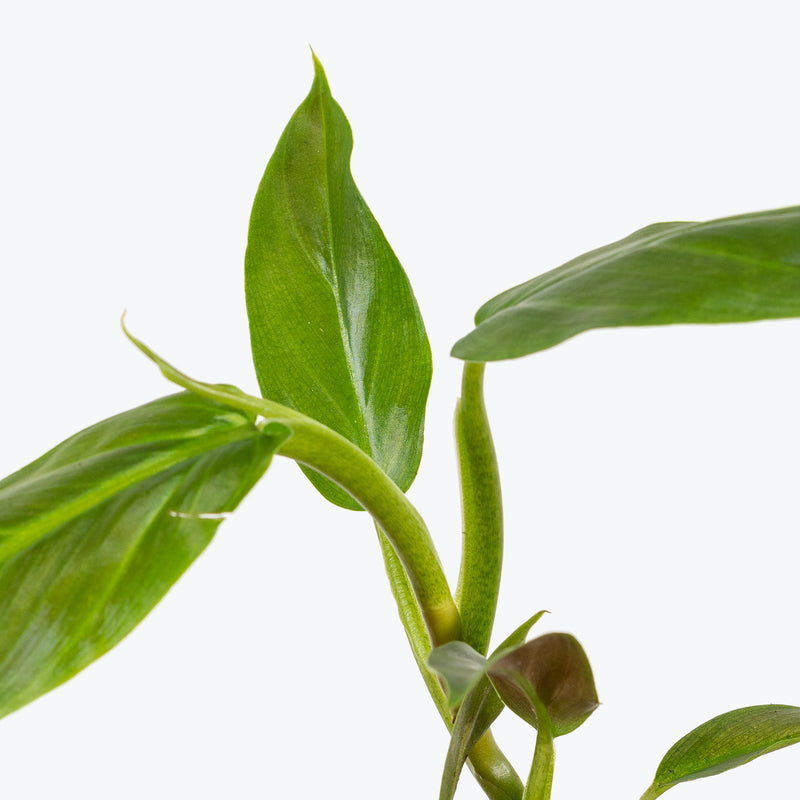
How to care for Philodendron Subhastatum
They should not be in a position to see the sun directly, although early morning or late evening sun is fine. Filtered sunlight through a sheer curtain is best and most homes are comprised primarily of indirect sunlight. The best spot for them is where they do not see the sun during the majority of the day but still get bright, indirect light.
They will do well in medium light but will grow faster with brighter light. A good medium-light place in your home would be in the middle of a room that has a regular size window. Remember that plants will grow based on how much light they receive.
They need to be watered when the top half of the soil is dry to the touch. That usually takes about 1 week in an average home environment. It will vary depending on the time of year, your environment and lighting conditions, but it's always safer to underwater or give the soil a check before you water again. Expect to water more often in brighter light and less often in lower light.
They will do well in average humidity environments but will appreciate a little bit of humidity if provided, give them a mist daily or get a humidifier.
Rotate your plant every week or so to encourage even, consistent, and healthy growth. Allow the soil to dry out more between waterings during the winter seasons. If you want your plant to grow larger, mature leaves, keep it on a moss pole and in bright, but indirect light.
This plant is moderately toxic and can cause some adverse reactions when ingested so it is best to not let your pets eat it, which we advise for all plants in general. The severity of the reaction will depend on how much of the plant is ingested but, if you know your pet typically does not eat your plants, this plant will be suitable for your home..
Learn MoreView PlantPhilodendron Summer Glory

How to care for Philodendron Summer Glory
Philodendron Summer Glory should not be in a position to see the sun directly, although early morning or late evening sun is fine. Filtered sunlight through a sheer curtain is best and most homes are comprised primarily of indirect sunlight. The best spot for them is where they do not see the sun during the majority of the day but still get bright, indirect light.
Philodendron Summer Glory will thrive in bright light, but also can tolerate medium light. A good medium-light place in your home would be in the middle of a room that has a regular size window. They can be placed anywhere between the middle of the room and the window. Remember that plants will grow based on how much light they receive.
Allow the top quarter of the soil to dry before watering Philodendron Summer Glory again. This usually takes about 3 - 4 days in an average home environment. It will vary depending on the time of year, your environment and lighting conditions. Expect to water more often in brighter light and less often in lower light.
Philodendron Summer Glory likes a high humidity environment, give them a mist daily or as often as possible. Alternatively, you can put them around a humidifier. Although they won't die if they don't receive enough humidity, their leaves may have some dry, crunchy, or yellow edges.
Fertilize Philodendron Summer Glory with a balanced liquid fertilizer every month during the growing season (spring and summer), reducing to every other month in the winter when growth slows. Provide a support structure like a moss pole to encourage its natural climbing habit, which also helps to maintain an upright growth form. Regularly clean the leaves to remove dust and inspect for pests such as aphids, mealybugs, and spider mites.
Philodendron Summer Glory is moderately toxic and can cause some adverse reactions when ingested so it is best to not let your pets eat it, which we advise for all plants in general. The severity of the reaction will depend on how much of the plant is ingested but, if you know your pet typically does not eat your plants, this plant will be suitable for your home..
Learn MoreView PlantPhilodendron Sun Red
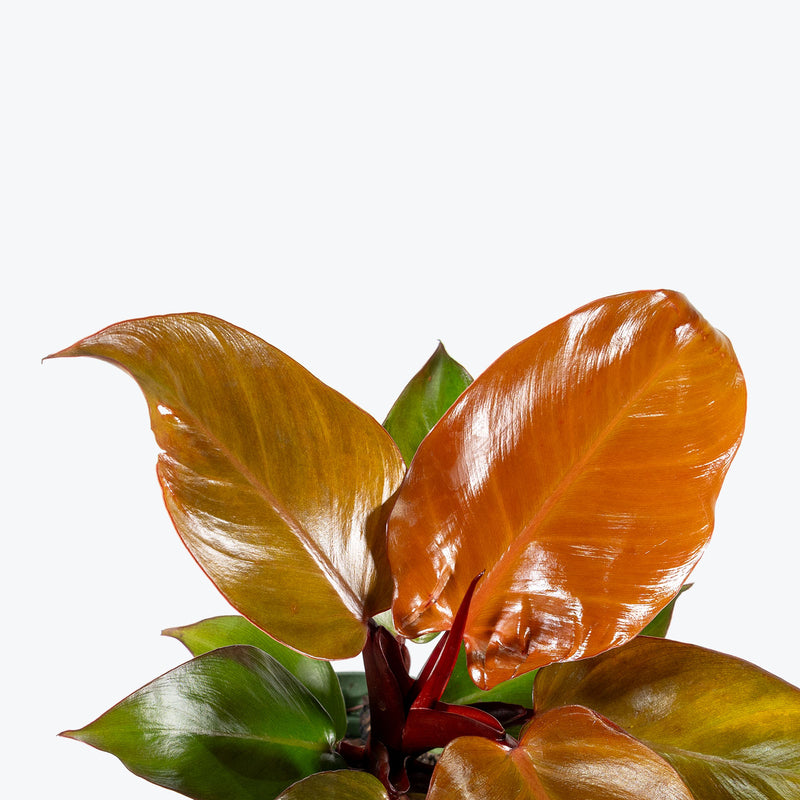
How to care for Philodendron Sun Red
They should not be in a position to see the sun directly, although early morning or late evening sun is fine. Filtered sunlight through a sheer curtain is best and most homes are comprised primarily of indirect sunlight. The best spot for them is where they do not see the sun during the majority of the day but still get bright, indirect light.
They will thrive in bright light, but also can tolerate medium light. A good medium-light place in your home would be in the middle of a room that has a regular size window. They can be placed anywhere between the middle of the room and the window. Remember that plants will grow based on how much light they receive.
They like the soil to be relatively dry before the next watering. That usually takes about 2 weeks in an average home environment. It will vary depending on the time of year, your environment and lighting conditions, but for them, it's always safer to underwater or water when you see signs of lack of water (i.e. droopy, floppy, or soft leaves). Expect to water more often in brighter light and less often in lower light.
They will do well in average humidity environments but will appreciate a little bit of humidity if provided, give them a mist daily or get a humidifier.
Make sure the plant has well-draining soil to prevent root rot. It's a good idea to rotate the plant occasionally to ensure even growth.
This plant is moderately toxic and can cause some adverse reactions when ingested so it is best to not let your pets eat it, which we advise for all plants in general. The severity of the reaction will depend on how much of the plant is ingested but, if you know your pet typically does not eat your plants, this plant will be suitable for your home..
Learn MoreView PlantPhilodendron Tortum
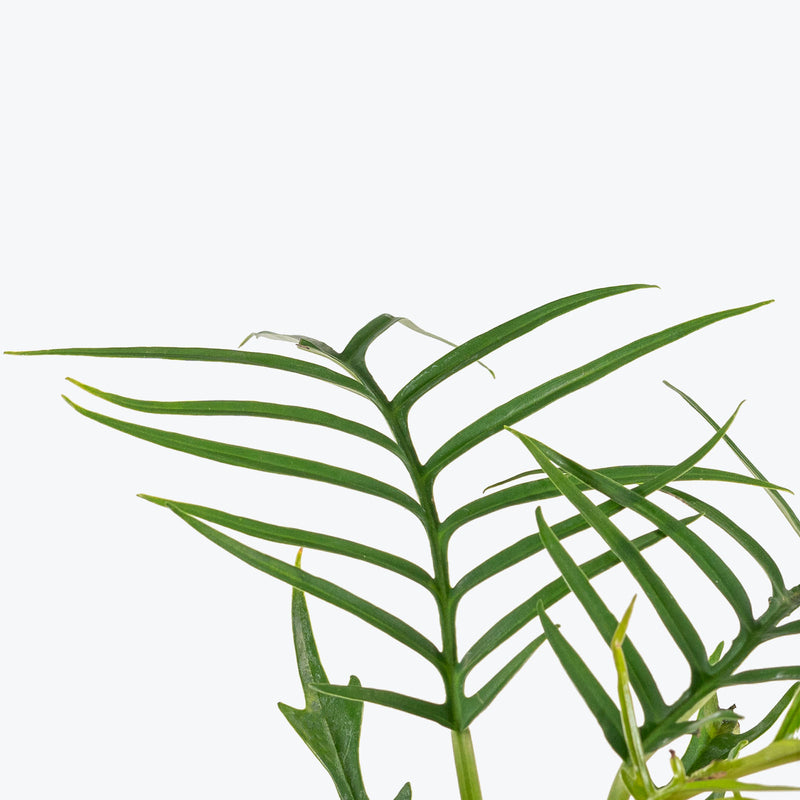
How to care for Philodendron Tortum
They should not be in a position to see the sun directly, although early morning or late evening sun is fine. Filtered sunlight through a sheer curtain is best and most homes are comprised primarily of indirect sunlight. The best spot for them is where they do not see the sun during the majority of the day but still get bright, indirect light.
They will do best in bright light. A nice bright place inside your home would be on the window sill or a stool that is right next to a window, either with or without blinds, depending on if the plant can handle sun. Remember that plants will grow based on how much light they receive.
Allow the top quarter of the soil to dry before watering again. This usually takes about 3 - 4 days in an average home environment. It will vary depending on the time of year, your environment and lighting conditions. Expect to water more often in brighter light and less often in lower light.
They will do well in average humidity environments but will appreciate a little bit of humidity if provided, give them a mist daily or get a humidifier.
If the older leaves start to yellow there is nothing to worry about, as the plant is just making space for newer growth. These plants also enjoy the benefits of a humid space, so adding in a humidifier or grouping with other humid-loving plants will boost the humidity around them.
This plant is moderately toxic and can cause some adverse reactions when ingested so it is best to not let your pets eat it, which we advise for all plants in general. The severity of the reaction will depend on how much of the plant is ingested but, if you know your pet typically does not eat your plants, this plant will be suitable for your home..
Learn MoreView PlantPhilodendron Verrucosum
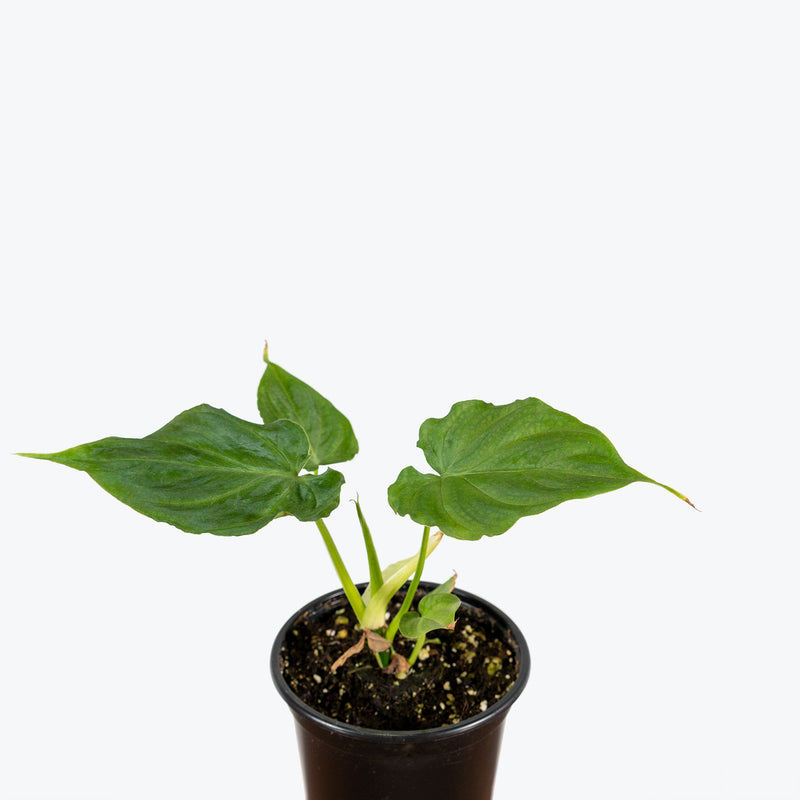
How to care for Philodendron Verrucosum
Philodendron Verrucosum should not be in a position to see the sun directly, although early morning or late evening sun is fine. Filtered sunlight through a sheer curtain is best and most homes are comprised primarily of indirect sunlight. The best spot for them is where they do not see the sun during the majority of the day but still get bright, indirect light.
Philodendron Verrucosum will do well in medium light but will grow faster with brighter light. A good medium-light place in your home would be in the middle of a room that has a regular size window. Remember that plants will grow based on how much light they receive.
Allow the top quarter of the soil to dry before watering Philodendron Verrucosum again. This usually takes about 3 - 4 days in an average home environment. It will vary depending on the time of year, your environment and lighting conditions. Expect to water more often in brighter light and less often in lower light.
Philodendron Verrucosum likes a high humidity environment, give them a mist daily or as often as possible. Alternatively, you can put them around a humidifier. Although they won't die if they don't receive enough humidity, their leaves may have some dry, crunchy, or yellow edges.
The lifecycle of the Philodendron Verrucosum begins as a seed growing in the canopy of trees and eventually reaching the soil with its roots. It is a type of hemiepiphyte - plants that grow as epiphytes for a part, if not the entirety of their lifecycle. They do not like to be rootbound so you’ll need to repot it every year or two. Provide a moss pole or another type of support for the climbing habit, encouraging vertical growth and a healthier plant.
Philodendron Verrucosum is moderately toxic and can cause some adverse reactions when ingested so it is best to not let your pets eat it, which we advise for all plants in general. The severity of the reaction will depend on how much of the plant is ingested but, if you know your pet typically does not eat your plants, this plant will be suitable for your home..
Learn MoreView PlantPhilodendron Verrucosum Netherlands

How to care for Philodendron Verrucosum Netherlands
Philodendron Verrucosum Netherlands should not be in a position to see the sun directly, although early morning or late evening sun is fine. Filtered sunlight through a sheer curtain is best and most homes are comprised primarily of indirect sunlight. The best spot for them is where they do not see the sun during the majority of the day but still get bright, indirect light.
Philodendron Verrucosum Netherlands will do well in medium light but will grow faster with brighter light. A good medium-light place in your home would be in the middle of a room that has a regular size window. Remember that plants will grow based on how much light they receive.
Allow the top quarter of the soil to dry before watering Philodendron Verrucosum Netherlands again. This usually takes about 3 - 4 days in an average home environment. It will vary depending on the time of year, your environment and lighting conditions. Expect to water more often in brighter light and less often in lower light.
Philodendron Verrucosum Netherlands likes a high humidity environment, give them a mist daily or as often as possible. Alternatively, you can put them around a humidifier. Although they won't die if they don't receive enough humidity, their leaves may have some dry, crunchy, or yellow edges.
The lifecycle of the Philodendron Verrucosum Netherlands begins as a seed growing in the canopy of trees and eventually reaching the soil with its roots. It is a type of hemiepiphyte - plants that grow as epiphytes for a part, if not the entirety of their lifecycle. They do not like to be rootbound so you’ll need to repot it every year or two. Regularly clean the leaves with a soft, damp cloth to remove dust and enhance their appearance. Provide a support structure like a moss pole to encourage its climbing habit.
Philodendron Verrucosum Netherlands is moderately toxic and can cause some adverse reactions when ingested so it is best to not let your pets eat it, which we advise for all plants in general. The severity of the reaction will depend on how much of the plant is ingested but, if you know your pet typically does not eat your plants, this plant will be suitable for your home..
Learn MoreView PlantPhilodendron Wendlandii Variegated
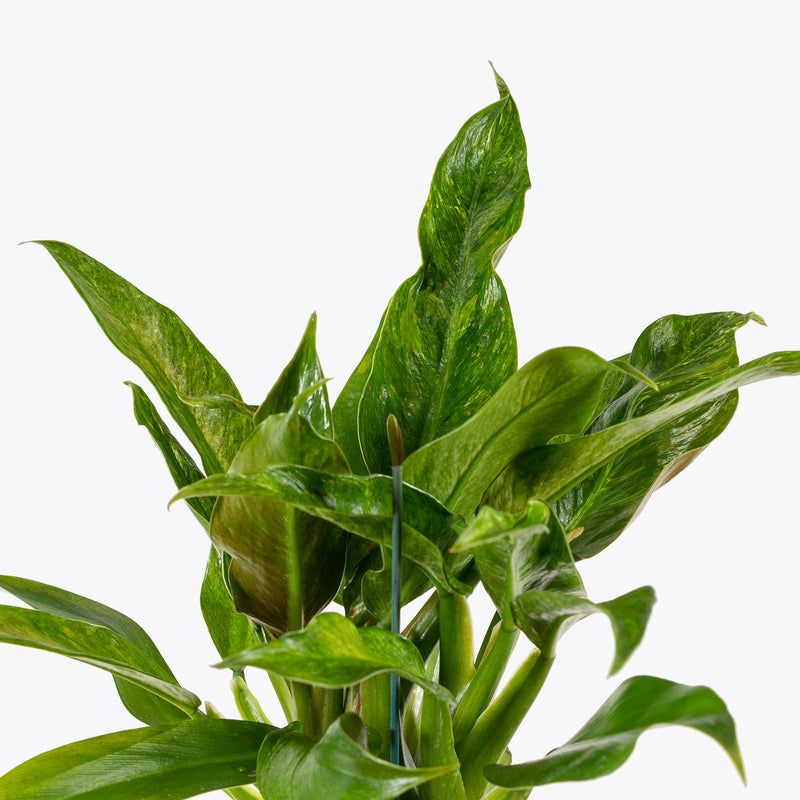
How to care for Philodendron Wendlandii Variegated
They should not be in a position to see the sun directly, although early morning or late evening sun is fine. Filtered sunlight through a sheer curtain is best and most homes are comprised primarily of indirect sunlight. The best spot for them is where they do not see the sun during the majority of the day but still get bright, indirect light.
They will thrive in bright light, but also can tolerate medium light. A good medium-light place in your home would be in the middle of a room that has a regular size window. They can be placed anywhere between the middle of the room and the window. Remember that plants will grow based on how much light they receive.
They like the soil to be relatively dry before the next watering. That usually takes about 2 weeks in an average home environment. It will vary depending on the time of year, your environment and lighting conditions, but for them, it's always safer to underwater or water when you see signs of lack of water (i.e. droopy, floppy, or soft leaves). Expect to water more often in brighter light and less often in lower light.
They will do can do well in medium humidity environments. It can tolerate average indoor humidity but may benefit from occasional misting or placement near other humidity-loving plants. If you notice the plant struggling in particularly dry conditions, consider increasing humidity using methods like misting, a tray of water and pebbles, or a humidifier.
Philodendron Wendlandii Variegated appreciates a well-draining soil mix and should be repotted only when necessary. Keep an eye out for any signs of pests. To maintain optimal humidity, consider occasional misting or grouping the plant with other humidity-loving plants. If you notice the plant struggling in particularly dry conditions, consider increasing humidity using methods like misting, a tray of water and pebbles, or a humidifier.
This plant is moderately toxic and can cause some adverse reactions when ingested so it is best to not let your pets eat it, which we advise for all plants in general. The severity of the reaction will depend on how much of the plant is ingested but, if you know your pet typically does not eat your plants, this plant will be suitable for your home..
Learn MoreView PlantPhilodendron White Knight

How to care for Philodendron White Knight
They should not be in a position to see the sun directly, although early morning or late evening sun is fine. Filtered sunlight through a sheer curtain is best and most homes are comprised primarily of indirect sunlight. The best spot for them is where they do not see the sun during the majority of the day but still get bright, indirect light.
They will thrive in bright light, but also can tolerate medium light. A good medium-light place in your home would be in the middle of a room that has a regular size window. They can be placed anywhere between the middle of the room and the window. Remember that plants will grow based on how much light they receive.
They like the soil to be relatively dry before the next watering. That usually takes about 2 weeks in an average home environment. It will vary depending on the time of year, your environment and lighting conditions, but for them, it's always safer to underwater or water when you see signs of lack of water (i.e. droopy, floppy, or soft leaves). Expect to water more often in brighter light and less often in lower light.
They will do well in average humidity environments but will appreciate a little bit of humidity if provided, give them a mist daily or get a humidifier.
As the plant grows, it may need to be secured to a bamboo stake or moss pole to support its main vine and to have something for its aerial roots to latch onto. To promote the best colouring, make sure to keep your plant in lots of bright, indirect light. Keep it in a warm room but make sure there is a healthy amount of airflow and no drafts blowing on the plant.
This plant is moderately toxic and can cause some adverse reactions when ingested so it is best to not let your pets eat it, which we advise for all plants in general. The severity of the reaction will depend on how much of the plant is ingested but, if you know your pet typically does not eat your plants, this plant will be suitable for your home..
Learn MoreView PlantPhilodendron White Princess

How to care for Philodendron White Princess
Philodendron White Princess should not be in a position to see the sun directly, although early morning or late evening sun is fine. Filtered sunlight through a sheer curtain is best and most homes are comprised primarily of indirect sunlight. The best spot for them is where they do not see the sun during the majority of the day but still get bright, indirect light.
Philodendron White Princess will thrive in bright light, but also can tolerate medium light. A good medium-light place in your home would be in the middle of a room that has a regular size window. They can be placed anywhere between the middle of the room and the window. Remember that plants will grow based on how much light they receive.
Philodendron White Princess likes the soil to be relatively dry before the next watering. That usually takes about 2 weeks in an average home environment. It will vary depending on the time of year, your environment and lighting conditions, but for them, it's always safer to underwater or water when you see signs of lack of water (i.e. droopy, floppy, or soft leaves). Expect to water more often in brighter light and less often in lower light.
Philodendron White Princess will do well in average humidity environments but will appreciate a little bit of humidity if provided, give them a mist daily or get a humidifier.
As Philodendron White Princess grows, it may need to be secured to a bamboo stake or moss pole to support its main vine and to have something for its aerial roots to latch onto. Keep it in a warm room but make sure there is a healthy amount of airflow and no drafts blowing on the plant. To promote the best colouring, make sure to keep your plant in lots of bright, indirect light.
Philodendron White Princess is moderately toxic and can cause some adverse reactions when ingested so it is best to not let your pets eat it, which we advise for all plants in general. The severity of the reaction will depend on how much of the plant is ingested but, if you know your pet typically does not eat your plants, this plant will be suitable for your home..
Learn MoreView PlantPhilodendron White Wizard
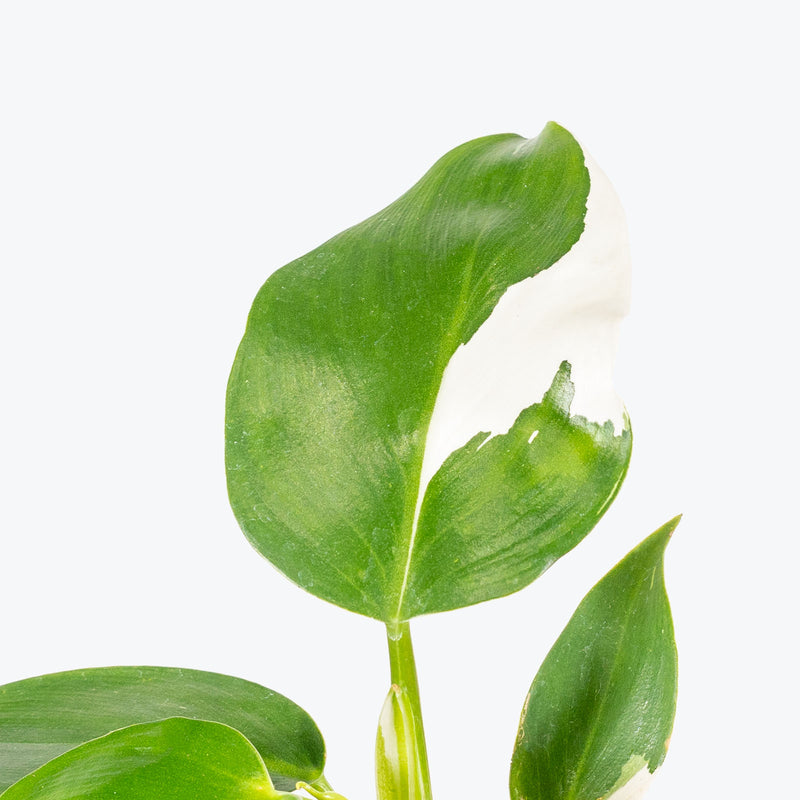
How to care for Philodendron White Wizard
They should not be in a position to see the sun directly, although early morning or late evening sun is fine. Filtered sunlight through a sheer curtain is best and most homes are comprised primarily of indirect sunlight. The best spot for them is where they do not see the sun during the majority of the day but still get bright, indirect light.
They will thrive in bright light, but also can tolerate medium light. A good medium-light place in your home would be in the middle of a room that has a regular size window. They can be placed anywhere between the middle of the room and the window. Remember that plants will grow based on how much light they receive.
They like the soil to be relatively dry before the next watering. That usually takes about 2 weeks in an average home environment. It will vary depending on the time of year, your environment and lighting conditions, but for them, it's always safer to underwater or water when you see signs of lack of water (i.e. droopy, floppy, or soft leaves). Expect to water more often in brighter light and less often in lower light.
They will do well in average humidity environments but will appreciate a little bit of humidity if provided, give them a mist daily or get a humidifier.
As the plant grows, it may need to be secured to a bamboo stake or moss pole to support its main vine and to have something for its aerial roots to latch on to. Keep it in a warm room but make sure there is a healthy amount of airflow and no drafts blowing on the plant. To promote the best colouring, make sure to keep you plant in lots of bright, indirect light.
This plant is moderately toxic and can cause some adverse reactions when ingested so it is best to not let your pets eat it, which we advise for all plants in general. The severity of the reaction will depend on how much of the plant is ingested but, if you know your pet typically does not eat your plants, this plant will be suitable for your home..
Learn MoreView PlantPhilodendron Xanadu
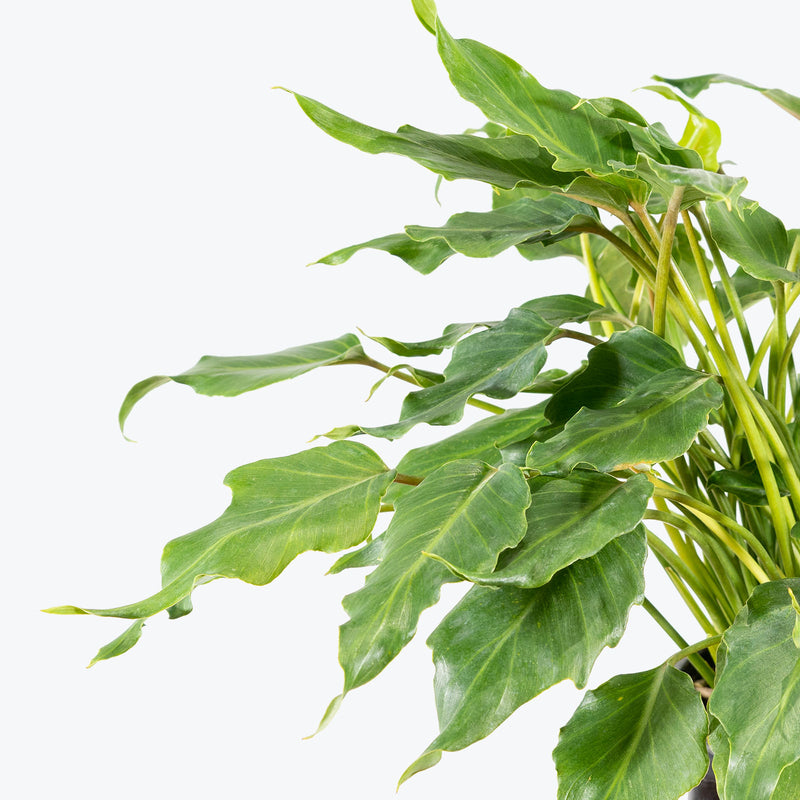
How to care for Philodendron Xanadu
They should not be in a position to see the sun directly, although early morning or late evening sun is fine. Filtered sunlight through a sheer curtain is best and most homes are comprised primarily of indirect sunlight. The best spot for them is where they do not see the sun during the majority of the day but still get bright, indirect light.
They will thrive in bright light, but also can tolerate medium light. A good medium-light place in your home would be in the middle of a room that has a regular size window. They can be placed anywhere between the middle of the room and the window. Remember that plants will grow based on how much light they receive.
They need to be watered when the top half of the soil is dry to the touch. That usually takes about 1 week in an average home environment. It will vary depending on the time of year, your environment and lighting conditions, but it's always safer to underwater or give the soil a check before you water again. Expect to water more often in brighter light and less often in lower light.
They can live in any average home humidity condition and are fairly hardy.
This Philodendron is very easy, perfect for beginners! Rotate your plant every week or so to encourage even, consistent, and healthy growth. Allow the soil to dry out more between waterings during the winter seasons.
This plant is moderately toxic and can cause some adverse reactions when ingested so it is best to not let your pets eat it, which we advise for all plants in general. The severity of the reaction will depend on how much of the plant is ingested but, if you know your pet typically does not eat your plants, this plant will be suitable for your home..
Learn MoreView PlantPhilodendron Yellow Ghost
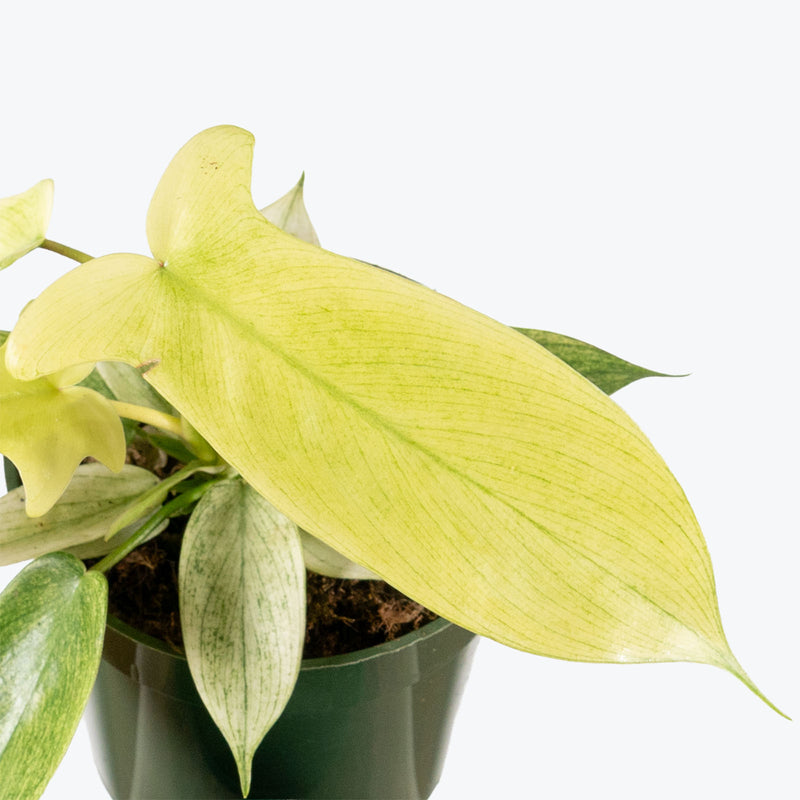
How to care for Philodendron Yellow Ghost
Philodendron Yellow Ghost should not be in a position to see the sun directly, although early morning or late evening sun is fine. Filtered sunlight through a sheer curtain is best and most homes are comprised primarily of indirect sunlight. The best spot for them is where they do not see the sun during the majority of the day but still get bright, indirect light.
Philodendron Yellow Ghost will thrive in bright light, but also can tolerate medium light. A good medium-light place in your home would be in the middle of a room that has a regular size window. They can be placed anywhere between the middle of the room and the window. Remember that plants will grow based on how much light they receive.
Philodendron Yellow Ghost needs to be watered when the top half of the soil is dry to the touch. That usually takes about 1 week in an average home environment. It will vary depending on the time of year, your environment and lighting conditions, but it's always safer to underwater or give the soil a check before you water again. Expect to water more often in brighter light and less often in lower light.
Philodendron Yellow Ghost will do well in average humidity environments but will appreciate a little bit of humidity if provided, give them a mist daily or get a humidifier.
Philodendron Yellow Ghost’s stunning white foliage means less chlorophyll, so it grows more slowly than greener Philodendrons. Provide consistent warmth, humidity, and bright light to keep its unique colours vibrant. Rotate the plant regularly for even growth, and fertilize lightly during the growing season to support its energy needs.
Philodendron Yellow Ghost is moderately toxic and can cause some adverse reactions when ingested so it is best to not let your pets eat it, which we advise for all plants in general. The severity of the reaction will depend on how much of the plant is ingested but, if you know your pet typically does not eat your plants, this plant will be suitable for your home..
Learn MoreView PlantPickle Cactus
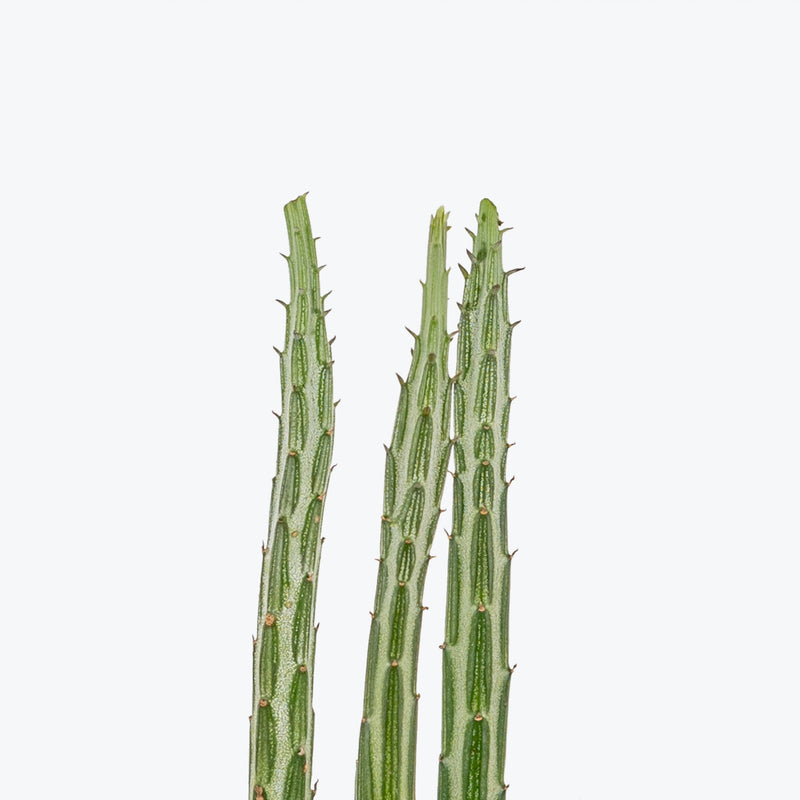
How to care for Pickle Cactus
They love as much sun as possible. The best spot for them is where they can see the sun during the majority of the day.
They will do best in bright light. A nice bright place inside your home would be on the window sill or a stool that is right next to a window, either with or without blinds, depending on if the plant can handle sun. Remember that plants will grow based on how much light they receive.
They like the soil to be completely dry before the next watering. That usually takes about 4 weeks in an average home environment. It will vary depending on the time of year, your environment and lighting conditions, but for them, it's always safer to underwater or water when you see signs of lack of water (i.e. wrinkly or soft leaves). Water a little more often in the warmer months.
Their humidity requirement is low, so do not mist them or put them in a terrarium.
The taller the stems grow, the more they tend to start getting floppy. They should be pruned back towards the firmer half of the stem during early spring, producing offshoots protruding from the stem over time.
You can feel comfortable having this plant around your home in the potential case where your pet feels like nibbling on it. However, we typically recommend keeping your pets from eating any of your houseplants..
Learn MoreView PlantPickle Plant
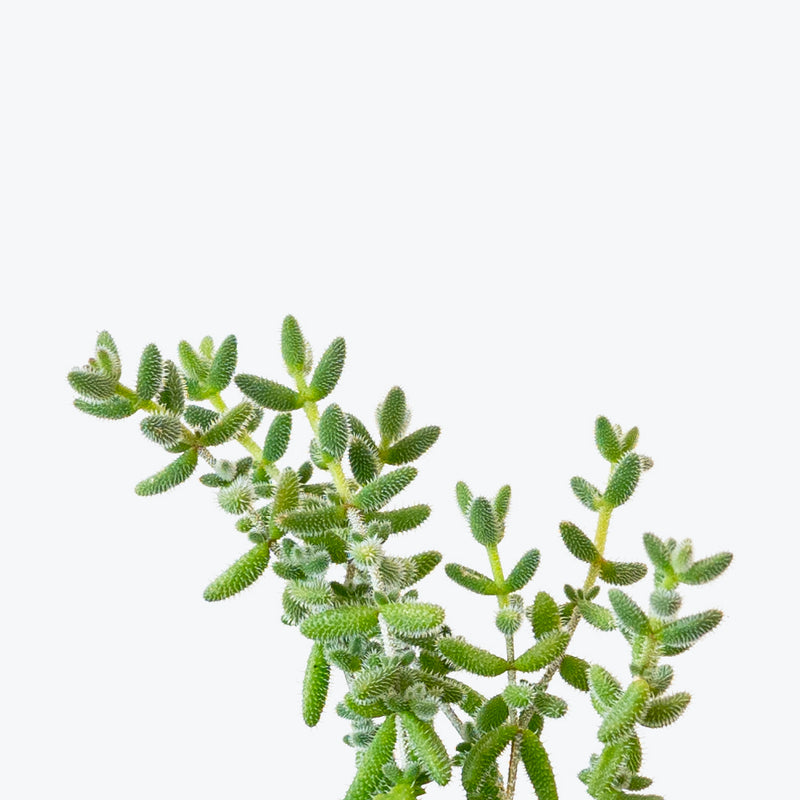
How to care for Pickle Plant
They love as much sun as possible. The best spot for them is where they can see the sun during the majority of the day.
They will do best in bright light. A nice bright place inside your home would be on the window sill or a stool that is right next to a window, either with or without blinds, depending on if the plant can handle sun. Remember that plants will grow based on how much light they receive.
They like the soil to be completely dry before the next watering. That usually takes about 4 weeks in an average home environment. It will vary depending on the time of year, your environment and lighting conditions, but for them, it's always safer to underwater or water when you see signs of lack of water (i.e. wrinkly or soft leaves). Water a little more often in the warmer months.
Their humidity requirement is low, so do not mist them or put them in a terrarium.
In spring and summer, give it a monthly feed with liquid fertilizer to help it grow (make sure to use fertilizer made for succulents). Trim off any leggy growth to encourage a fuller plant!
This plant is moderately toxic and can cause some adverse reactions when ingested so it is best to not let your pets eat it, which we advise for all plants in general. The severity of the reaction will depend on how much of the plant is ingested but, if you know your pet typically does not eat your plants, this plant will be suitable for your home..
View PlantPilea Bronze
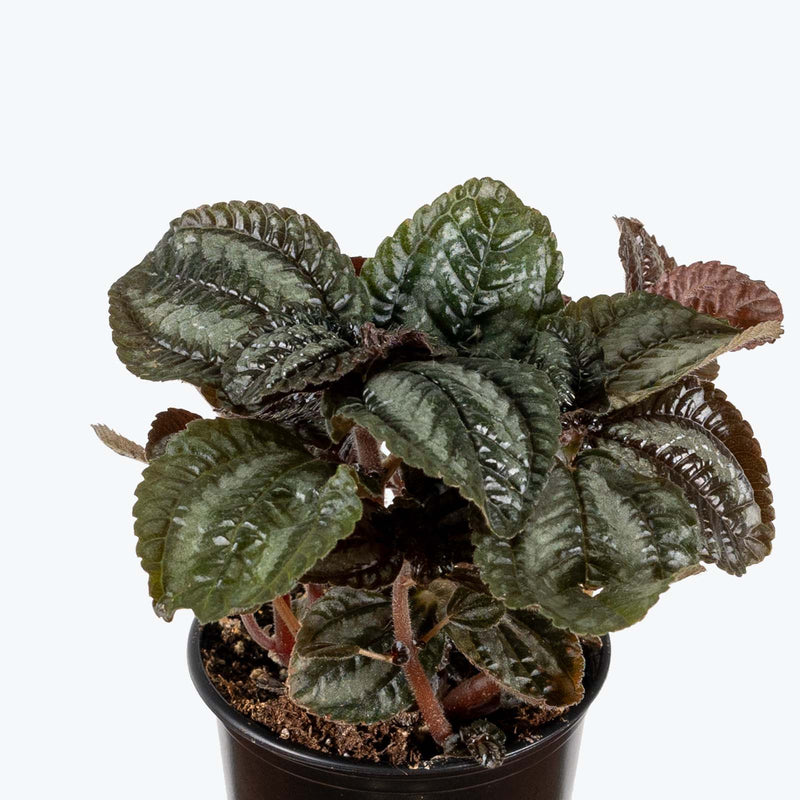
How to care for Pilea Bronze
They should not be in a position to see the sun directly, although early morning or late evening sun is fine. Filtered sunlight through a sheer curtain is best and most homes are comprised primarily of indirect sunlight. The best spot for them is where they do not see the sun during the majority of the day but still get bright, indirect light.
They will do well in medium light but will grow faster with brighter light. A good medium-light place in your home would be in the middle of a room that has a regular size window. Remember that plants will grow based on how much light they receive.
They need to be watered when the top half of the soil is dry to the touch. That usually takes about 1 week in an average home environment. It will vary depending on the time of year, your environment and lighting conditions, but it's always safer to underwater or give the soil a check before you water again. Expect to water more often in brighter light and less often in lower light.
They will do well in average humidity environments but will appreciate a little bit of humidity if provided, give them a mist daily or get a humidifier.
Avoid placing your Bronze Pilea in direct sunlight, which can cause leaf scorching. Feed with a balanced houseplant fertilizer during the growing season for optimal growth.
You can feel comfortable having this plant around your home in the potential case where your pet feels like nibbling on it. However, we typically recommend keeping your pets from eating any of your houseplants..
View PlantPilea Cadierei Aluminum Plant

How to care for Pilea Cadierei Aluminum Plant
They should not be in a position to see the sun directly, although early morning or late evening sun is fine. Filtered sunlight through a sheer curtain is best and most homes are comprised primarily of indirect sunlight. The best spot for them is where they do not see the sun during the majority of the day but still get bright, indirect light.
They will do well in medium light but will grow faster with brighter light. A good medium-light place in your home would be in the middle of a room that has a regular size window. Remember that plants will grow based on how much light they receive.
They need to be watered when the top half of the soil is dry to the touch. That usually takes about 1 week in an average home environment. It will vary depending on the time of year, your environment and lighting conditions, but it's always safer to underwater or give the soil a check before you water again. Expect to water more often in brighter light and less often in lower light.
They will do well in average humidity environments but will appreciate a little bit of humidity if provided, give them a mist daily or get a humidifier.
To keep your Aluminum Plant looking compact and vibrant, pinch back leggy stems regularly to encourage bushier growth. Use a well-draining potting mix, and water consistently — but avoid soggy soil. Clean the leaves occasionally to keep their metallic sheen bright. Fertilize every 4–6 weeks during the growing season to support lush foliage. It’s a fast grower in the right conditions and perfect for plant lovers who enjoy shaping and styling their greenery.
You can feel comfortable having this plant around your home in the potential case where your pet feels like nibbling on it. However, we typically recommend keeping your pets from eating any of your houseplants..
View PlantPilea Cadierei Aluminum Plant Variegated
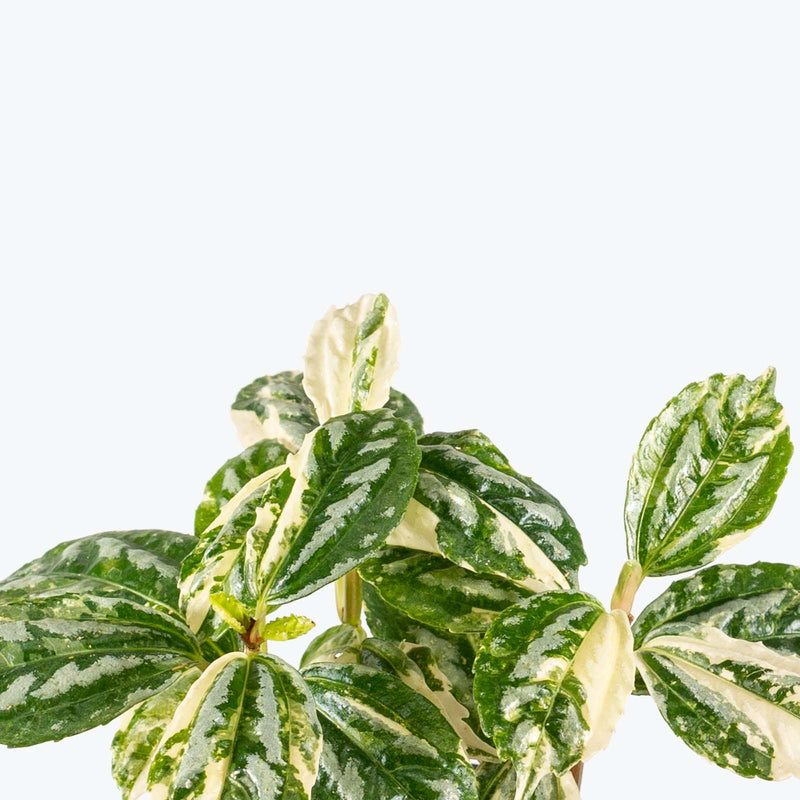
How to care for Pilea Cadierei Aluminum Plant Variegated
They should not be in a position to see the sun directly, although early morning or late evening sun is fine. Filtered sunlight through a sheer curtain is best and most homes are comprised primarily of indirect sunlight. The best spot for them is where they do not see the sun during the majority of the day but still get bright, indirect light.
They will thrive in bright light, but also can tolerate medium light. A good medium-light place in your home would be in the middle of a room that has a regular size window. They can be placed anywhere between the middle of the room and the window. Remember that plants will grow based on how much light they receive.
They need to be watered when the top half of the soil is dry to the touch. That usually takes about 1 week in an average home environment. It will vary depending on the time of year, your environment and lighting conditions, but it's always safer to underwater or give the soil a check before you water again. Expect to water more often in brighter light and less often in lower light.
They will do well in average humidity environments but will appreciate a little bit of humidity if provided, give them a mist daily or get a humidifier.
Allow the soil to dry out more during the winter season. To encourage healthy leaf growth, annual pruning to half of the stem's normal length will allow for fuller growth.
You can feel comfortable having this plant around your home in the potential case where your pet feels like nibbling on it. However, we typically recommend keeping your pets from eating any of your houseplants..
View PlantPilea Depressa Baby Tears
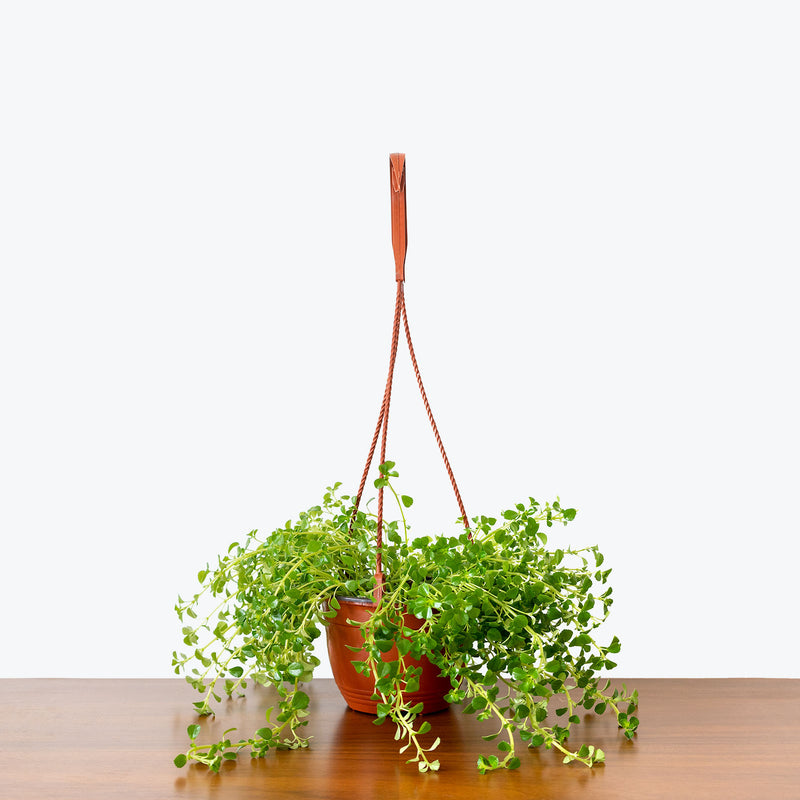
How to care for Pilea Depressa Baby Tears
They should not be in a position to see the sun directly, although early morning or late evening sun is fine. Filtered sunlight through a sheer curtain is best and most homes are comprised primarily of indirect sunlight. The best spot for them is where they do not see the sun during the majority of the day but still get bright, indirect light.
They will do well in medium light but will grow faster with brighter light. A good medium-light place in your home would be in the middle of a room that has a regular size window. Remember that plants will grow based on how much light they receive.
They need to be watered when the top half of the soil is dry to the touch. That usually takes about 1 week in an average home environment. It will vary depending on the time of year, your environment and lighting conditions, but it's always safer to give the soil a check before you water again. Expect to water more often in brighter light and less often in lower light.
They will do well in average humidity environments but will appreciate a little bit of humidity if provided, give them a mist daily or get a humidifier. Make sure to place it in a location that is warm.
During the summer months never let the soil dry out fully, but allow it to dry at least 2 inches down before you water deeply. Avoid soggy soil at all costs! Prune the leggy stems if the foliage is not very dense.
You can feel comfortable having this plant around your home in the potential case where your pet feels like nibbling on it. However, we typically recommend keeping your pets from eating any of your houseplants..
View PlantPilea Glauca Aquamarine
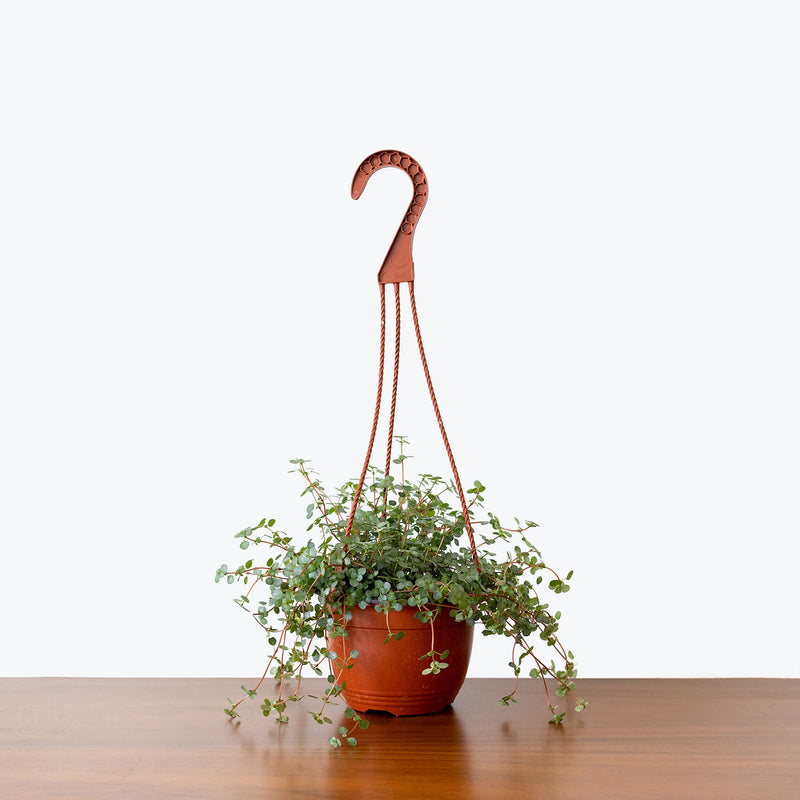
How to care for Pilea Glauca Aquamarine
They should not be in a position to see the sun directly, although early morning or late evening sun is fine. Filtered sunlight through a sheer curtain is best and most homes are comprised primarily of indirect sunlight. The best spot for them is where they do not see the sun during the majority of the day but still get bright, indirect light.
They will do well in medium light but will grow faster with brighter light. A good medium-light place in your home would be in the middle of a room that has a regular size window. Remember that plants will grow based on how much light they receive.
They need to be watered when the top half of the soil is dry to the touch. That usually takes about 1 week in an average home environment. It will vary depending on the time of year, your environment and lighting conditions, but it's always safer to underwater or give the soil a check before you water again. Expect to water more often in brighter light and less often in lower light.
They will do well in average humidity environments but will appreciate a little bit of humidity if provided, give them a mist daily or get a humidifier.
During the summer months never let the soil dry out fully, but allow it to dry at least 2 inches down before you water deeply. Avoid soggy soil at all costs! Prune the leggy stems if the foliage is not very dense.
You can feel comfortable having this plant around your home in the potential case where your pet feels like nibbling on it. However, we typically recommend keeping your pets from eating any of your houseplants..
View PlantPilea Moon Valley
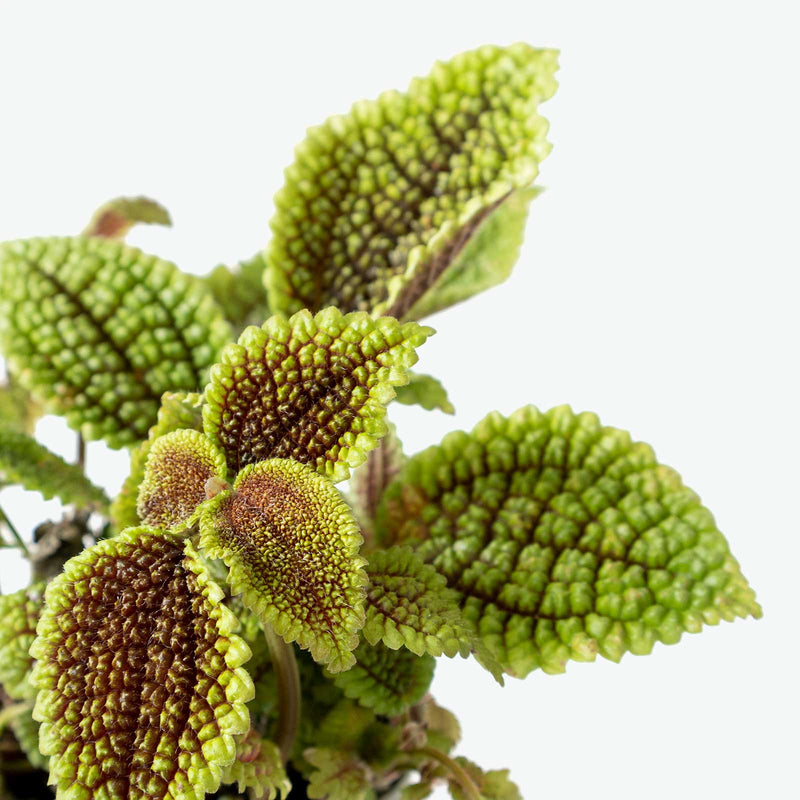
How to care for Pilea Moon Valley
Pilea Moon Valley should not be in a position to see the sun directly, although early morning or late evening sun is fine. Filtered sunlight through a sheer curtain is best and most homes are comprised primarily of indirect sunlight. The best spot for them is where they do not see the sun during the majority of the day but still get bright, indirect light.
Pilea Moon Valley will do well in medium light but will grow faster with brighter light. A good medium-light place in your home would be in the middle of a room that has a regular size window. Remember that plants will grow based on how much light they receive.
Pilea Moon Valley needs to be watered when the top half of the soil is dry to the touch. That usually takes about 1 week in an average home environment. It will vary depending on the time of year, your environment and lighting conditions, but it's always safer to underwater or give the soil a check before you water again. Expect to water more often in brighter light and less often in lower light.
Pilea Moon Valley will do well in average humidity environments but will appreciate a little bit of humidity if provided, give them a mist daily or get a humidifier.
Like most plants, Pilea leaves start to face toward the light as the plant grows. If you want your Pilea Moon Valley growth to stay full and even (rather than all facing one way) rotate the pot every few days. Increase the humidity if leaf edges start to get crispy. Pruning is not typically necessary, but you can pinch back the tips to encourage a bushier growth if the plant becomes leggy.
You can feel comfortable having Pilea Moon Valley around your home in the potential case where your pet feels like nibbling on it. However, we typically recommend keeping your pets from eating any of your houseplants..
View PlantPilea Peperomioides
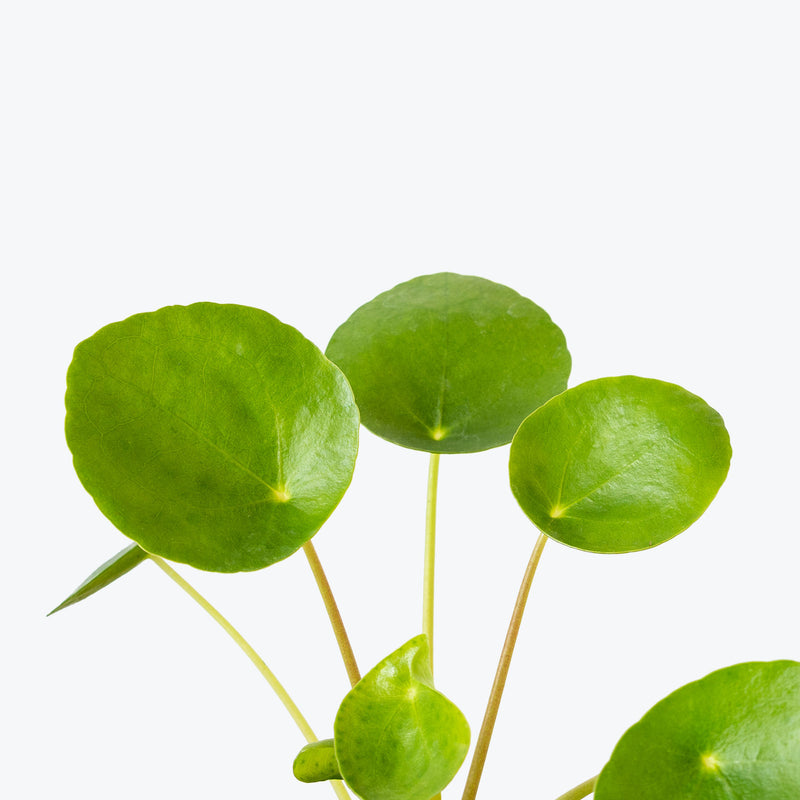
How to care for Pilea Peperomioides
Pilea Peperomioides enjoy some direct sun, but they'll also do well in bright, indirect light. It is best to place this plant somewhere where it will receive some nice morning sun, or a couple hours of afternoon sun, and then indirect light the rest of the day.
Pilea Peperomioides will do well in medium light but will grow faster with brighter light. A good medium-light place in your home would be in the middle of a room that has a regular size window. Remember that plants will grow based on how much light they receive.
Pilea Peperomioides like the soil to be relatively dry before the next watering. That usually takes about 2 weeks in an average home environment. It will vary depending on the time of year, your environment and lighting conditions, but for them, it's always safer to underwater or water when you see signs of lack of water (i.e. droopy, floppy, or soft leaves). Expect to water more often in brighter light and less often in lower light.
Pilea Peperomioides will do well in average humidity environments but will appreciate a little bit of humidity if provided, give them a mist daily or get a humidifier.
Like most plants, Pilea Peperomioides' leaves start to face toward the light as the plant grows. If you want your Pilea Peperomioides growth to stay full and even (rather than all facing one way) rotate the pot every few days. Increase the humidity if the leaf edges are crisp and provide more light if you start seeing white dots on the leaf.
You can feel comfortable having Pilea Peperomioides around your home in the potential case where your pet feels like nibbling on it. However, we typically recommend keeping your pets from eating any of your houseplants..
View PlantPineapple Lava Flow
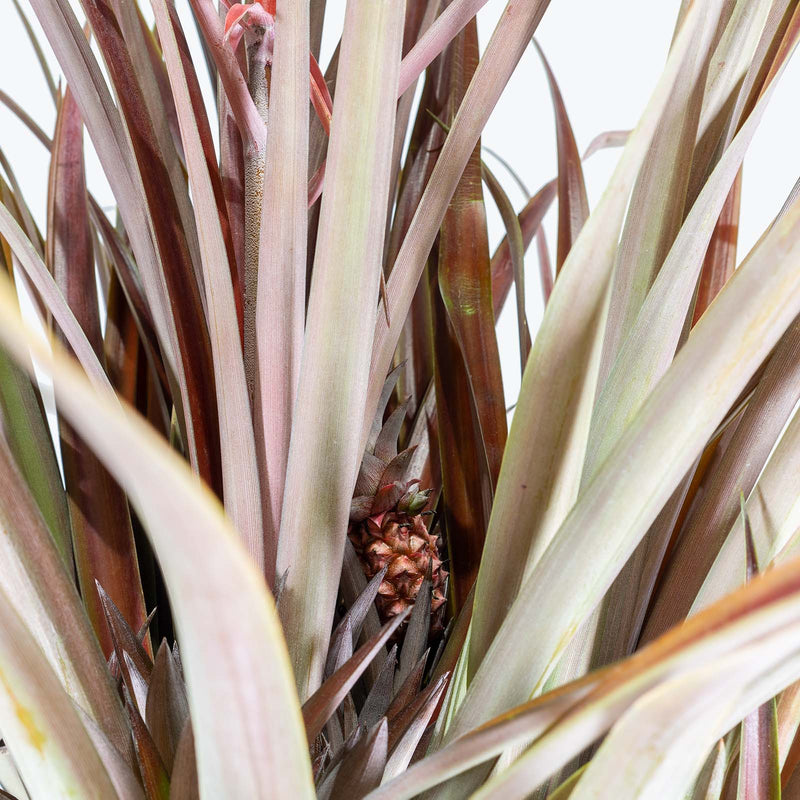
How to care for Pineapple Lava Flow
They love as much sun as possible. The best spot for them is where they can see the sun during the majority of the day.
They will do best in bright light. A nice bright place inside your home would be on the window sill or a stool that is right next to a window, either with or without blinds, depending on if the plant can handle sun. Remember that plants will grow based on how much light they receive.
They like the soil to be relatively dry before the next watering. That usually takes about 2 weeks in an average home environment. It will vary depending on the time of year, your environment and lighting conditions, but for them, it's always safer to underwater or water when you see signs of lack of water (i.e. droopy, floppy, or soft leaves). Expect to water more often in brighter light and less often in lower light.
Being a tropical plant, Pineapple 'Lava Flow' enjoys a humid environment. However, it can tolerate a wide range of humidity conditions.
Pineapple 'Lava Flow' is not frost-tolerant and should be brought indoors if temperatures drop below 60°F (15°C). If grown indoors, consider providing supplemental light during the winter months to support its growth.
You can feel comfortable having this plant around your home in the potential case where your pet feels like nibbling on it. However, we typically recommend keeping your pets from eating any of your houseplants..
View PlantPineapple Plant
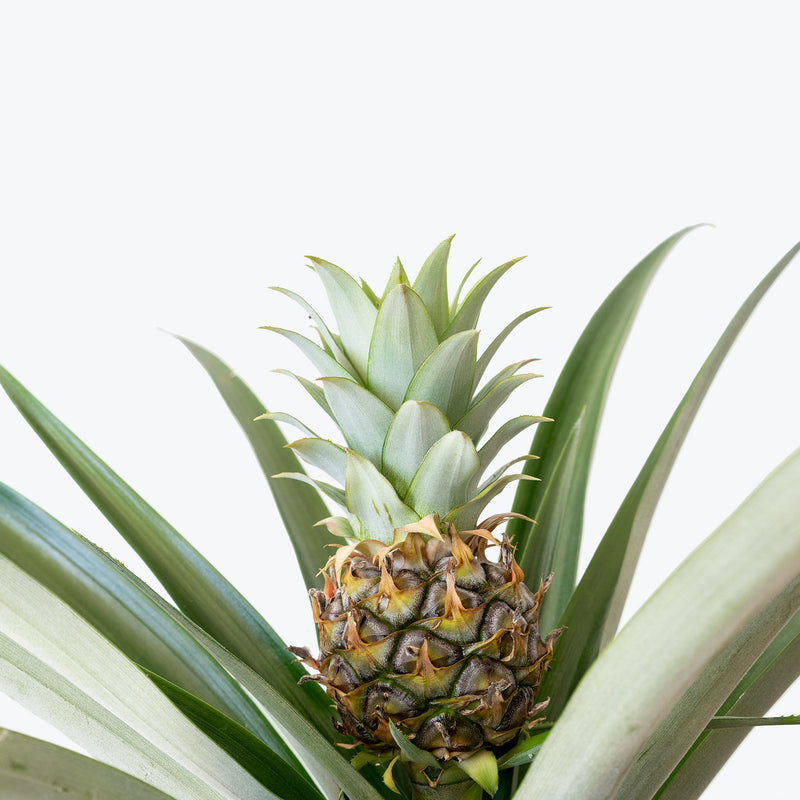
How to care for Pineapple Plant
Pineapple Plant loves as much sun as possible. The best spot for them is where they can see the sun during the majority of the day.
Pineapple Plant will do best in bright light. A nice bright place inside your home would be on the window sill or a stool that is right next to a window, either with or without blinds, depending on if the plant can handle sun. Remember that plants will grow based on how much light they receive.
Pineapple Plant needs to be watered when the top half of the soil is dry to the touch. That usually takes about 1 week in an average home environment. It will vary depending on the time of year, your environment and lighting conditions, but it's always safer to underwater or give the soil a check before you water again. Expect to water more often in brighter light and less often in lower light.
Pineapple Plant will do well in average humidity environments but will appreciate a little bit of humidity if provided, give them a mist daily or get a humidifier. They also prefer warm locations.
Once the Pineapple Plant flowers, you have to wait for another six months for the fruit to mature. Growing pineapples for fruit sure is a long term investment. The fruit is ready to pick when it starts to turn yellow. If the plant is indoors, rotate it periodically to ensure even growth.
You can feel comfortable having Pineapple Plant around your home in the potential case where your pet feels like nibbling on it. However, we typically recommend keeping your pets from eating any of your houseplants..
View PlantPinguicula Agnata True Blue
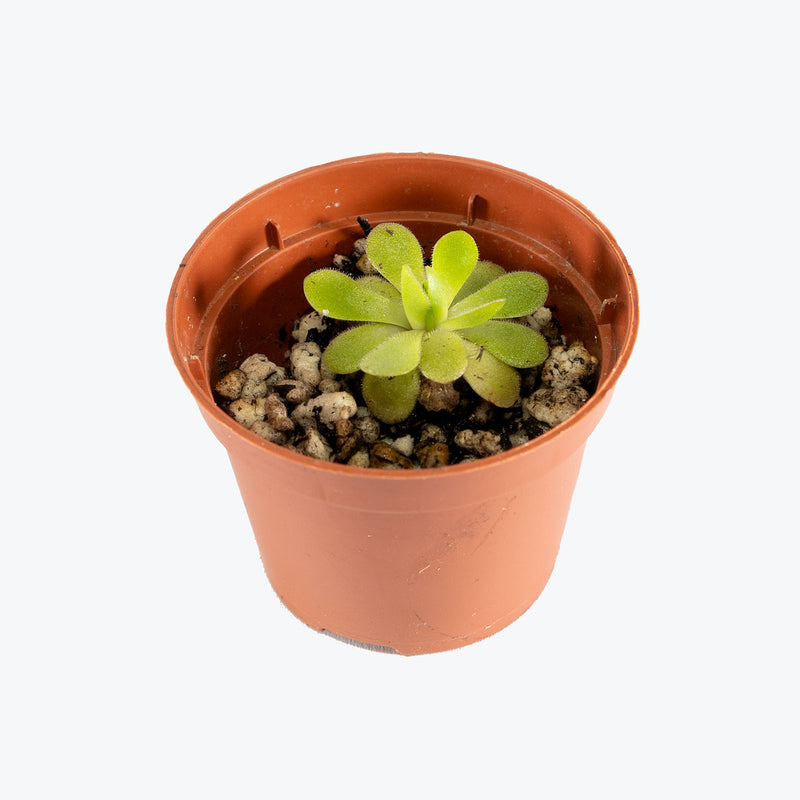
How to care for Pinguicula Agnata True Blue
Pinguicula Agnata True Blue should not be in a position to see the sun directly, although early morning or late evening sun is fine. Filtered sunlight through a sheer curtain is best and most homes are comprised primarily of indirect sunlight. The best spot for them is where they do not see the sun during the majority of the day but still get bright, indirect light.
Pinguicula Agnata True Blue will thrive in bright light, but also can tolerate medium light. A good medium-light place in your home would be in the middle of a room that has a regular size window. They can be placed anywhere between the middle of the room and the window. Remember that plants will grow based on how much light they receive.
Allow the top quarter of the soil to dry before watering Pinguicula Agnata True Blue again. This usually takes about 3 - 4 days in an average home environment. It will vary depending on the time of year, your environment and lighting conditions. Expect to water more often in brighter light and less often in lower light.
Pinguicula Agnata True Blue likes a high humidity environment, which supports its mucilage production for effective insect trapping. Maintaining a high humidity environment can be achieved through regular misting, using a pebble tray, or employing a humidifier. Although they won't die if they don't receive enough humidity, their leaves may have some dry, crunchy, or yellow edges.
During the winter, when Pinguicula Agnata True Blue may enter a slightly dormant phase, reduce watering but ensure the soil does not completely dry out. Feed occasionally with insects or a specially formulated carnivorous plant food diluted to a quarter strength. No need for regular fertilizers. The plant will appreciate being repotted every couple of years in fresh carnivorous plant soil to prevent mineral buildup and maintain health. Ensure sufficient airflow, especially at higher humidity, to prevent leaf rot. Use distilled or rainwater to maintain moist soil, as tap water can often contain minerals that are harmful to carnivorous plants.
You can feel comfortable having Pinguicula Agnata True Blue around your home in the potential case where your pet feels like nibbling on it. However, we typically recommend keeping your pets from eating any of your houseplants..
View PlantPinguicula Aphrodite

How to care for Pinguicula Aphrodite
Pinguicula Aphrodite should not be in a position to see the sun directly, although early morning or late evening sun is fine. Filtered sunlight through a sheer curtain is best and most homes are comprised primarily of indirect sunlight. The best spot for them is where they do not see the sun during the majority of the day but still get bright, indirect light.
Pinguicula Aphrodite will thrive in bright light, but also can tolerate medium light. A good medium-light place in your home would be in the middle of a room that has a regular size window. They can be placed anywhere between the middle of the room and the window. Remember that plants will grow based on how much light they receive.
Allow the top quarter of the soil to dry before watering Pinguicula Aphrodite again. This usually takes about 3 - 4 days in an average home environment. It will vary depending on the time of year, your environment and lighting conditions. Expect to water more often in brighter light and less often in lower light.
Pinguicula Aphrodite will do well in average humidity environments but will appreciate a little bit of humidity if provided, give them a mist daily or get a humidifier.
Pinguicula Aphrodite prefers loose, airy, alkaline soil — a mix of sand, perlite, and crushed limestone works well. Water with pure water (distilled or rain) and allow the soil to stay just damp during summer, drying slightly between waterings in winter. Keep it in a warm, bright spot out of direct afternoon sun. Aphrodite often blooms year-round, so remove faded flowers to encourage new ones. Don’t fertilize the soil; instead, let it feed on gnats or small insects — or add the occasional fish food flake directly to a leaf.
You can feel comfortable having Pinguicula Aphrodite around your home in the potential case where your pet feels like nibbling on it. However, we typically recommend keeping your pets from eating any of your houseplants..
View PlantPinguicula Blush
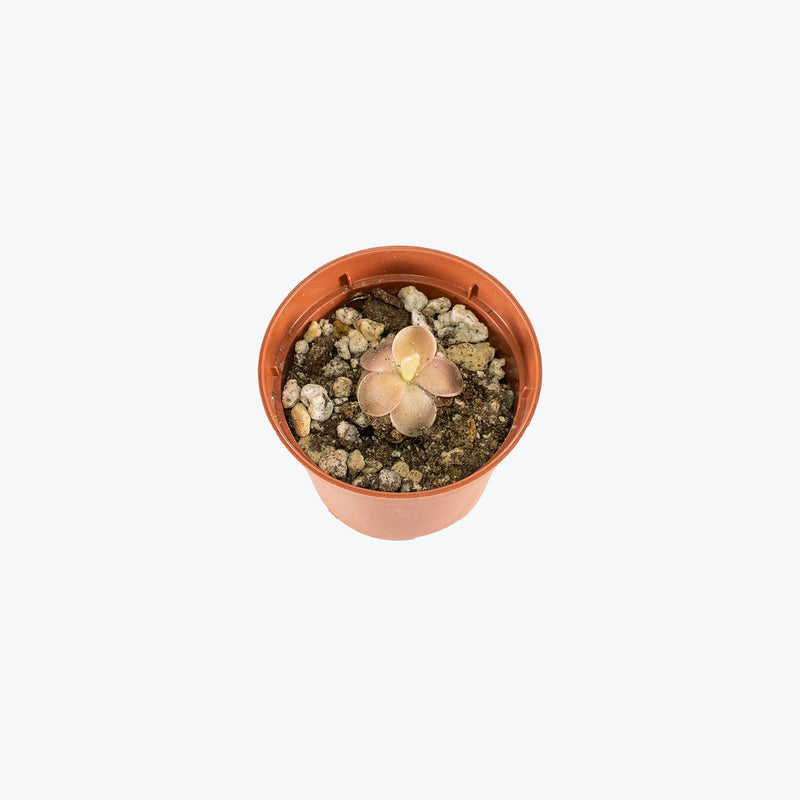
How to care for Pinguicula Blush
Pinguicula Blush should not be in a position to see the sun directly, although early morning or late evening sun is fine. Filtered sunlight through a sheer curtain is best and most homes are comprised primarily of indirect sunlight. The best spot for them is where they do not see the sun during the majority of the day but still get bright, indirect light.
Pinguicula Blush will thrive in bright light, but also can tolerate medium light. A good medium-light place in your home would be in the middle of a room that has a regular size window. They can be placed anywhere between the middle of the room and the window. Remember that plants will grow based on how much light they receive.
Allow the top quarter of the soil to dry before watering Pinguicula Blush again. This usually takes about 3 - 4 days in an average home environment. It will vary depending on the time of year, your environment and lighting conditions. Expect to water more often in brighter light and less often in lower light.
Pinguicula Blush will do well in average humidity environments but will appreciate a little bit of humidity if provided, give them a mist daily or get a humidifier.
Use a loose, well-draining mix of sand, perlite, and peat or vermiculite. Allow Pinguicula Blush to feed naturally on small insects, or offer an occasional dried insect or diluted foliar feed. Remove dead leaves to keep the rosette fresh. Its subtle pink flush is strongest under good light, making placement key to its beauty.
You can feel comfortable having Pinguicula Blush around your home in the potential case where your pet feels like nibbling on it. However, we typically recommend keeping your pets from eating any of your houseplants..
View PlantPinguicula Caudata x Gigantea
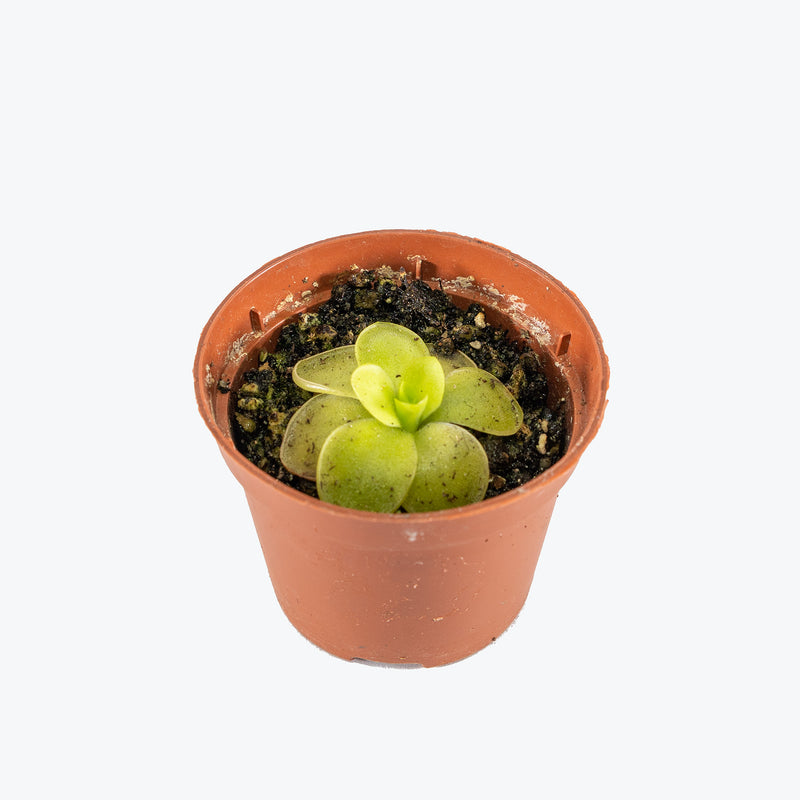
How to care for Pinguicula Caudata x Gigantea
Pinguicula Caudata x Gigantea should not be in a position to see the sun directly, although early morning or late evening sun is fine. Filtered sunlight through a sheer curtain is best and most homes are comprised primarily of indirect sunlight. The best spot for them is where they do not see the sun during the majority of the day but still get bright, indirect light.
Pinguicula Caudata x Gigantea will thrive in bright light, but also can tolerate medium light. A good medium-light place in your home would be in the middle of a room that has a regular size window. They can be placed anywhere between the middle of the room and the window. Remember that plants will grow based on how much light they receive.
Allow the top quarter of the soil to dry before watering Pinguicula Caudata x Gigantea again. This usually takes about 3 - 4 days in an average home environment. It will vary depending on the time of year, your environment and lighting conditions. Expect to water more often in brighter light and less often in lower light.
Pinguicula Caudata x Gigantea likes a high humidity environment, which supports its mucilage production for effective insect trapping. Maintaining a high humidity environment can be achieved through regular misting, using a pebble tray, or employing a humidifier. Although they won't die if they don't receive enough humidity, their leaves may have some dry, crunchy, or yellow edges.
Use a loose, airy carnivorous plant mix (like peat and perlite or sand, no fertilizer). Pinguicula Caudata x Gigantea benefits from warm, bright conditions and should not be overfed — they catch enough food on their own. Reduce watering in winter when they may produce smaller, succulent-like leaves. Repot in spring if the plant outgrows its container.
You can feel comfortable having Pinguicula Caudata x Gigantea around your home in the potential case where your pet feels like nibbling on it. However, we typically recommend keeping your pets from eating any of your houseplants..
View PlantPinguicula Emarginata x Jaumavensis

How to care for Pinguicula Emarginata x Jaumavensis
Pinguicula Emarginata x Jaumavensis should not be in a position to see the sun directly, although early morning or late evening sun is fine. Filtered sunlight through a sheer curtain is best and most homes are comprised primarily of indirect sunlight. The best spot for them is where they do not see the sun during the majority of the day but still get bright, indirect light.
Pinguicula Emarginata x Jaumavensis will thrive in bright light, but also can tolerate medium light. A good medium-light place in your home would be in the middle of a room that has a regular size window. They can be placed anywhere between the middle of the room and the window. Remember that plants will grow based on how much light they receive.
Allow the top quarter of the soil to dry before watering Pinguicula Emarginata x Jaumavensis again. This usually takes about 3 - 4 days in an average home environment. It will vary depending on the time of year, your environment and lighting conditions. Expect to water more often in brighter light and less often in lower light.
Pinguicula Emarginata x Jaumavensis likes a high humidity environment, which supports its mucilage production for effective insect trapping. Maintaining a high humidity environment can be achieved through regular misting, using a pebble tray, or employing a humidifier. Although they won't die if they don't receive enough humidity, their leaves may have some dry, crunchy, or yellow edges.
Avoid touching the leaves as the sticky glands are delicate and can be damaged easily. Repotting Pinguicula Emarginata x Jaumavensis should be done with care, ideally in the spring, using a suitable carnivorous plant soil mix that ensures good drainage. During winter, watch for the development of non-carnivorous leaves and adjust care accordingly. Remove any dead or decaying leaves to prevent fungal infections and promote new growth. Ensure sufficient airflow, especially at higher humidity, to prevent leaf rot. Use distilled or rainwater to maintain moist soil, as tap water can often contain minerals that are harmful to carnivorous plants.
You can feel comfortable having Pinguicula Emarginata x Jaumavensis around your home in the potential case where your pet feels like nibbling on it. However, we typically recommend keeping your pets from eating any of your houseplants..
View PlantPinguicula Esseriana
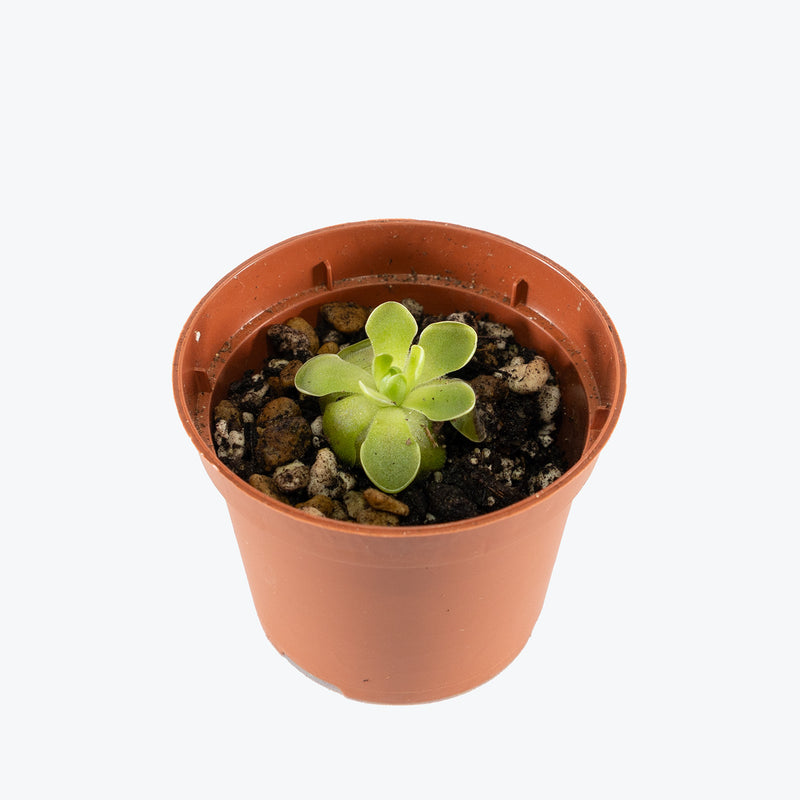
How to care for Pinguicula Esseriana
Pinguicula Esseriana should not be in a position to see the sun directly, although early morning or late evening sun is fine. Filtered sunlight through a sheer curtain is best and most homes are comprised primarily of indirect sunlight. The best spot for them is where they do not see the sun during the majority of the day but still get bright, indirect light.
Pinguicula Esseriana will thrive in bright light, but also can tolerate medium light. A good medium-light place in your home would be in the middle of a room that has a regular size window. They can be placed anywhere between the middle of the room and the window. Remember that plants will grow based on how much light they receive.
Allow the top quarter of the soil to dry before watering Pinguicula Esseriana again. This usually takes about 3 - 4 days in an average home environment. It will vary depending on the time of year, your environment and lighting conditions. Expect to water more often in brighter light and less often in lower light.
Pinguicula Esseriana likes a high humidity environment, which supports its mucilage production for effective insect trapping. Maintaining a high humidity environment can be achieved through regular misting, using a pebble tray, or employing a humidifier. Although they won't die if they don't receive enough humidity, their leaves may have some dry, crunchy, or yellow edges.
Be cautious with repotting Pinguicula Esseriana—only do so when necessary as Butterworts can be sensitive to root disturbance. During winter, watch for the development of non-carnivorous leaves and adjust care accordingly. Remove any dead or decaying leaves to prevent fungal infections and promote new growth. Ensure sufficient airflow, especially at higher humidity, to prevent leaf rot. Use distilled or rainwater to maintain moist soil, as tap water can often contain minerals that are harmful to carnivorous plants.
You can feel comfortable having Pinguicula Esseriana around your home in the potential case where your pet feels like nibbling on it. However, we typically recommend keeping your pets from eating any of your houseplants..
View PlantPinguicula Gigantea
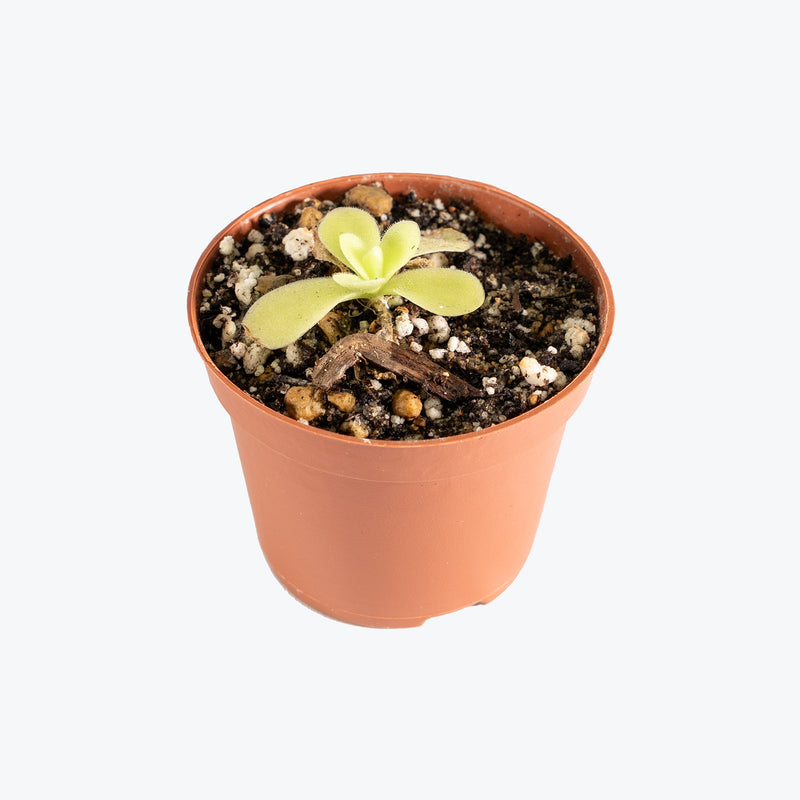
How to care for Pinguicula Gigantea
Pinguicula Gigantea should not be in a position to see the sun directly, although early morning or late evening sun is fine. Filtered sunlight through a sheer curtain is best and most homes are comprised primarily of indirect sunlight. The best spot for them is where they do not see the sun during the majority of the day but still get bright, indirect light.
Pinguicula Gigantea will thrive in bright light, but also can tolerate medium light. A good medium-light place in your home would be in the middle of a room that has a regular size window. They can be placed anywhere between the middle of the room and the window. Remember that plants will grow based on how much light they receive.
Allow the top quarter of the soil to dry before watering Pinguicula Gigantea again. This usually takes about 3 - 4 days in an average home environment. It will vary depending on the time of year, your environment and lighting conditions. Expect to water more often in brighter light and less often in lower light.
Pinguicula Gigantea likes a high humidity environment, which supports its mucilage production for effective insect trapping. Maintaining a high humidity environment can be achieved through regular misting, using a pebble tray, or employing a humidifier. Although they won't die if they don't receive enough humidity, their leaves may have some dry, crunchy, or yellow edges.
Pinguicula Gigantea does not enter a traditional dormancy based on temperature or light, so continue to provide good care year-round, adjusting only the watering slightly during its rest period triggered by less moisture. Repotting every couple of years in fresh carnivorous plant soil can help maintain its health and vigor. Remove any dead or decaying leaves to prevent fungal infections and promote new growth. Avoid the use of standard fertilizers, as P. gigantea obtains necessary nutrients from the insects it captures. Ensure sufficient airflow, especially at higher humidity, to prevent leaf rot. Use distilled or rainwater to maintain moist soil, as tap water can often contain minerals that are harmful to carnivorous plants.
You can feel comfortable having Pinguicula Gigantea around your home in the potential case where your pet feels like nibbling on it. However, we typically recommend keeping your pets from eating any of your houseplants..
View PlantPinguicula Gigantea x Libelulita

How to care for Pinguicula Gigantea x Libelulita
Pinguicula Gigantea x Libelulita should not be in a position to see the sun directly, although early morning or late evening sun is fine. Filtered sunlight through a sheer curtain is best and most homes are comprised primarily of indirect sunlight. The best spot for them is where they do not see the sun during the majority of the day but still get bright, indirect light.
Pinguicula Gigantea x Libelulita will thrive in bright light, but also can tolerate medium light. A good medium-light place in your home would be in the middle of a room that has a regular size window. They can be placed anywhere between the middle of the room and the window. Remember that plants will grow based on how much light they receive.
Allow the top quarter of the soil to dry before watering Pinguicula Gigantea x Libelulita again. This usually takes about 3 - 4 days in an average home environment. It will vary depending on the time of year, your environment and lighting conditions. Expect to water more often in brighter light and less often in lower light.
Pinguicula Gigantea x Libelulita likes a high humidity environment, which supports its mucilage production for effective insect trapping. Maintaining a high humidity environment can be achieved through regular misting, using a pebble tray, or employing a humidifier. Although they won't die if they don't receive enough humidity, their leaves may have some dry, crunchy, or yellow edges.
Fertilization is generally unnecessary as Pinguicula Gigantea x Libelulita obtains nutrients from the insects it captures. If needed, apply a very diluted fertilizer specialized for carnivorous plants during the active growing season. Prune dead or dying leaves to promote healthier growth and prevent potential fungal issues. In winter, when the plant may enter a dormancy phase, reduce watering and allow the top of the soil to dry out slightly between waterings. Ensure sufficient airflow, especially at higher humidity, to prevent leaf rot. Use distilled or rainwater to maintain moist soil, as tap water can often contain minerals that are harmful to carnivorous plants.
You can feel comfortable having Pinguicula Gigantea x Libelulita around your home in the potential case where your pet feels like nibbling on it. However, we typically recommend keeping your pets from eating any of your houseplants..
View PlantPinguicula Gina
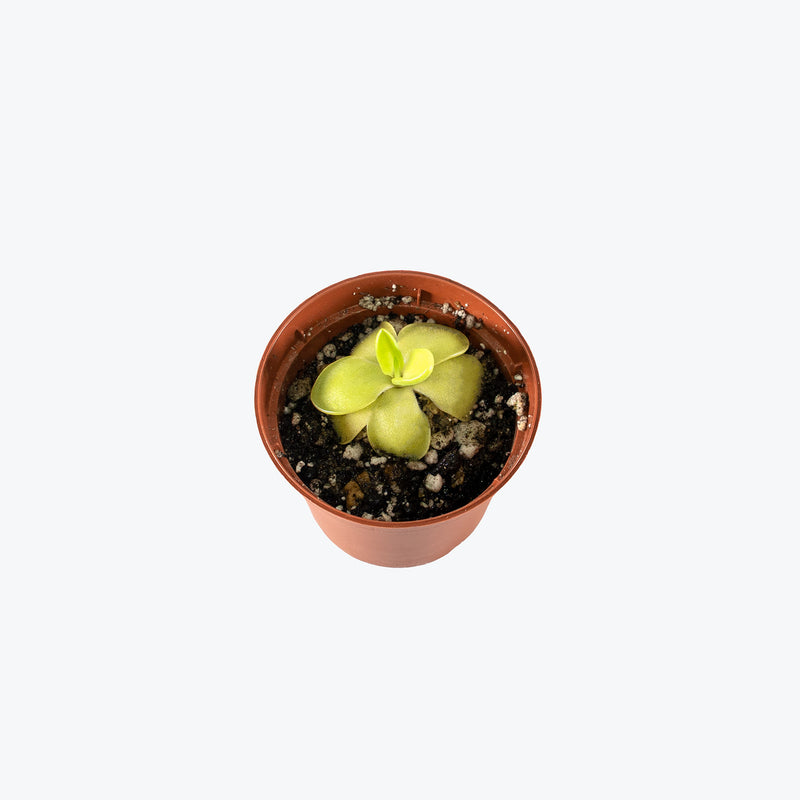
How to care for Pinguicula Gina
Pinguicula Gina should not be in a position to see the sun directly, although early morning or late evening sun is fine. Filtered sunlight through a sheer curtain is best and most homes are comprised primarily of indirect sunlight. The best spot for them is where they do not see the sun during the majority of the day but still get bright, indirect light.
Pinguicula Gina will thrive in bright light, but also can tolerate medium light. A good medium-light place in your home would be in the middle of a room that has a regular size window. They can be placed anywhere between the middle of the room and the window. Remember that plants will grow based on how much light they receive.
Allow the top quarter of the soil to dry before watering Pinguicula Gina again. This usually takes about 3 - 4 days in an average home environment. It will vary depending on the time of year, your environment and lighting conditions. Expect to water more often in brighter light and less often in lower light.
Pinguicula Gina will do well in average humidity environments but will appreciate a little bit of humidity if provided, give them a mist daily or get a humidifier.
Grow in a loose, well-draining mix such as peat with sand or perlite. Allow Pinguicula Gina to naturally catch insects for nutrients, or provide occasional tiny dried insects as a supplement. Remove spent leaves and flowers to maintain a neat rosette. Unlike some butterworts, ‘Gina’ tends to stay attractive year-round with its steady flowering.
You can feel comfortable having Pinguicula Gina around your home in the potential case where your pet feels like nibbling on it. However, we typically recommend keeping your pets from eating any of your houseplants..
View PlantPinguicula Ibarrae
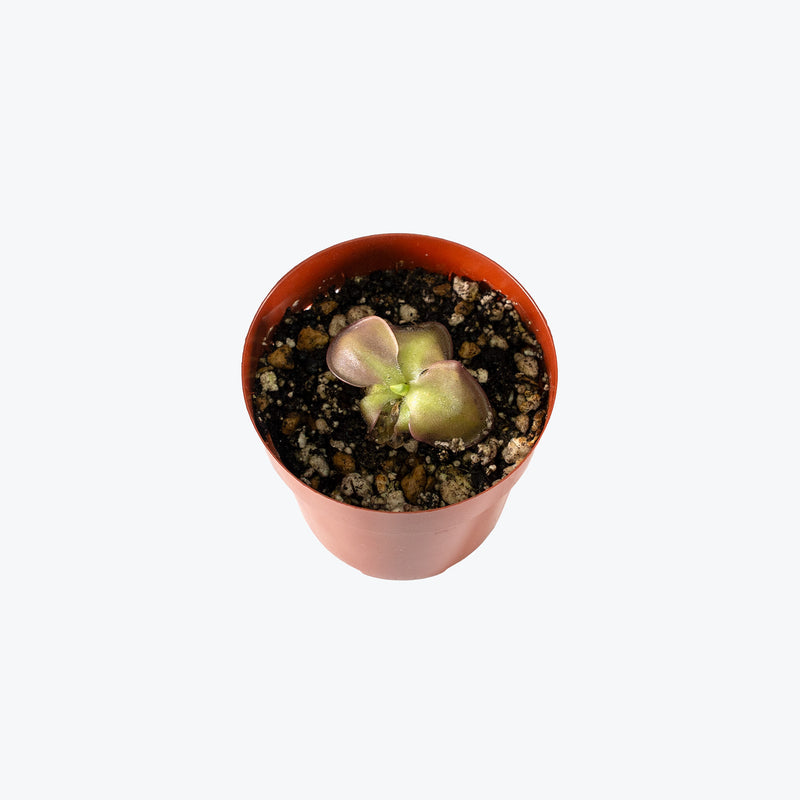
How to care for Pinguicula Ibarrae
Pinguicula Ibarrae should not be in a position to see the sun directly, although early morning or late evening sun is fine. Filtered sunlight through a sheer curtain is best and most homes are comprised primarily of indirect sunlight. The best spot for them is where they do not see the sun during the majority of the day but still get bright, indirect light.
Pinguicula Ibarrae will thrive in bright light, but also can tolerate medium light. A good medium-light place in your home would be in the middle of a room that has a regular size window. They can be placed anywhere between the middle of the room and the window. Remember that plants will grow based on how much light they receive.
Allow the top quarter of the soil to dry before watering Pinguicula Ibarrae again. This usually takes about 3 - 4 days in an average home environment. It will vary depending on the time of year, your environment and lighting conditions. Expect to water more often in brighter light and less often in lower light.
Pinguicula Ibarrae will do well in average humidity environments but will appreciate a little bit of humidity if provided, give them a mist daily or get a humidifier.
Grow in a loose, airy mix such as sand, perlite, and peat or vermiculite. Feed Pinguicula Ibarrae by letting it naturally catch small insects, or offer crushed dried insects or a very diluted foliar feed. Trim away old leaves to keep the plant looking fresh. Flower spikes can be enjoyed for weeks, and occasional light feeding helps promote more blooms.
You can feel comfortable having Pinguicula Ibarrae around your home in the potential case where your pet feels like nibbling on it. However, we typically recommend keeping your pets from eating any of your houseplants..
View PlantPinguicula Johanna
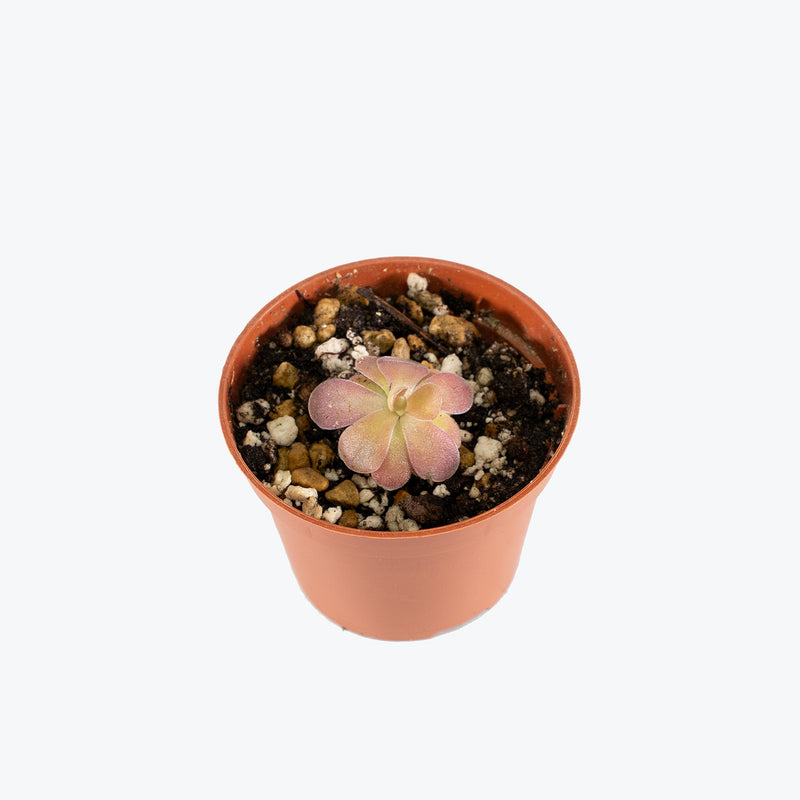
How to care for Pinguicula Johanna
Pinguicula Johanna should not be in a position to see the sun directly, although early morning or late evening sun is fine. Filtered sunlight through a sheer curtain is best and most homes are comprised primarily of indirect sunlight. The best spot for them is where they do not see the sun during the majority of the day but still get bright, indirect light.
Pinguicula Johanna will thrive in bright light, but also can tolerate medium light. A good medium-light place in your home would be in the middle of a room that has a regular size window. They can be placed anywhere between the middle of the room and the window. Remember that plants will grow based on how much light they receive.
Allow the top quarter of the soil to dry before watering Pinguicula Johanna again. This usually takes about 3 - 4 days in an average home environment. It will vary depending on the time of year, your environment and lighting conditions. Expect to water more often in brighter light and less often in lower light.
Pinguicula Johanna likes a high humidity environment, which supports its mucilage production for effective insect trapping. Maintaining a high humidity environment can be achieved through regular misting, using a pebble tray, or employing a humidifier. Although they won't die if they don't receive enough humidity, their leaves may have some dry, crunchy, or yellow edges.
Fertilization is not typically necessary as Pinguicula Johanna gains nutrients from the insects it captures. If you choose to fertilize, use a very diluted solution of organic plant fertilizer. Trim off dead or dying leaves regularly to promote new growth and prevent disease. During winter, the plant may enter a dormancy phase where it produces smaller, non-carnivorous leaves; reduce watering and avoid feeding during this period. Ensure sufficient airflow, especially at higher humidity, to prevent leaf rot. Use distilled or rainwater to maintain moist soil, as tap water can often contain minerals that are harmful to carnivorous plants.
You can feel comfortable having Pinguicula Johanna around your home in the potential case where your pet feels like nibbling on it. However, we typically recommend keeping your pets from eating any of your houseplants..
View PlantPinguicula Moranensis

How to care for Pinguicula Moranensis
Pinguicula Moranensis should not be in a position to see the sun directly, although early morning or late evening sun is fine. Filtered sunlight through a sheer curtain is best and most homes are comprised primarily of indirect sunlight. The best spot for them is where they do not see the sun during the majority of the day but still get bright, indirect light.
Pinguicula Moranensis will thrive in bright light, but also can tolerate medium light. A good medium-light place in your home would be in the middle of a room that has a regular size window. They can be placed anywhere between the middle of the room and the window. Remember that plants will grow based on how much light they receive.
Allow the top quarter of the soil to dry before watering Pinguicula Moranensis again. This usually takes about 3 - 4 days in an average home environment. It will vary depending on the time of year, your environment and lighting conditions. Expect to water more often in brighter light and less often in lower light.
Pinguicula Moranensis likes a high humidity environment, which supports its mucilage production for effective insect trapping. Maintaining a high humidity environment can be achieved through regular misting, using a pebble tray, or employing a humidifier. Although they won't die if they don't receive enough humidity, their leaves may have some dry, crunchy, or yellow edges.
Repotting should be done carefully and only when necessary, as Pinguicula Moranensis can be sensitive to root disturbance. During winter, watch for the development of non-carnivorous leaves and adjust care accordingly. Remove any dead or decaying leaves to prevent fungal infections and promote new growth. Ensure sufficient airflow, especially at higher humidity, to prevent leaf rot. Use distilled or rainwater to maintain moist soil, as tap water can often contain minerals that are harmful to carnivorous plants.
You can feel comfortable having Pinguicula Moranensis around your home in the potential case where your pet feels like nibbling on it. However, we typically recommend keeping your pets from eating any of your houseplants..
View PlantPinguicula PE Formosa

How to care for Pinguicula PE Formosa
Pinguicula PE Formosa should not be in a position to see the sun directly, although early morning or late evening sun is fine. Filtered sunlight through a sheer curtain is best and most homes are comprised primarily of indirect sunlight. The best spot for them is where they do not see the sun during the majority of the day but still get bright, indirect light.
Pinguicula PE Formosa will thrive in bright light, but also can tolerate medium light. A good medium-light place in your home would be in the middle of a room that has a regular size window. They can be placed anywhere between the middle of the room and the window. Remember that plants will grow based on how much light they receive.
Allow the top quarter of the soil to dry before watering Pinguicula PE Formosa again. This usually takes about 3 - 4 days in an average home environment. It will vary depending on the time of year, your environment and lighting conditions. Expect to water more often in brighter light and less often in lower light.
Pinguicula PE Formosa will do well in average humidity environments but will appreciate a little bit of humidity if provided, give them a mist daily or get a humidifier.
Plant Pinguicula PE Formosa in a loose, well-draining, alkaline mix such as sand and perlite, with no added nutrients. Water only with pure water and maintain even moisture year-round. Provide bright, indirect light to bring out the subtle hues of the foliage and encourage compact, symmetrical growth. Do not fertilize — feed with small insects or fish food flakes placed directly on the leaves. Clean up spent leaves occasionally to keep the rosette tidy and prevent rot.
You can feel comfortable having Pinguicula PE Formosa around your home in the potential case where your pet feels like nibbling on it. However, we typically recommend keeping your pets from eating any of your houseplants..
View PlantPinguicula Pirouette
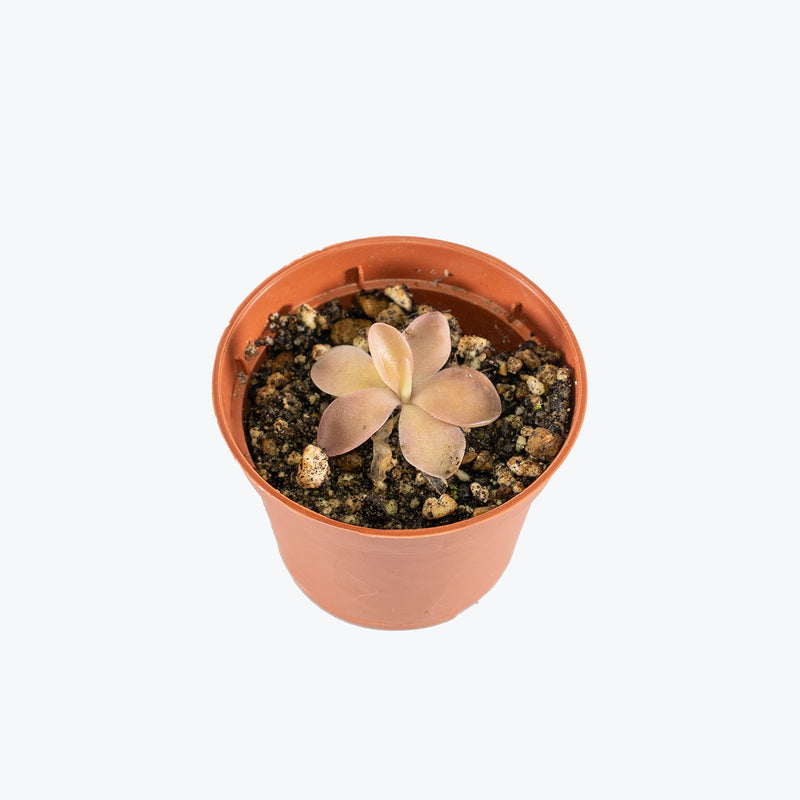
How to care for Pinguicula Pirouette
Pinguicula Pirouette should not be in a position to see the sun directly, although early morning or late evening sun is fine. Filtered sunlight through a sheer curtain is best and most homes are comprised primarily of indirect sunlight. The best spot for them is where they do not see the sun during the majority of the day but still get bright, indirect light.
Pinguicula Pirouette will thrive in bright light, but also can tolerate medium light. A good medium-light place in your home would be in the middle of a room that has a regular size window. They can be placed anywhere between the middle of the room and the window. Remember that plants will grow based on how much light they receive.
Allow the top quarter of the soil to dry before watering Pinguicula Pirouette again. This usually takes about 3 - 4 days in an average home environment. It will vary depending on the time of year, your environment and lighting conditions. Expect to water more often in brighter light and less often in lower light.
Pinguicula Pirouette likes a high humidity environment, which supports its mucilage production for effective insect trapping. Maintaining a high humidity environment can be achieved through regular misting, using a pebble tray, or employing a humidifier. Although they won't die if they don't receive enough humidity, their leaves may have some dry, crunchy, or yellow edges.
Fertilization is typically not necessary because Pinguicula Pirouette derives nutrients from the insects it captures. If you choose to fertilize, use a very diluted solution made for carnivorous plants during the growing season. Prune any dead or dying leaves to maintain health and aesthetics. Ensure sufficient airflow, especially at higher humidity, to prevent leaf rot. Use distilled or rainwater to maintain moist soil, as tap water can often contain minerals that are harmful to carnivorous plants.
You can feel comfortable having Pinguicula Pirouette around your home in the potential case where your pet feels like nibbling on it. However, we typically recommend keeping your pets from eating any of your houseplants..
View PlantPinguicula Sethos x Primuliflora

How to care for Pinguicula Sethos x Primuliflora
Pinguicula Sethos x Primuliflora should not be in a position to see the sun directly, although early morning or late evening sun is fine. Filtered sunlight through a sheer curtain is best and most homes are comprised primarily of indirect sunlight. The best spot for them is where they do not see the sun during the majority of the day but still get bright, indirect light.
Pinguicula Sethos x Primuliflora will thrive in bright light, but also can tolerate medium light. A good medium-light place in your home would be in the middle of a room that has a regular size window. They can be placed anywhere between the middle of the room and the window. Remember that plants will grow based on how much light they receive.
Allow the top quarter of the soil to dry before watering Pinguicula Sethos x Primuliflora again. This usually takes about 3 - 4 days in an average home environment. It will vary depending on the time of year, your environment and lighting conditions. Expect to water more often in brighter light and less often in lower light.
Pinguicula Sethos x Primuliflora will do well in average humidity environments but will appreciate a little bit of humidity if provided, give them a mist daily or get a humidifier.
Use a well-aerated, alkaline soil mix (such as sand, perlite, and a bit of crushed limestone). Water with pure water and avoid letting the soil dry out completely. Provide bright, indirect light to bring out rosy tones in the leaves and support flowering. Do not fertilize the soil — these plants prefer to catch their own food. You can feed them small insects or occasional fish flakes directly on the leaves. Trim any dead or browning leaves to keep the rosette tidy and healthy.
You can feel comfortable having Pinguicula Sethos x Primuliflora around your home in the potential case where your pet feels like nibbling on it. However, we typically recommend keeping your pets from eating any of your houseplants..
View PlantPinguicula Titan

How to care for Pinguicula Titan
Pinguicula Titan should not be in a position to see the sun directly, although early morning or late evening sun is fine. Filtered sunlight through a sheer curtain is best and most homes are comprised primarily of indirect sunlight. The best spot for them is where they do not see the sun during the majority of the day but still get bright, indirect light.
Pinguicula Titan will thrive in bright light, but also can tolerate medium light. A good medium-light place in your home would be in the middle of a room that has a regular size window. They can be placed anywhere between the middle of the room and the window. Remember that plants will grow based on how much light they receive.
Allow the top quarter of the soil to dry before watering Pinguicula Titan again. This usually takes about 3 - 4 days in an average home environment. It will vary depending on the time of year, your environment and lighting conditions. Expect to water more often in brighter light and less often in lower light.
Pinguicula Titan likes a high humidity environment, which supports its mucilage production for effective insect trapping. Maintaining a high humidity environment can be achieved through regular misting, using a pebble tray, or employing a humidifier. Although they won't die if they don't receive enough humidity, their leaves may have some dry, crunchy, or yellow edges.
Avoid touching the leaves as the sticky glands are delicate and can be damaged easily. Repotting Pinguicula Titan should be done with care, ideally in the spring, using a suitable carnivorous plant soil mix that ensures good drainage. During its dormant period, observe the plant for the formation of a hibernaculum and reduce watering accordingly. Remove any dead or decaying leaves to prevent fungal infections and promote new growth. Ensure sufficient airflow, especially at higher humidity, to prevent leaf rot. Use distilled or rainwater to maintain moist soil, as tap water can often contain minerals that are harmful to carnivorous plants.
You can feel comfortable having Pinguicula Titan around your home in the potential case where your pet feels like nibbling on it. However, we typically recommend keeping your pets from eating any of your houseplants..
View PlantPinguicula Zecheri
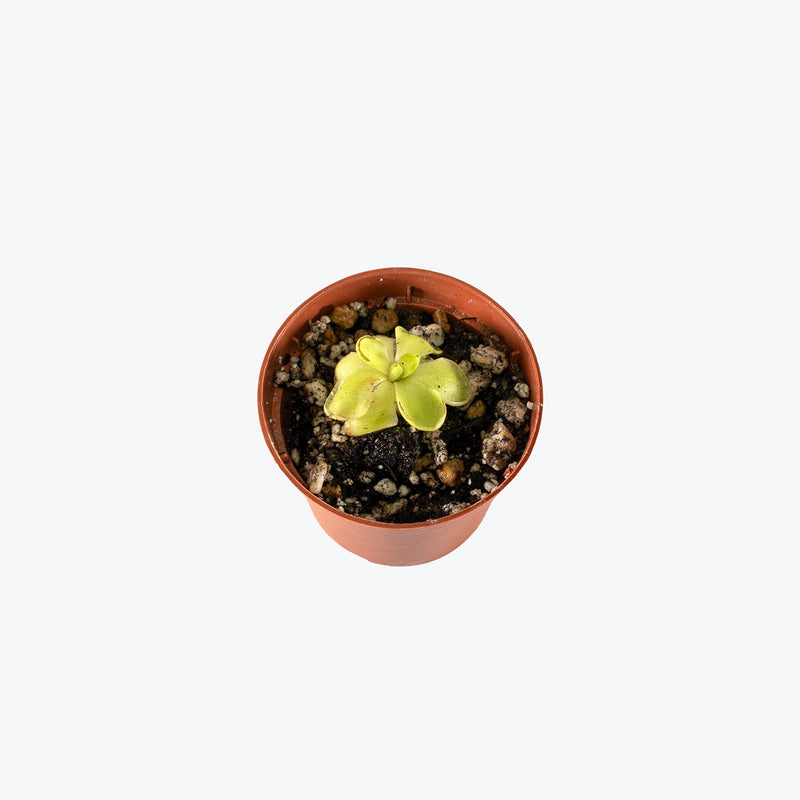
How to care for Pinguicula Zecheri
Pinguicula Zecheri should not be in a position to see the sun directly, although early morning or late evening sun is fine. Filtered sunlight through a sheer curtain is best and most homes are comprised primarily of indirect sunlight. The best spot for them is where they do not see the sun during the majority of the day but still get bright, indirect light.
Pinguicula Zecheri will thrive in bright light, but also can tolerate medium light. A good medium-light place in your home would be in the middle of a room that has a regular size window. They can be placed anywhere between the middle of the room and the window. Remember that plants will grow based on how much light they receive.
Allow the top quarter of the soil to dry before watering Pinguicula Zecheri again. This usually takes about 3 - 4 days in an average home environment. It will vary depending on the time of year, your environment and lighting conditions. Expect to water more often in brighter light and less often in lower light.
Pinguicula Zecheri will do well in average humidity environments but will appreciate a little bit of humidity if provided, give them a mist daily or get a humidifier.
Grow in a well-draining mix (such as sand, perlite, and peat/vermiculite) to mimic its mossy hillside origins. Allow Pinguicula Zecheri to naturally capture small insects for nutrients, or offer a tiny dried insect or diluted foliar feed occasionally. Remove old leaves to promote fresh growth.
You can feel comfortable having Pinguicula Zecheri around your home in the potential case where your pet feels like nibbling on it. However, we typically recommend keeping your pets from eating any of your houseplants..
View PlantPink Jasmine
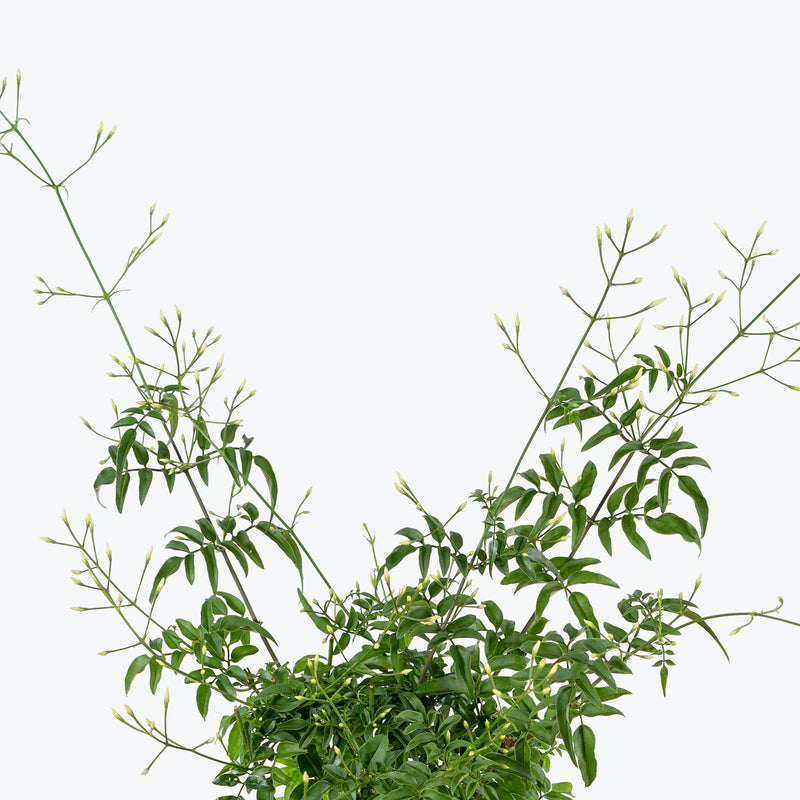
How to care for Pink Jasmine
They enjoy some direct sun, but they'll also do well in bright, indirect light. It is best to place this plant somewhere where it will receive some nice morning sun, or a couple hours of afternoon sun, and then indirect light the rest of the day.
They will do best in bright light. A nice bright place inside your home would be on the window sill or a stool that is right next to a window, either with or without blinds, depending on if the plant can handle sun. Remember that plants will grow based on how much light they receive.
They need to be watered when the top half of the soil is dry to the touch. That usually takes about 1 week in an average home environment. It will vary depending on the time of year, your environment and lighting conditions, but it's always safer to underwater or give the soil a check before you water again. Expect to water more often in brighter light and less often in lower light.
They will do well in average humidity environments but will appreciate a little bit of humidity if provided, give them a mist daily or get a humidifier.
The scented flowers that your plant produces may last for many weeks, mainly due to the sheer number of blooms produced, which open in sequence over an extensive period of time. Avoid letting the soil dry out because, if the plant dries up and sheds a lot of its leaves, it may not bounce back to the same lush beauty it once was.
This plant is moderately toxic and can cause some adverse reactions when ingested so it is best to not let your pets eat it, which we advise for all plants in general. The severity of the reaction will depend on how much of the plant is ingested but, if you know your pet typically does not eat your plants, this plant will be suitable for your home..
View PlantPink Serissa
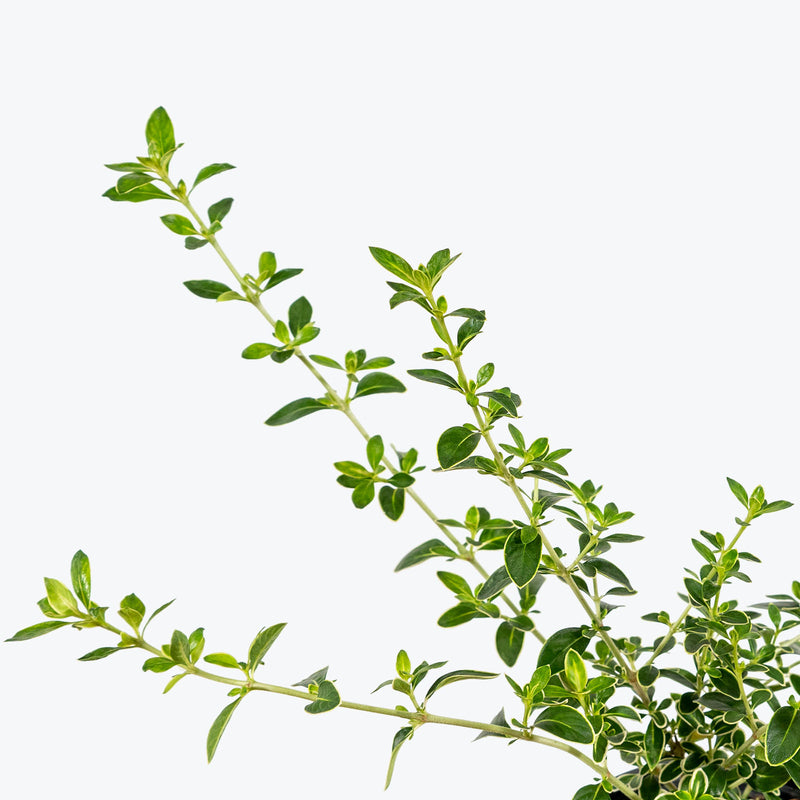
How to care for Pink Serissa
They enjoy some direct sun, but they'll also do well in bright, indirect light. It is best to place this plant somewhere where it will receive some nice morning sun, or a couple hours of afternoon sun, and then indirect light the rest of the day.
They will do best in bright light. A nice bright place inside your home would be on the window sill or a stool that is right next to a window, either with or without blinds, depending on if the plant can handle sun. Remember that plants will grow based on how much light they receive.
They need to be watered when the top half of the soil is dry to the touch. That usually takes about 1 week in an average home environment. It will vary depending on the time of year, your environment and lighting conditions, but it's always safer to underwater or give the soil a check before you water again. Expect to water more often in brighter light and less often in lower light.
They like a high humidity environment, give them a mist daily or as often as possible, but avoid misting them when they are in bloom as this will cause them to rot. Alternatively, you can put them around a humidifier. Although they won't die if they don't receive enough humidity, their leaves may have some dry, crunchy, or yellow edges.
They will often drop their leaves if they have too much water, too little water, if it’s too hot or too cold, if they are moved, or if there is a shift in lighting or temperature. When this happens, continue to care for them as normal and they will regrow their leaves and recover. Try to make environmental changes slowly but as long as they are getting bright enough light, they should do just fine, too little light will result in a leggy plant. Prune as needed after the flowers die off - the Serissa is quite a fast grower and may need repeated pruning to maintain its shape.
This plant is moderately toxic and can cause some adverse reactions when ingested so it is best to not let your pets eat it, which we advise for all plants in general. The severity of the reaction will depend on how much of the plant is ingested but, if you know your pet typically does not eat your plants, this plant will be suitable for your home..
View PlantPiper Crocatum
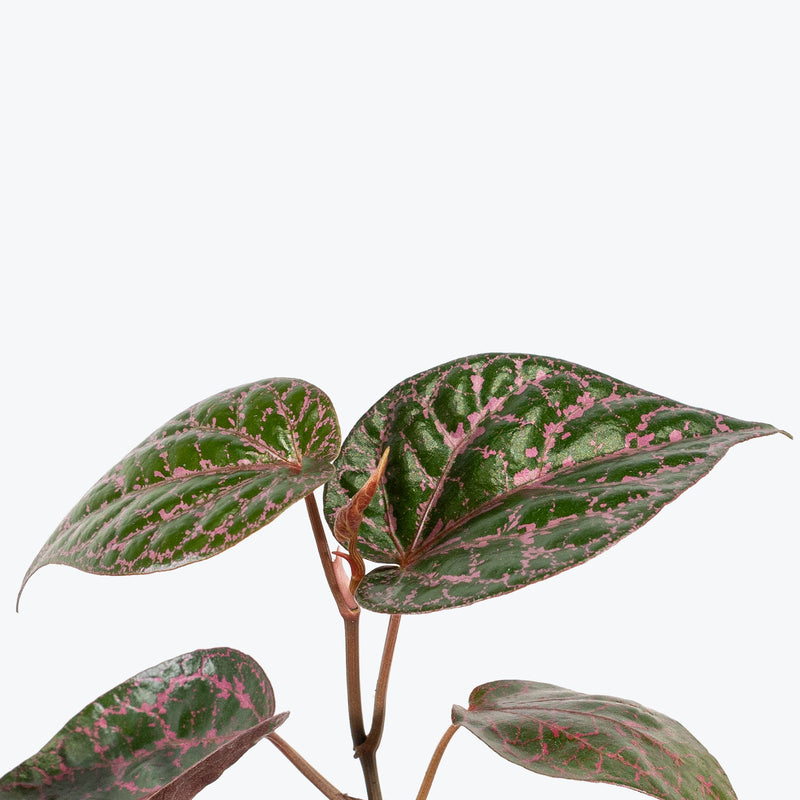
How to care for Piper Crocatum
Piper Crocatum should not be in a position to see the sun directly, although early morning or late evening sun is fine. Filtered sunlight through a sheer curtain is best and most homes are comprised primarily of indirect sunlight. The best spot for them is where they do not see the sun during the majority of the day but still get bright, indirect light.
Piper Crocatum will do best in bright light. A nice bright place inside your home would be on the window sill or a stool that is right next to a window, either with or without blinds, depending on if the plant can handle sun. Remember that plants will grow based on how much light they receive.
Piper Crocatum needs to be watered when the top half of the soil is dry to the touch. That usually takes about 1 week in an average home environment. It will vary depending on the time of year, your environment and lighting conditions, but it's always safer to underwater or give the soil a check before you water again. Expect to water more often in brighter light and less often in lower light.
Piper Crocatum will do well in average humidity environments but will appreciate a little bit of humidity if provided, give them a mist daily or get a humidifier.
It is important to keep Piper Crocatum in a space that receives bright, indirect light with relative humidity and warmth, they won't be as forgiving in fluctuating temperatures and with inconsistent care. Steady environmental conditions are best! Also, like most pipers, they may form small, black beads on the backsides of the leaves and stems. As long as there is no other pest damage present, this is normal physiology and not an insect infestation.
Piper Crocatum is moderately toxic and can cause some adverse reactions when ingested so it is best to not let your pets eat it, which we advise for all plants in general. The severity of the reaction will depend on how much of the plant is ingested but, if you know your pet typically does not eat your plants, this plant will be suitable for your home..
View PlantPiper Parmatum
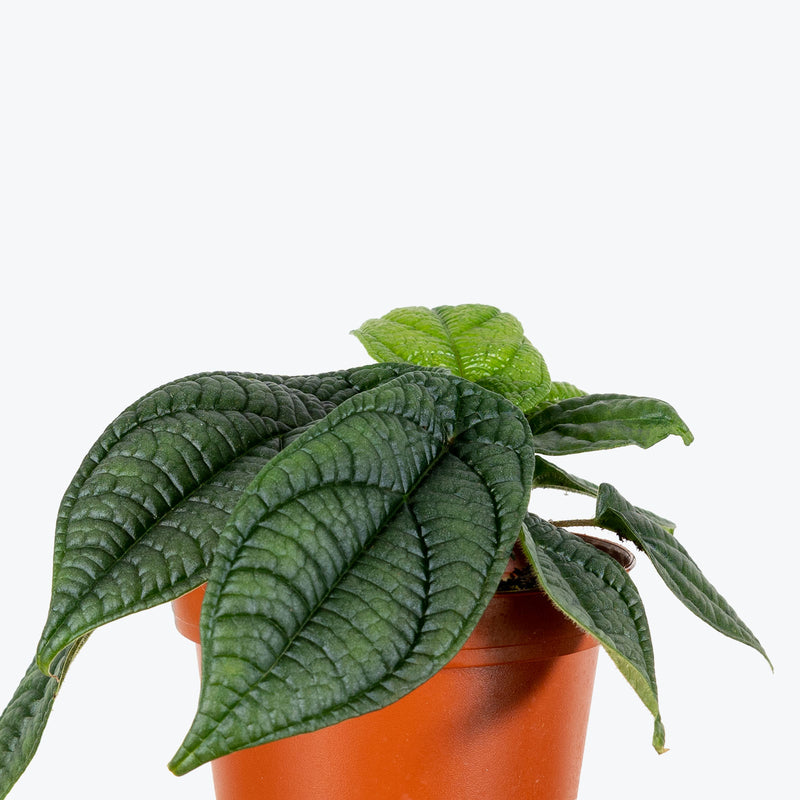
How to care for Piper Parmatum
They should not be in a position to see the sun directly, although early morning or late evening sun is fine. Filtered sunlight through a sheer curtain is best and most homes are comprised primarily of indirect sunlight. The best spot for them is where they do not see the sun during the majority of the day but still get bright, indirect light.
They will do best in bright light. A nice bright place inside your home would be on the window sill or a stool that is right next to a window, either with or without blinds, depending on if the plant can handle sun. Remember that plants will grow based on how much light they receive.
They need to be watered when the top half of the soil is dry to the touch. That usually takes about 1 week in an average home environment. It will vary depending on the time of year, your environment and lighting conditions, but it's always safer to underwater or give the soil a check before you water again. Expect to water more often in brighter light and less often in lower light.
They will do well in average humidity environments but will appreciate a little bit of humidity if provided, give them a mist daily or get a humidifier.
Even though this is more of a bushy variety, it can be trained to climb if some additional support is provided. It is important to keep your plant in a space that receives bright, indirect light with relative humidity and warmth, they won't be as forgiving in fluctuating temperatures and with inconsistent care. Steady environmental conditions are best!
This plant is moderately toxic and can cause some adverse reactions when ingested so it is best to not let your pets eat it, which we advise for all plants in general. The severity of the reaction will depend on how much of the plant is ingested but, if you know your pet typically does not eat your plants, this plant will be suitable for your home..
View PlantPittsburgh Ivy
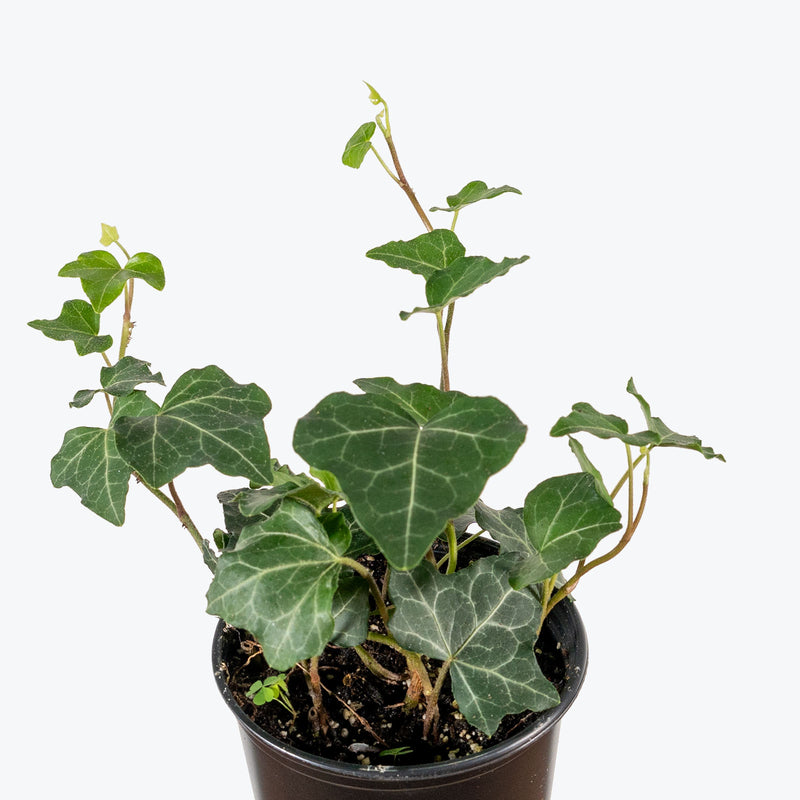
How to care for Pittsburgh Ivy
Pittsburgh Ivy should not be in a position to see the sun directly, although early morning or late evening sun is fine. Filtered sunlight through a sheer curtain is best and most homes are comprised primarily of indirect sunlight. The best spot for them is where they do not see the sun during the majority of the day but still get bright, indirect light.
Pittsburgh Ivy will do well in medium light but will grow faster with brighter light. A good medium-light place in your home would be in the middle of a room that has a regular size window. Remember that plants will grow based on how much light they receive.
Pittsburgh Ivy likes the soil to be relatively dry before the next watering. That usually takes about 2 weeks in an average home environment. It will vary depending on the time of year, your environment and lighting conditions, but for them, it's always safer to underwater or water when you see signs of lack of water (i.e. droopy, floppy, or soft leaves). Water more often in the warmer months.
Pittsburgh Ivy will do well in average humidity environments but will appreciate a little bit of humidity if provided, give them a mist daily or get a humidifier.
If growing Pittsburgh Ivy indoors, regular pruning is beneficial to control its growth and maintain the desired shape. This also helps in keeping the plant healthy by increasing air circulation, which reduces the risk of pest infestations and diseases. Fertilize monthly during the growing season with a balanced, all-purpose plant food diluted to half strength.
Pittsburgh Ivy is moderately toxic and can cause some adverse reactions when ingested so it is best to not let your pets eat it, which we advise for all plants in general. The severity of the reaction will depend on how much of the plant is ingested but, if you know your pet typically does not eat your plants, this plant will be suitable for your home..
View PlantPodocarpus Gracilior
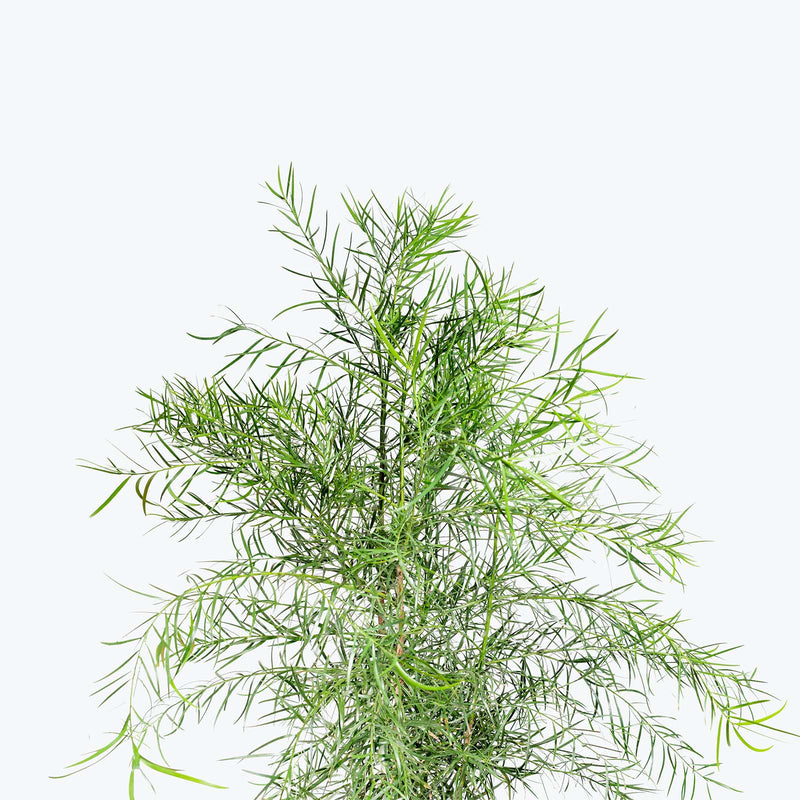
How to care for Podocarpus Gracilior
Podocarpus Gracilior enjoys some direct sun, but they'll also do well in bright, indirect light. It is best to place this plant somewhere where it will receive some nice morning sun, or a couple hours of afternoon sun, and then indirect light the rest of the day.
Podocarpus Gracilior will thrive in bright light, but also can tolerate medium light. A good medium-light place in your home would be in the middle of a room that has a regular size window. They can be placed anywhere between the middle of the room and the window. Remember that plants will grow based on how much light they receive.
Podocarpus Gracilior needs to be watered when the top half of the soil is dry to the touch. That usually takes about 1 week in an average home environment. It will vary depending on the time of year, your environment and lighting conditions, but it's always safer to underwater or give the soil a check before you water again. Expect to water more often in brighter light and less often in lower light.
Podocarpus Gracilior will do well in average humidity environments but will appreciate a little bit of humidity if provided, give them a mist daily or get a humidifier.
Plant in a deep, humusy, well-draining soil mix with slight acidity. Fertilize Podocarpus Gracilior every 4–6 weeks during spring and summer with a balanced, diluted fertilizer. Prune lightly to maintain shape or encourage denser growth. Outdoors, it can grow into a majestic tree; indoors, it can be maintained as a refined, container-grown shrub. Protect from frost and cold drafts.
Podocarpus Gracilior is moderately toxic and can cause some adverse reactions when ingested so it is best to not let your pets eat it, which we advise for all plants in general. The severity of the reaction will depend on how much of the plant is ingested but, if you know your pet typically does not eat your plants, this plant will be suitable for your home..
View PlantPolka Dot Plant
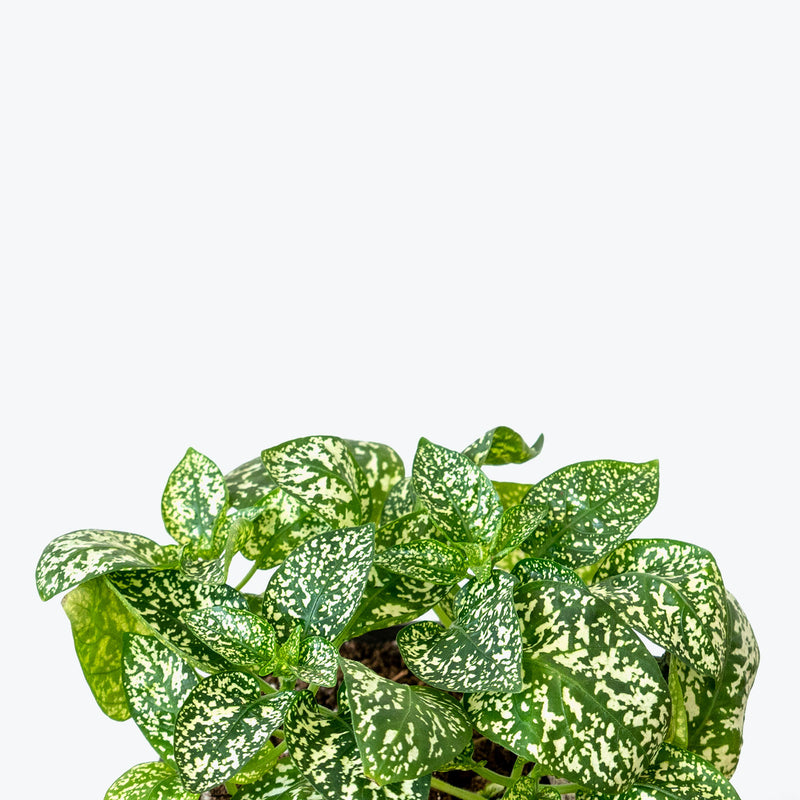
How to care for Polka Dot Plant
Polka Dot Plant should not be in a position to see the sun directly, although early morning or late evening sun is fine. Filtered sunlight through a sheer curtain is best and most homes are comprised primarily of indirect sunlight. The best spot for them is where they do not see the sun during the majority of the day but still get bright, indirect light.
Polka Dot Plant will thrive in bright light, but also can tolerate medium light. A good medium-light place in your home would be in the middle of a room that has a regular size window. They can be placed anywhere between the middle of the room and the window. Remember that plants will grow based on how much light they receive.
Allow the top quarter of the soil to dry before watering the Polka Dot Plant again. This usually takes about 3 - 4 days in an average home environment. It will vary depending on the time of year, your environment and lighting conditions. Expect to water more often in brighter light and less often in lower light.
Polka Dot Plant will do well in average humidity environments but will appreciate a little bit of humidity if provided, give them a mist daily or get a humidifier. They also prefer warmer temperatures, so try not to let them get too cold.
Polka Dot Plants do have a tendency to get leggy, so to promote a bushier growth habit, pinch back the top two leaves on each stem on a weekly basis. This also can help the plant to grow healthier and more vigorously. If your plant has become leggy, avoid pruning more than 1/3 of your plant at a time, as too much pruning can shock the plant.
You can feel comfortable having Polka Dot Plant around your home in the potential case where your pet feels like nibbling on it. However, we typically recommend keeping your pets from eating any of your houseplants..
View PlantPonytail Palm
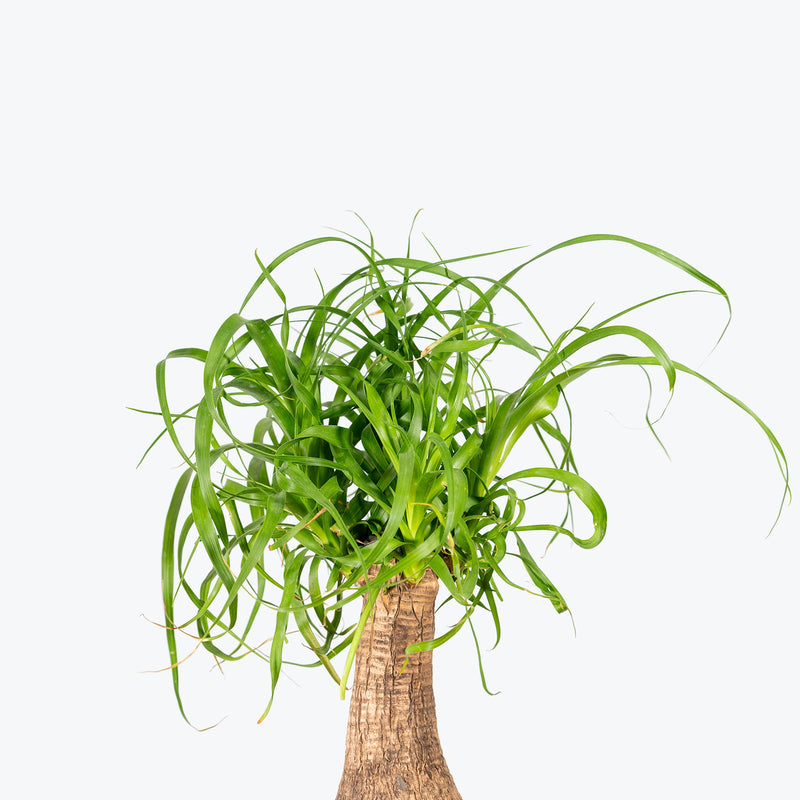
How to care for Ponytail Palm
Ponytail Palm can grow in full sun, but they'll also do well in bright, indirect light. It is best to place this plant somewhere where it will receive some nice morning sun, or a couple hours of afternoon sun, and then indirect light the rest of the day.
Ponytail Palm will do well in medium light but will grow faster with brighter light. A good medium-light place in your home would be in the middle of a room that has a regular size window. Remember that plants will grow based on how much light they receive.
Ponytail Palm likes the soil to be relatively dry before the next watering. That usually takes about 2 weeks in an average home environment. It will vary depending on the time of year, your environment and lighting conditions, but for them, it's always safer to underwater or water when you see signs of lack of water (i.e. droopy, floppy, or soft leaves). Expect to water more often in brighter light and less often in lower light.
Their humidity requirement is low, so do not mist Ponytail Palm or put them in a terrarium.
Also known as Elephant's Foot, their bulbous trunk stores a lot of water, so they will not enjoy being in consistently moist soil, like a lot of other palms. It is important to let the soil mostly dry out between waterings. That being said, increase the frequency of waterings in the growing season and then only water monthly in the dormant (or winter) months.
You can feel comfortable having Ponytail Palm around your home in the potential case where your pet feels like nibbling on it. However, we typically recommend keeping your pets from eating any of your houseplants..
Learn MoreView PlantPothos Emerald
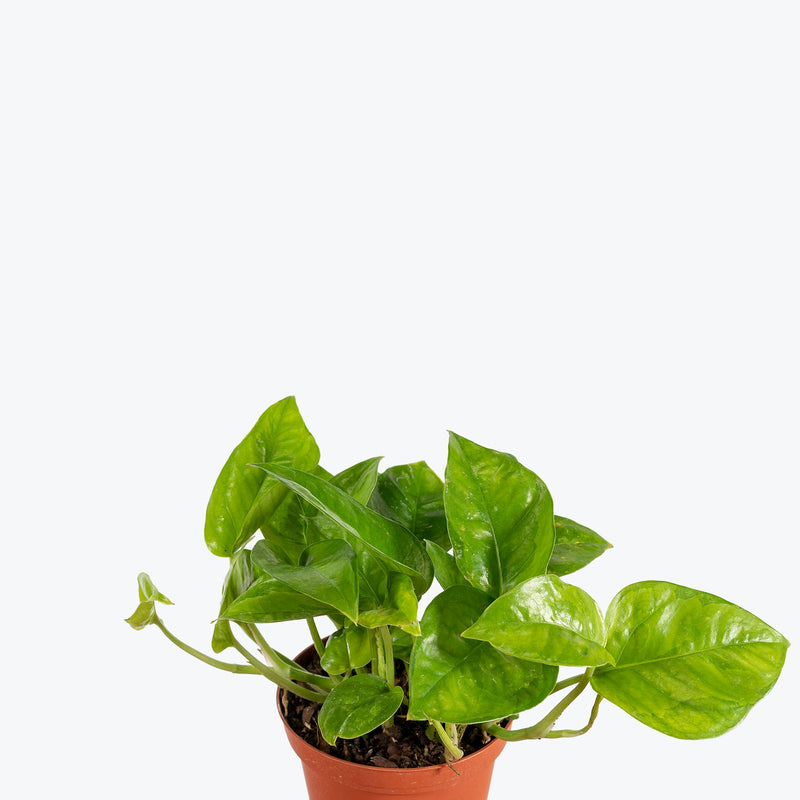
How to care for Pothos Emerald
Pothos Emerald should not be in a position to see the sun directly, although early morning or late evening sun is fine. Filtered sunlight through a sheer curtain is best and most homes are comprised primarily of indirect sunlight. The best spot for them is where they do not see the sun during the majority of the day but still get bright, indirect light.
Pothos Emerald will thrive in medium to bright light, but also can tolerate low light. A good medium-light place in your home would be in the middle of a room that has a regular size window. They can be placed almost anywhere in the room but remember, plants will grow based on how much light they receive.
Pothos Emerald likes the soil to be relatively dry before the next watering. That usually takes about 2 weeks in an average home environment. It will vary depending on the time of year, your environment and lighting conditions, but for them, it's always safer to underwater or water when you see signs of lack of water (i.e. droopy, floppy, or soft leaves). Expect to water more often in brighter light and less often in lower light.
Pothos Emerald can live in any average home humidity condition and are fairly hardy.
Although Pothos Emerald can tolerate medium to low light, to maintain those large and beautifully variegated leaves, you will want to keep your plant in lots of bright, indirect light. Feel free to trim your plant regularly as this encourages it to develop more side-shoots and reduces the demand for the plant to develop a larger root system while confined. Their cuttings propagate very easily in water.
Pothos Emerald is moderately toxic and can cause some adverse reactions when ingested so it is best to not let your pets eat it, which we advise for all plants in general. The severity of the reaction will depend on how much of the plant is ingested but, if you know your pet typically does not eat your plants, this plant will be suitable for your home..
Learn MoreView PlantPothos Global Green
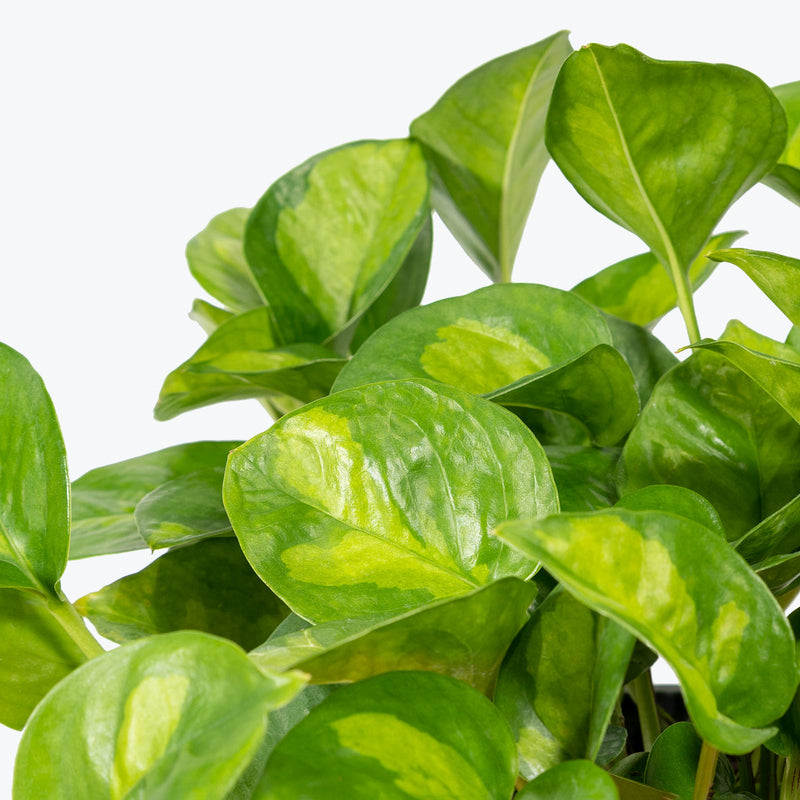
How to care for Pothos Global Green
Pothos Global Green should not be in a position to see the sun directly, although early morning or late evening sun is fine. Filtered sunlight through a sheer curtain is best and most homes are comprised primarily of indirect sunlight. The best spot for them is where they do not see the sun during the majority of the day but still get bright, indirect light.
Pothos Global Green will thrive in medium to bright light, but also can tolerate low light. A good medium-light place in your home would be in the middle of a room that has a regular size window. They can be placed almost anywhere in the room but remember, plants will grow based on how much light they receive.
Pothos Global Green likes the soil to be relatively dry before the next watering. That usually takes about 2 weeks in an average home environment. It will vary depending on the time of year, your environment and lighting conditions, but for them, it's always safer to underwater or water when you see signs of lack of water (i.e. droopy, floppy, or soft leaves). Expect to water more often in brighter light and less often in lower light.
Pothos Global Green can live in any average home humidity condition and are fairly hardy.
Feel free to trim your Pothos Global Green regularly as this encourages the plant to develop more side-shoots and reduces the demand for the plant to develop a larger root system while confined. Their cuttings propagate very easily in soil or water.
Pothos Global Green is moderately toxic and can cause some adverse reactions when ingested so it is best to not let your pets eat it, which we advise for all plants in general. The severity of the reaction will depend on how much of the plant is ingested but, if you know your pet typically does not eat your plants, this plant will be suitable for your home..
Learn MoreView PlantPothos Golden
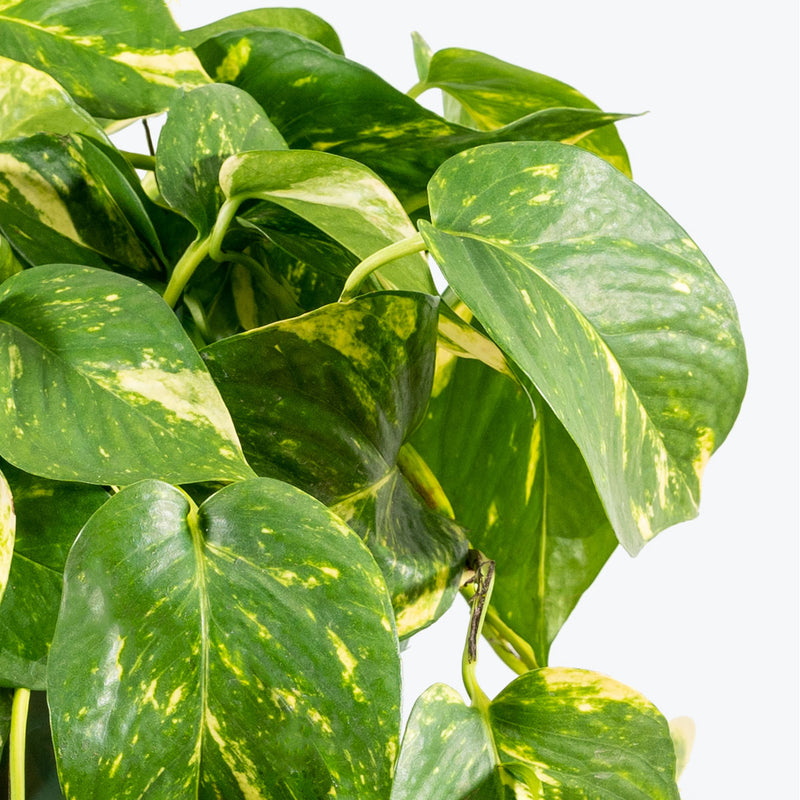
How to care for Pothos Golden
Pothos Golden should not be in a position to see the sun directly, although early morning or late evening sun is fine. Filtered sunlight through a sheer curtain is best and most homes are comprised primarily of indirect sunlight. The best spot for them is where they do not see the sun during the majority of the day but still get bright, indirect light.
Pothos Golden will thrive in medium to bright light, but also can tolerate low light. A good medium-light place in your home would be in the middle of a room that has a regular size window. They can be placed almost anywhere in the room but remember, plants will grow based on how much light they receive.
Pothos Golden likes the soil to be relatively dry before the next watering. That usually takes about 2 weeks in an average home environment. It will vary depending on the time of year, your environment and lighting conditions, but for them, it's always safer to underwater or water when you see signs of lack of water (i.e. droopy, floppy, or soft leaves). Expect to water more often in brighter light and less often in lower light.
Pothos Golden can live in any average home humidity condition and are fairly hardy.
Since the Golden Pothos variety has some variegation in the leaves, it will need brighter light to support that variegation, so keep that in mind if it is placed in lower light. Feel free to trim your Pothos regularly as this encourages the plant to develop more side-shoots and reduces the demand for the plant to develop a larger root system while confined. Their cuttings propagate very easily in water.
Pothos Golden is moderately toxic and can cause some adverse reactions when ingested so it is best to not let your pets eat it, which we advise for all plants in general. The severity of the reaction will depend on how much of the plant is ingested but, if you know your pet typically does not eat your plants, this plant will be suitable for your home..
Learn MoreView PlantPothos Hawaiian
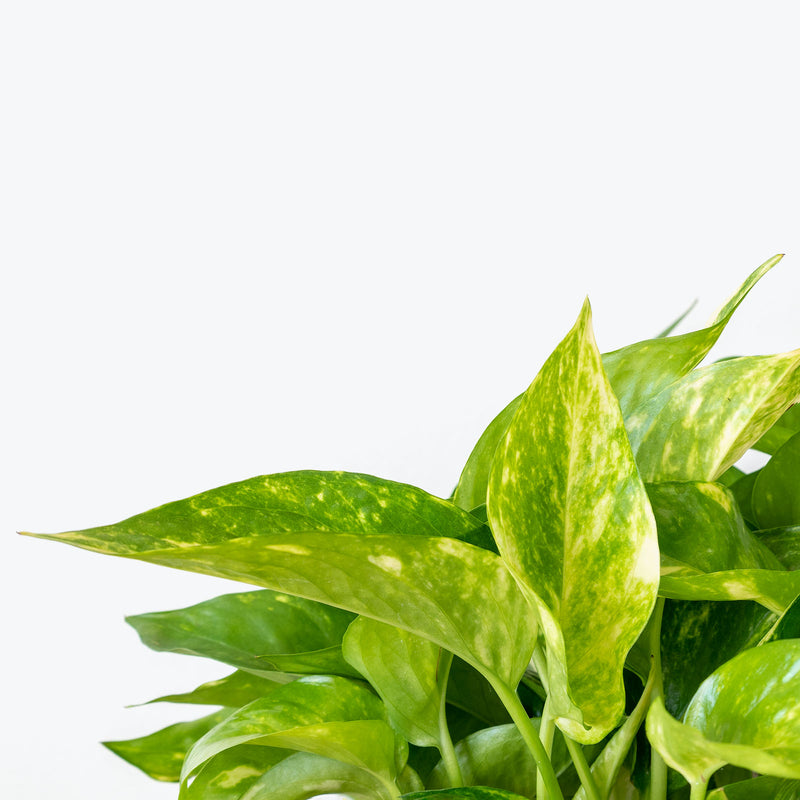
How to care for Pothos Hawaiian
Pothos Hawaiian should not be in a position to see the sun directly, although early morning or late evening sun is fine. Filtered sunlight through a sheer curtain is best and most homes are comprised primarily of indirect sunlight. The best spot for them is where they do not see the sun during the majority of the day but still get bright, indirect light.
Pothos Hawaiian will thrive in medium to bright light, but also can tolerate low light. A good medium-light place in your home would be in the middle of a room that has a regular size window. They can be placed almost anywhere in the room but remember, plants will grow based on how much light they receive.
Pothos Hawaiian likes the soil to be relatively dry before the next watering. That usually takes about 2 weeks in an average home environment. It will vary depending on the time of year, your environment and lighting conditions, but for them, it's always safer to underwater or water when you see signs of lack of water (i.e. droopy, floppy, or soft leaves). Expect to water more often in brighter light and less often in lower light.
Pothos Hawaiian can live in any average home humidity condition and are fairly hardy.
Since Pothos Hawaiian has very strong variegation in the leaves, it will need brighter light to support this colouring, so keep that in mind if it is placed in lower light. Feel free to trim your Pothos regularly as this encourages the plant to develop more side-shoots and reduces the demand for the plant to develop a larger root system while confined. Their cuttings propagate very easily in water.
Pothos Hawaiian is moderately toxic and can cause some adverse reactions when ingested so it is best to not let your pets eat it, which we advise for all plants in general. The severity of the reaction will depend on how much of the plant is ingested but, if you know your pet typically does not eat your plants, this plant will be suitable for your home..
Learn MoreView PlantPothos Jade
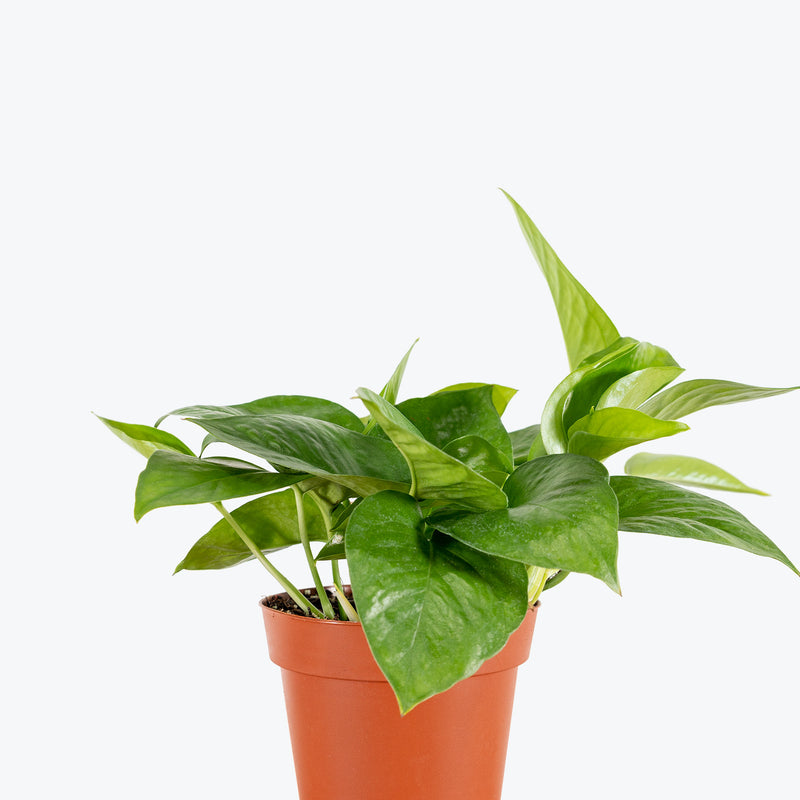
How to care for Pothos Jade
Pothos Jade should not be in a position to see the sun directly, although early morning or late evening sun is fine. Filtered sunlight through a sheer curtain is best and most homes are comprised primarily of indirect sunlight. The best spot for them is where they do not see the sun during the majority of the day but still get bright, indirect light.
Pothos Jade will thrive in medium to bright light, but also can tolerate low light. A good medium-light place in your home would be in the middle of a room that has a regular size window. They can be placed almost anywhere in the room but remember, plants will grow based on how much light they receive.
Pothos Jade likes the soil to be relatively dry before the next watering. That usually takes about 2 weeks in an average home environment. It will vary depending on the time of year, your environment and lighting conditions, but for them, it's always safer to underwater or water when you see signs of lack of water (i.e. droopy, floppy, or soft leaves). Expect to water more often in brighter light and less often in lower light.
Pothos Jade can live in any average home humidity condition and are fairly hardy.
Since the Jade Pothos variety has no variegation in the leaves, it will be ok in lower light as compared to its variegated siblings. Feel free to trim your Pothos regularly as this encourages the plant to develop more side-shoots and reduces the demand for the plant to develop a larger root system while confined. Their cuttings propagate very easily in water.
Pothos Jade is moderately toxic and can cause some adverse reactions when ingested so it is best to not let your pets eat it, which we advise for all plants in general. The severity of the reaction will depend on how much of the plant is ingested but, if you know your pet typically does not eat your plants, this plant will be suitable for your home..
Learn MoreView PlantPothos Lemon Meringue
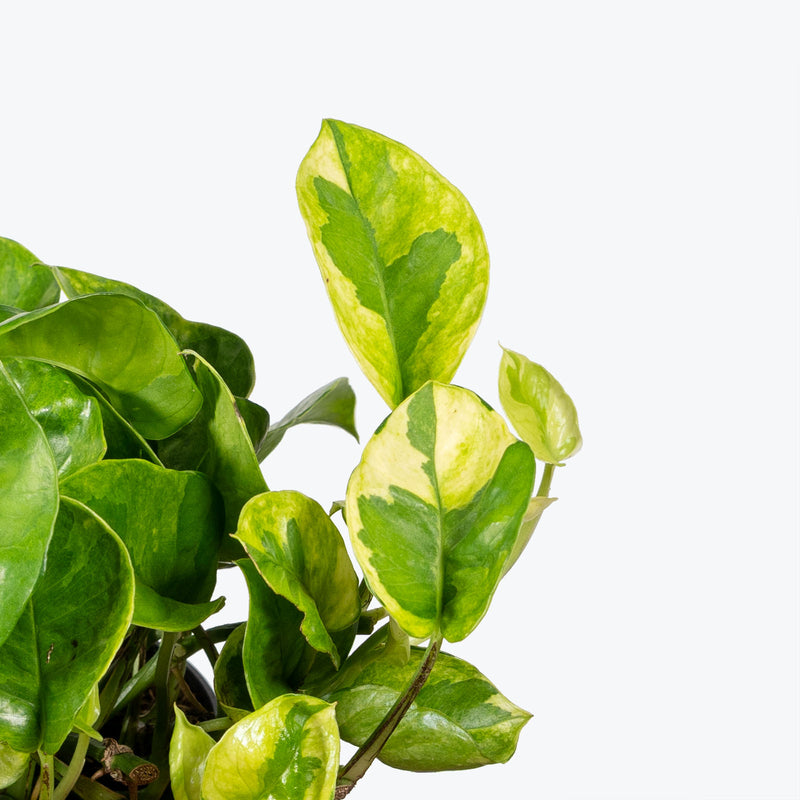
How to care for Pothos Lemon Meringue
Pothos Lemon Meringue should not be in a position to see the sun directly, although early morning or late evening sun is fine. Filtered sunlight through a sheer curtain is best and most homes are comprised primarily of indirect sunlight. The best spot for them is where they do not see the sun during the majority of the day but still get bright, indirect light.
Pothos Lemon Meringue will thrive in medium to bright light, but also can tolerate low light. A good medium-light place in your home would be in the middle of a room that has a regular size window. They can be placed almost anywhere in the room but remember, plants will grow based on how much light they receive.
Pothos Lemon Meringue likes the soil to be relatively dry before the next watering. That usually takes about 2 weeks in an average home environment. It will vary depending on the time of year, your environment and lighting conditions, but for them, it's always safer to underwater or water when you see signs of lack of water (i.e. droopy, floppy, or soft leaves). Expect to water more often in brighter light and less often in lower light.
Pothos Lemon Meringue can live in any average home humidity condition and are fairly hardy.
Pothos Lemon Meringue are known for being hardy and easy to care for, making them great for beginners. They can handle some neglect, so it's better to under-water than over-water. Although this plant can tolerate medium to low light, to maintain those large and beautifully variegated leaves, you will want to keep your plant in lots of bright, indirect light.
Pothos Lemon Meringue is moderately toxic and can cause some adverse reactions when ingested so it is best to not let your pets eat it, which we advise for all plants in general. The severity of the reaction will depend on how much of the plant is ingested but, if you know your pet typically does not eat your plants, this plant will be suitable for your home..
Learn MoreView PlantPothos Manjula
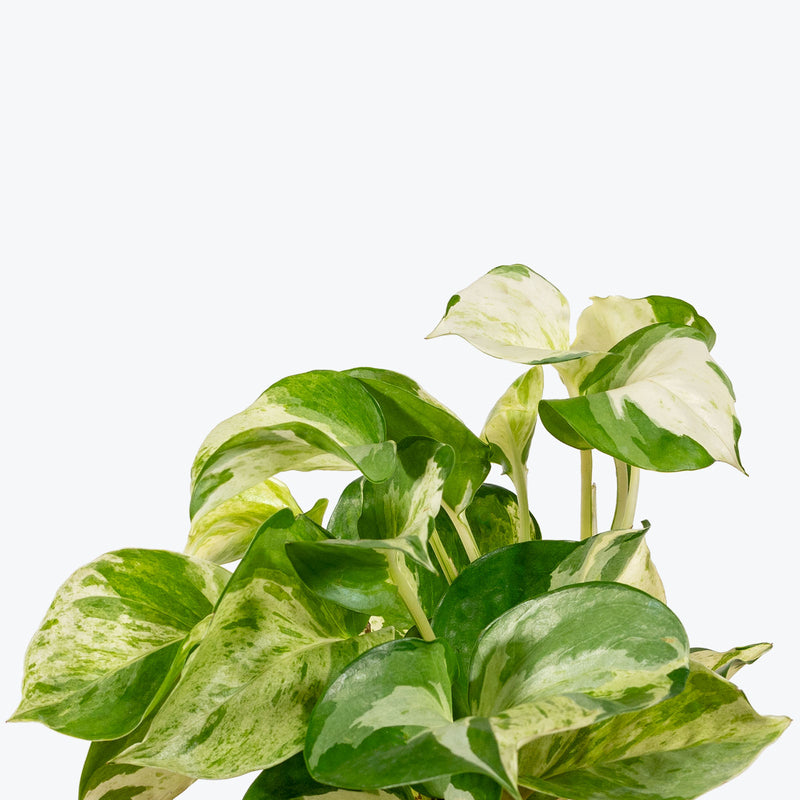
How to care for Pothos Manjula
Pothos Manjula should not be in a position to see the sun directly, although early morning or late evening sun is fine. Filtered sunlight through a sheer curtain is best and most homes are comprised primarily of indirect sunlight. The best spot for them is where they do not see the sun during the majority of the day but still get bright, indirect light.
Pothos Manjula will thrive in medium to bright light, but also can tolerate low light. A good medium-light place in your home would be in the middle of a room that has a regular size window. They can be placed almost anywhere in the room but remember, plants will grow based on how much light they receive.
Pothos Manjula likes the soil to be relatively dry before the next watering. That usually takes about 2 weeks in an average home environment. It will vary depending on the time of year, your environment and lighting conditions, but for them, it's always safer to underwater or water when you see signs of lack of water (i.e. droopy, floppy, or soft leaves). Expect to water more often in brighter light and less often in lower light.
Pothos Manjula can live in any average home humidity condition and are fairly hardy.
Although Pothos Manjula can tolerate medium to low light, to maintain those large and beautifully variegated leaves, you will want to keep your plant in lots of bright, indirect light. Feel free to trim your plant regularly as this encourages it to develop more side-shoots and reduces the demand for the plant to develop a larger root system while confined. Their cuttings propagate very easily in water.
Pothos Manjula is moderately toxic and can cause some adverse reactions when ingested so it is best to not let your pets eat it, which we advise for all plants in general. The severity of the reaction will depend on how much of the plant is ingested but, if you know your pet typically does not eat your plants, this plant will be suitable for your home..
Learn MoreView PlantPothos Marble Queen
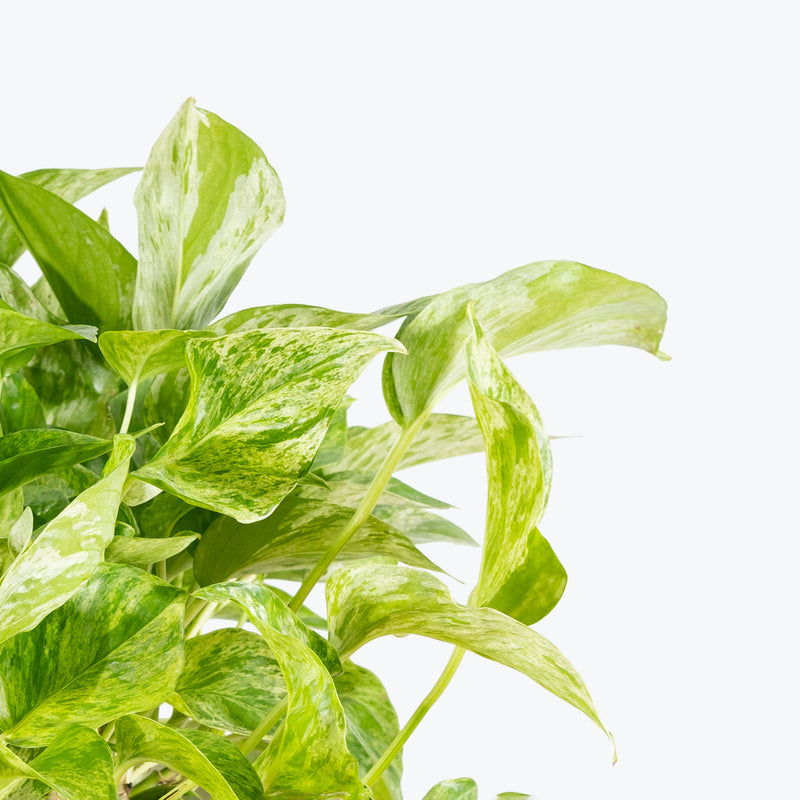
How to care for Pothos Marble Queen
Pothos Marble Queen should not be in a position to see the sun directly, although early morning or late evening sun is fine. Filtered sunlight through a sheer curtain is best and most homes are comprised primarily of indirect sunlight. The best spot for them is where they do not see the sun during the majority of the day but still get bright, indirect light.
Pothos Marble Queen will thrive in bright light, but also can tolerate medium light. A good medium-light place in your home would be in the middle of a room that has a regular size window. They can be placed anywhere between the middle of the room and the window. Remember that plants will grow based on how much light they receive.
Pothos Marble Queen likes the soil to be relatively dry before the next watering. That usually takes about 2 weeks in an average home environment. It will vary depending on the time of year, your environment and lighting conditions, but for them, it's always safer to underwater or water when you see signs of lack of water (i.e. droopy, floppy, or soft leaves). Expect to water more often in brighter light and less often in lower light.
Pothos Marble Queen can live in any average home humidity condition and are fairly hardy.
Since the Marble Queen Pothos variety has some variegation in the leaves, it will need brighter light to support that variegation, so keep that in mind if it is placed in lower light. Feel free to trim your Pothos regularly as this encourages the plant to develop more side-shoots and reduces the demand for the plant to develop a larger root system while confined. Great for propagation—simply root stem cuttings in water or soil to grow new plants.
Pothos Marble Queen is moderately toxic and can cause some adverse reactions when ingested so it is best to not let your pets eat it, which we advise for all plants in general. The severity of the reaction will depend on how much of the plant is ingested but, if you know your pet typically does not eat your plants, this plant will be suitable for your home..
Learn MoreView PlantPothos Neon
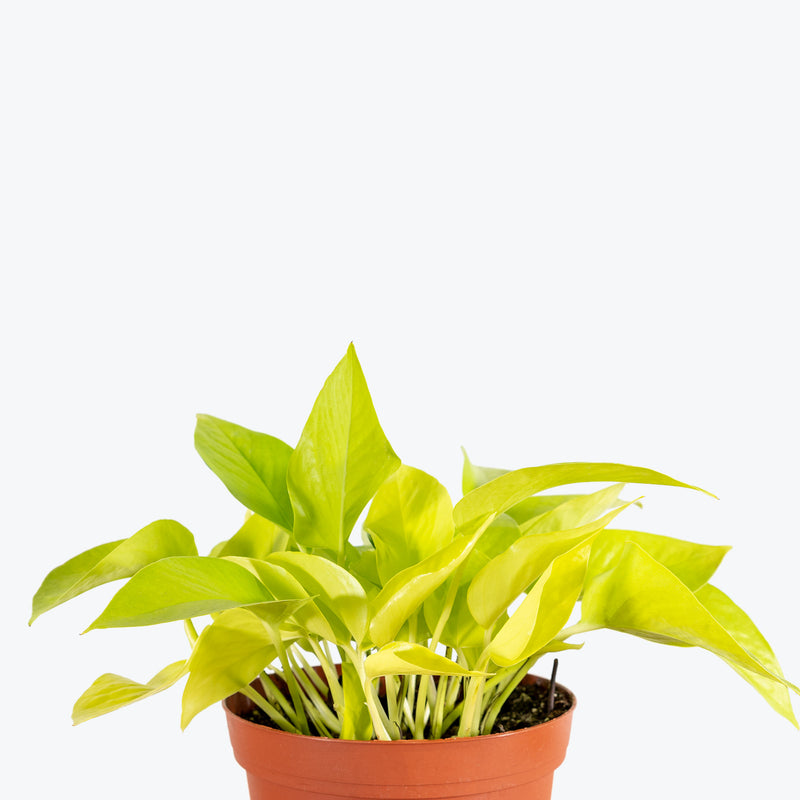
How to care for Pothos Neon
Pothos Neon should not be in a position to see the sun directly, although early morning or late evening sun is fine. Filtered sunlight through a sheer curtain is best and most homes are comprised primarily of indirect sunlight. The best spot for them is where they do not see the sun during the majority of the day but still get bright, indirect light.
Pothos Neon will thrive in medium to bright light, but also can tolerate low light. A good medium-light place in your home would be in the middle of a room that has a regular size window. They can be placed almost anywhere in the room but remember, plants will grow based on how much light they receive.
Pothos Neon likes the soil to be relatively dry before the next watering. That usually takes about 2 weeks in an average home environment. It will vary depending on the time of year, your environment and lighting conditions, but for them, it's always safer to underwater or water when you see signs of lack of water (i.e. droopy, floppy, or soft leaves). Expect to water more often in brighter light and less often in lower light.
Pothos Neon can live in any average home humidity condition and are fairly hardy.
Fertilize once a month during spring and summer with a balanced, diluted houseplant fertilizer. Prune regularly to shape the plant and encourage fuller, bushier vines. Neon Pothos is easily propagated from stem cuttings—perfect for sharing or expanding your collection. Feel free to trim your Pothos Neon regularly as this encourages the plant to develop more side-shoots and reduces the demand for the plant to develop a larger root system while confined.
Pothos Neon is moderately toxic and can cause some adverse reactions when ingested so it is best to not let your pets eat it, which we advise for all plants in general. The severity of the reaction will depend on how much of the plant is ingested but, if you know your pet typically does not eat your plants, this plant will be suitable for your home..
Learn MoreView PlantPothos Neon Queen
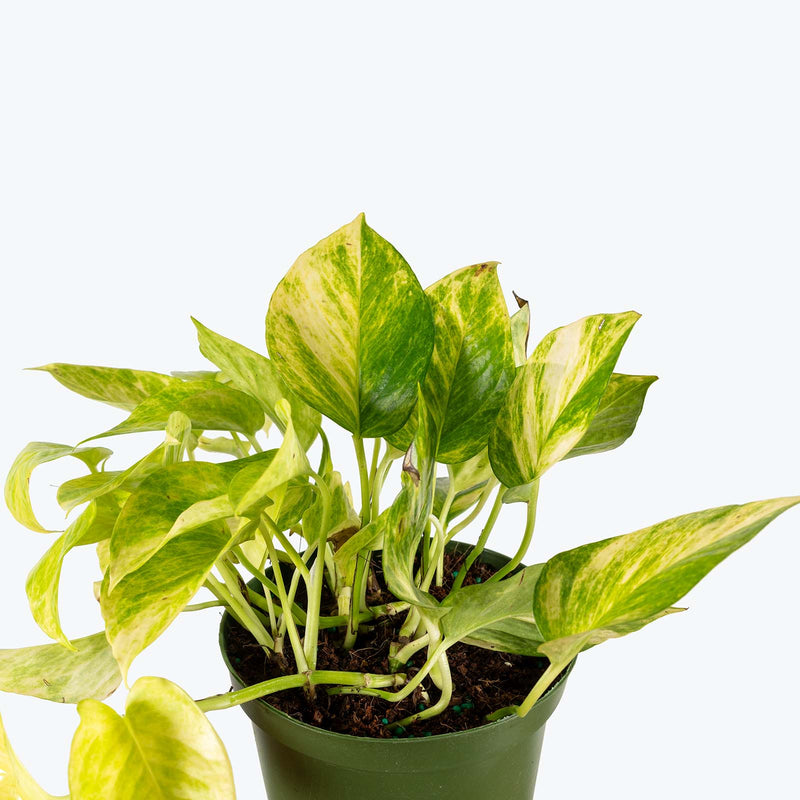
How to care for Pothos Neon Queen
Pothos Neon Queen should not be in a position to see the sun directly, although early morning or late evening sun is fine. Filtered sunlight through a sheer curtain is best and most homes are comprised primarily of indirect sunlight. The best spot for them is where they do not see the sun during the majority of the day but still get bright, indirect light.
Pothos Neon Queen will thrive in bright light, but also can tolerate medium light. A good medium-light place in your home would be in the middle of a room that has a regular size window. They can be placed anywhere between the middle of the room and the window. Remember that plants will grow based on how much light they receive.
Pothos Neon Queen likes the soil to be relatively dry before the next watering. That usually takes about 2 weeks in an average home environment. It will vary depending on the time of year, your environment and lighting conditions, but for them, it's always safer to underwater or water when you see signs of lack of water (i.e. droopy, floppy, or soft leaves). Expect to water more often in brighter light and less often in lower light.
Pothos Neon Queen can live in any average home humidity condition and are fairly hardy.
Feel free to trim your Pothos Neon Queen regularly as this encourages the plant to develop more side-shoots and reduces the demand for the plant to develop a larger root system while confined. Clean the leaves periodically to remove dust and prevent pest infestations.
Pothos Neon Queen is moderately toxic and can cause some adverse reactions when ingested so it is best to not let your pets eat it, which we advise for all plants in general. The severity of the reaction will depend on how much of the plant is ingested but, if you know your pet typically does not eat your plants, this plant will be suitable for your home..
Learn MoreView PlantPothos N’Joy
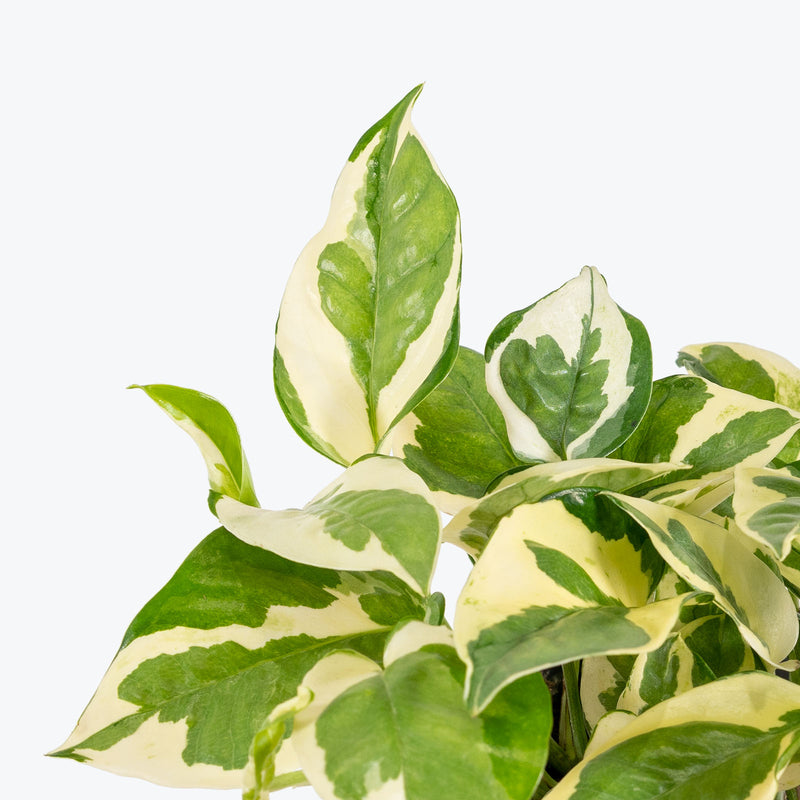
How to care for Pothos N’Joy
Pothos N’Joy should not be in a position to see the sun directly, although early morning or late evening sun is fine. Filtered sunlight through a sheer curtain is best and most homes are comprised primarily of indirect sunlight. The best spot for them is where they do not see the sun during the majority of the day but still get bright, indirect light.
Pothos N’Joy will thrive in medium to bright light, but also can tolerate low light. A good medium-light place in your home would be in the middle of a room that has a regular size window. They can be placed almost anywhere in the room but remember, plants will grow based on how much light they receive.
Pothos N’Joy likes the soil to be relatively dry before the next watering. That usually takes about 2 weeks in an average home environment. It will vary depending on the time of year, your environment and lighting conditions, but for them, it's always safer to underwater or water when you see signs of lack of water (i.e. droopy, floppy, or soft leaves). Expect to water more often in brighter light and less often in lower light.
Pothos N’Joy can live in any average home humidity condition and are fairly hardy.
Since the Pothos N'Joy variety has some variegation in the leaves, it will need brighter light to support that variegation, so keep that in mind if it is placed in lower light. Feel free to trim your Pothos regularly as this encourages the plant to develop more side-shoots and reduces the demand for the plant to develop a larger root system while confined. Their cuttings propagate very easily in water.
Pothos N’Joy is moderately toxic and can cause some adverse reactions when ingested so it is best to not let your pets eat it, which we advise for all plants in general. The severity of the reaction will depend on how much of the plant is ingested but, if you know your pet typically does not eat your plants, this plant will be suitable for your home..
Learn MoreView PlantPothos Pearls and Jade
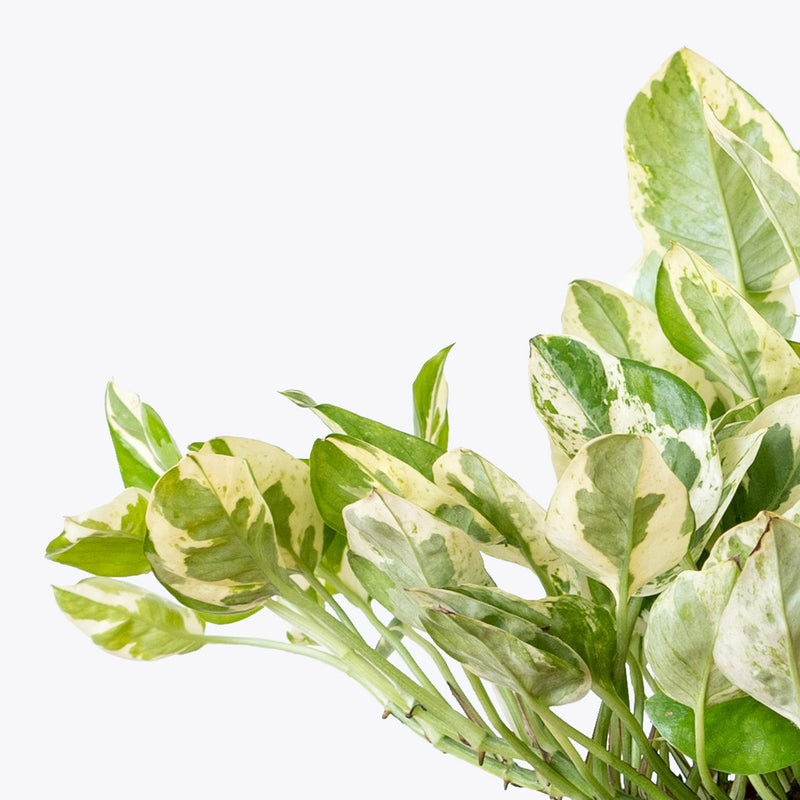
How to care for Pothos Pearls and Jade
Pothos Pearls and Jade should not be in a position to see the sun directly, although early morning or late evening sun is fine. Filtered sunlight through a sheer curtain is best and most homes are comprised primarily of indirect sunlight. The best spot for them is where they do not see the sun during the majority of the day but still get bright, indirect light.
Pothos Pearls and Jade will thrive in medium to bright light, but also can tolerate low light. A good medium-light place in your home would be in the middle of a room that has a regular size window. They can be placed almost anywhere in the room but remember, plants will grow based on how much light they receive.
Pothos Pearls and Jade likes the soil to be relatively dry before the next watering. That usually takes about 2 weeks in an average home environment. It will vary depending on the time of year, your environment and lighting conditions, but for them, it's always safer to underwater or water when you see signs of lack of water (i.e. droopy, floppy, or soft leaves). Expect to water more often in brighter light and less often in lower light.
Pothos Pearls and Jade can live in any average home humidity condition and are fairly hardy.
Since Pothos Pearls and Jade has some variegation in the leaves, it will need brighter light to support that variegation, so keep that in mind if it is placed in lower light. Feel free to trim your Pothos regularly as this encourages the plant to develop more side-shoots and reduces the demand for the plant to develop a larger root system while confined. Their cuttings propagate very easily in water.
Pothos Pearls and Jade is moderately toxic and can cause some adverse reactions when ingested so it is best to not let your pets eat it, which we advise for all plants in general. The severity of the reaction will depend on how much of the plant is ingested but, if you know your pet typically does not eat your plants, this plant will be suitable for your home..
Learn MoreView PlantPothos Snow Queen
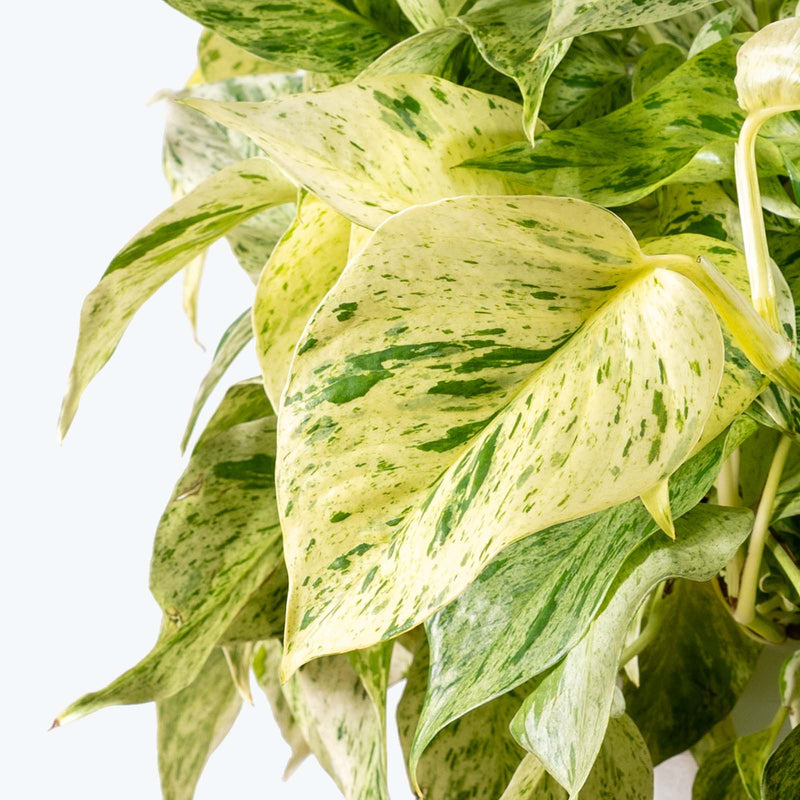
How to care for Pothos Snow Queen
Pothos Snow Queen should not be in a position to see the sun directly, although early morning or late evening sun is fine. Filtered sunlight through a sheer curtain is best and most homes are comprised primarily of indirect sunlight. The best spot for them is where they do not see the sun during the majority of the day but still get bright, indirect light.
Pothos Snow Queen will thrive in bright light, but also can tolerate medium light. A good medium-light place in your home would be in the middle of a room that has a regular size window. They can be placed anywhere between the middle of the room and the window. Remember that plants will grow based on how much light they receive.
Pothos Snow Queen likes the soil to be relatively dry before the next watering. That usually takes about 2 weeks in an average home environment. It will vary depending on the time of year, your environment and lighting conditions, but for them, it's always safer to underwater or water when you see signs of lack of water (i.e. droopy, floppy, or soft leaves). Expect to water more often in brighter light and less often in lower light.
Pothos Snow Queen can live in any average home humidity condition and are fairly hardy.
Since the Pothos Snow Queen has high variegation in the leaves, it will need brighter light to support that variegation, so keep that in mind if it is placed in lower light. Prune regularly to encourage fuller, bushier growth and remove any leggy stems or leaves that lose their variegation. It can be trained to climb a moss pole or trail beautifully from a hanging basket.
Pothos Snow Queen is moderately toxic and can cause some adverse reactions when ingested so it is best to not let your pets eat it, which we advise for all plants in general. The severity of the reaction will depend on how much of the plant is ingested but, if you know your pet typically does not eat your plants, this plant will be suitable for your home..
Learn MoreView PlantPothos Teruno Kaguya Lemon

How to care for Pothos Teruno Kaguya Lemon
Pothos Teruno Kaguya Lemon should not be in a position to see the sun directly, although early morning or late evening sun is fine. Filtered sunlight through a sheer curtain is best and most homes are comprised primarily of indirect sunlight. The best spot for them is where they do not see the sun during the majority of the day but still get bright, indirect light.
Pothos Teruno Kaguya Lemon will thrive in bright light, but also can tolerate medium light. A good medium-light place in your home would be in the middle of a room that has a regular size window. They can be placed anywhere between the middle of the room and the window. Remember that plants will grow based on how much light they receive.
Pothos Teruno Kaguya Lemon likes the soil to be relatively dry before the next watering. That usually takes about 2 weeks in an average home environment. It will vary depending on the time of year, your environment and lighting conditions, but for them, it's always safer to underwater or water when you see signs of lack of water (i.e. droopy, floppy, or soft leaves). Expect to water more often in brighter light and less often in lower light.
Pothos Teruno Kaguya Lemon can live in any average home humidity condition and are fairly hardy.
Fertilize Pothos Teruno Kaguya Lemon every 4-6 weeks during the growing season with a balanced, water-soluble fertilizer diluted to half strength. During the winter, reduce fertilization as the plant’s growth naturally slows down. Regular pruning can help maintain the shape of the plant and encourage fuller growth. Clean the leaves occasionally with a damp cloth to remove dust and support efficient photosynthesis.
Pothos Teruno Kaguya Lemon is moderately toxic and can cause some adverse reactions when ingested so it is best to not let your pets eat it, which we advise for all plants in general. The severity of the reaction will depend on how much of the plant is ingested but, if you know your pet typically does not eat your plants, this plant will be suitable for your home..
Learn MoreView PlantPrickly Pear Cactus
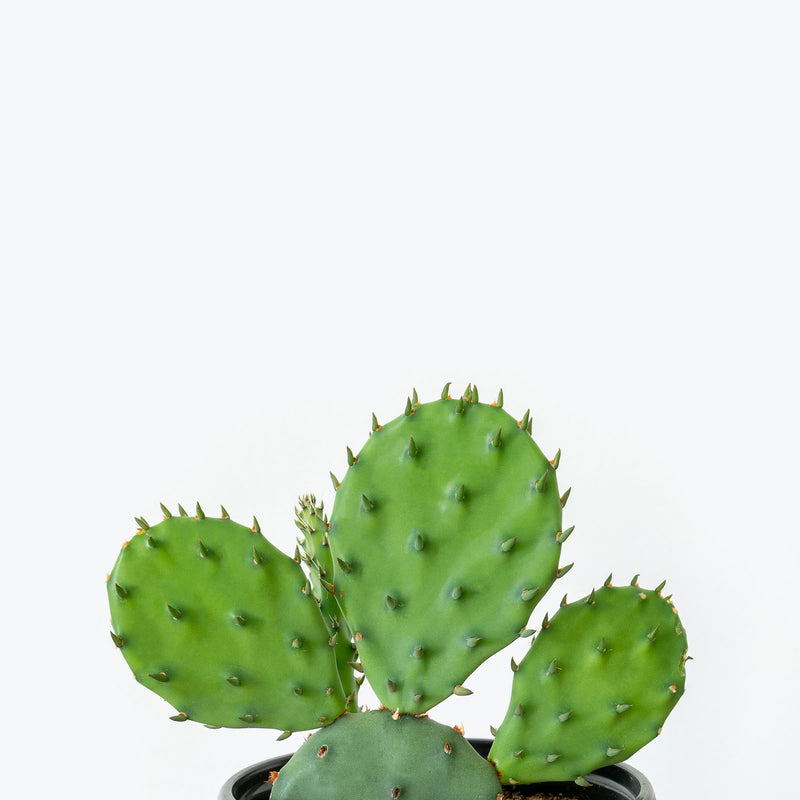
How to care for Prickly Pear Cactus
Prickly Pear Cactus loves as much sun as possible. The best spot for them is where they can see the sun during the majority of the day.
Prickly Pear Cactus will do best in bright light. A nice bright place inside your home would be on the window sill or a stool that is right next to a window, either with or without blinds, depending on if the plant can handle sun. Remember that plants will grow based on how much light they receive.
Prickly Pear Cactus likes the soil to be completely dry before the next watering. That can take about 4 weeks in an average home environment. It will vary depending on the time of year, your environment and lighting conditions, but for them, it's always safer to underwater or water when you see signs of lack of water (i.e. wrinkly or soft leaves). Water a little more often in the warmer months.
Their humidity requirement is low, so do not mist Prickly Pear Cactus or put them in a terrarium.
Prickly Pear Cactus will like a bright, warm spot in your home, but avoid watering them too much. Be cautious when handling your Prickly Pear Cactus due to its glochids and spines; it's advisable to use gloves or wrap the segments in newspaper to avoid getting pricked.
Prickly Pear Cactus is moderately toxic and can cause some adverse reactions when ingested so it is best to not let your pets eat it, which we advise for all plants in general. The severity of the reaction will depend on how much of the plant is ingested but, if you know your pet typically does not eat your plants, this plant will be suitable for your home..
Learn MoreView PlantPurple Passion Plant
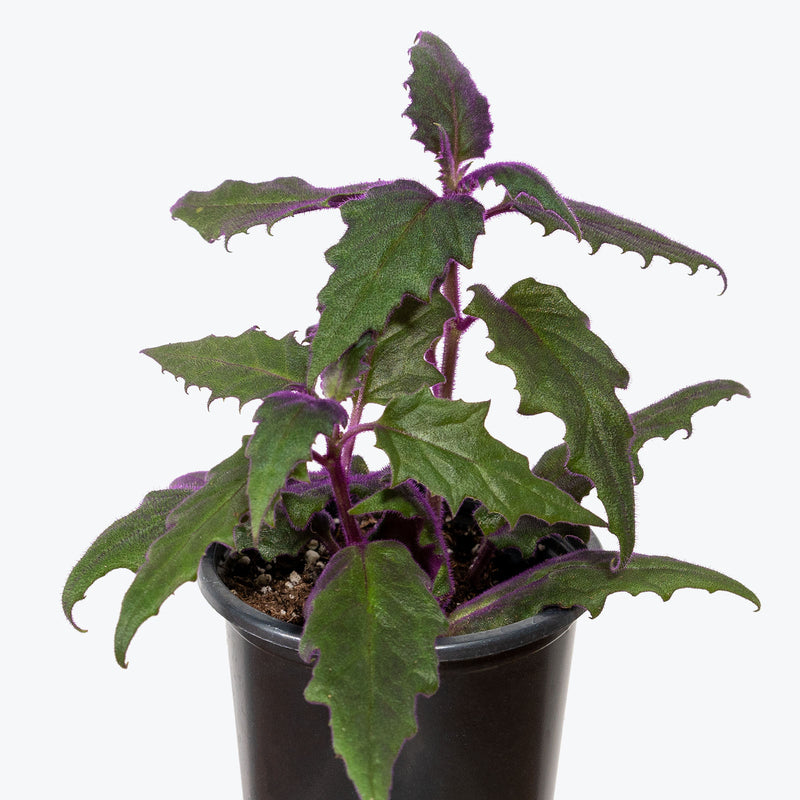
How to care for Purple Passion Plant
They should not be in a position to see the sun directly, although early morning or late evening sun is fine. Filtered sunlight through a sheer curtain is best and most homes are comprised primarily of indirect sunlight. The best spot for them is where they do not see the sun during the majority of the day but still get bright, indirect light.
They will thrive in bright light, but also can tolerate medium light. A good medium-light place in your home would be in the middle of a room that has a regular size window. They can be placed anywhere between the middle of the room and the window. Remember that plants will grow based on how much light they receive.
They need to be watered when the top half of the soil is dry to the touch. That usually takes about 1 week in an average home environment. It will vary depending on the time of year, your environment and lighting conditions, but it's always safer to underwater or give the soil a check before you water again. Expect to water more often in brighter light and less often in lower light.
They can live in any average home humidity condition and are fairly hardy.
The purple will remain bold and striking if the plant is kept in very bright, indirect light, such as next to an East or North-facing window. Avoid getting water on the leaves, as the fine hairs can trap moisture and begin to rot. To keep your plant full and compact, pinch the new growth back regularly, causing it to develop branches and to remain more like a shrub than a vine,
You can feel comfortable having this plant around your home in the potential case where your pet feels like nibbling on it. However, we typically recommend keeping your pets from eating any of your houseplants..
View PlantPurple Waffle Plant
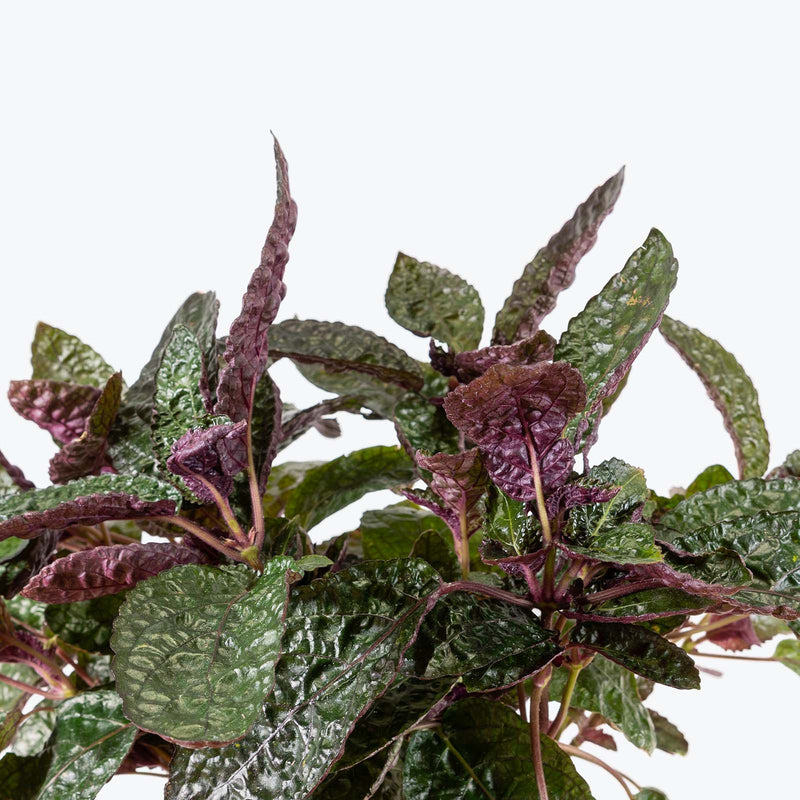
How to care for Purple Waffle Plant
Purple Waffle Plant should not be in a position to see the sun directly, although early morning or late evening sun is fine. Filtered sunlight through a sheer curtain is best and most homes are comprised primarily of indirect sunlight. The best spot for them is where they do not see the sun during the majority of the day but still get bright, indirect light.
Purple Waffle Plant will thrive in bright light, but also can tolerate medium light. A good medium-light place in your home would be in the middle of a room that has a regular size window. They can be placed anywhere between the middle of the room and the window. Remember that plants will grow based on how much light they receive.
Purple Waffle Plant needs to be watered when the top half of the soil is dry to the touch. That usually takes about 1 week in an average home environment. It will vary depending on the time of year, your environment and lighting conditions, but it's always safer to underwater or give the soil a check before you water again. Expect to water more often in brighter light and less often in lower light.
Purple Waffle Plant will do well in average humidity environments but will appreciate a little bit of humidity if provided, give them a mist daily or get a humidifier.
You will know when your Purple Waffle Plant is thirsty as it will start to get a little wilted, but don’t worry too much because once it is watered fully, it will bounce back in no time! If it is kept in light that is a bit too low, it will start to lose the vibrant purple colouring.
You can feel comfortable having Purple Waffle Plant around your home in the potential case where your pet feels like nibbling on it. However, we typically recommend keeping your pets from eating any of your houseplants..
View PlantPygmy Date Palm
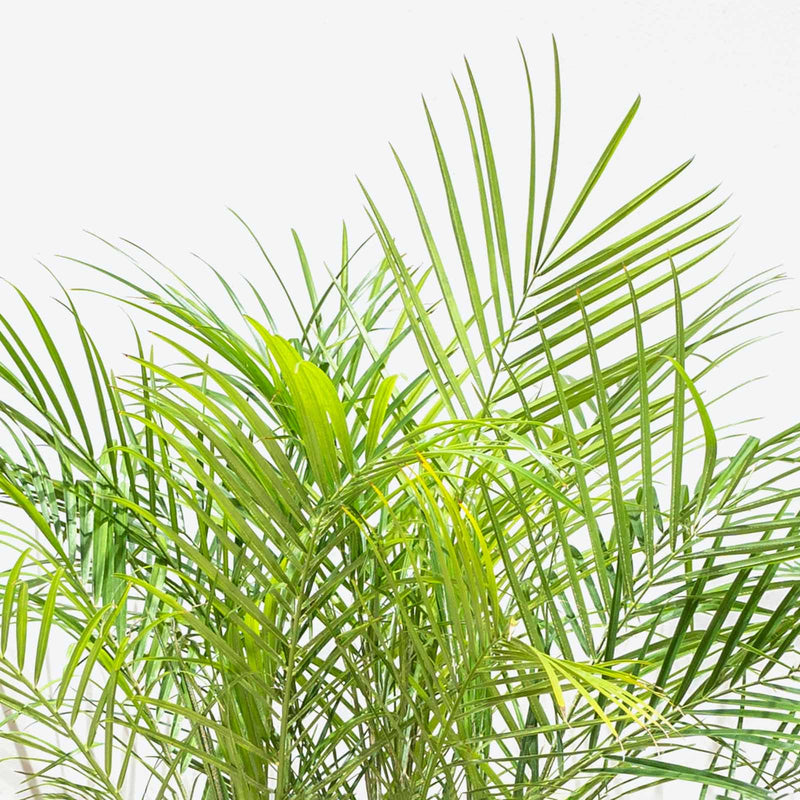
How to care for Pygmy Date Palm
They enjoy some direct sun, but they'll also do well in bright, indirect light. It is best to place this plant somewhere where it will receive some nice morning sun, or a couple hours of afternoon sun, and then indirect light the rest of the day.
They will do best in bright light. A nice bright place inside your home would be on the window sill or a stool that is right next to a window, either with or without blinds, depending on if the plant can handle sun. Remember that plants will grow based on how much light they receive.
Allow the top quarter of the soil to dry before watering again. This usually takes about 3 - 4 days in an average home environment. It will vary depending on the time of year, your environment and lighting conditions. Expect to water more often in brighter light and less often in lower light.
They will do well in average humidity environments but will appreciate a little bit of humidity if provided, give them a mist daily or get a humidifier.
Pygmy palms have moderate drought tolerance and are mostly resistant to disease and pests; however, leaf spot and bud rot may afflict this type of palm. Water them more frequently during spring and summer.
You can feel comfortable having this plant around your home in the potential case where your pet feels like nibbling on it. However, we typically recommend keeping your pets from eating any of your houseplants..
Learn MoreView Plant



